
- Classic EBC Trek
- EBC + Gokyo Trek
- Jiri to EBC
- 3 Passes Trek to EBC
- Island Peak and EBC
- Acclimatisation
- Packing List
- Get a Trek Quote

Everest Base Camp Trek Distance, Length and Elevation
The Everest Base Camp Trek is the most popular trek in the Nepal region and one of the most iconic and well-known treks in the world.
After a nerve-racking flight into Lukla airport that is sure to get you pumped up, you will retrace the footsteps of Sir Edmund Hillary, Tenzing Norgay and the countless other brave men and women who have summited Everest after them.
The route takes you through the beautiful Sagarmatha National Park and eventually ends up at Everest Base Camp, where you will feel the buzz and excitement of potential summiteers of the world’s tallest mountain (the main climbing season kicks off in April and culminates in the 3rd or 4th week of May).
Popular questions asked about the Everest Base Camp Trek always seems to follow the similar pattern of ‘how hard?’, ‘how long?’ and ‘how high?’.
This article will cover the raw data behind the trek to answer all those burning question about distance, length and elevation.
To get a better understanding of how challenging the trek is, read our in-depth article on the difficulty of the Everest Base Camp Trek .
Everest Base Camp Trek Distance
The classic Everest Base Camp trek from Lukla to EBC and back is 130km long – 65km each way – which may sound like a lot of trekking!
Fear not, because the typical round trip to Everest Base Camp takes around 12 days, the actual distance you will be covering each day will be about 15km – a much more reasonable and achievable number.
Furthermore, the average walking pace is about 5km/hour, so 15km per day does not sound too bad anymore.
Obviously, you will not be trekking at that pace because of the rocky terrain, gradual ascent and high altitude gains that have to be made.
The point being made is that the distance is very attainable for all people of all ages, shapes and sizes!
If you book through a tour operator , you will likely have the luxury of having your large bags carried for you by porters or by yak / mules. This should further take the strain off your body and allow you to focus on getting yourself safely up and back down the trail.
How Long Is Everest base Camp Trek?
The typical length, in terms of time, of the Everest Base Camp trek is around 12 days. There are variations of standard route, like Jiri to Everest Base Camp and Gokyo Lakes trek , which take longer.
The outward route from Lukla to Everest Base Camp is significantly longer, in terms of time, than the return route to allow for proper acclimatization and to minimize the risks of Acute Mountain Sickness and related illnesses.
It should take around 9 days of trekking to reach base camp and just 3 days to return to Lukla.
To get a better idea of the distances and day-by-day break down of the typical Everest Base Camp Trek we have posted a sample itinerary below:
- Day 1: Arrive in Kathmandu where you will spend the night.
- Day 2: Fly from Kathmandu to Lukla, then walk to Phakding – 9 km (4 hours)
- Day 3: Trek from Phakding to Namchee Bazaar – 12 km (6 hours)
- Day 4: Acclimatization day. No walking except maybe a quick hike up to the Everest View Hotel.
- Day 5: Trek from Namchee Bazaar to Tengboche – 10 km (6 hours)
- Day 6: Hike from Tengboche to Dingboche – 12 km (6 hours)
- Day 7: Acclimatization day in Dingboche. Explore the area.
- Day 8: Trek from Dingboche to Lobuche – 12 km (7 hours)
- Day 9: Hike from Lobuche to Gorak Shep to EBC and back to Gorak Shep – 15 km (8 hours)
- Day 10: Hike from Gorak Shep up Kala Pathar and then to Pheriche – 13 km (7 hours)
- Day 11: Trek from Pheriche back to Namchee Bazaar – 14 km (8 hours)
- Day 12: Hike from Namchee Bazaar to the airstrip at Lukla – 15 km (8 hours)
- Day 13: Fly back to Kathmandu
- Day 14: Leave Kathmandu
Elevation On EBC Trek
The most challenging element of the trek is probably elevation . Even at the start of the trek at Lukla airport you will be at an altitude of over 2,600m. As most people’s bodies are not used to these altitudes, the trek involves acclimatization days and the ascent to Everest Base Camp will occur at a much slower pace than the descent to allow for acclimatization and to ensure safety.
Typical elevation gains will be in the range of 400-800m each day. Days when the gain is large and the altitude is significantly high will usually be followed by an acclimatization day that doubles up as time for some sightseeing and exploration of the surrounding areas.
Here is an Everest Base Camp trek elevation and altitude profile for the standard trek.
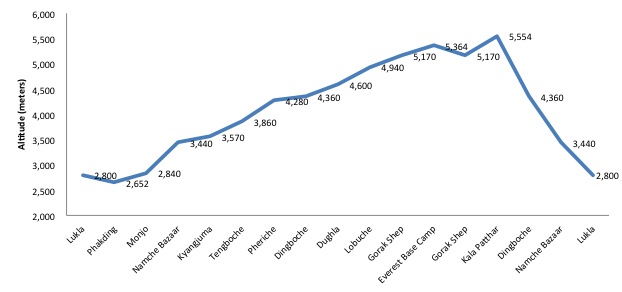
The highest point on most Everest Base Camp Treks tends to be the Kala Patthar viewing point where you will be blessed with some of the best views of Everest and the nearby peaks. Kala Patthar stands at just over 5500m, but not too much time is spent at that altitude as the trek then descends back down to Pheriche and eventually back to Lukla Airport.
Hopefully these facts and figures have convinced you set out on your own trek to Everest Base Camp – if so, happy trekking!
Tags: Everest Base Camp Trek Distance, How long is the Everest Base Camp Trek? Length of the Everest Base Camp trek, Everest Base Camp trek altitude, Everest Base Camp Trek elevation
Mark Whitman
Hi, I'm Mark! Welcome to EBC Trek Guide - the Web's No.1 Trekking Guide to Everest Base Camp. I have trekked all over Nepal, but the Everest region remains my favourite. I hope you find all the answers you are looking for on this site. If you have any questions don't hesitate to drop a comment below! Happy Trekking!
Leave a Reply
Your email address will not be published. Required fields are marked
Really useful post to reflect the daily walking distance , gain elevation and length of track regarding EBC treks thanks for sharing
Hi Mark, just wondering if Island Peak (in November) is do-able for my son who will be 17 years old. We’re both pretty fit but we don’t have any climbing experience. I did EBC in 2014. Cheers.
Hi Anthony, thanks for getting in touch. It is possible to climb Island Peak in November. The hike to Island Peak usually includes a visit to EBC before to help with acclimatisation. The climb itself is a real challenge and not for the faint-hearted. I would highly recommend doing some winter mountaineering courses before embarking on the adventure. You will need to be comfortable using crampons, crossing a glacier with ladder crevasse sections and ascending a tough headwall with a fixed rope jumar. You can read more about Island Peak here: https://www.mountainiq.com/guides/trekking-in-nepal/routes/island-peak/
Thanks Mark, your info was very helpful = )
Thanks for info. It needs to write per day max hgt of destination
on the clair ridge oil platform we climb 17km per day.8.5 up and 8.5 down….how many times do we climb the equivolent of everest per week ?
Hi Donald, I’m not sure the answer to your question. I would estimate that on the average day on the EBC trek, you gain about 800-1500m in altitude and lose about 400-800m. The average elevation gain is about 400-800m per day. Hope this helps.
Hellow ! My name is Jaak, my friends name is Andras and we are from Estonia. We wish to make a little trek, max 10-11 days for max alt. 5500/5600m and to stay overnight 5000+ meters few nights. It mast be an acclimatization trek, because my friend are going to K2 summit expedition in july. My friend have gone earlier on Mount Everest summit .Could You please think about it and say, is it possible to organize trek like this between 08.05 – 21.05. We do not need a guide service and accomondation can be easy. Thanks in adavance, Jaak and Andras
Hi Jaak, we are not a tour oeprator so unfortunately we cannot help organise your trek. For a tour operator recommendation go here: https://ebctrekguide.com/go
Looking over the Everest Trek itinerary (which is similar to other organized Everest treks), it seems a little ambitious for the uninitiated. What I mean (and I’ve done the trek independently as well as extensive mountain climbing and backpacking in the Cdn. Rockies) is that while each day’s trek is reasonable, the day-after-day grind will wear down some people. I would recommend anyone attempting this pace first do some multi-day backpacking in the mountains to see how he or she reacts to what is a fairly relentless pace. A Stairmaster is a poor substitute. Also, people who’ve not trekked high up (above 12,000 feet) should know that altitude brings new challenges.
I love to try EBC from Lukla
please tell distance between first base camp to everest summit
Hi Murali, the distance from EBC on the south side (Nepal side) to the summit is approx. 20 kilometres. The altitude gain is nearly 3,300 meters though.
Thanks for all the information… Inshalah I will be there on the last August
Hi, I would like to do EBC on my own since having a porter or a guide with me all the time does not work for me. I am wondering how safe it is to hike alone for a female. I am also wondering if getting accommodation can be a problem if you dont book in advance. Finally, is the path well marked. Many thanks!
Hi, it is possible to trek solo and if you go during the high seasons (March-May or September-November) then there will be quite a few people on the trail. Getting accommodation each day should not be a problem but you might not get your pick of teahouses. Generally porters run ahead of trekkers to secure the best teahouses. The standard EBC path is not well marked but maps of the region are very detailed and easy to follow. All the best!
I am Ram and 40 year old i would like to know more about Everest trekking , i would like to do and what is the process
Hi Ram, I recommend browsing our site – it provides all the information you need. Start here: https://ebctrekguide.com/
Why is there so little time spent at EBC?
Hi Laurie, There are a few reasons why the time at EBC is limited. Firstly, trekkers cannot actually get all the way into the camp. The stop point is just before the camp, and there isn’t a huge amount to see. 10-20 minutes there is more than enough. Secondly, EBC is a good two hour hike from the last tea house at Gorak Shep. So to hike there and back means hanging around EBC is not recommended. Finally, the best views of Everest, the surrounding mountains and EBC is from Kala Pattar, which is right next to Gorak Shep and if you move fast can be hiked on the same day that you visit EBC. Hope this helps!
I’m planning to trek solo in December – January. I read is the low season, with probably a lot of snow. You consider this dangerous? Which equipment would you consider? Your info it’s very clear thank you very much!
Hi Mariano, yes, there is more snow in December. As long as you are trekking the standard route to EBC there is no additional danger. If you plan to cross some big passes, like those on the Gokyo route or Three Passes Trek, I would caution against that. Most passes will be closed in December anyway. In terms of gear, here is what you need: https://ebctrekguide.com/everest-base-camp-trek-packing-list
Thank you for sharing all this information in your blog . Very useful information, it opened my eyes to things i wasn’t aware about. Great way to start preparing for next years climb
Thanks Ebby!
Thanks for the info Mark, helps a lot. Planning to do the trek in December. Would appreciate any pointers to make it comfortable as I am told the Climate is extremely cold.
Hey Ismail, yes, December is pretty cold. Make sure to bring a four season sleeping bag and warm winter jacket / gloves / beanie etc. Layers will be important too, check out our packing list for advice: https://ebctrekguide.com/everest-base-camp-trek-packing-list
Hi, we are a family of 4 and interested in doing EBC in July 2019. Wanted to check what the minimum age is. My two sons are 12 and 10 years old and are physically fit. Thanks
Hi Jeet, there is no official minimum age for the EBC trek, although I wouldn’t take a child younger than 10. In terms of timings I would avoid July – this is the middle of the monsoon season and a terrible time to trek. The best time to go is either Feb-May or Sept-November. Hope this helps.
My other is a smoker and we would like to trek to EBC. Please give her some words of wisdom from your experience with smoking trekkers.
Hi William, words of wisdom… stop smoking. No in all seriousness, one can trek to EBC and smoke but I wouldn’t recommend it. If at all possible, I would encourage your ‘other’ to abstain from smoking, especially on the upper reaches of the trek.
Hello we are 3 friends and want to do EBC, want to know the formalities. Preferable date is 23rd march
We are planning to trekk to Everest base camp in next month . What is your advice for me
Hey, little mistakes on the altitude, Lukla is 2850m and the Kala Patthar is 5643m. 😉 btw I recommend to not hire any porter, that’s too easy with them and you won’t have the same satisfaction. I did it by myself without help and I was so proud to carry my bag in front of all this groups of tired people (but with no bags 😉 ) you’re going for a challenge or not ?
can you hire poter and guide at lukla. how is the chance if you trek to phaking and try to get a tea house without prior booking
Yes it is possible to hire a guide / porter in Lukla. If you ask at one of the many teahouses they should be able to assist. In terms of teahouse availability, this varies by season and time you arrive. Ideally it is best to send a porter ahead early in the day to make a booking for you, but generally if you arrive at a reasonable time it is usually possible to find a free room in one of the teahouses.
Great informative stuff, I’m Planning on 4 old guys 60 +62 to EBC In Nov 2020 Let you know how it goes
can I see everest from namchee bazaar?
Technically you need to hike up to the Everest View Hotel which is just above Namche. But it is only a 20 minute walk away so yes you can.
Is it possible to take a helicopter from Lukla to EBC and then hike back to Lukla with a group? I have taken a bus to EBC and that would be an option too. We would be staying the week before at a 10,000' elevation to help with acclimatization. Thanks,. Tom
Hi Thomas, it is possible to get a helicopter to EBC, but it’s pretty expensive and due to the high altitude weight is usually limited to one passenger (maybe two).
How far from base camp 4 to the peak and back?
Hi Albert, just to be clear this website is about hiking to Everest Base Camp, not climbing Mount Everest. But to answer your question, Camp 4 is on Everest is located on the South Col at just over 8000m. It’s about 1-mile climb to the summit and takes about 7-8 hours.
All of these guides have been so helpful! I leave for EBC in a week and have been panic googling to try to be as prepared as possible. Thank you for the info!
Sure thing Megan!
Hi! What clothing do you recommend for doing the EBC trek first couple weeks of November? Thanks!! Great article
Hi Jackie, I recommend checking out this packing list: https://ebctrekguide.com/everest-base-camp-trek-packing-list
very informative mark thank you. i will be doing this in october 2023
Thanks Tony!
Hi Mark, is there scope to buy all the kit you need in Kathmandu as I’m traveling light at the moment. Im in the far east in shorts and flip flops and my gear is back in the uk. If so how much would I be looking at?
Yes, there are loads of gear stores in Thamel.
Very informative, intresting and nicely articulated! Loved it.
Hi I am 66, quite active, no medical issues, train intense weights n cardio 6days a week, lean. Already had catrekking experience from Jomsom to Muktinath. Could I join the EBC trekking? Please advise.
Hey Ramanuj, you sound fit enough to complete EBC.
Get a quote from the best local trek operator in Nepal!
Get my recommendations on the Best EBC trek operators

Base Camp Adventure

- [email protected]
Everest Base Camp Trek Distance

Everest base camp trek is the most popular trek in Nepal. It is one of the most desired and well-known trekking destination not only for Nepal but for the whole world. It is the most iconic trek you can do in Nepal. The Everest base camp trek distance might seem long. This distance depends on the route you take on the trek to the base camp.
During your hike to Everest base camp, you will conventionally cover about 130 km on average. Everest base camp trek distance might differ according to your itinerary. Through your hike, you will witness a variety of landscapes and breathtaking views of the mountains. You will be near the mountains like never before.
Everest base camp lies on the border of China and Nepal. The camps on both sides are permanent and trekking is possible from both sides. Although the base camps are constructed as a place of acclimatization before climbing up, trekking up to the base camp has been a major attraction. In this article, we will talk about the Everest base camp trek distance from the northern side i.e in Nepal.
Getting to the Everest Base Camp requires a minimum of 2 weeks. There might be a few days added according to your itinerary, weather or other circumstances. The hiking trail is moderate and requires efficient planning and execution.
Related Treks:
- Jiri to Everest Base Camp Trek
- Luxury Lodge Trek to Everest Base Camp
For any inquiries please contact us .
- Full Name *
- Contact Number
- Your Message/Inquiry *
Day to Day Distance Guide to Everest Base Camp Trek
Lukla to phakding/monjo distance (day 01).
Phakding Distance : 8 km
Mojno Distance : 13 km
Walking Hours: 3-6 hrs
Max Elevation: 2,610 m
The destination for the first day is usually up to Phakding or Monjo. You need to arrive Lukla via flight between 7 am to 9 am, to hike up to the desired destination in a relaxed manner. The hike’s duration is about 3 to 5 hours . You will need to walk a few kilometers more or less depending on your final destination for the day; Phakding or Monjo.
The hike to Monjo is about 13km and the hike to Phakding is about 8 km. If your destination is Monjo, you will have to reach Phakding for lunch and continue the ascend. Make sure you are properly hydrated during your trek and do not rush or trek after sunset.
Phakding to Namche Distance (Day 2)

Distance : 8 km
Walking Hours: 4-5 hrs
Max Elevation: 3340 m
For day 2, you will gradually more towards Sagarmatha National Park. It is the official entrance to the most-awaited Everest base camp. The hike for day 2 is regarded as comparatively difficult. For the first part of your hike, you will cross a lot of narrow yet famous suspension bridges constructed in the steep mountains.
There is a lot of uphill treks on the first part. In the second half of the trek on this day, you will continue downhill to a flat route for some time. You have to walk about 8kms from Phakding to reach to the famous Sherpa Village- Namche. This small village is at an altitude of 3340 m and usually requires about 4-5 hours trek from Phakding to reach here.
Stay in Namche ( Day 3)
Distance : 1 km
Walking Hours : 1-2 hours Max Elevation : 3340m
For the third day of the trek is a day off from hiking. You will stay in Namche Bazaar to acclimatize yourself for higher altitudes. During the day you can stroll around the small village and buy necessary things for your ascend. You can also rent gear if you have forgotten any. Another important place to visit in this area is Namche Museum. It is about 1 to 2 hours hike back and forth from the main bazaar and offers a breathtaking view of the Mountain Everest and the surrounding peaks. You have enough time during the day to rest, hydrate and rejuvenate. The total distance you will walk to get to the museum is 1 km on average . The total distance you travel in the day will vary according to what you do in Namche Bazaar.
Namche to Tengboche Distance (Day 4)
Distance : 12km Walking Hours : 5 hours Max Elevation : 3900m
For the fourth day , the difficult treks start. It is one of the important acclimatization treks. You will have to hike a quite steep train behind Namche Bazaar. You will most likely experience a lack of oxygen. Many of you will only experience a headache but some might get severe symptoms like vomiting or fainting. It is therefore advised to take the necessary medication before the trek starts. On this trek, you will cross Shangbouche Airport and Shanbouche hill reach Tengboche for the night. The total distance you will travel today is about 12 km and will need to trek for about 5 hours to cover this distance. Most of the trail is ascending, which might be tiring, Therefore, carry enough water and food for the way. This place is at an altitude of about 3900m. If you reach the destination on time, make sure you visit the Tengboche Monastery.
Tengboche to Dingboche Distance (Day 5)
Distance : 12km Walking Hours : 5-6 hours Max Elevation : 4400m
On the fifth day of the hike to Everest base camp , you will trek from Tengboche to Dingboche. The starting of the trek is downhill which gradually continues to a varied uphill and down the hill. You will reach Pangbouche for lunch. This usually takes about 2 to 3 hours . The trek from Pangbouche is a gradual uphill towards an Island peak. You will reach an altitude of 4400m when you reach Dingboche. The total distance you have to walk is about 12kms and requires about 5 hours on average to reach the final destination from Tengboche. As you reach Dingboche, you will reward yourself with splendid views of the mountains like lotse, Amadablam, and Taboche.
Acclimatization Day in Dingboche (Day 6)
Distance : 2kms Walking Hours : 1 hour Max Elevation : 4400m
The sixth day of the hike is another important acclimatization day. It is important your you stay in this height and prepare your body for higher altitude. There will not be a lot of tiring activities listed for today. The distance we will travel on this day is about 500m, where you will reach a high point. It is important for the acclimatization process as well as for observing the mountains. The stop at the high point is about 30 mins. You will reach Dingboche for lunch. The total distance you will travel is 2 km. You will have a lot of time to relax and prepare yourself for the higher altitude on this day.
Dingboche to Lobuche Distance (Day 7)
Distance : 12kms Walking hours : 5 hours Max Elevation : 4900m
The destination for the sixth day is to reach Lobuche. This place is at an altitude of 4900m . From Dingboche, the trail heads towards the Khumbu valley and to the exotic valley of Dugla. Douglas will be our destination for lunch and a long resting spot. It usually requires about 2 hours to get here. After this, you will have to walk for about 3 more hours crossing Thukla pass to the Everest memorial before reaching Lobuche. The total distance you will cover today is about 12kms and the total time required is about 5 hours with plenty of stops on the way.
Lobuche to Gorak Shep and Everest Base Camp Distance ( Day 8)

Distance : 10kms Walking Hours: 7 hours Max elevation: 5180m
For the eighth day of the trek, you will trek from Lobuche to Gorak Shep. The trail leading to Gorak Shep is extremely beautiful and unique. You will cross a lot of Glaciers on the way. The trail to Gorak Shep usually requires about 3 hours on averag e. Once you reach the destination, you will have lunch and catch a breath for a short time before trekking up to Everest Base Camp, the most awaited place. It requires an additional 2-3 hours to reach the Everest Base Camp. After enjoying the base camp, we will need to return to Gorak Shep to spend the night. The total distance you will have to travel about 10 km at an altitude of roughly 5180m . It is a long trek and might be quite challenging.
Gorak Shep to Kalapatthar and to Dingboche Distance (Day 9)
Distance: 18 km Walking Hours: 7 hours Max Elevation: 5180m
On the ninth day of the hike, if you are ready, we will start descending back. From Gorak Shep, we will leave early in the morning to Kala Pattar to see the sunrise from Everest and observe panoramic views of the mountains. Although the trek is about 3 hours uphill, it is completely worth it. We will return to Gorak Shep and trek back to Dingboche for the night. It takes about 7 hours on total to complete this hike. You will walk for about 18kms today. As you are descending, it will not be as challenging as you experienced on other days.
Dingboche to Namche Bazaar Distance (Day 10)
Distance : 22 km Walking Hours: 8-9 hours Max elevation: 4400m
For today’s trek, you need to cover about 22 km . The goal is to reach Namche Bazaar. You can cover the ground quickly as you head downhill and therefore covering this distance s possible. It will take approximately 8 to 9 hours to hike back to the Sherpa village. As you get to Namche Bazaar, you will have a lot of variety of food available for you. You can buy necessary items like souvenirs and gifts from the shops here.
Namche Bazaar to Lukla Distance ( Day 11)
Distance : 21 km Walking Hours : 8 hours Max Elevation : 3340m
This is the last day of long-distance walking. It is usually the hardest day of the trek as your body will tire itself from the continuous trek to Everest base camp. You will descend to Lukla from Namche Bazaar. The total distance you have to travel is about 21km and can take up to 8 hours.
Lukla to Kathmandu (Day 12)
Distance : few hundred meters Walking Hours : 0.15 hours Max Elevation : 2860m Flight distance : 136 km Flight time : 35 minutes
Today is the last day for you in Everest region . You will fly back to Kathmandu from Lukla airport. As you are staying in Lukla, you will need to walk for about 15 minutes on average to reach the airport.

You may also like to read:
- What to Expect in Everest Base Camp (EBC) Trek?
- How Difficult is Everest Base Camp Trekking
- Everest Base Camp Trek FAQs
Distance Might Differ if you Take Alternative Route
Ebc and gokyo lakes trek – 16 days.
Everest Base Camp trek distance as well as duration increases if you decide to visit Gokyo lake as well. It is a strenuous trail that goes through the Cho La pass. While descending from Gorak Shep, you will descend to Dzongla via Kala Patthar. Dzongla is at an altitude of 4830 m and this trek requires about 6-7 hours. The distance from Gorak Shep to Kalapathar is about 1.5 km and the distance from Gorak Shep to Dzongla is about 10 km.
After a night in Dzongla, we will trek to Cho La Pass and to Gokyo Ri. This hike takes about 8 hours. The total distance you have to trek is about 12.5 km more than standard EBC trail. After spending the night in Gokyo, you will reach Lukla after three days.
Everest Base Camp Trek with Island Peak Climbing – 20 Days
Everest Base Camp Trek along with Island Peak Climbing is a trip in which you will get to climb one of the most beautiful peaks in the wild Himalayas. This peak is 6189m high and is situated in Imji valley.
For this trek, while descending back from Everest you will go trek to Chukung from Dingboche and spend the night there. This place is at an altitude of 4750m and takes about 2-3 hours. It is about 5 km far from Dingboche.
The next day you will trek from Chukung to the Island base camp. This base camp is at 5080m above sea level and takes about 6 hours to get there. On average you have to walk about 5km but it the route is strenuous uphill. The next day is the day you climb the Island Peak and will return back to Chukung. Then in approximately 3 days of continuous hiking, you will reach Lukla Airport through Deboche and Namche.
Jiri to Everest Base Camp Trek – 21 Days
Jiri to Everest Base Camp trek is a lengthy but moderately difficult trek for people who want to explore the Himalayan region properly. It is a challenging trek designed for physically fit people. This is an alternative route to the famous Everest base camp trek from Lukla.
For this route, your trek begins from Jiri. Jiri is about 8 hours drive from the capital city. From Jiri you will trek for about 5 hours and reach Sete village. On the sixth day from Jiri you will reach Phakding via Junbesi, Nunthala, Khari Khola and Surkhe. The total distance you have to walk via this route for about 185km .
Everest Base Camp Trek with Helicopter Return – 9 Days
Everest Base Camp Trek via helicopter is a trek for people who aim to complete the trip in a comparative luxury or for people who have a short time to visit. In this trek, you will fly back via helicopter and therefore only have to trek your way up to the base camp. You will need about a week to walk from Lukla to Everest base camp. The average distance for this trek is about 60 km .
Everest Three Pass Trek – 18 Days
Everest three pass trek is one of the most challenging and most unique experience one can ever gather in the Khumbu region. You have to pass through three high altitude passes – Kongma (5535m), Cho La (5420m) and Renjo La ( 5360m). The beginning of the trek is just like the famous base camp trek. On your way to Everest base camp, you will have crossed the Kongma pass to reach Lobuche.
While descending you will take trek to Gokyo ri and walk through the Cho La Pass. The last pass, the Renjo pass, is crossed while walking towards Namche from Gokyo Ri. After walking about 60km from Lukla, you can reach the Everest Base Camp. If you aim to walk these three high passes, you will need to walk about 50km more .
- 4+3=? * Solve above and submit button will appear!!!
You may also like...

Annapurna Base Camp Trek in June

Best Time To Visit Mustang Nepal

Annapurna Circuit Trek 10 Days
Ace the Himalaya
Trekking in Nepal, Peak Climbing, Mt Biking and Tours in Nepal, Bhutan and Tibet
- Everest Base Camp Trek - 14 Days
- EBC Trek with Helicopter Return - 12 Days
- Everest Base Camp Luxury Trek - 14 Days
- Everest Base Camp with Island Peak - 19 Days
- Everest Three Passes Trek - 20 Days
- Annapurna Base Camp Trek - 13 Days
- Annapurna Circuit Trek - 19 Days
- Ghorepani Poon Hill Trek - 9 Days
- Manaslu Circuit Trek - 15 Days
- Gokyo to Everest Base Camp Trek - 17 Days

Everest Base Camp Trek Distance
Ever wondered about the distances that shape the Everest Base Camp trek? Our blog unravels the mystery, offering a step-by-step breakdown of the path to Everest's doorstep.
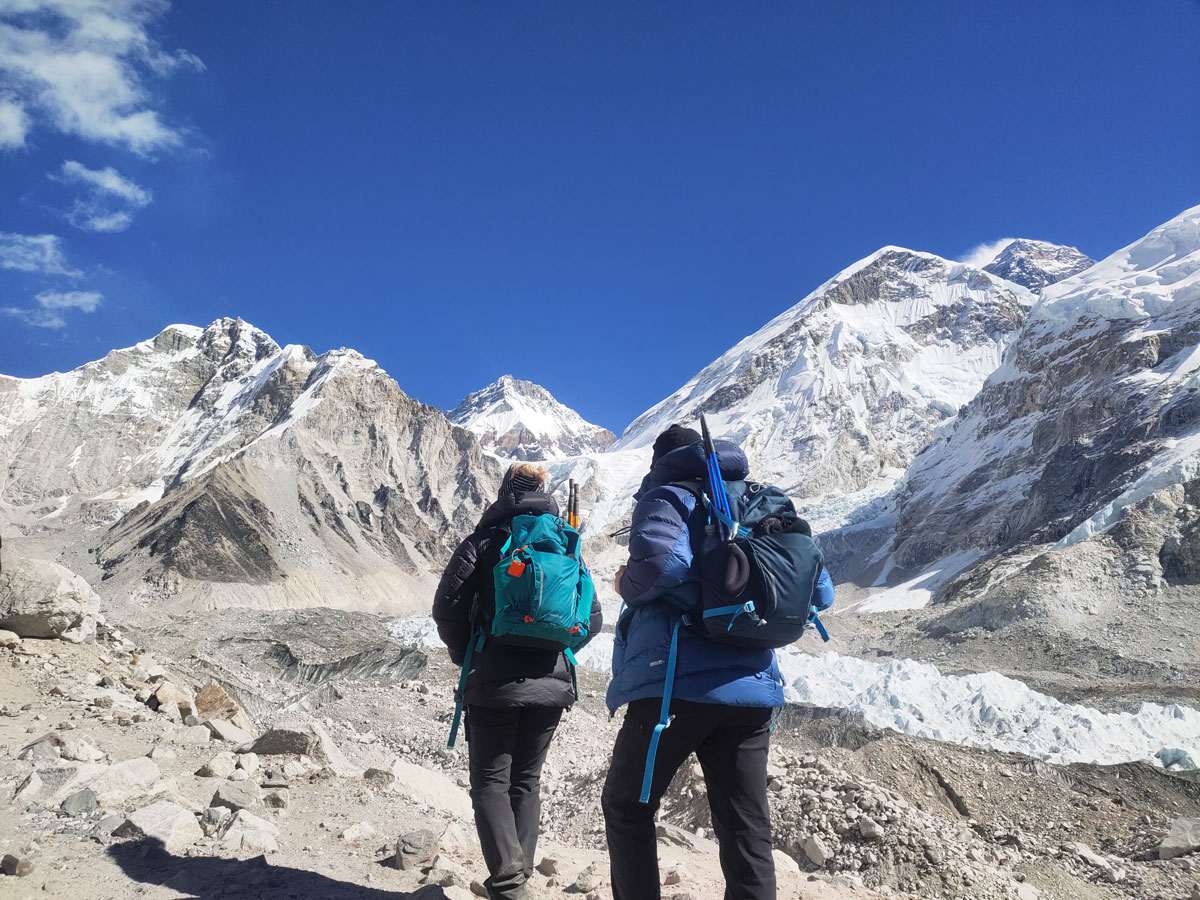
The Everest Base Camp trek is a remarkable adventure that offers a rare opportunity to explore the heart of the Himalayas.
Likely due to its monumental reputation, a commonly posed inquiry among enthusiasts bidding to make it to EBC revolves around the distance and duration of the trek.
As trekkers traverse the same paths once treaded by predecessors on their journey to the summit , they run across elaborate landscapes and ingrained cultural sentiments that defy expectations.
How long is the trek to Everest Base Camp?
Covering approximately 130 kilometers or 80 miles from Lukla to the Everest Base Camp and back, the EBC trek experiences a substantial altitude gain along the 14-day trek, its elevations emphasized both as a challenge and thrill.
Commencing with a scenic flight from Kathmandu to Lukla , which sets the stage for an exciting journey ahead, the trail unfolds with stops at captivating destinations such as Namche Bazaar, Phakding, Tengboche, Gorakshep, Dingboche and many more.
Throughout these destinations trekkers are treated to a visual feast of beautiful mountains, diverse vegetation and landscapes that shift with each step.
Beyond the physical adventure and natural beauty, the EBC trek is also a cultural pilgrimage. The rich tapestry of Sherpa heritage, their unique traditions and the Himalayan way of life encourages a deeper connection between the locals and the trekkers.
The Everest Base Camp trekking is an experience etched in the memory of those fortunate enough to have walked the magnificent trail.
Among various highlights, the pinnacle of the trek unfolds at the arrival at EBC, surrounded by towering peaks and the awe-inspiring Khumbu icefall, it is a moment of triumph and profound serenity.
Overview of the daily distances on the Everest base camp trek
Below is a tabulated outline of the distances between various locations along the Everest Base Camp trail, alongside the corresponding duration required to reach each destination:
Day 2: Lukla to Phakding (3 to 4 hours, 8.2 Km)
The trek officially begins after a scenic flight that lands at Lukla (2,840m) from Kathmandu, the capital city of Nepal.
Trekkers begin with a gentle descent to Chheplung from Lukla accompanied by the Dudhkoshi river to their left. Along the way, the captivating sight of Mount Kusum Kanguru (6,367m) unfolds at Thado Koshigaon, further leading to Ghat.
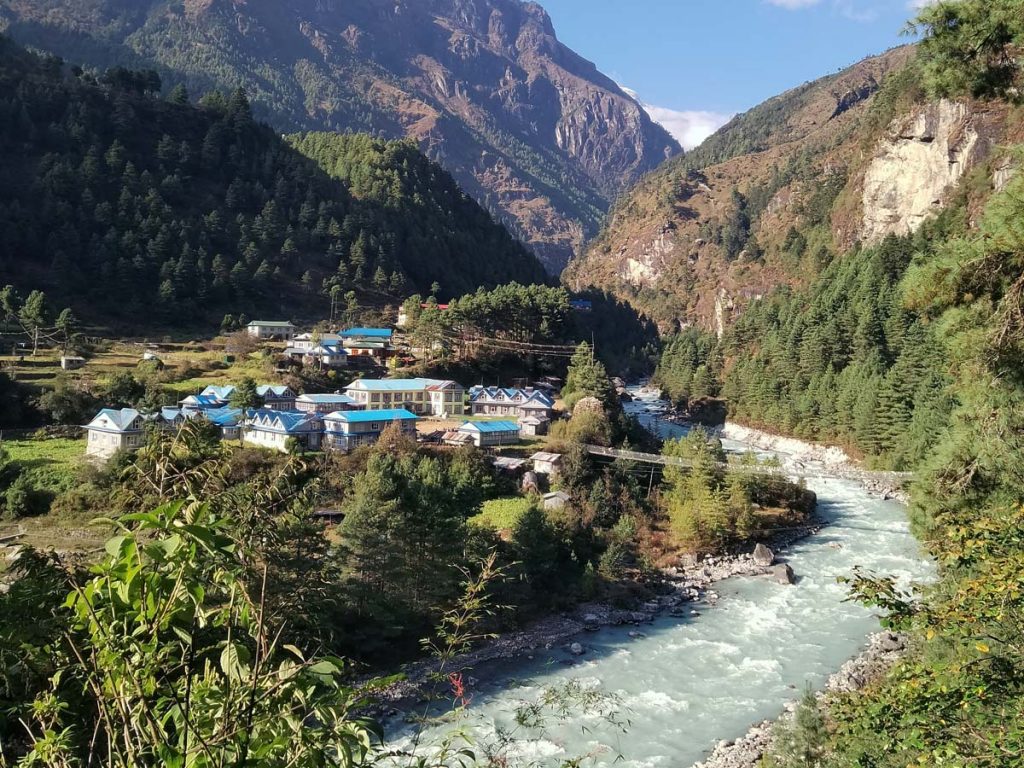
Unlike the initial portion of the trail, the concluding stretch from Ghat presents a gentle ascent, culminating at an altitude of 2,610m at Phakding.
Covering 8.2 kilometers, the trek from Lukla to Phakding is an approximately three-hour expedition through various suspension bridges and picturesque sherpa villages.
Day 3: Phakding to Namche Bazaar (6 to 7 hours, 12 Km)
On the 3rd day of the trek, through a slightly undulating trail, trekkers eventually get from Phakding to Monjo.
The path continues along the Dudhkoshi river and sets through a series of suspension bridges, and charming little villages to get to Bengkar where the majestic Thamserku (6,608m) looms into view.
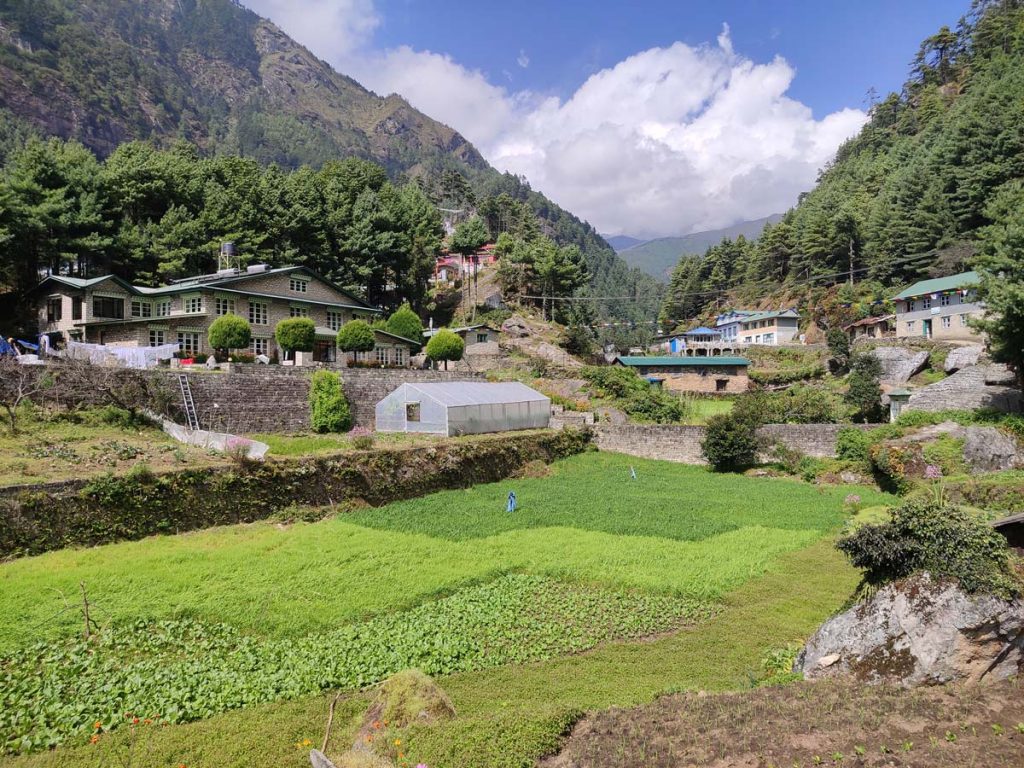
From Bengkar, the trail descends bringing trekkers to Jorsale while the trail identically fluctuates until the Hillary Bridge, named after Sir Edmund Hillary himself, also the last suspension bridge of the day.
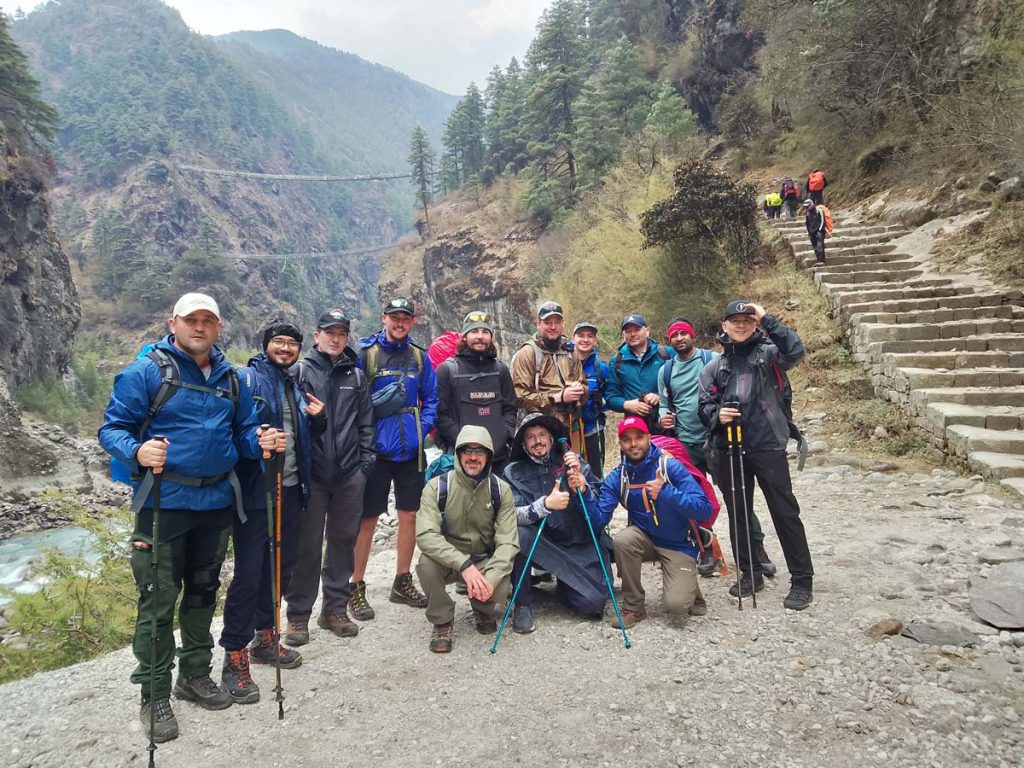
The 12-kilometer trek concludes after a steady 2.5-hour ascension to reach the bustling Sherpa town Namche Bazaar .
Day 4: Namche Bazaar acclimatization (4 to 5 hours, 5.4 Km)
The acclimatization trek begins with an ascension to Everest Viewpoint followed by the picturesque village of Syangboche, renowned among trekkers for its captivating views.
Further, trekkers navigate a dominantly flat trail to get to Hotel Everest View (3,880m).
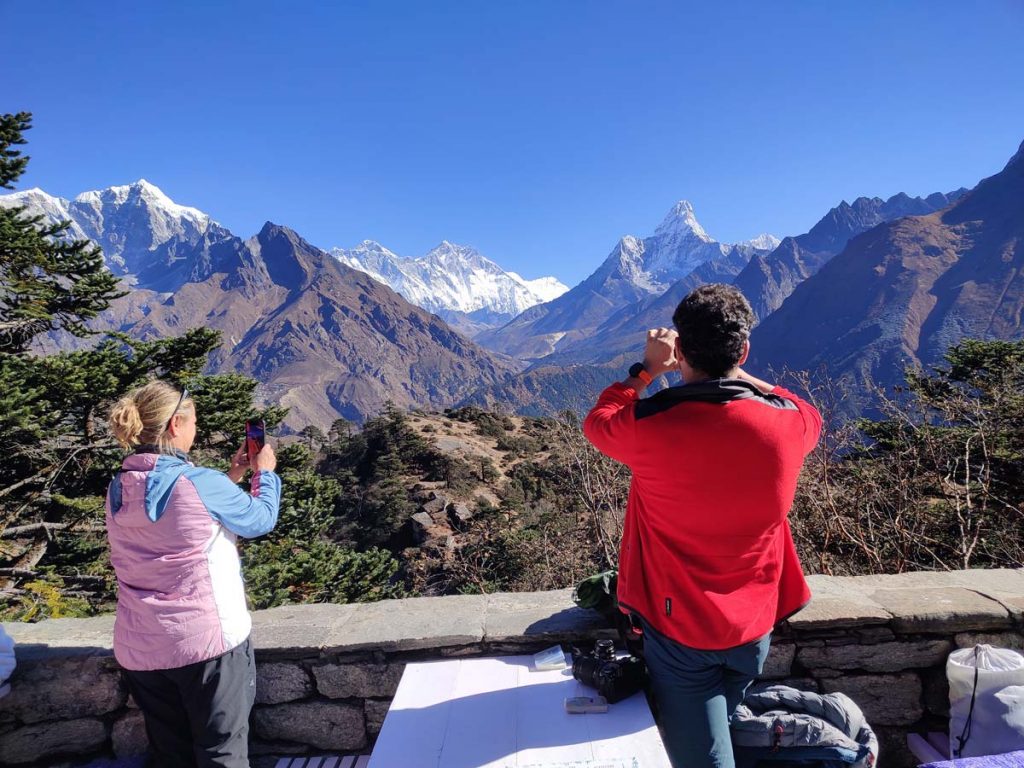
Boasting awe-inspiring vistas of peaks like Mount Everest (8,849m) , Lhotse (8,516m) , Nuptse (7,861m), and Ama Dablam (6,812m), Hotel Everest View is another popular viewpoint in the Khumbu region.
Ending with a descent from Hotel Everest View back to Namche Bazaar, the journey accumulates to roughly 4 hours and covers 5.4 kilometers.
Day 5: Namche Bazaar to Tengboche (5 to 6 hours, 10.5 Km)
The journey from Namche Bazaar to Tengboche commences with a trek to Kenjoma along its well-made, leveled yet undulating path.
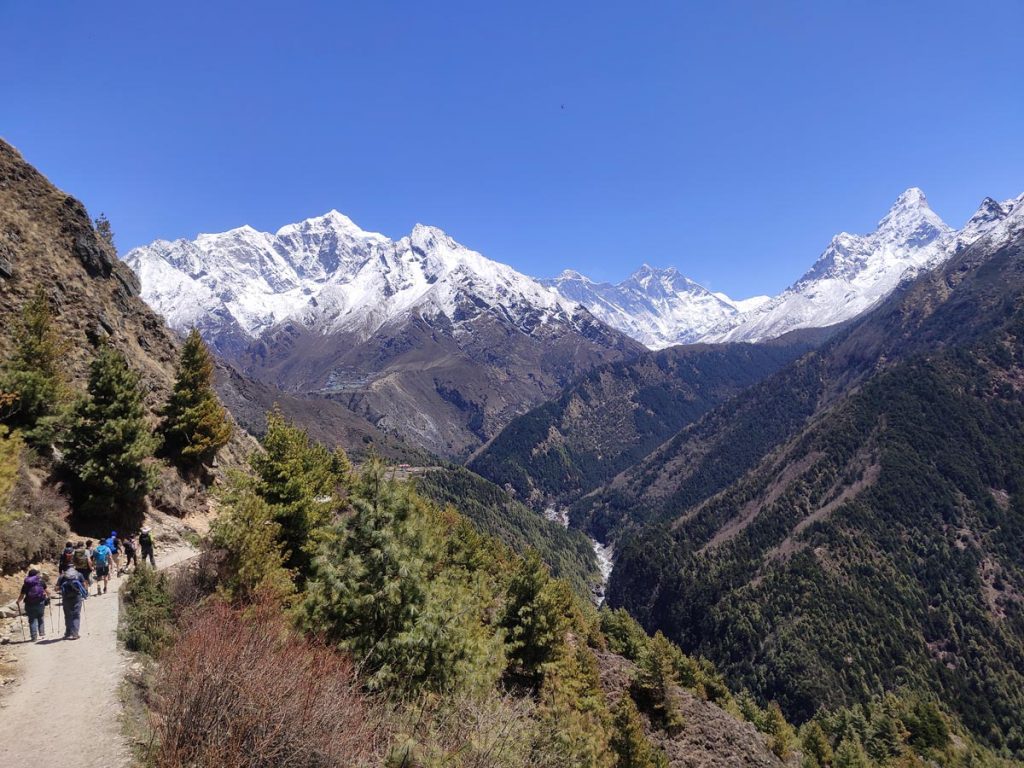
Following a gentle descent from Kenjoma trekkers reach Phunke Tenga where the breathtaking sights of majestic mountains like Kangtega (6,782m) and Thamserku (6,608m) unfold before them.
It is upon arrival at Tengboche that trekkers are rewarded with an even more intimate perspective of the surrounding mountains, enhancing the surreal beauty of the landscape.
Day 6: Tengboche to Dingboche (6 to 7 hours 11.5 Km)
On the 6th day of the trek, the journey from Tengboche (3,860m) to Dingboche (4,410m) spans 11.5 kilometers and takes approximately six hours to complete.
The trail beginning from Tengboche to Deboche is a gentle descent leading to Pangboche where trekkers are required to navigate a few suspension bridges.
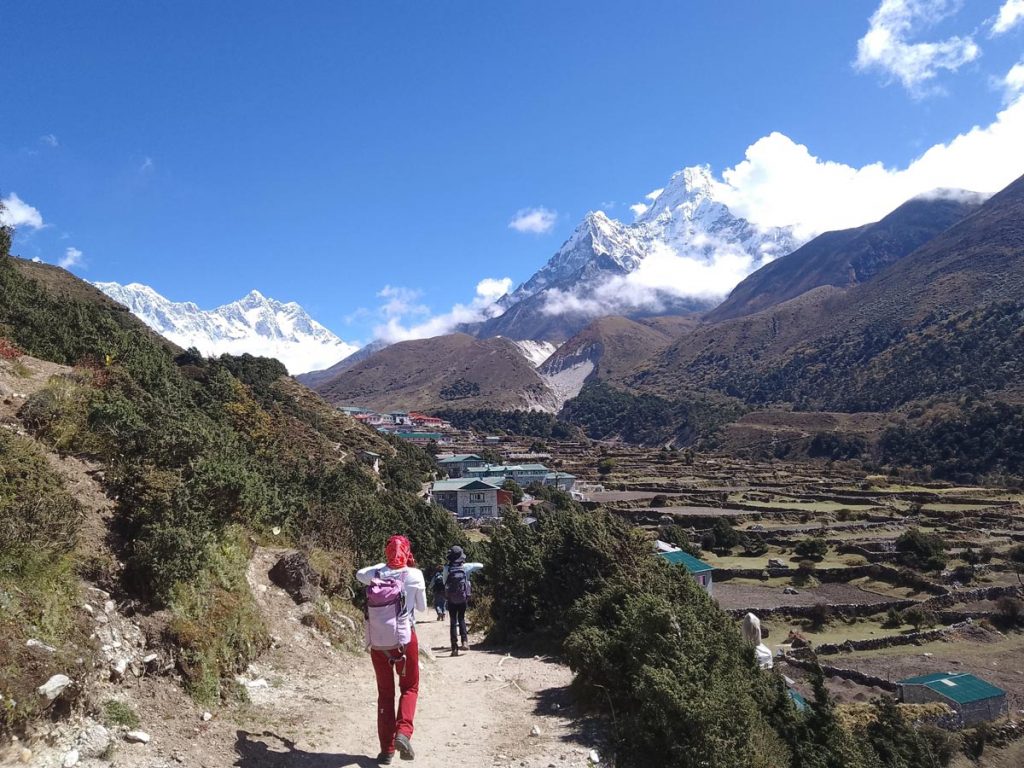
Pangboche a typical farm village, is renowned for cultivation in the area. Here, trekkers can also spot various massive mountains up-close.
Following a mild ascent while crossing the tree line, the final stretch where trees are still visible, trekkers reach Somare.
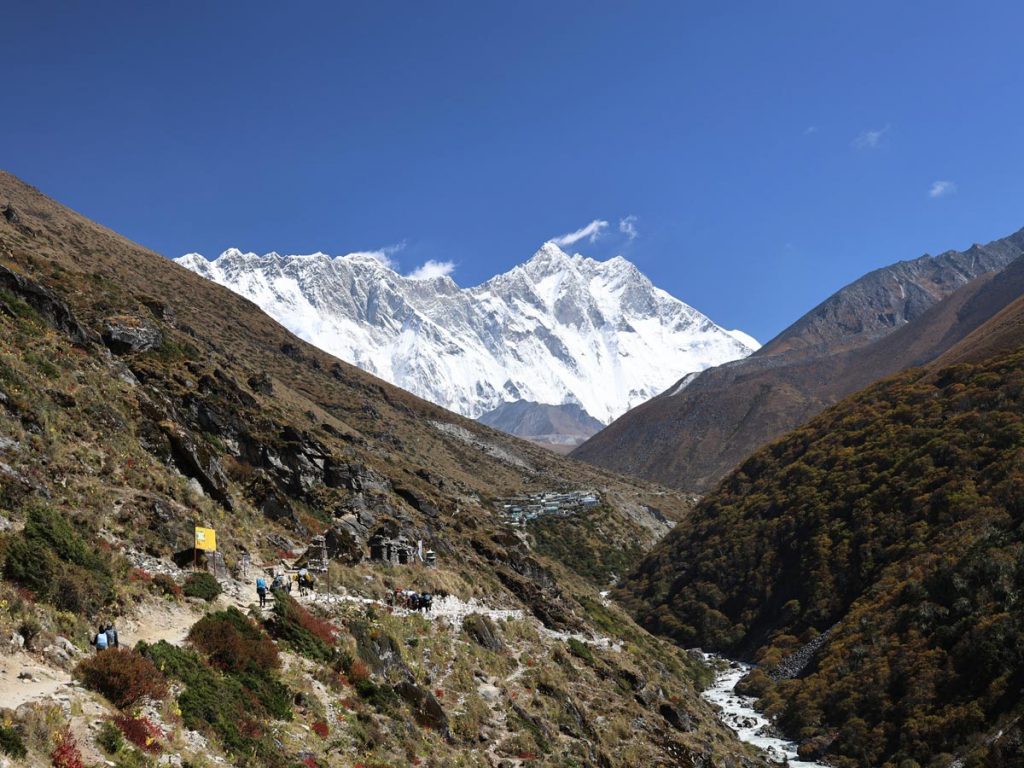
The final walk from Somare to Dingboche rewards trekkers with a closer view of mountains like Ama Dablam (6,812m), Nuptse (7,861m) and Lhotse (8,516m).
Further at Dingboche, you can also see mountains like Peak 38 (7,590m), Island Peak, Mount Chiumo (6,890m), and Ama Lapcha.
Day 7: Dingboche Acclimatization (5 to 6 hours, 5.1 Km)
Dingboche serves a pivotal role as an acclimatization point following Namche Bazaar. The trek begins with a demanding uphill ascent to reach the summit of Nangkartshang Peak (5,083m) .
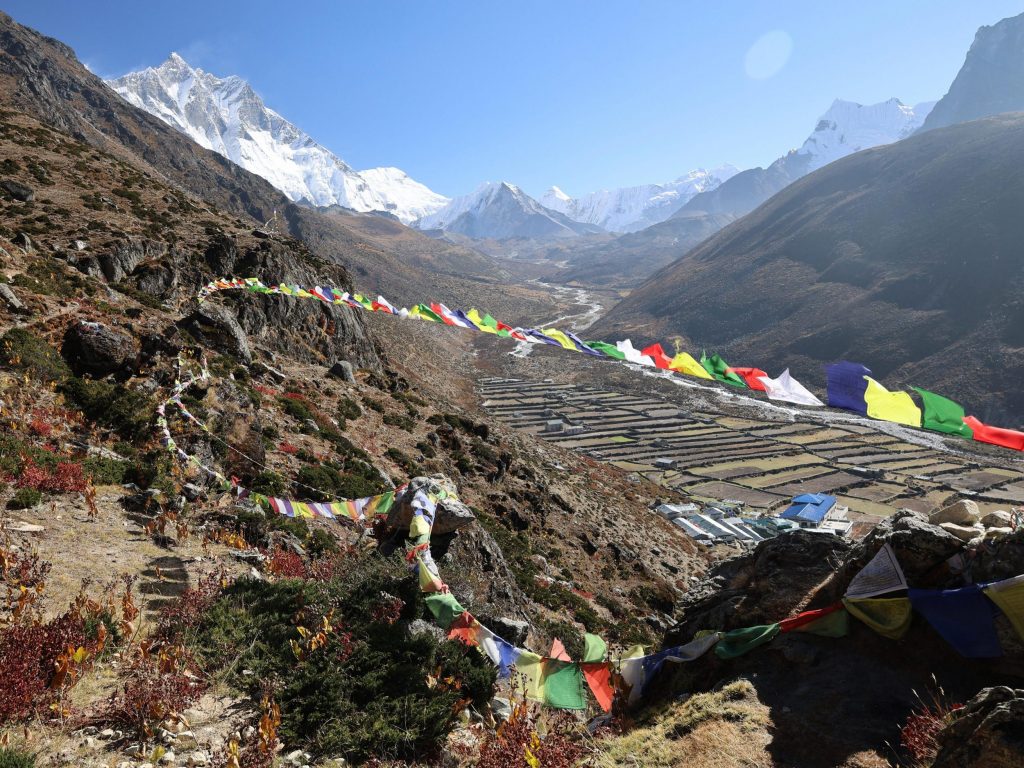
From the peak, trekkers can catch a panoramic view of mountains like Lhotse (8,516m), Nuptse (7,861m), Cho Oyu (8,188m), Ama Dablam (6,812m), Peak 38 (7,590m), Makalu (8,481m), Kusum Kanguru (6,367), and Baruntse (7,163m) gracefully surrounding the peak.
The acclimatization journey concludes as trekkers make their way back to Dingboche after having covered a total distance of 5.1 kilometers.
Day 8: Dingboche to Lobuche (5 to 6 hours, 8 Km)
On the 8th day, trekkers set out for Lobuche (4,910m), embarking on a roughly 5-hour long journey covering approximately 8 kilometers.
The path from Dingboche to Thukla involves a gentle ascent, offering trekkers glimpses of several mountains including the flanks of Cho La, Taboche (6,495m), and Cholatse (6,440m).
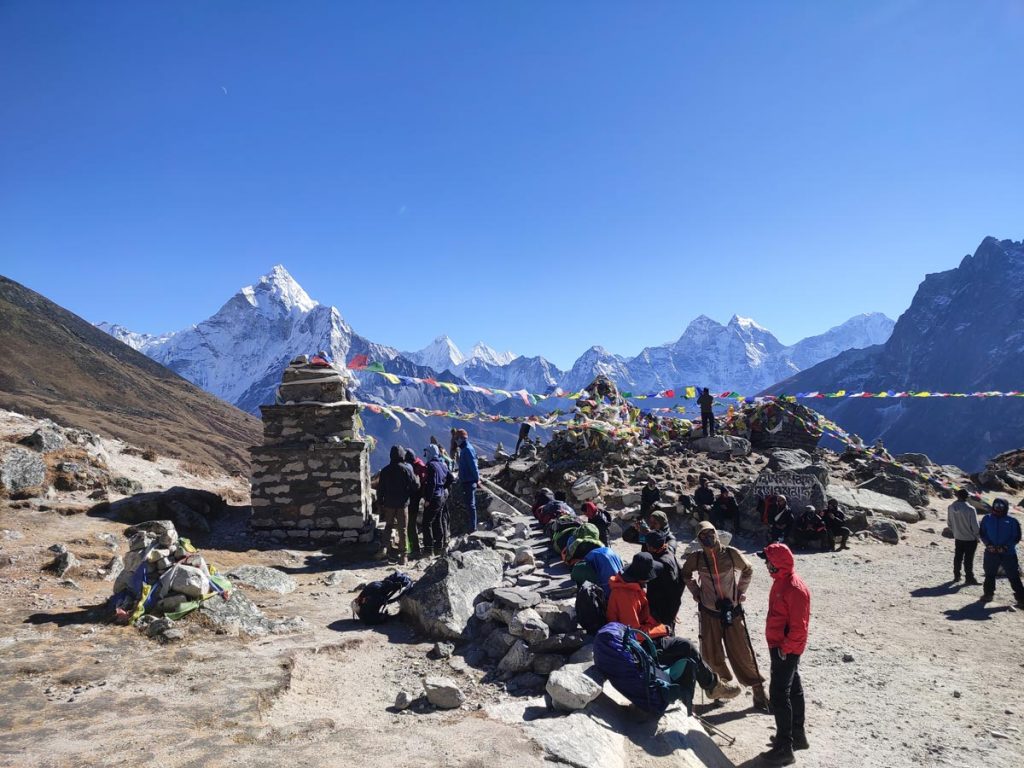
Ascending through the Khumbu Khola valley, the trail gradually leads to Thukla and continues upward until Thukla Pass.
Beyond the Thukla pass, the terrain transforms into a more rugged and barren landscape as trekkers approach Lobuche.
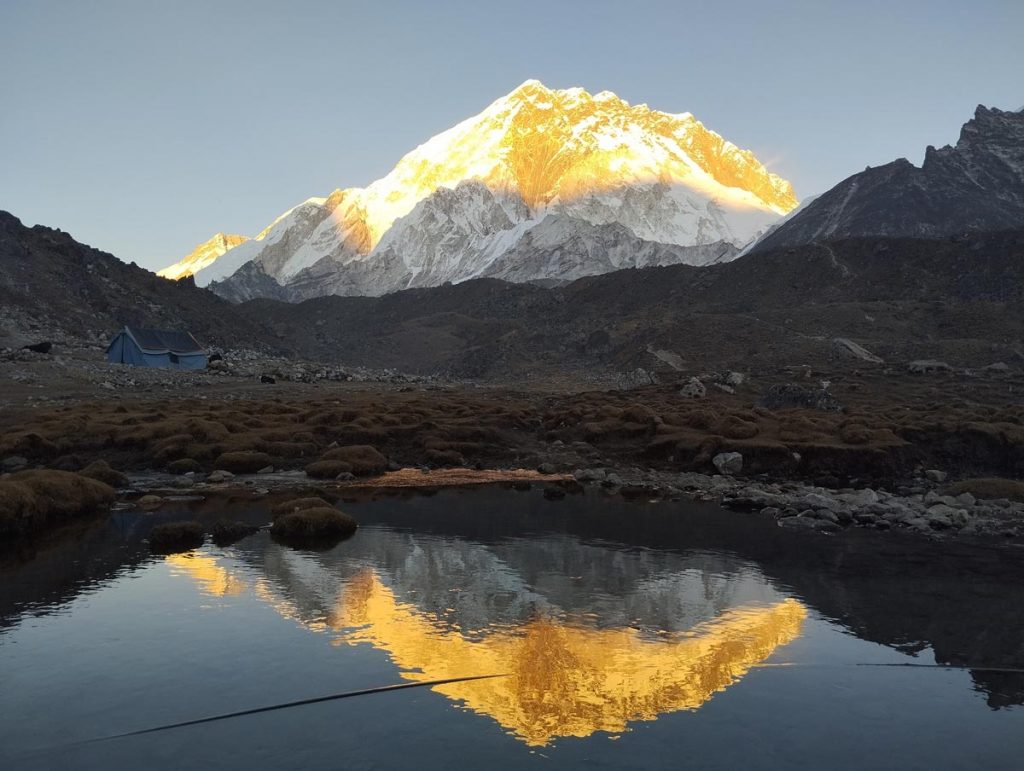
Lobuche further welcomes trekkers with captivating views of various mountains like Nuptse (7,861m) Changri (6,027m), Pumori (7,161m), and Lho La (6,006m).
Day 9: Lobuche to Everest Base Camp and back to Gorakshep (8 to 9 hours, 11.7 Km)
On the 9 th day trekkers journey towards Gorakshep (5,190m), beginning with a smooth ascent the concluding section of the trek is fluctuating and rocky.
The trek from Gorakshep to the Everest Base Camp is also a similarly undulating terrain, with frequent ascents and descents.
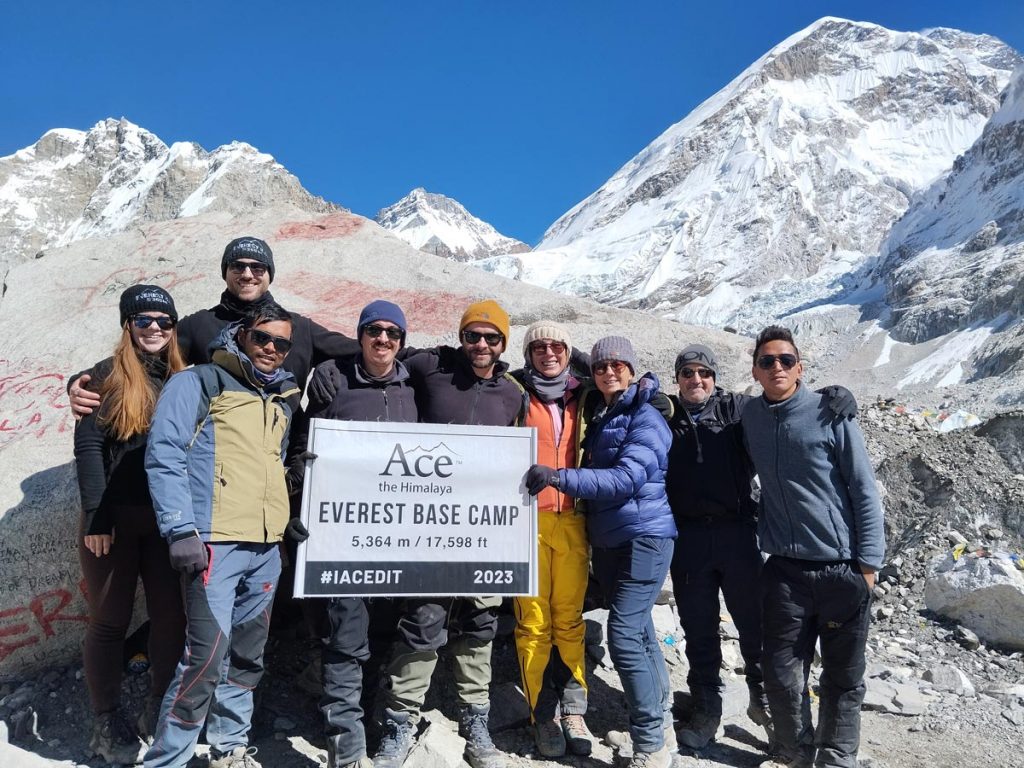
Upon reaching Everest base Camp, trekkers are rewarded with intimate views of the majestic Himalayan peaks.
Day 10: Hike to Kala Pathhar and descent to Pheriche (8 to 9 hours, 15.2 Km)
The ascent to Kala Pathhar (5,555m) from Gorakshep is an entirely uphill trek through steep, challenging terrain.
Upon reaching Kala Pathhar trekkers are rewarded with breathtaking 360-degree views of prominent mountains like Pumori, Lingtren (6,749m), Lho La, Mount Everest (8,849m), Lhotse (8,516m), Nuptse (7,861m), Ama Dablam, Kangtega (6,782m), Thamserku, Taboche, and Changri.
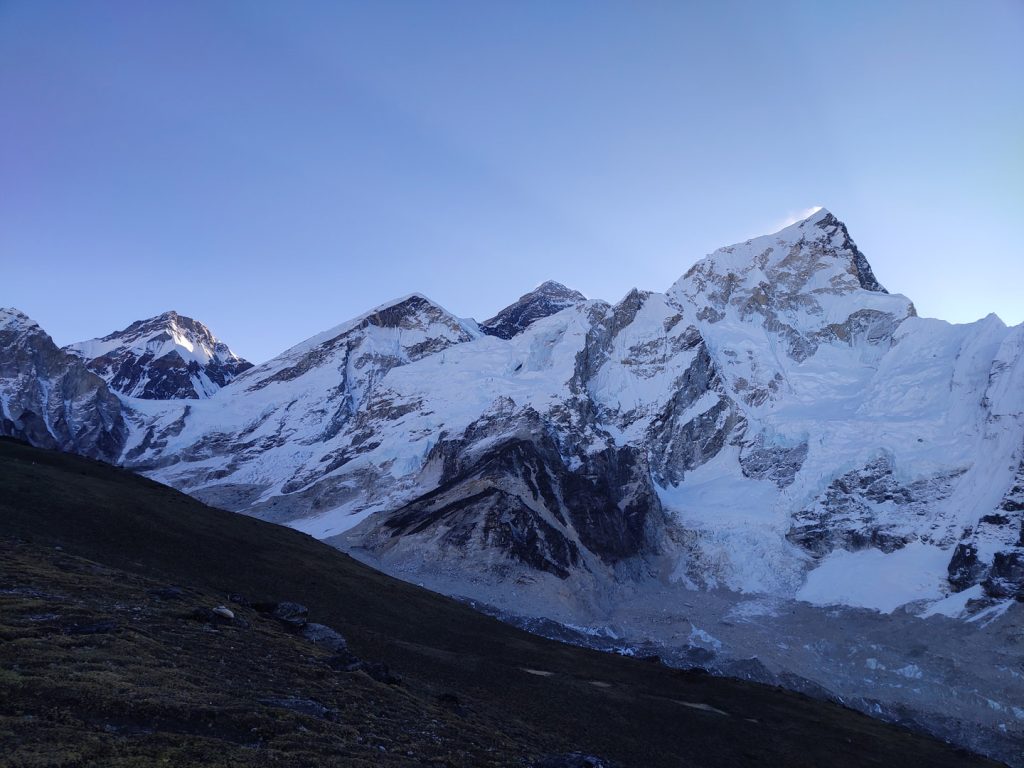
Descending back to Pheriche, trekkers retrace their steps through the same route used at the time of ascension, passing through Lobuche and Thukla Pass.
It is after Thukla Pass that trekkers diverge towards Periche, concluding their trek for the day.
Day 11: Periche to Namche Bazaar (7 to 8 hours, 19.5 Km)
The descent from Periche to Namche Bazaar constitutes the longest trek of the journey, encompassing a total distance of roughly 19.5 kilometers to be covered in approximately seven hours.
Trekkers retrace their steps through familiar landmarks with a beginning descent from Somare and gradually progress through Pangboche, Deboche, and Tengboche.
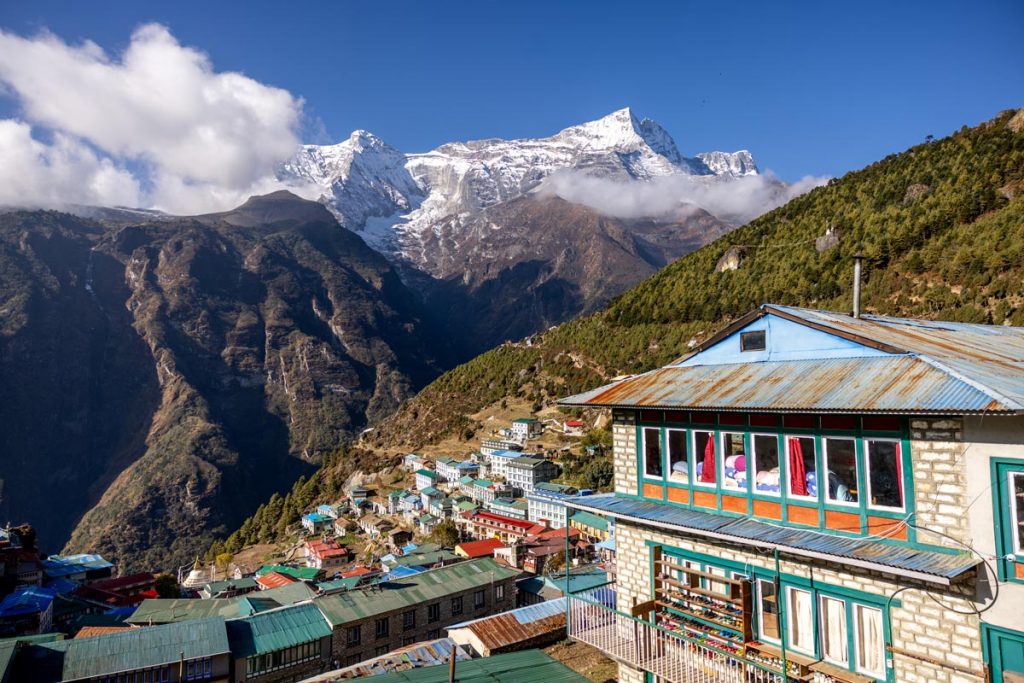
Only experiencing a significant descent at Phunke Tenga, trekkers ascend to Kenjoma and finally reach Namche Bazaar following a flat steady terrain.
Day 12: Namche Bazaar to Lukla (8 to 9 hours, 20 Km)
Namche Bazaar to Lukla marks the official conclusion of the Everest Base Camp trek.
Offering trekkers another opportunity to revisit familiar paths, this trek too retraces the trail taken at ascension.
Beginning from the descent to the Hillary Bridge, trekkers follow a fluctuating but steady trail through Jorsale, Monjo, Phakding and Chheplung.
Upon reaching Chheplung trekkers make a gentle ascent for a few meters to arrive at Lukla, the very destination where the trek concludes.
Related Blogs & Articles
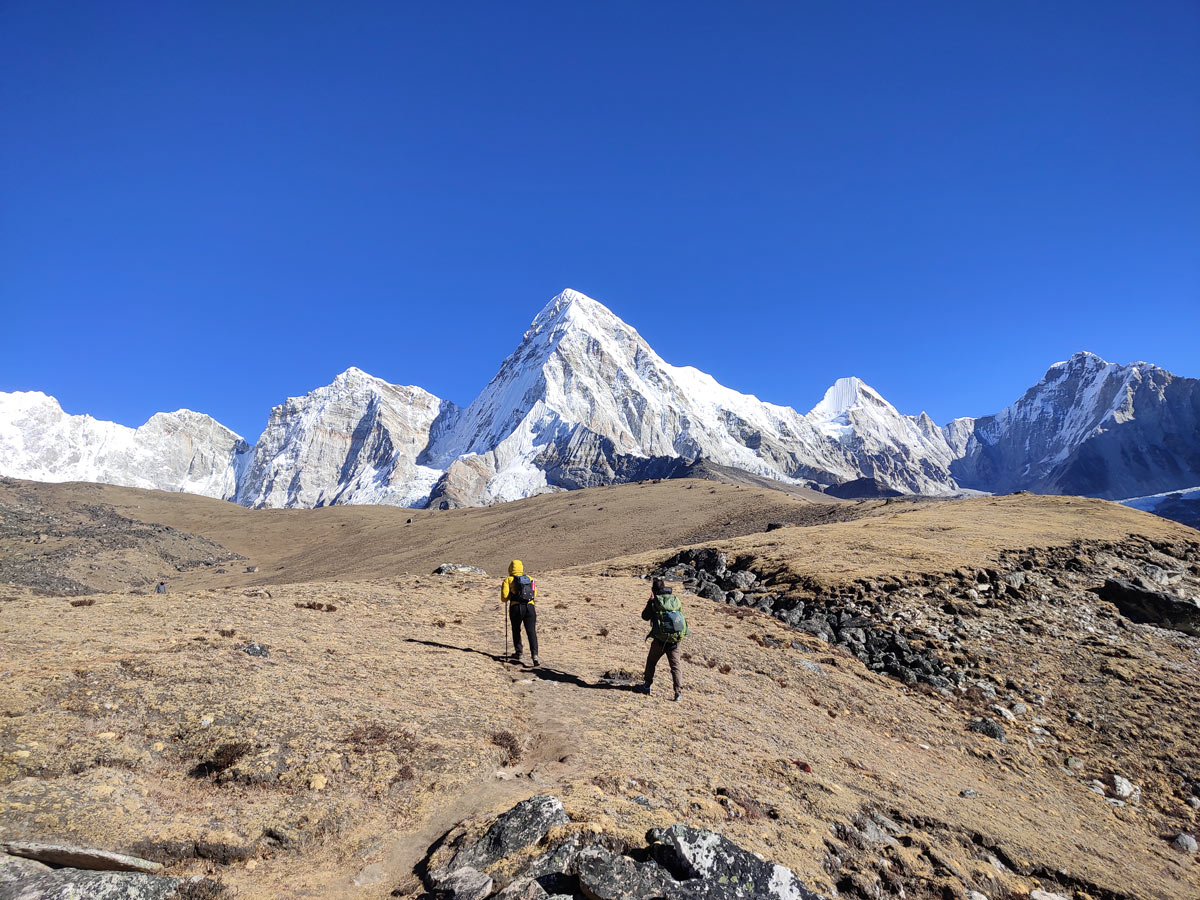
Elevation Gain during Everest Base Camp Trek
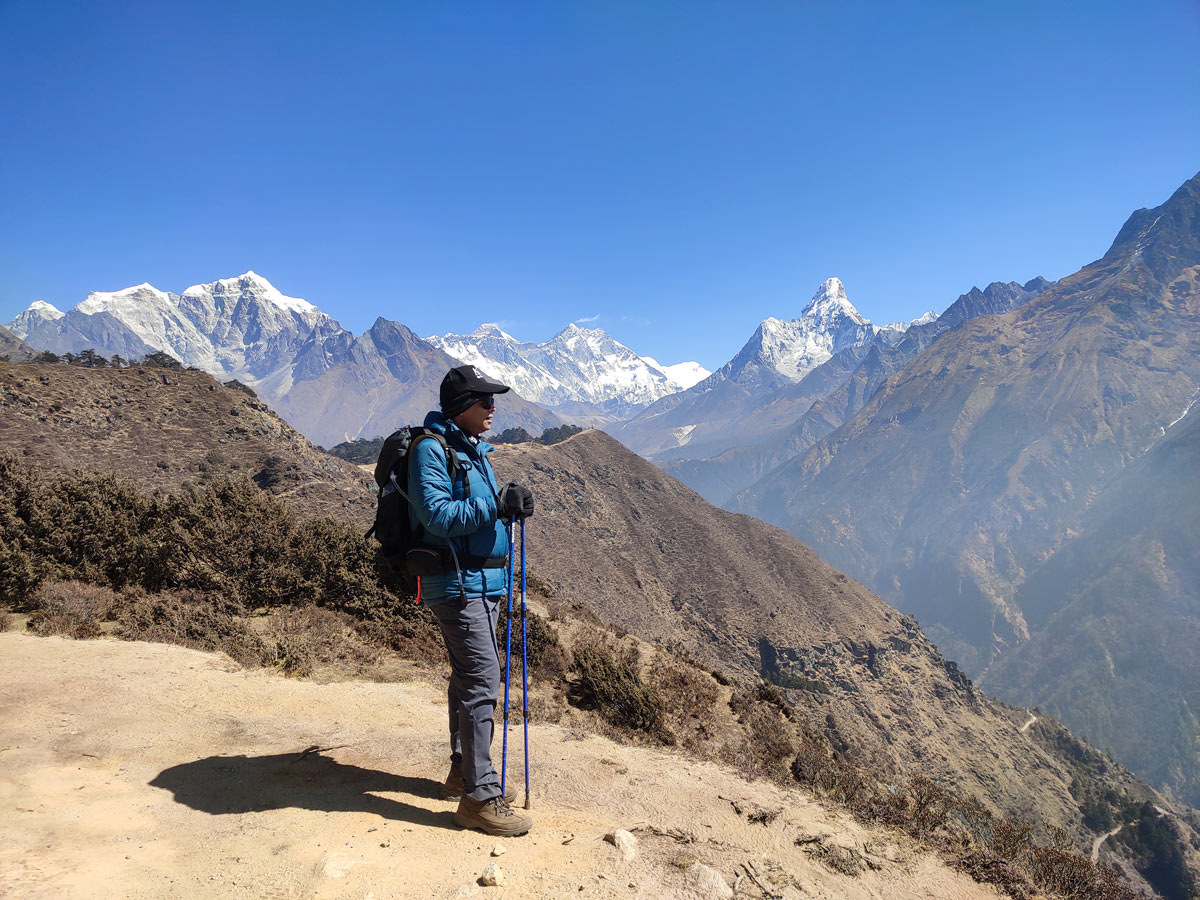
How physically fit should you be for Everest Base Camp Trek?
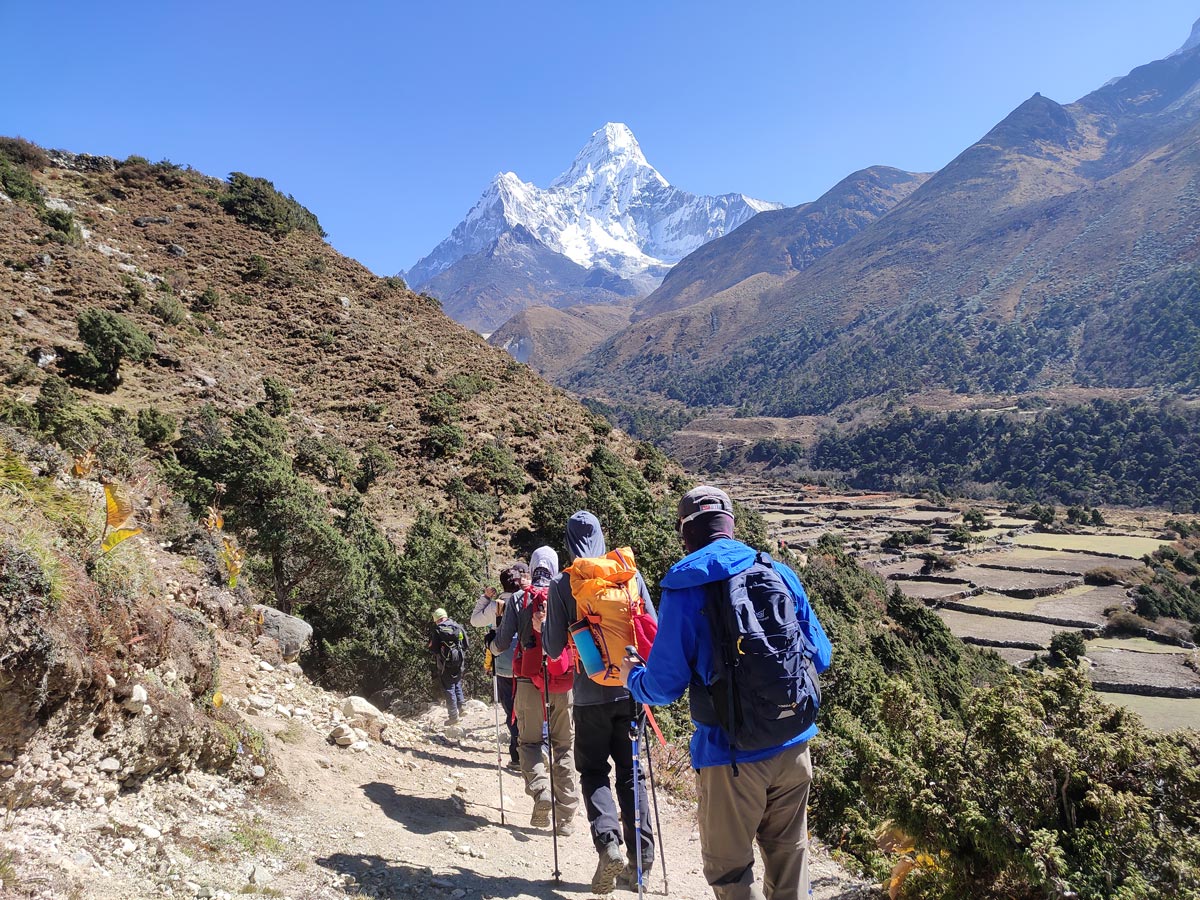
Shower and Laundry Services During Everest Base Camp Trek

- Name This field is for validation purposes and should be left unchanged.
Trekking in Nepal
Climbing and expedition, cultural tour and sightseeing, cycling and mountain biking, luxury treks, luxury tours, multi country tours, voluntourism trips, extend your trip.
- Everest Base Camp Heli Trek – 8 Days
- Everest Panorama Trek – 9 Days
- EBC Trek with Helicopter Return – 12 Days
- Everest Base Camp Trek – 14 Days
- Gokyo Lake Trek – 13 Days
- Gokyo and Renjo La Pass Trek – 14 Days
- Everest Base Camp Trek without Lukla Flight – 17 Days
- Gokyo to Everest Base Camp Trek – 17 Days
- Everest Base Camp with Island Peak – 19 Days
- Everest Three Passes Trek – 20 Days
- Everest High Passes and Island Peak – 23 Days
- Classical Everest Base Camp Trek – 21 Days
- Langtang Valley Trek – 10 Days
- Langtang Valley Ganja La Pass Trek – 14 Days
- Langtang Helambu Trek – 17 Days
- Ghorepani Poon Hill Trek – 9 Days
- Mardi Himal Trek – 10 Days
- Annapurna Base Camp Trek – 13 Days
- Himalayan Highlights – 13 Days
- Nar Phu Valley Trek with Annapurna Circuit – 18 Days
- Annapurna Circuit Trek – 19 Days
- Tilicho Lake Trek With Thorong La Pass – 19 Days
- Khopra Danda Trek – 11 Days
- Shivapuri-Chisapani Trek – 4 Days
- Upper Mustang Trek (Drive & Trek) – 16 Days
- Tsum Valley Trek – 16 Days
- Manaslu Circuit Trek – 15 Days
- Dhaulagiri Circuit Trek – 21 Days
- Upper Dolpo Trek – 25 Days
- Kanchenjunga Base Camp Trek – 29 Days
- Yala Peak Climbing – 13 Days
- Island Peak Climbing – 15 Days
- Mera Peak Climbing – 19 Days
- Everest Base Camp and Lobuche East – 18 Days
- Tent Peak Climbing with Annapurna Base Camp – 18 Days
- Pisang Peak and Thorung La Pass – 21 Days
- Ama Dablam Expedition – 29 Days
- Kathmandu Cultural Heritage Tour – 3 Days
- Kathmandu Heritage – 3 Days
- Inheritances of Kathmandu – 4 Days
- Glimpses of Kathmandu & Nagarkot – 5 Days
- Kathmandu and Pokhara Unveiled – 5 Days
- Explore Kathmandu – 6 Days
- Glimpse of Nepal – 8 Days
- Nepal Heritage Tour – 10 Days
- Nepal Adventure Tour – 11 Days
- Nepal Multi Sports Adventure – 11 Days
- Nepal Vista – 10 Days
- Nepal Highlights – 14 Days
- Experience Nepal – 15 Days
- One Day Biking Trip – Kathmandu – 1 Day
- Annapurna Circuit Biking – 14 Days
- Upper Mustang Biking – 16 Days
- Kathmandu Valley Rim Biking – 8 Days
- Annapurna in Luxury – 9 Days
- VVIP Everest Base Camp Trek – 10 Days
- Everest View Luxury Trek – 11 Days
- Everest Base Camp Luxury Trek – 14 Days
- Everest Base Camp Deluxe Trek – 16 Days
- Mt Everest Base Camp to Gokyo Trek – 19 Days
- Kathmandu Luxury Tour – 3 Days
- Kathmandu and Pokhara Luxury Tour – 5 Days
- Nepal Multi Sport Luxury Adventure – 11 Days
- Best of Nepal – 14 Days
- Trishuli River Rafting – 1 Day
- Everest Base Camp Helicopter Tour – 1 Day
- Everest Base Camp Heli Tour with Gokyo Extension – 1 Day
- Langtang Heli Sightseeing – 1 Day
- Pokhara and Annapurna Heli Sightseeing – 1 Day
- Paragliding in Nepal (Pokhara) – 1 Day
- Scenic Mountain Flight (Everest Flight) – 1 Day
- Ultra Light Flight – 1 Day
- Jamacho Day Hike-One day hiking trip – 1 Day
- Kathmandu Uncovered with Nagarkot – 1 Day
- Day Tour to UNESCO Heritage Sites – 1 Day
- Nepal and Tibet – 15 Days
- Nepal and Bhutan – 15 Days
- India, Nepal and Bhutan – 19 Days
- Nepal, Tibet and Bhutan – 20 Days
- Arupokhari School Volunteer Program – 14 Days
- Rebuild Home Volunteer Program – 9 Days
- Bardiya Jungle Safari – 4 Days
- Chitwan Jungle Safari – 3 Days
Trekking in Bhutan
Festival tours, motorcycling.
- Druk Path Trek – 8 Days
- Chomalhari Trek – 12 Days
- Laya Ghasa Trek – 18 Days
- Bhutan Vistas Tour – 5 Days
- Cultural Heartland Tour – 10 Days
- Hidden Valley – 11 Days
- Bhutan Multi Sports Tour – 11 Days
- Paro Tshechu Festival – 8 Days
- Punakha Tsechu – 9 Days
- Trongsa Lhuntse Tshechu – 9 Days
- Bumthang Tangbi – 11 Days
- Bhutan Ura Yakchoe – 12 Days
- Tamshingphala Choepa – 12 Days
- Mongar and Trashigang – 16 Days
- Bhutan Biking – 8 Days
- Bhutan Motorcycle Tour – 12 Days
Trekking in Tibet
- Tibet Advance Everest Base Camp – 21 Days
- Cho Oyu Expedition – 45 Days
- Shishapangma Expedition – 47 Days
- Everest Expedition via North Side – 63 Days
- Kathmandu and Lhasa Tour – 7 Days
- Tibet Heritage Tour – 8 Days
- Overland Tour to Everest Base Camp – 10 Days
- Mount Kailash Mansarovar Lake Tour – 15 Days
- Everest Base Camp Biking Tour – 21 Days

Mosaic Adventure
Unleash the trekking bug in you…. experience the Himalayan touch……
Lukla to Everest Base Camp | Everest Base Camp Route from Lukla
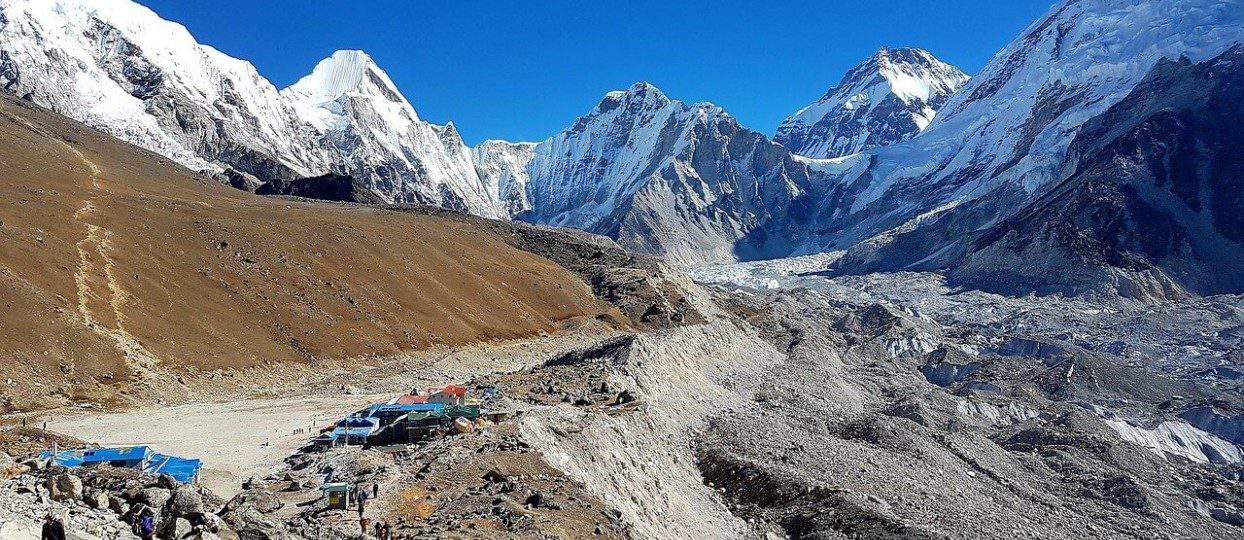
Trekking from Lukla to Everest Base Camp in the Everest region, locally known as Khumbu region , is on the bucket list of every trekking enthusiast.
Trekking to the base of Mount Everest is a dream of every trekker and adventure seeker.
Who wouldn’t want to see the world’s highest peak in front of them?
The Everest Base camp trek takes you to the foothills of the world’s highest mountain, Mount Everest.
Standing at 5,364 meters, the Everest Base Camp offers an up-close view of some of the world’s highest peaks.
Ever since Lukla airport was established in 1964, the Lukla to Everest Base Camp route has been the standard and most popular trekking route in the Everest region.
In the past, the trail from Jiri was the only route to Everest; these days, the trail that starts from Jiri to Everest Base Camp is known as the classic Everest Base Camp Trail.
Everest Base Camp Trek (EBC Trek) will fill your journey with amazing experiences and memories.
You can explore the rich Sherpa culture and witness the astounding biodiversity of Sagarmatha National Park .
Centuries-old monasteries found while going from Lukla to EBC are historic and hold great value among the locals.
En route from Lukla to Everest Base Camp, we spend overnight at Tyangboche. This small Tyangboche village is named after the Tyangboche Monastery, which is also known as Dawa Choling Gompa.
It is the largest monastery in the Everest region and is the Sherpa community’s Tibetan Buddhist monastery.
Mount Everest is gorgeous by itself, and the people living around make the place even better.
The views are incredible, and the overall experience is unforgettable.
So wait no more, pack your bags and begin on your journey from Lukla to EBC.
Table of Contents
Highlights of Lukla to Everest Base Camp:
Lukla to everest base camp brief itinerary:, day 1: take a short flight to lukla, followed by a trek to phakding., day 2: trek to namche bazaar via monjo., day 3: acclimatization day. hike to everest view hotel, explore khumjung and back to namche., day 4: trek to tyangboche, day 5: trek to dingboche., day6: hike to nagartshang peak and back to dingboche., day 7: trek to lobuche., day 8: trek to gorakshep and return trip to everest base camp., day 9: sunrise viewing hike to kala patthar and return to pheriche., day 10: trek back to namche bazaar., day 11: trek to lukla., day 12: flight back to kathmandu., lukla to everest base camp trek map, lukla to everest base camp distance, lukla to everest base camp by car price, lukla to everest base camp helicopter price, lukla to everest base camp elevation, best time to trek from lukla to everest base camp, what are teahouses, head and hands, toiletries and personal hygiene, accessories, additional recommended items, importance of acclimatization on your journey from lukla to ebc:, in conclusion,.
- An exhilarating mountain flight above the great Himalayan range marks the start of this remarkable journey to Everest Base Camp as you fly from Kathmandu to Lukla.
- Experience the historically rich culture of the Sherpas and immerse yourself in the local lifestyle.
- Centuries-old monasteries reflect the richness of art, architecture, and history.
- The views throughout the Everest Base Camp trek are some of the best in the world, with glorious peaks always in sight.
- Green valleys with dense forests add beauty to the landscape, and the biodiversity at this altitude in Sagarmatha National Park is astounding.
- Reaching the Mount Everest Base Camp, at the base of the world’s highest mountain standing at an altitude of 8845 meters, is an achievement in itself.
- Watch the sunrise from the top of Kala Patthar; the beauty during the golden hour will leave you spellbound.
- You will also have a chance to witness the Khumbu Glacier, the world’s highest glacier.
Day 2: Trek to Namche Bazaar.
Day 3: Acclimatization and side trips in Namche.
Day 4: Trek to Tyangboche.
Day 6: Hike to Nagartsang and back to Dingboche.
Day 8: Arrive at Everest Base Camp and trek back to Gorakshep.
Day 9: Hike to Kala Patthar and Pheriche.
Day 10: Trek to Namche Bazaar.
Day 12: Flight back to Kathmandu and onward to your hotel.
Detailed Itinerary of Lukla to EBC:

Maximum altitude: 2,840 meters
Duration: 3-4 hours
The day begins with an exhilarating flight to Lukla, overlooking the grandeur of the Himalayas. It is an adventurous start to this fantastic journey.
After landing in Lukla, you trek for about 3 to 4 hours, mostly downhill through forests of rhododendron and oak trees, crossing traditional Sherpa villages.
The trail is comfortable for walking and is well-maintained.
Overnight in Phakding.

Maximum altitude: 3,440 meters
Duration: 6-7 hours
The walk starts to get a bit tough from this day.
The trail leading to Namche from Phakding is rocky and steep, mostly uphill.
Suspension bridges, including the famous Hillary Bridge on the way to Namche, might give you chills.
The Hillary Bridge, named after Sir Edmund Hillary, is the final suspension bridge that you have to cross while entering the famous town of Namche Bazaar.
Along the way from Phakding to Namche Bazaar, other than these thrilling suspension bridges, the sight of dense forests of rhododendron, fir, and magnolia alongside the Dudh Koshi river will calm your heart and soul.
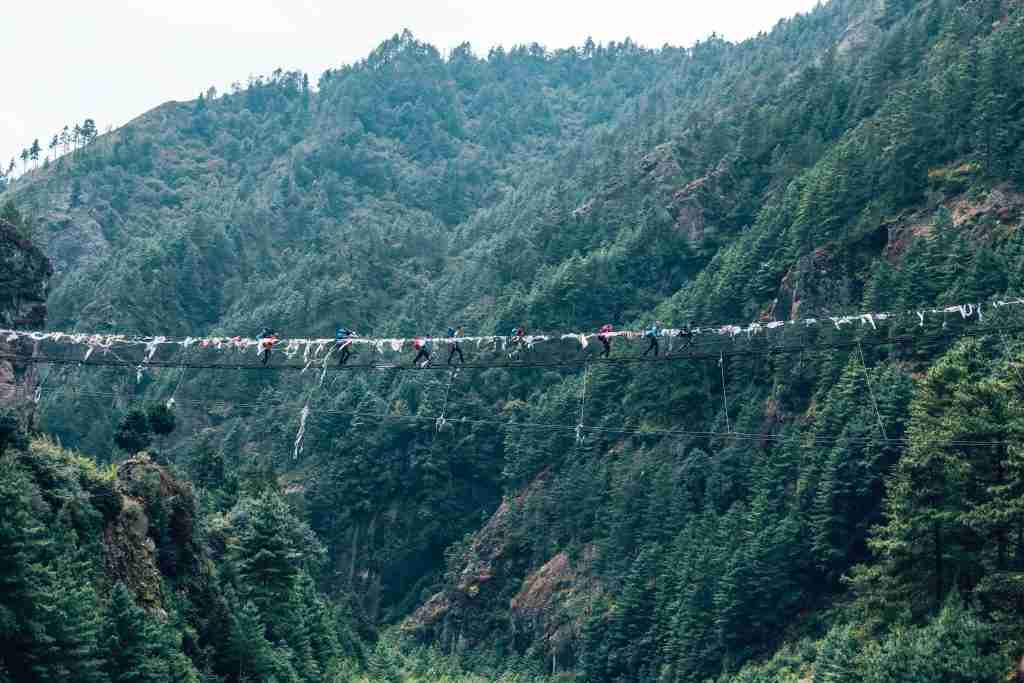
As you get close to Namche Bazaar , the snowy peaks start to appear on the backdrop of this high altitude popular settlement of Namche.
This Sherpa village, with beautiful houses and hotels, is a perfect spot for acclimatization.
Overnight in Namche Bazaar.
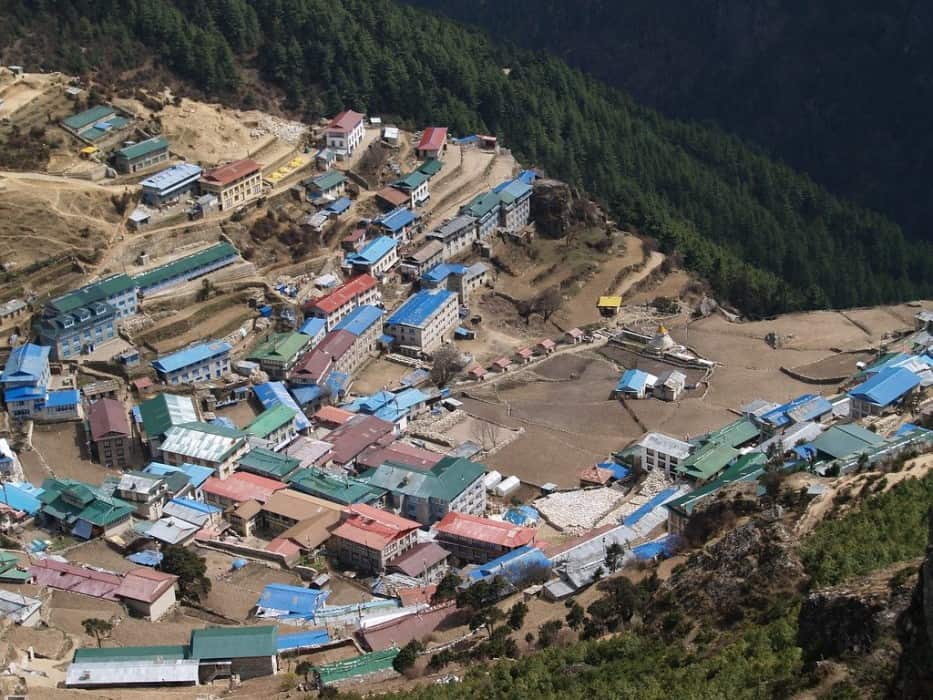
Maximum altitude: 3,962 meters at Everest View Hotel, 3,790 meters at Khumjung
Duration: 4 hours
Since you are at an altitude of 3,440 meters, it’s better to acclimatize.
You hike up to the Everest View Hotel, which is the highest altitude hotel in the world, offering spectacular views of Everest and many other peaks.
The place where the Everest View Hotel is situated is known as Syangboche.
While descending, we explore the Sherpa village of Khumjung.
You can witness the local lifestyle of the people here.
There is a Sherpa cultural museum you can visit to find out more about Sherpas, their culture, and lifestyle.
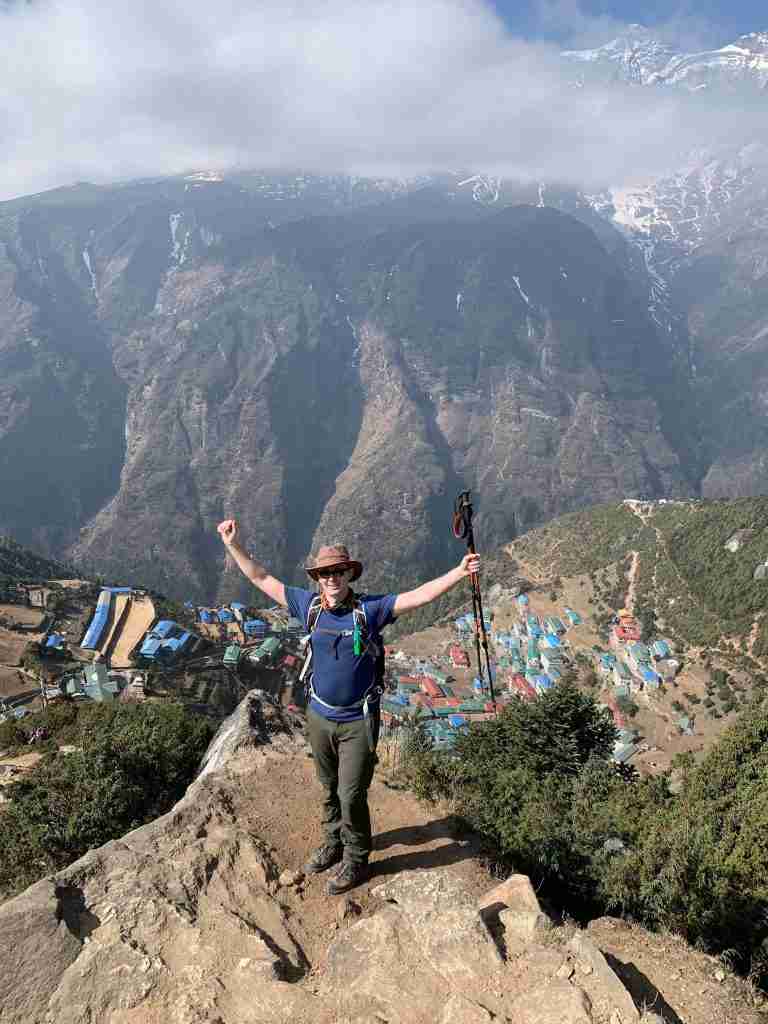
Besides these, Namche offers excellent facilities for teahouses, restaurants, pubs and bars to relax.
Overnight in Namche.
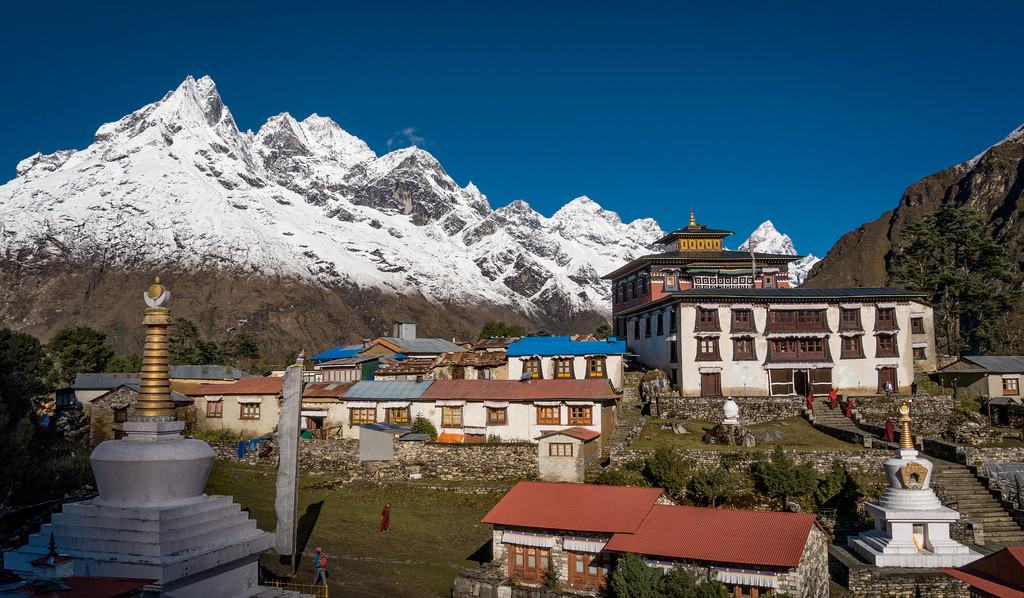
Maximum altitude: 3,860 meters
Duration: 5 hours
On this day, you will walk along the river banks with a few steep inclines.
The vegetation will start to disappear.
The view from Tyangboche is an absolute delight for the eyes.
You will see panoramic views of various mountains such as Kwangde, Nuptse, Lhotse, Ama Dablam, and Mt Everest.
Tyangboche, also known as Tengboche, gets its name from the centuries-old monastery, the Tyangboche monastery, which is of utmost importance in the Khumbu region.
The friendly monks, intricate artwork and blissful aura of this place should not be missed.
Overnight in Tyangboche.
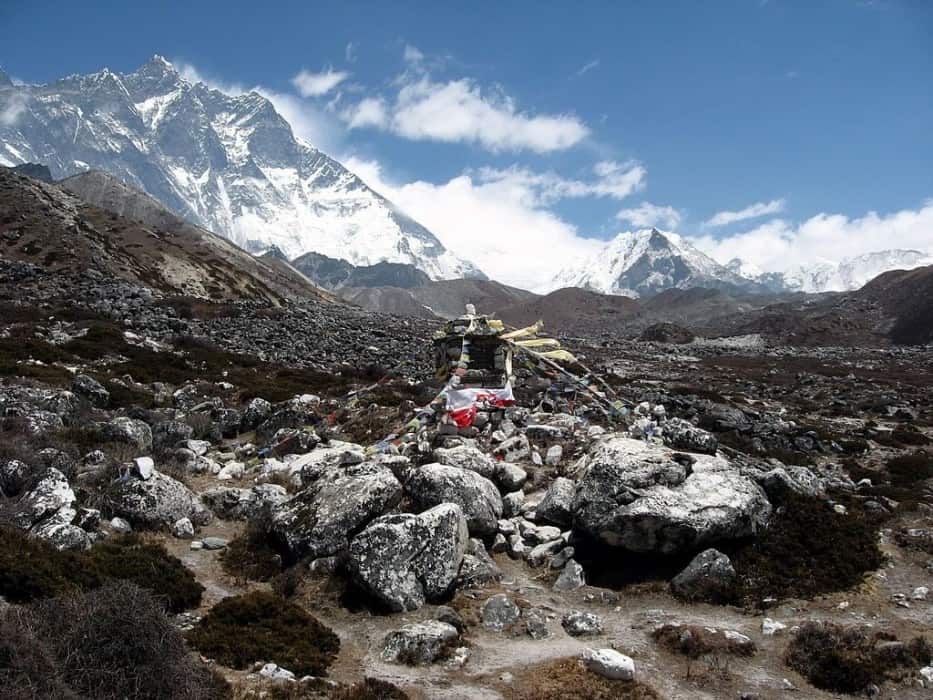
Maximum altitude: 4,360 meters
The section of the Lukla to Everest Base Camp trail on this day is moderately steep.
You will walk through rocky uphill tracks for most of the day. You will cross the 4,000-meter mark today.
As expected, the peaks seem to be getting closer, and amazing views start to appear.
Beautiful mountains such as Lhotse, Island Peak, and Ama Dablam look gorgeous.
You will come across the Pangboche monastery where you can find the allegedly claimed yeti scalp.
The walk follows the trail along Imja Khola. Mani stones and prayer flags add to the beauty of this path.
Overnight at Dingboche.
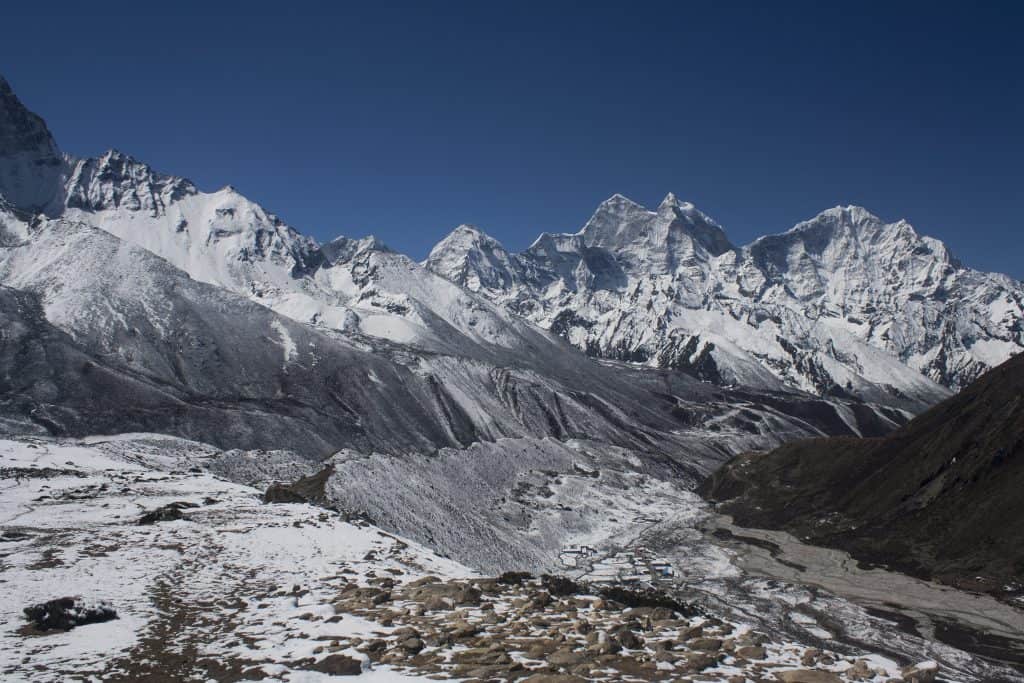
Maximum altitude: 5,080 meters
Duration: 4 hours
Today, you will spend a day acclimatizing in Dingboche.
While in Dingboche, hiking up to Nagartshang (also known as Nagartsang or Nagarjun) peak is a perfect acclimatization hike.
Nagartshang, at an altitude of 5,080 meters, is an uphill ascent on a rocky and steep trail.
This viewpoint offers a mesmerizing view of Makalu and Lhotse.
Hiking up to this altitude and returning to sleep at Dingboche will help your body adapt to the increasing altitude.
Overnight in Dingboche.
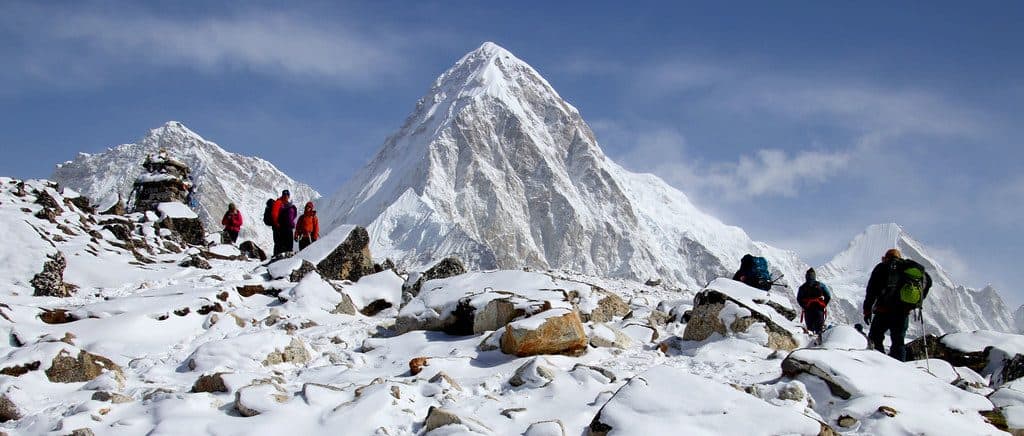
Maximum altitude: 4,940 meters
The trail from Dingboche to Lobuche is rocky with some steep inclines.
It is a tough hike, and the high altitude adds to the adventure.
As you ascend higher, the views of Mount Pumori and Khumbu Icefall are rewarding.
After a long steep climb, the panoramic view from the top is exceptionally satisfying.
There is a memorial in Lobuche in memory of people who lost their lives while attempting to conquer the mountains.
Overnight in Lobuche.
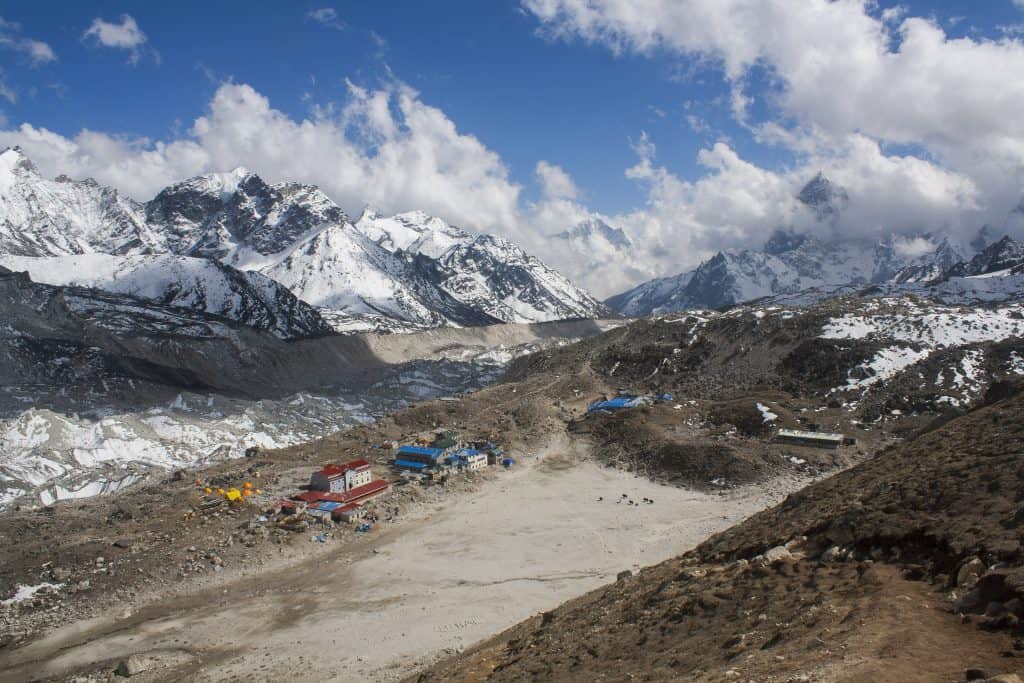
Maximum altitude: 5,364 meters
Duration: 8 hours
This is a significant day of the trek that started from Lukla.
We start our day early, walking through uneven rocky trails towards Everest Base Camp.
The views are stunning with mountains and glaciers surrounding you in all directions.
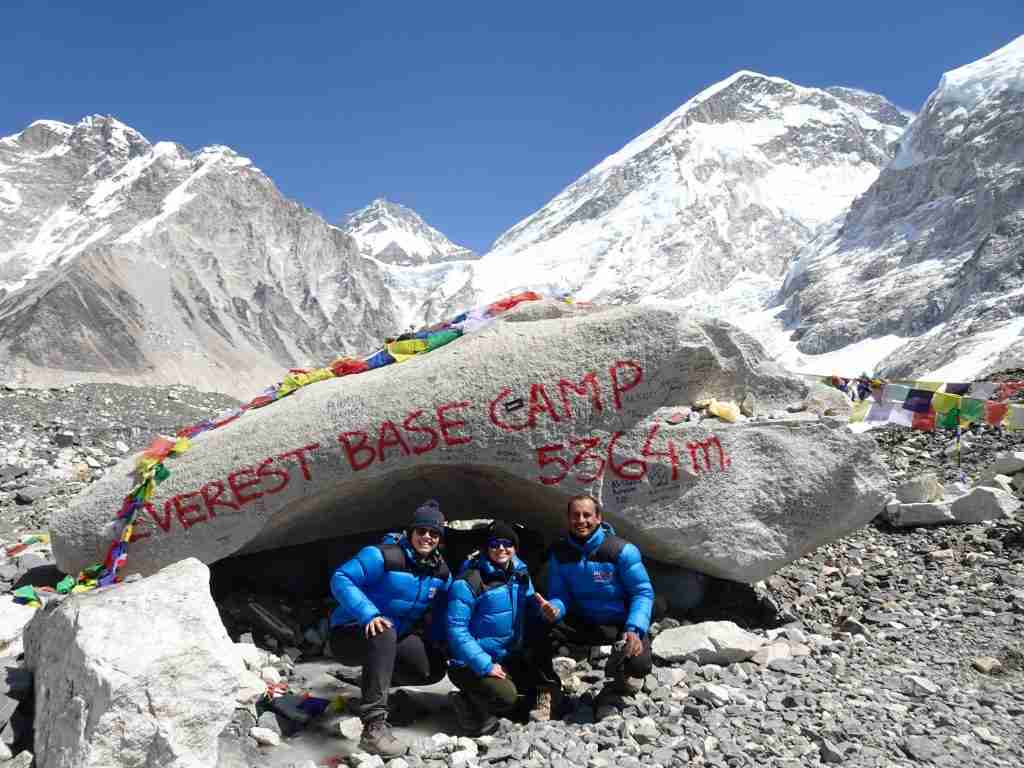
Standing at the Everest Base Camp gives you a sense of accomplishment and satisfaction.
After spending sufficient time at Base Camp for photos, you trek back to Gorakshep for an overnight stay.
Overnight in Gorkashep.
Maximum altitude: 5,545 meters
Duration: 7 hours
Today, you hike up to the most famous viewpoint of Kala Patthar.
Starting your hike at dawn will help you witness the spectacular and unforgettable sunrise view from Kala Patthar.
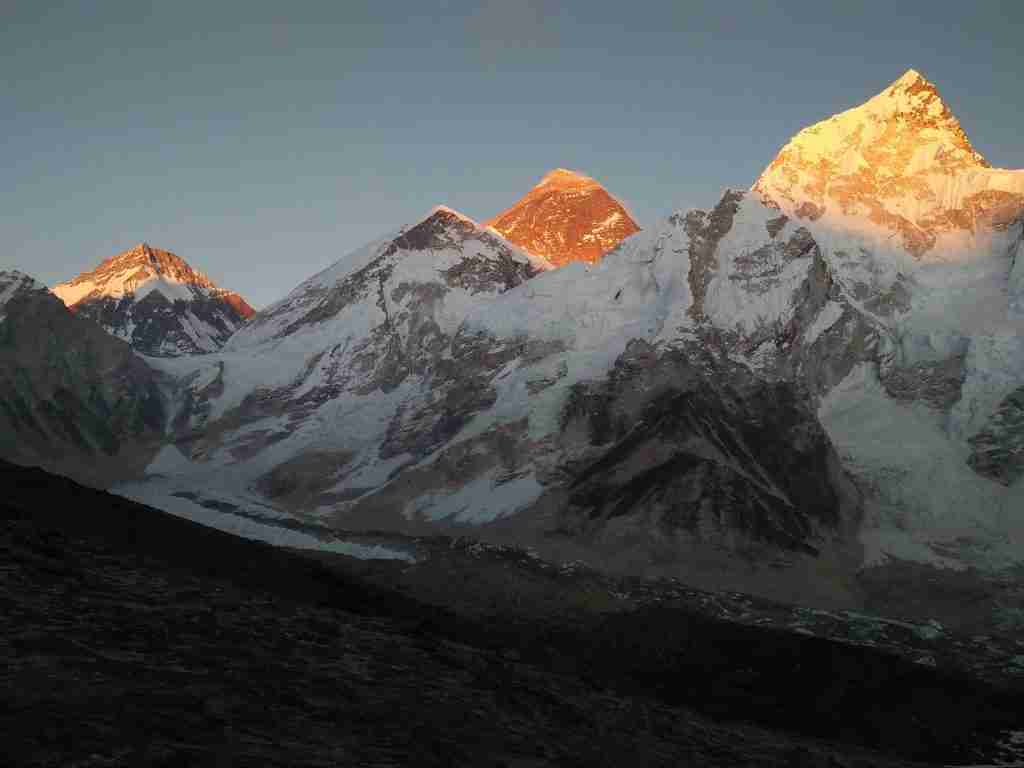
This is the best viewpoint to watch Everest and the surrounding Himalayas.
When the sun hits the glorious snow-capped mountains, the result is simply stunning.
From here, you will trek back to Pheriche for an overnight stay.
Overnight in Pheriche.
The return trek to Namche Bazaar on this day is a steep descent through stone steps, rocky trails and grasslands.
The walk is easy for those who don’t like climbing up.
On reaching Namche Bazaar, you can celebrate the success of your trek.
There are plenty of bars and restaurants for that. You can also explore the local market and get some souvenirs for friends and family.
On the final day of descent, you will enjoy the beautiful view of rivers and snow-covered mountains in the backdrop.
The trail passes through river banks and dense forests. Bird watching is quite popular in Sagarmatha National Park .
The feeling of completing the trek will make your walk easy and pleasant. Overnight in Lukla.
Overnight in Lukla.
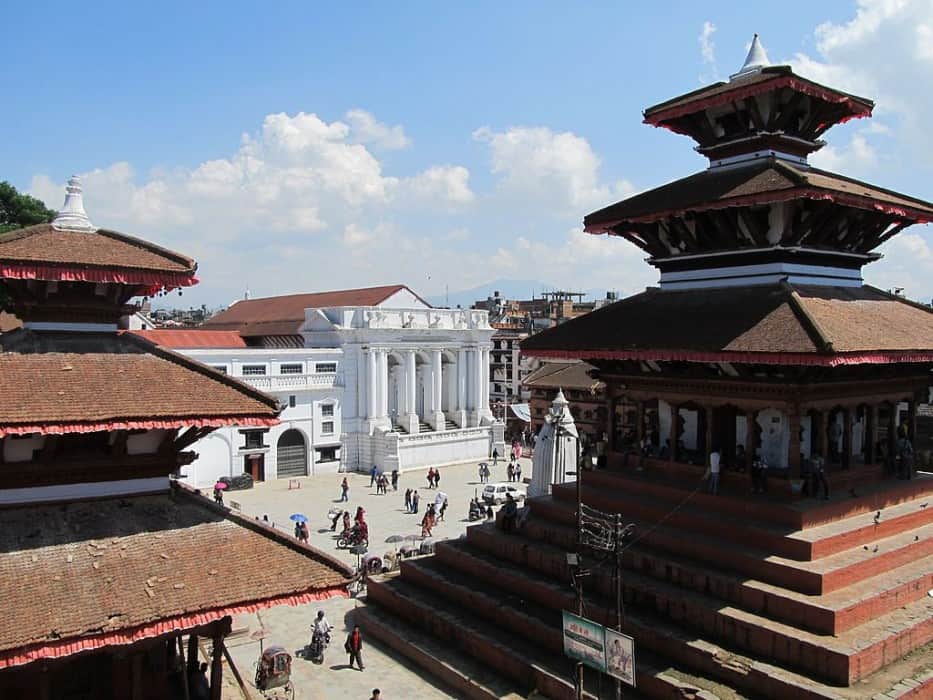
This is the day when you take another exciting flight over the Himalayas.
The 30-minute flight will take you to the capital city of Kathmandu.
Flights might get delayed due to weather conditions, so keeping a flexible schedule is advised.
Our standard 14-day package of the Everest Base Camp Trek includes the above 12 days of the trek.
For those with limited time, you can book this 11-day Everest Base Camp Trek with Helicopter Return .
Below map shows the most visited places on the journey from Lukla to Everest Base Camp.
These are the main places we reach during the 12-day itinerary mentioned above.
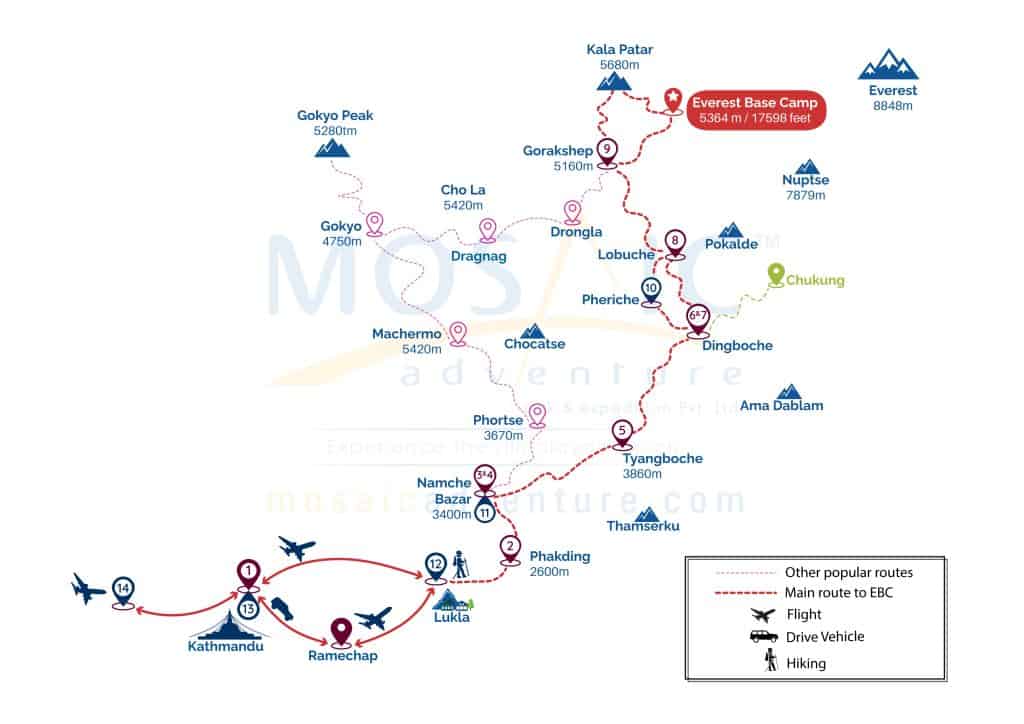
Lukla to Everest Base Camp Cost
When you plan a trek from Lukla to EBC, you must know it will prove an exciting and expensive adventure. The costs of this adventure generally include permits, guide fees, accommodation, and meals along the trekking route.
Moreover, the overall cost mainly depends on various factors like the season of travel and the chosen trekking agency. It is important to budget for a safe and memorable journey, but there are lots of packages and options available that can handle your different financial considerations.
Before covering the camp cost, you must know the total distance and all the resources you can use for camping. Here are some basic information you must know before deciding your budget.
The trek from Lukla to EBC covers approximately 65 kilometres (40 miles) and is an important factor for trekkers planning their Himalayan adventure. This trek offers an immersive experience of the rugged beauty of the Khumbu region, showcasing stunning landscapes, local culture, and high-altitude challenges.
Trekking lovers often take around 12 days to cover this distance, allowing for acclimatization and an unforgettable journey to the foothills of the world’s highest mountain, Mount Everest.
Reaching Everest Base Camp by car may seem like a good option for some adventurers, but the challenging terrain and lack of proper roads in the region make it an unfeasible option.
Traditionally, trekkers fly into Lukla and start their journey on foot, and immers themselves in the unique mountain environment. The captivating beauty and cultural richness along the trekking route make this traditional approach the preferred choice for reaching Everest Base Camp.
Although trekking may take longer, it is undoubtedly the most rewarding way to experience the Khumbu region.
If you want to reach Everest Base Camp quicker and more luxuriously then it is no more difficult as the helicopter service is available from Lukla.
The cost of a helicopter ride varies depending on factors such as the type of helicopter, weather conditions, and demand.
Although this option is more expensive than traditional trekking, it offers a time-efficient and breathtaking aerial view of the Himalayas. The convenience and scenic splendor of this option make it an attractive alternative for those who have a higher budget. You can contact us for more information.
The journey from Lukla to Everest Base Camp is known for its significant change in elevation. The trek begins at Lukla, which is situated at an altitude of approximately 2,800 meters (9,200 feet).
As trekkers start to climb, they face varying elevations and acclimatization challenges. The base camp of Mount Everest is located at a remarkable altitude of 5,364 meters (17,598 feet).
For viewing the world’s highest peaks, the whole trek demands physical preparation and a deep appreciation for the natural wonders of the Himalayas .
Hands down, spring and autumn are the two best seasons to trek in Nepal, and the same goes for the Everest Base Camp trek.
During autumn, the weather is warm, making it easy to trek in such conditions.
Visibility is at its best, making the mountains seem spectacular.
Additionally, autumn is the time for festivals in Nepal, making it the best time for trekking to Everest Base Camp .
Spring is generally much warmer than autumn, and the all-round greenery and blooming flowers make it a delightful time to trek.
There’s a freshness in the air unlike any other time.
Those who hate the cold should plan their trek in the spring season, especially between early May to mid-June.
Winter and monsoon are not among the ideal times to trek, but for avid trekkers, this might be the right time as trails are less crowded.
Thus, the best time depends on the purpose of the trek, time availability and your interests.
Accommodation on Lukla to Everest Base Camp Trek
Accommodation during the Everest Base Camp trek ranges from basic to “luxury” hotels.
In places like Namche Bazaar or below, you can find luxury lodge options like the Yeti Mountain Home.
However, as you go higher from Namche Bazar, the facilities for accommodation become quite basic, and your only option is basic teahouses.
Teahouses are basic lodges built along the trail to provide shelter and accommodation to trekkers.
They are better than tents but nothing fancy. So, keep your expectations low in terms of trek accommodation.
These teahouses offer food services with rooms on a twin or dorm-sharing basis.
The teahouse owner arranges all your requirements for food and shelter.
On these teahouse treks, you do not need to carry food and camping gear.
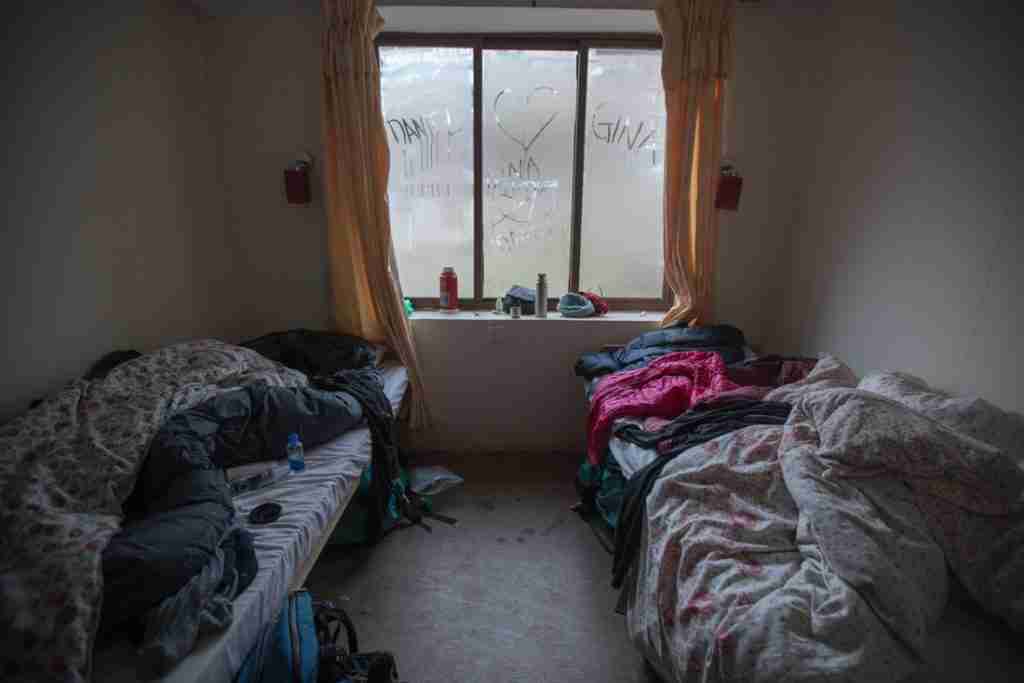
Packing Guideline
- Warm hat (for morning and evening)
- Polarized UV sunglasses
- Bandana or scarf
- Waterproof and windproof gloves
- Waterproof and windproof jacket
- Synthetic insulated jacket
- Down jacket
- Windstopper jacket
- Rain jacket
- Thermal inner wear
- Moisture-wicking tops
- Convertible hiking pants
- Hiking shorts
- Warm hiking undergarments

- Hiking shoes(waterproof recommended)
- Hiking socks
- Hiking sandals
- Antibacterial hand-wash
- Tissue or toilet paper
- Sunscreen and other creams
- Moisturizer
- Toothbrush and toothpaste
- Shampoo and conditioners
- Feminine hygiene products
- Quick-drying towel
- Water bottle
- Trekking Poles
- Headlamps and extra batteries
- Sleeping bag
- First aid kit
- Waist bag for small items
- Extra plastic bags (to keep extra things like dirty laundry and waste)
- Everest Base Camp Trek Map and information on route and mountains
- Binoculars (optional)
- DSLR Camera and extra batteries
- Pillowcase (For better hygienic stay)
- Your documents
Acclimatization is crucial for your journey from Lukla to Everest Base Camp.
It makes trekking more enjoyable and safer.
Unfortunately, many trekkers underestimate the risk of altitude sickness and end up having a bad experience.
Even though time is limited in our busy world, it’s essential not to compromise on safety.
Taking it slow and following the acclimatization guidelines is the key to a successful trip.
Acclimatization means allowing your body to adjust to higher altitudes and lower oxygen levels.
We hike to higher areas during the day and return to sleep at lower altitudes to help our lungs adapt to the thin air of the Everest region.
During the 12-day journey with Mosaic Adventure, we’ve included 2 acclimatization days—one in Namche Bazaar and one in Dingboche.
On these days, our guide will take you to higher elevations and then bring you back to sleep at lower elevations where you spent the previous night.
Apart from the acclimatization days, it’s crucial not to push yourself every day.
Give your body enough time to rest, walk at a slow pace and drink plenty of water to stay hydrated.
A hydrated body will better adjust to the lower oxygen levels.
Make sure to take frequent breaks while climbing from Lukla to EBC.
By walking slowly, using acclimatization days and staying hydrated, you can make this journey a trip of a lifetime.
Join Mosaic Adventure on a thrilling and unforgettable journey from Lukla to Everest Base Camp.
Our team of professional and trained experienced guides and porters ensures a safe and enjoyable trek, while small group sizes and affordable prices make it accessible to all.
Discover the highlighted points mentioned above, including the best time to visit, accommodation options, essential packing tips and other useful information for your adventure.
Most importantly, learn about the importance of acclimatization to ensure a successful and safe trek.
Book with us now for a hassle-free and memorable trekking experience of a lifetime.
Want more information? Send us your query, and our experts will get back to you within 24 hrs.
- Full Name *
- Address Select Country Afghanistan Albania Algeria American Samoa Andorra Angola Anguilla Antarctica Antigua and Barbuda Argentina Armenia Aruba Australia Austria Azerbaijan Bahamas Bahrain Bangladesh Barbados Belarus Belgium Belize Benin Bermuda Bhutan Bolivia Bonaire, Sint Eustatius and Saba Bosnia and Herzegovina Botswana Bouvet Island Brazil British Indian Ocean Territory Brunei Darussalam Bulgaria Burkina Faso Burundi Cabo Verde Cambodia Cameroon Canada Cayman Islands Central African Republic Chad Chile China Christmas Island Cocos Islands Colombia Comoros Congo Congo, Democratic Republic of the Cook Islands Costa Rica Croatia Cuba Curaçao Cyprus Czechia Côte d'Ivoire Denmark Djibouti Dominica Dominican Republic Ecuador Egypt El Salvador Equatorial Guinea Eritrea Estonia Eswatini Ethiopia Falkland Islands Faroe Islands Fiji Finland France French Guiana French Polynesia French Southern Territories Gabon Gambia Georgia Germany Ghana Gibraltar Greece Greenland Grenada Guadeloupe Guam Guatemala Guernsey Guinea Guinea-Bissau Guyana Haiti Heard Island and McDonald Islands Holy See Honduras Hong Kong Hungary Iceland India Indonesia Iran Iraq Ireland Isle of Man Israel Italy Jamaica Japan Jersey Jordan Kazakhstan Kenya Kiribati Korea, Democratic People's Republic of Korea, Republic of Kuwait Kyrgyzstan Lao People's Democratic Republic Latvia Lebanon Lesotho Liberia Libya Liechtenstein Lithuania Luxembourg Macao Madagascar Malawi Malaysia Maldives Mali Malta Marshall Islands Martinique Mauritania Mauritius Mayotte Mexico Micronesia Moldova Monaco Mongolia Montenegro Montserrat Morocco Mozambique Myanmar Namibia Nauru Nepal Netherlands New Caledonia New Zealand Nicaragua Niger Nigeria Niue Norfolk Island North Macedonia Northern Mariana Islands Norway Oman Pakistan Palau Palestine, State of Panama Papua New Guinea Paraguay Peru Philippines Pitcairn Poland Portugal Puerto Rico Qatar Romania Russian Federation Rwanda Réunion Saint Barthélemy Saint Helena, Ascension and Tristan da Cunha Saint Kitts and Nevis Saint Lucia Saint Martin Saint Pierre and Miquelon Saint Vincent and the Grenadines Samoa San Marino Sao Tome and Principe Saudi Arabia Senegal Serbia Seychelles Sierra Leone Singapore Sint Maarten Slovakia Slovenia Solomon Islands Somalia South Africa South Georgia and the South Sandwich Islands South Sudan Spain Sri Lanka Sudan Suriname Svalbard and Jan Mayen Sweden Switzerland Syria Arab Republic Taiwan Tajikistan Tanzania, the United Republic of Thailand Timor-Leste Togo Tokelau Tonga Trinidad and Tobago Tunisia Turkmenistan Turks and Caicos Islands Tuvalu Türkiye US Minor Outlying Islands Uganda Ukraine United Arab Emirates United Kingdom United States Uruguay Uzbekistan Vanuatu Venezuela Viet Nam Virgin Islands, British Virgin Islands, U.S. Wallis and Futuna Western Sahara Yemen Zambia Zimbabwe Åland Islands Country
- Trip Title *
- Number of Days
- Group Size *
- Travel Date Day Month Year
- Contact Number *
- Your Email *
- Describe Your Trip *
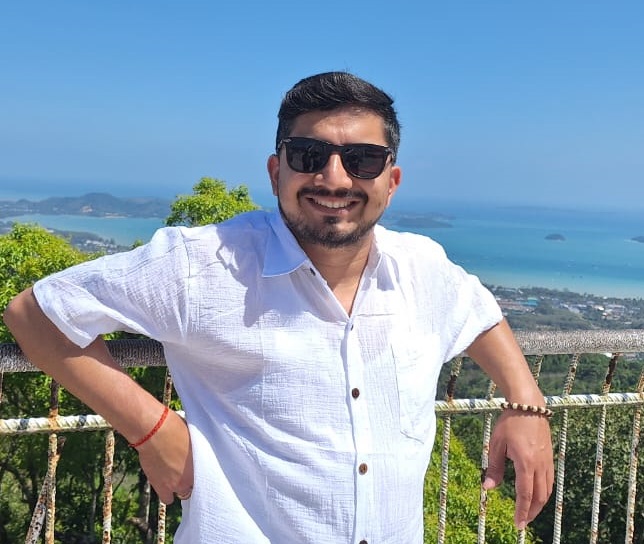
Madhav started working as a porter in 2001 and then moved on to work as a trekking guide. After working in the trekking and tourism industry for eight years, he co-founded Mosaic Adventure in 2009.
Madhav has trekked to most of the trekking destinations in Nepal, including Everest Base Camp Trek, Annapurna Base Camp, Annapurna Circuit Trek, Poon Hill Trek, Jomsom Muktinath Trek, Indigenous Peoples Trek, Langtang Valley Trek, Mardi Himal Trek, and all of the day hikes around Kathmandu. Along with that, he has also trekked to Mount Kilimanjaro.
He has also extensively traveled to other countries such as Australia, the USA, the UK, France, Hong Kong, Japan, China, the Philippines, the UAE, Saudi Arabia, Bahrain, Thailand, Turkey, Tanzania, and India. Madhav is the one who answers most of your questions about trekking and tours and helps to plan your trip by giving a personal touch.
You may also be interested in...

Everest Base Camp for Beginners – From Dream to Reality
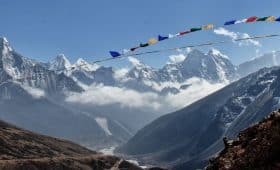
10 Days Everest Base Camp Trek Itinerary
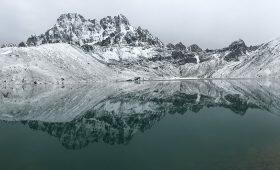
7 Days Everest Base Camp Trek
(1) comments.
Nice info with amazing images ! Thanks for sharing the useful information.
Leave a Reply Cancel reply
Your email address will not be published. Required fields are marked *
Save my name, email, and website in this browser for the next time I comment.
+977 9841319155
Lukla to Everest Base Camp – A Complete Guide
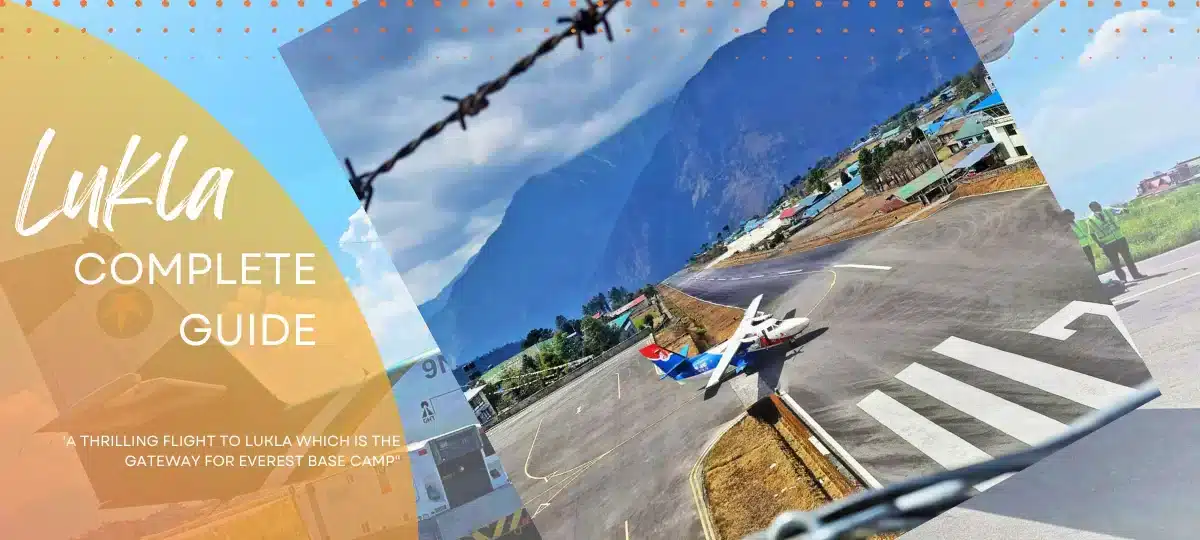
It wouldn’t be wrong to say that the Everest Base Camp is a special treat to all the hikers and adventure seekers gifted by mother nature. It is an iconic destination located in the Khumbu region of Nepal. Considered to be the highest base camp in the world at 5,364m above sea level, the Everest Base Camp trek is a full-packed adventure tour.
The Everest trek takes you through a series of diverse geography from the lush green forests of oaks, pines, and juniper in lower elevations to the rocky and desert terrains in the higher altitudes. Throughout the whole trekking trail you will be accompanied by the stunning Himalayas. The pleasure you get in doing the EBC trek is absolutely immeasurable.
The journey to the EBC starts with the short 30 mins flight from Kathmandu to Lukla to Everest Base Camp.
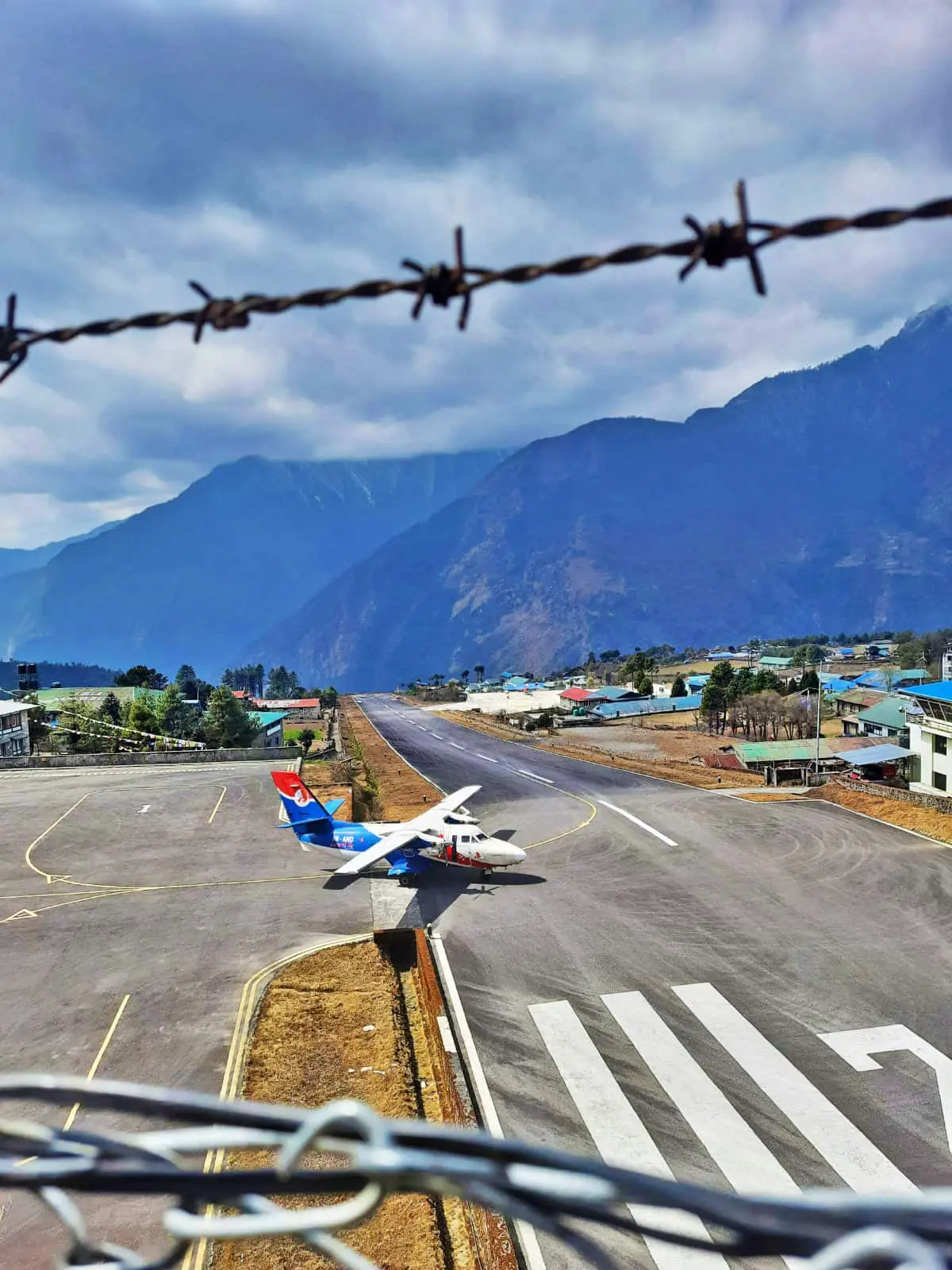
How to start your trek from Lukla to Everest Base Camp?
Starting your trek from Lukla to Everest Base Camp is a popular route for many trekkers.
Firstly, you have to get to Lukla from Kathmandu either by taking a Lukla flight or traveling by ground transportation via Salleri. Most trekkers tend to take a Lukla flight which is by far the best way to get to Lukla.
Upon reaching the Lukla your trekking journey officially begins full of energy and expectations that lie ahead. Generally, the standard Lukla to Everest Base Camp trek requires 12 days of the walking itinerary which will be provided below.
From Lukla, on your first day, you will trek to Phakding, a major stop-place for all the trekkers. It is 3-4 hours of pleasant walking from Lukla village for the first day of the trek. Further, the trek then continues to take you through numerous Sherpa settlements onwards (Namche, Tyangboche, Pangboche, Dingboche). The heartwarming hospitality of the Sherpa and locals, stunning landscapes, flora, and fauna among many others will steal your heart over and over again.
Following the route, after approximately 10-12 days of trekking, you will reach the long-awaited destination Everest Base Camp. Such a proud and exciting moment to stand at the world’s highest base camp. Live the moment, take photos, and just enjoy.
Gorakshep will be the last stop on this lifetime trekking experience from Lukla to Everest Base Camp and back. On this entire journey, you will ascend to a max altitude of 5,545m above sea level at Kalapatthar, a huge achievement to be mentioned.
Multiple days of hiking and walking at such a higher altitude in the Nepal Himalayas will be worth the time and hard-earn money.
Also, check our “Everything To Know About Lukla Flight”
What is the trekking distance from Lukla to Everest Base Camp?
The trekking distance from Lukla to Everest Base Camp covers a total distance of approximately 130km -65km each way. However, the distance varies depending on the specific route taken and any side treks are done.
Also, the distance covered on each day varies too. The first phase of hiking to EBC requires a daily average walking hour of 5-7 hours whereas returning back adds an additional extra hour.
Make yourself comfortable during the trek by walking at a slower pace and hydrating your body. It is also essential to keep your body acclimatize properly at such higher altitudes.
How many days of the trek from Lukla to Everest Base Camp?
Basically, it takes 12 days of total duration trek from Lukla to Everest Base Camp including the two days of acclimatization in between. Here’s the standard outline itinerary.
- Day 1: Fly from Kathmandu to Lukla (2,860m) and trek to Phakding (2,610m)
- Day 2 : Trek from Phakding to Namche Bazaar (3,440m)
- Day 3 : Rest day in Namche Bazaar for acclimatization
- Day 4 : Trek from Namche Bazaar to Tengboche (3,860m)
- Day 5: Trek from Tengboche to Dingboche (4,410m)
- Day 6 : Rest day in Dingboche for acclimatization
- Day 7: Trek from Dingboche to Lobuche (4,910m)
- Day 8 : Trek from Lobuche to Gorak Shep (5,140m) and visit Everest Base Camp (5,364m) and back to Gorakshep
- Day 9: Hike to Kala Patthar (5,545m) for sunrise views of Mount Everest, then descend to Pheriche (4,240m)
- Day 10: Trek from Pheriche to Namche Bazaar
- Day 11: Trek from Namche Bazaar to Lukla
- Day 12: Fly from Lukla to Kathmandu
Before leaving for the trek, make sure that you have all the necessary equipment, documents, and Everest Base Camp Trek Insurance with you.
What should I expect on the Everest Base Camp trail?
Nothing more than an absolute adventure. The whole journey completes on rugged trails with varied terrains from lush forests and rivers to rocky terrain and steep inclines. Crossing the suspension bridges over the raging rivers and encountering the yaks and horses will be something very common to you.
As the trail passes through several Sherpa settlements, you will experience the unique culture and traditions of the local Sherpa people. Their warm and welcoming atmosphere makes the trek more memorable and fun.
Also, you’ll visit the oldest Tyangboche monastery, and several other rhumbas, chortens, and prayer flags along the way.
Additionally, the EBC trail offers breathtaking views of the stunning mountains including Mount Everest, Lhotse, Nuptse, and Ama Dablam among many others. You’ll also see beautiful glaciers, rivers, and valleys.
You will find teahouses at every major stop that provides trekkers with basic accommodations and meals.
Plan Your Trek!
Your email address will not be published. Required fields are marked *
Nepal Peak Adventure
Nepal Peak Adventure stands as a premier trekking and travel agency dedicated to curating exceptional and memorable journeys in the heart of the Himalayas.

Trekking & Climbing
- Everest Region
- Annapurna Region
- Langtang Region
- Manaslu Region
- Dolpo Region
- Short Treks
- Beginner's Level Climbing
- Intermediate Level Climbing
- Challening Level Climbing
- Legal Documents
- Trekking Guides
- Climbing Guides
- Celebration
Bhagwan Bahal Street, Thamel, Kathmandu- Nepal
What’s App: +977 9841319155
+(977) 9841319155

- Terms & Conditions
- Privacy Policy

Himalaya View Treks
- Trekking in Nepal
- Everest Region Trekking
Everest Base Camp Trek From Lukla
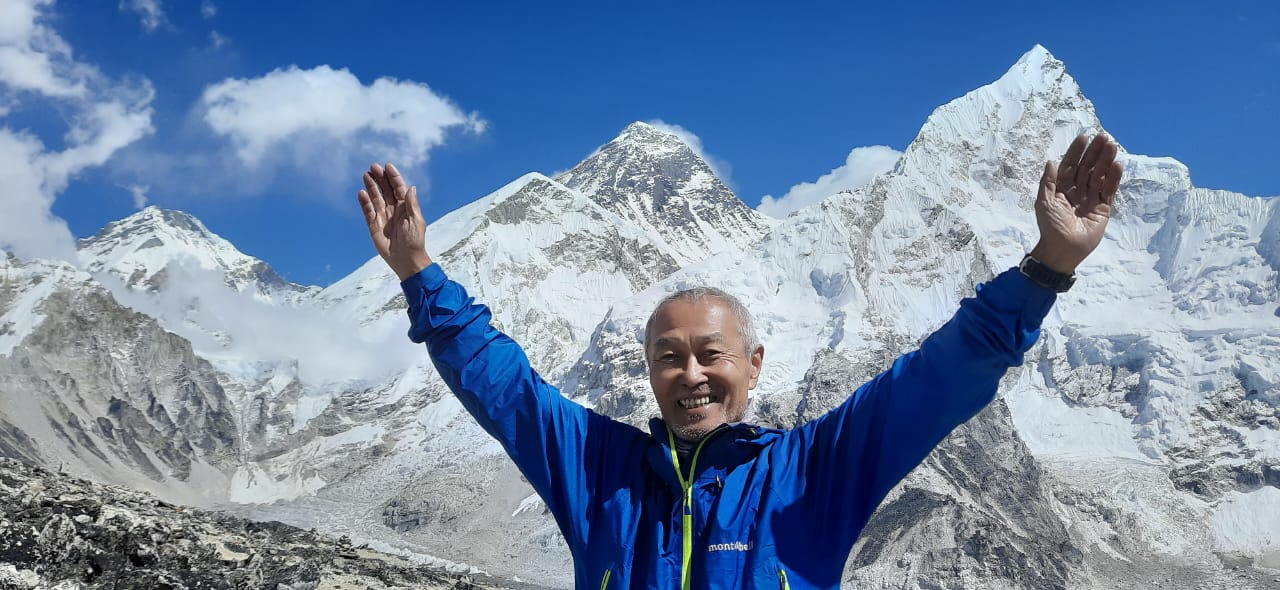
Short Itinerary
- Cost Includes/Excludes
Useful Info
Detailed itinerary.
- Tour Includes/Excludes
Trip overview
Everest base camp trek from lukla – 8 days.
Himalaya View Treks organizes an 8-day Everest Base Camp trek from Lukla. It journeys through legendary trails into pretty hamlets with cultivated fields and treks from Lukla to Everest Base Camp. On the way, we view astonishing landscapes & the king of all peaks – Mt. Everest. This is enough to get the adrenaline racing. Most importantly, we do all of it in only 08 days. Why wait? Put your boots into your rucksack & hit the road. It’s now, or never…
8 days Everest Base camp trek from Lukla is with the inborn local guides and sturdy Sherpa porters. Born into this region, they know the trails better than they know themselves. Therefore, this trip is not only a plan to match your timeframes; it also saves you money. You don’t need to pay for a guide’s flight ticket. After your thrilling flight to Lukla touches down we meet our local crew & get friendly with some handshakes. We then begin our hike along the banks of the milky Dudh Kosi River to Phakding village. And so begins our once-in-a-lifetime journey to stand in the shadows of the highest mountain on earth. The Best season to trek from Lukla to Everest base camp is April / May and October/Nov to Dec. Remember us Top of The World Mt. Everest base campfrom Lukla for 2024 / 2025.
Himalaya View Treks is the first Company to promote & support Local Sherpa guides and Porters From Lukla.
HVT is the first company to promote and support local Sherpa guides/porters for the Everest region from Lukla . Our 08-day Everest Base Camp Trek from the Lukla route takes you into the heart of Sherpa country . Moreover, you get to see awesome alpine landscapes & beyond. Similarly, we walk trails that don’t follow the beaten path, which brings us to friendly villages. Further, the trek takes us to Namche Bazaar where we get good acclimatization. In other words, it’s a steep walk up to the Everest View Hotel.
Meanwhile, by coming this far, we’re now well-acclimatized to hike in the footprints of earlier mountain legends. We’re thoroughly set to climb up to base camp as the excitement grows within us. If it’s a spring trip, we’re likely to see a whole lot of colorful expedition tents set up for a ‘King Everest’’ summit. It’s interesting!
Everest Base Camp Trek in 8 Days
Furthermore, our 8-day Lukla to Everest Base Camp trek itinerary includes the Kalapatthar at 5545m/18,192ft. The mind-blowing views of Mount Everest, Lhotse, Nuptse, and Makalu leave you awestruck. Added to this is a spectacular sunrise with maroon-pink sunrays that seep through the giant mountains. This is an unforgettable moment. Finally, we then walk back to Lukla via Pheriche to celebrate our short EBC trek. If you’re looking for something similar elsewhere, try our ‘ Langtang Valley trek for 8 days, the scenic landscapes here are gripping. The ‘Thorung La Pass trek 10 days’ would be ideal if you’re up for a long-haul vacation. This is a stunning trek in the Annapurna region. Moreover, if you’re experienced enough & want to forget trekking for a while, then try ou r ‘Island peak climb from Chhukung’’. This is a venture where you’ll walk among giants.
Lukla to Everest Base Camp Trek - 8 days Itinerary
Day 1: Fly to Lukla from Kathmandu, meet with guide and porter, and then trek to Phakding walking distance of 6.2 km (2/3 hours) 2610 M / 8,664 feet)
Day 2: Phakding to Namche walking distance is 7.4 km (5-6 Hours) 3,440m/11,283ft
Day 3: Trek From Namche Bazaar to Pangboche walking distance- of 9.1 km (5 to 6 hours) 3930m/12890ft
Day 4: Trek From Pangboche to Dukla walking distance is 7.9 km (7 hours)4,680m/15,435ft
Day 5: Trek From Dukla to Gorakshep walking distance is 6 km (6-8 hours) (Gorekshep) 5180m/16,994ft & Everest Base Camp 5364m/17598
Day 6: Gorakshep to Pheriche walking distance 9.8km (5-6 hours)5,545m/18,192ft (Kalapathar) & 4,320m/14,173ft (Pheriche
Day 7: Trek From Pheriche to Namche Walking Distance 14.2 km (5-6 hours) 3440m/11285ft
Day 8: Trek Namche to Lukla Walking Distance 13.5 km (5-6 hours) 2,800 m 9,100 ft
Day 9: Fly back to Kathmandu, Altitude of Kathmandu (1300m) (35 minutes). We woke up early for our flight back to Kathmandu.
Detailed Itinerary
Day 01: fly to lukla and trek to phakding.
We get ready early in the morning for our flight to Lukla (2,860 meters). We are going to set our foot on the marvelous Everest region. A short and beautiful flight lands us at Lukla Hillary airstrip where incredible mountain views welcome us to the charming mountain region. As soon as we come out of the airport, we get ready to begin the trekking journey. We are trekking to Phakding (2,610 meters) today on a gentle and easy trail that takes us past chhortens, mani walls, prayer flags, etc. to let us know that the region has a big influence of Buddhism. We reach Phakding on the bank of Dudh Koshi River stay overnight at our teahouse lodge. Refresh and dinner- Lukla to Phakding trek distance 6.2 km (3-4 Hours) 2,860 meter/9184ft
Day 02: Trek to Namche bazar from Phagding
We are going to enter Sagarmatha national park on our trek to Namche Bazar today. As we hit the trail from Phakding, we follow the river and cross in some different places over suspension bridges. Once we check at the national park checkpoint at Monjo, we continue walking towards the destination. Although the trail today gives us the pretty tough challenge of traversing uphill trail, we go on a gentle pace to ease the challenge. Stay overnight at our teahouse. Refresh and dinner- Phakding to Namche trek distance is 7.4 km (5-6 Hours) 3,440m/11,283ft
Day 03: Trekking to Pangboche from Namche
You make your way to Pangboche via Namche bazaar. You then make a quick descent to Phunki Tenga and take an upward trail. The trail leading up is covered by a dense forest of pine, birch, and rhododendron. We explore the beautiful settlement of Monjo & Jorsalle before proceeding to Pangboche. These villages display some great Sherpa culture which we learn while interacting with the local folks. Later, we follow the trail to Pangboche, the highest permanent settlement in the Khumbu. Unlike the villagers living in the higher elevations who migrate to the lower reaches during the winter season, most inhabitants of Pangboche choose to live in their village the whole year-round. Overnight bunk out in Pangboche-Namche to Pangboche walking distance- 9.1 km. (5/6 hours trek) 3930m/12890ft
Day 04: Trek to Dukla from Pangboche
After hot and warm breakfast, trekking to Dukla today so we embark on the adventure walk of the day. The trail goes amidst the high towering mountains and passes Pheriche village. We cross a mountain river along the trail to start the uphill challenge. The trail goes pretty much uphill after Pheriche up to Dukla. Overnight at our teahouse lodge, Refresh and dinner – Pangboche to Dukla walking distance is 7.9 km (7 hours)4,680m/15,435ft
Day 05: Trek to Gorakshep & hike to Everest Base Camp
We are going to trek all the way to Everest base camp today. We wake up early in the morning; take our breakfast and quickly get ready for the adventure of the day. With the excitement of reaching the Everest base camp, we set out on the trek of the day. We reach Gorakshep (5,142 meters) and stop for lunch. Gorakshep is also our overnight place for the day so we check into our lodge. Later after lunch, we get ready to trek to the Everest base camp. A gradual ascension through the boulder-strewn path takes us to the epic base camp of the highest mountain in the world. We enjoy our moments there for a while; take pictures and exploit the most out of the time. Later, we trek back to Gorakshep overnight at our teahouse lodge. Refresh and dinner- Dukla to Gorakshep walking distance is 6 km (6-8 hours) (Gorekshep) 5180m/16,994ft & Everest Base Camp 5364m/17598
Day 06: Hike to Kalapatthar & trek back to Pheriche
We have an early morning wake up today as we have to start the hike to Kalapathar before the break of dawn to reach there for sunrise. Early morning challenge of uphill hike brings us such a rewarding view that makes our day. Breathtaking panoramic view of the Mt. Everest and other mountains in the range and sunrise over those mighty peaks make this place a wonderland where we can enjoy the magical mountain marvels. Later we trek back down to our lodge in Gorakshep to have our breakfast and start trekking to Pheriche (4,371 meters) the destination for the day. After enjoying the Everest base camp and Kalapatthar moments, we are now on our return trip down towards Lukla, overnight at our teahouse lodge. Refresh and dinner – Walking distance 9.8 km (5-6 hours)5,545m/18,192ft (Kalapathar) & 4,320m/14,173ft (Pheriche)
Day 07: trek back to Namche from Pheriche
Trek back to Namche Bazar Altitude of Namche (3440m) On our trek along and among the magnificent mountains, we are trekking down to Namche today via Khumjung village. We spend some time at the small and beautiful village, Khumjung that boasts perfect views of mountains including Khumbila peak. We visit a monastery there and head towards Namche overnight at our teahouse lodge. Refresh and dinner- Pheriche to Namche Walking Distance 14.2 km (5-6 hours) 3440m/11285ft
Day 08: Trek back to Lukla from Namche
Trek back to Lukla Altitude of Lukla (2840m) Walking distance 5/6 ) We trek all the way back to Lukla today to finish the trekking journey. We trek past Monjo and Phakding villages; encounter the Dudh Koshi River along the trail and eventually reach Lukla. As the final day of the trek, we can celebrate the beautiful adventure. We see off our trekking potters here today thanking them for all the help they provided to make our trip possible, overnight at our teahouse lodge refresh and dinner- Namche to Lukla Walking Distance 13.5 km (5-6 hours) 2,800 m 9,100 ft
Day 09 fly back to Kathmandu from Lukla
Fly to Kathmandu from Lukla in the morning Altitude of Kathmandu ( 1300m) (35 minutes). We wake up early for our flight back to Kathmandu. We say goodbye to the serene and magnificent mountains and board the flight to come back to the city civilization. The rest of the afternoon in Kathmandu will be at leisure. Walking around the streets of Kathmandu; souvenir shopping; finding a massage or relaxing at the hotel can be easy ways to spend time.
- Both ways Flight Ticket Kathmandu - Lukla - Kathmandu) tickets including airport taxes
- All meals (Breakfast, lunch, and dinner) during your Everest Base Camp Trek
- 8 nights Hotel Accommodation during Everest Base camp Trek
- Government licensed holder, fluent English Speaking, Familiar HVT guide from Lukla
- One assistant guide if Group sizes is more than 10 trekkers)
- Strong local Porters for Carry trekker’s luggage One porter every 2 trekkers
- Guide and porter wages including their meals, accommodation, and Salary
- Staff insurance including medication coverage
- Equipment for the Company staff
- Water purification drop or tablets for safe drinking water
- Sagarmatha National Park entry permit fee
- Khumbu Pashang Lhamu Rural Municipality permits fees
- Seasonal fresh fruits every day during Everest Base Camp trek
- Oximeter to measure Pulse and oxygen level
- Company T-shirt as a Souvenirs, and duffle bag if needed
- Local government, taxes, including official Service Charge
- Trip completion Certificate
Not Included
- Hotel accommodation and meals In Kathmandu
- Personal expense (shopping, snacks, boil bottle water, hot (tea, coffee) and cold drinks, hot shower, alcohol, Wi-Fi, telephone call, battery charge fee during the Everest base camp Trek)
- Personal clothing and trekking gear
- Personal travel insurance including evacuation coverage (compulsory) up to 6000m)
- Additional costs if delays flights and outside the itinerary
- All the costs and expenses which are not mentioned in includes list
- Tips for guide and porters in end of the treks
Everest Base Camp Trek From Lukla Key Highlights:
- first-rate acclimatization, which gives high success rates and fulfilling enjoyment
- Trek to both Everest Base Camp and Kalapathar. The views leave you breathless
- In addition to immense rugged mountains, witness everything from still alpine lakes and glacial plains to frothy milky rivers and valleys covered in pink blossoms, depending on the season of your trip
- A trek like this gives you the great bonding experience of a lifetime and the genuine friendship formed between members of your small group will stay with you forever.
- Your first views of the mighty Himalayan range on the included flight from Kathmandu to Lukla – the famous airport in the sky, are your welcome warm-up to a great trip.
Is this your ideal trek?
Trekking in the Everest region is all about attitude. By its very nature adventure travel involves that you be prepared for the unexpected. In far-flung and developing countries do not expect the standards you are used to at home. Remote areas are sometimes unpredictable and itineraries may be altered. To enjoy your trip and get the most out of your adventure it is important that you are flexible, positive, and eager to take on all the challenges that arise from your Everest base camp odyssey. If you’re a greenhorn in the wilderness world then this trek would be ideal for you.
To truly enjoy this trip, you should be pretty habituated to walking 4-6 hours each day for several days on the go while some days will be relatively longer. We encourage you to walk at a pace that suits you without any rush whatsoever. This is a key aspect of enjoying such trips in the planet’s most popular region. You ought to be physically fit and an active walker to get the best of this classic mountainous journey to the south side of the mighty Everest.
General information important to this trip:
Difficulty levels
TREKKING AT HIGH ALTITUDES (over 3500m)
This trip includes strenuous trekking at altitudes of over 3500m. For us, altitude is a very serious issue, a result that has kept our records clean making us one of the best adventure operators in Nepal for over 30 years of operating treks in the region. Our trekking guests must be in great health and have high fitness levels to attempt this trip, as well as be committed to training to ensure you are suitably physically prepared for the tough challenges that go above 4500m.
Altitude sickness is a risk for anyone, including on the Annapurna, Langtang, and Everest Base Camp treks. Please make sure you familiarise yourself with signs and symptoms before you depart and monitor your own health during your trek, without letting it worry you.
We advise all our guests to undergo a thorough medical with their personal physician before they embark on this trip.
Participating in a group trip
When you travel with a group you will find much camaraderie and all the fun and also there’s bound to be some of the frustrations of traveling in a group. Your group mates will probably come from all corners of the world and you will come across a range of age groups too. We ask you to be understanding of the various needs and preferences of your group - patience with your fellow travelers is sometimes required for the benefit of everyone's travel experience. Remember too that you have responsibilities to the group. If you are requested to be at a place at a certain time, ensure you’re on time without keeping the rest of the group waiting. Experience has taught us often that the very best trips we operate are those where the chemistry within the group works well - this simply requires a ‘give a little take a little’ attitude effort on your part. For privacy reasons, we are unable to provide you with contact details and any personal information about your fellow travelers booked on your trip prior to departure.
TRAVELLERS who prefer going SOLO:
Our group trips are generally planned for shared accommodation and don't involve single supplements. Single travelers share with people of the same gender in accommodations ranging from twin to multi-share. Some of our itineraries have accommodation booked on a mixed-gender share basis [for couples or trekkers known to each other prior to the trip]. On a selection of our trips, you have the option to pay a single supplement to ensure that you have your own accommodation (where available). Please note that this only applies to accommodation during the trek - pre-trip and post-trip accommodation will be booked on a single-room basis at your hotel in Kathmandu. We also have arrangements for guests who wish to trek completely solo out of the group.
Travel Insurance
when booking with Himalaya View Treks , it’s a condition upon joining any of our trips that all clients must be insured for comprehensive expenses that might incur due to medical issues or accidents (this includes air ambulance, helicopter rescue, and treatment costs). Please note that we don't arrange or sell insurance because such a system is not allowed in our country.
Our Cost versus the Experience
At Himalaya View Treks , we always go the mile to ensure our trekking guests get the best experiences of the trip with maximum comfort and safety on a ratio that goes beyond the cost that we charge for the trip. We provide a ‘no frills’ price with breakdowns to make sure our clients are getting the best for a cost that goes beyond all expectations
Tipping [an expectation on such risky arduous trips]
Tipping is very much part of the culture in Nepal and although entirely at your discretion, it is usually expected. Often people would like to tip in recognition of good service but are unsure how much would be appropriate in a foreign country - for this reason, we have listed guideline amounts below (these are intended as a guideline only and you may see fit to give more or less depending on the service that you have received).
For the tipping of your trek staff and your tour leader, we suggest passing an envelope for each staff member around the group so that everyone can put in what they feel comfortable with anonymously.
The following are guideline amounts received by each staff member from the group as a whole...
- Tour Leader: Rs30,000 - 35,000 (usually tipped on the last night in Kathmandu)
- Your trekking crew (tips are usually given on the last evening of the trek in Lukla):
- Head Trekking Guide and Assistant Guides: Rs20,000 - 25,000 for each guide
- Trek Porters/yak men: Rs10, 000 for each porter or yak man
Acute Mountain Sickness [AMS]
When we ascend above 2500 meters our bodies have to acclimatize to the decreasing amount of oxygen available. So, to allow our bodies to adjust we have designed our treks in ways that help you ascend slowly, allowing acclimatization to occur when you go above the tree lines where the air is thinner. However, during the acclimatization process, you may experience some of the following symptoms.
- Disturbed sleep patterns
- Loss of appetite/nausea
- Shortness of breath
- Palpitation
- Swelling of the hands and face
But if you feel such symptoms don’t let it worry because it’s normal. Individuals acclimatize at different rates. Some may experience symptoms, some may not. Your best strategy is to take your time and drink plenty of water. These symptoms may not indicate the onset of A.M.S. and if you experience them it does not necessarily mean that you should not continue. All our group leaders have extensive first-aid training and we urge you to communicate with the group leader at all times should you believe you have any symptoms in order that we can effectively monitor your symptoms as you go higher. The only cure for Acute Mountain Sickness is to descend. Please note, that your group leader has ultimate responsibility and may ask you to descend if symptoms persist. As a last resort, if matters grow from bad to worse, we always have a helicopter on standby for immediate evacuation.
A Typical Day on the Everest Base Camp Trek
A typical day on the trail begins with a wake-up call at around 6 AM by your guide. Freshen up and get ready. Pack your belongings and head to the dining area for breakfast by 7 AM. Check your luggage for the final time and fill your water bottle before you hit the trail by 8 AM, along with your guide.
To avoid walking in the heat and enjoy clear mountain views, you make an early start. En route, there will be short breaks to enjoy the views and take photographs. You haul up for lunch at a local teahouse around noon or mid-day. After a quick rest of about an hour or 40 minutes, you get back on the trail and continue till you reach your overnight stop.
Upon reaching the stop for the night, you head to your teahouse, check-in, and have some rest. Tea with some light refreshments (cookies or biscuits) will be served at 5 p.m. As the rooms are not insulated, you can warm yourself with the heater or stove in the communal area.
Exchange stories or play cards with other trekkers and sherpas till dinner is served (around 7 PM). After dinner, your guide will brief you about the next day’s trek – the route you will take, the difficulties, where you will stop for lunch, etc. Afterward, retire for the night and have a well-deserved rest.
On average, you may have to walk 6 to 7 hours daily. The trek to Phakding is the shortest and the easiest, while the hike to Everest Base Camp from Dukla on the 5th day could be your toughest. On Day 6, a hike to Kalapathar for the sunrise view is scheduled. So you will have to wake up before 4 AM to reach Kalapathar before sunrise. Your guide will share the details regarding the hike during the after-dinner briefing on Day 5.
Are You Already in Nepal?
If you are already in Kathmandu or Pokhara and seeking to Hire a guide/porter or tour/trekking packages then you can directly contact an expert via WhatsApp at +9779841146306. Or visit our office:- Himalaya View Treks Kaldhara Marg, Kathmandu 44600, in front of the Kathmandu Sport Climbing Center 1st-floor building.
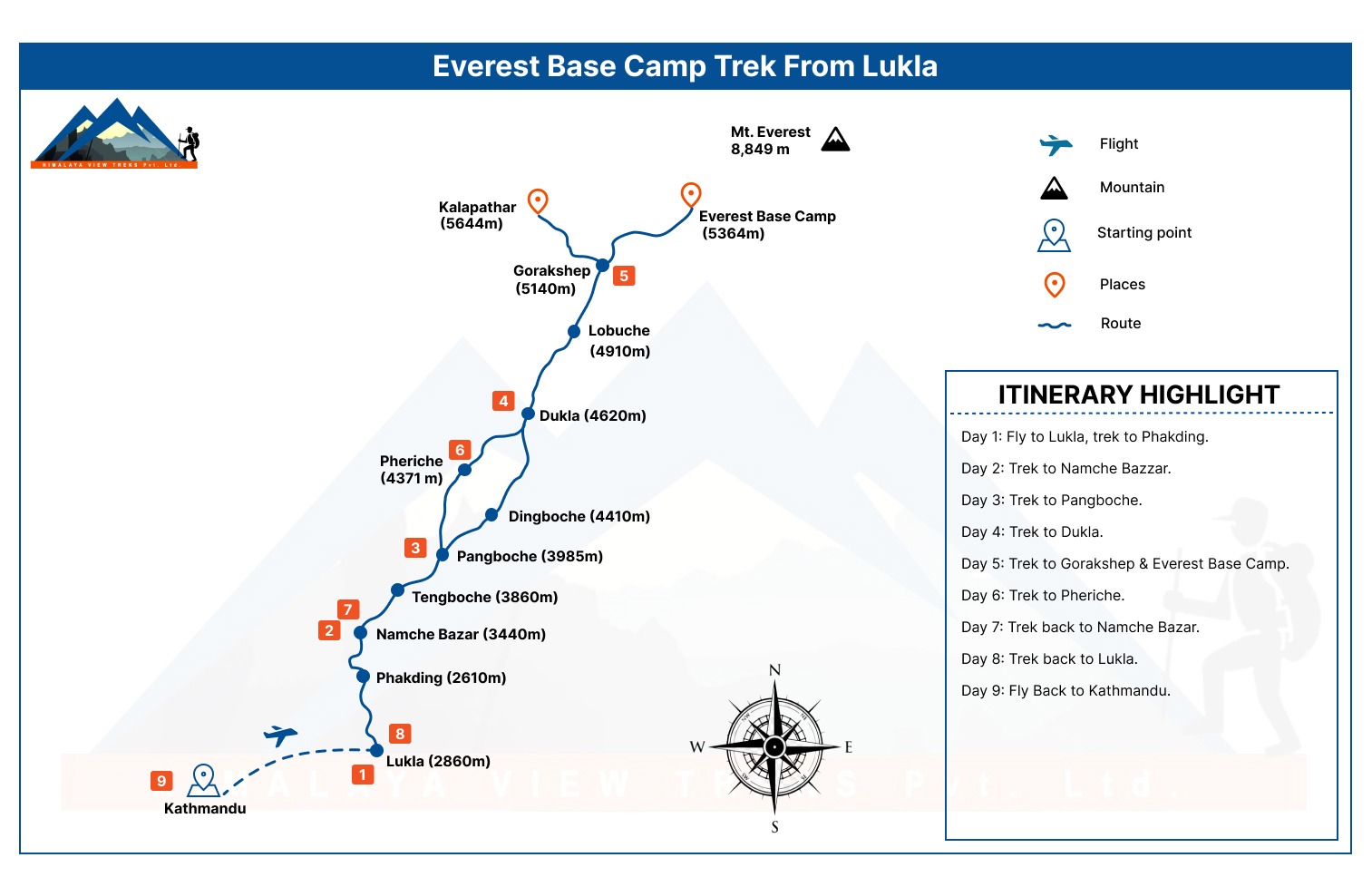
The weather forecast says rain/clouds/snow in Lukla on our Flight Day. Are we in for a rough flight?
When you are up on the mountains in Nepal, we would suggest you be ready for anything. You’re about to trek on some of the most rugged territory on earth, despite its extraordinary beauty. Weather forecasts for Lukla are never correct and different sources will give you different information. If it is a really bad day in terms of weather, the airlines will themselves cancel the flight and you might have to wait till the weather clears. Yes, flying in high altitude is never easy, even on a clear sunny day; the plane might face turbulence because of the wind blowing from the mountains. But overall the flight to Lukla is very exciting and it’s an experience that you will never forget.
What temperatures can you expect at the EBC during spring and autumn?
These are the best months to do this trek, as the weather is mild and the temperatures range from 12 to 15 degrees. The skies generally remain clear and the days are pleasant and warm. You can expect an occasional spring shower and hazy weather during spring. The mountain views are stunning in September, as there is more snow on the mountains. Nights can be freezing as the temperature dips after sun down.
How much do you reckon I will need to spend on the trail per day?
If you have booked a package with us you won’t be spending much as accommodation and 3 meals are already included in your trip price. You may have to personally pay for items like beverages and drinks, extra snacks, hot showers, electronic device charging, wifi etc. USD 20 to 30 (NRS 2000-3000) per day will be more than enough you may need to spend in a day.
What do you recommend for water along the Everest trek?
You can either buy bottled mineral water or fill up a reusable water bottle with boiled or sterilized water. During the trek, the teahouses or lodges serve you bottled and filtered water which is generally safe and has to be paid for. A liter of water would cost anything between 1 to 4 USD. As you go higher the cost of all commodities, including water, increases. But do note there is no dearth or scarcity of drinking water at teahouses. We encourage our guest to use iodine and other purifying agents to treat the water before drinking. You need to drink at least 3-4 liters of water each day to stay hydrated at higher altitudes. Keeping your body hydrated helps you to keep away the symptoms of altitude sickness. Please note, the company doesn’t provide drinking water or any extra drinks or beverages other than the ones that are specified in the trip cost.
How much tips should I give to the guide, porter and driver?
While tipping is not mandatory it is a nice way of showing your appreciation to the people who have helped you enrich your holiday experience. It all depends on how far you are pleased and satisfied with their services. There is no fixed amount, but many of our clients offer 8-10 percent of the total tour price as tips.
Is it hard to climb Everest Base Camp?
You need to be in good shape and have an ability to walk 6–7 hours uphill and downhill per day. This trek is suitable for passionate trekkers. Positive attitude, excellent health, and strong determination are required for be successful on a trip of this kind. Past hiking experience would be an asset but no technical skill is required for this trip. Besides, it is advisable to trek with a highly reputed trek operator who knows what it’s like in this part of the world, with experienced guides who can help you with significant mental preparation to keep you going all the way, as tough as it gets. Regarding the difficulty, the only challenging factor is the altitude. Our Everest Base Camp trek itinerary provides ample time for acclimatization. Neither ropes nor ice picks are needed for this trip and no vertical climbs are involved. Greenhorns in good physical shape, who exercise regularly, has positive attitude and has healthy heart and lungs can easily complete this adventurous trip.
How long do we stay at Everest Base Camp? Can we spend the night at the Base Camp?
As Everest Base Camp is situated at a high altitude of 5,364 metres, you spend only 1 to 2 hours at the camp. Since the base camp lies at the foot of the world’s tallest mountain Mount Everest, the hike to EBC is probably the highlight of your trek. Though one cannot view the summit of Mount Everest from the base camp (as the mountain is too huge) you can get close up views of the massive walls of Everest, Khumbutse, Lingtren and Nuptse. The Khumbu Icefall appears spectacular. Though the icefall lies close to the Base Camp, it is not possible to explore it as you need proper climbing gear to walk on it. But you get to explore the actual base camp of the Everest expedition groups. During climbing season, it is like a mini city of tents and you get to meet mountaineers (sometimes celebrities too!) from different countries attempting to summit Mount Everest. After taking pictures and soaking in the magnificent views you descend down to Gorak Shep again. Please do note the visibility of mountains depends on the weather. If it’s foggy you may not get good views of the mountains. No, we do not spend the night at Everest Base Camp as there are no teahouses or lodges there. Moreover it is advisable and more comfortable to spend the night at a lower elevation. After enjoying the views we trek down to Gorak Shep and stay overnight at a local teahouse.
Can you see the summit of Mount Everest from Everest Base Camp?
No, the summit of Mount Everest is not visible from Everest Base Camp. Rising above 8000 metres, the mountain is just too gigantic to be viewed in its entirety from its base. The summit of Everest can be viewed from Kalapathar and from places en route to EBC. If you want to view Mount Everest without having to trek to Everest region, you can do it by driving to Nagarkot, taking an Everest Mountain Flight and an Everest Base Camp Helicopter Tour. The best views you get of Mount Everest is from Kalapathar. It leaves you breathless, virtually!
What sort of toilet facilities will be available on the Everest Trek?
In all our Everest Treks the teahouses that we use have western toilets. In luxury lodges and teahouses in the lower elevations the rooms come with attached bathrooms and hot showers. At higher elevations the facilities may be a bit basic and you may have to share the bathroom with other travellers. Please do note that in case of extreme cold, the water in the toilet basin may freeze and you may have to use an Asian (also known as ‘squat’) style of toilet that is located outside. Please do carry toilet paper rolls with you at all times. It is important that you carry enough rolls of toilet paper and hand sanitizers while trekking. Can I make payment with my credit card or with my cash while Everest trekking? You need to have local currency to purchase items on the trail. While Lukla and Namche in the Everest Region may have lodges that would accept payment with cards, we strongly advise to carry enough local cash with you to buy essential items en route. You can exchange your currency at any of the money exchange centres in Kathmandu or use your credit or debit card at the local ATMs to get local currency.
Where can I store my extra luggage while trekking?
You can store it at your hotel (most hotels in Kathmandu have storage facilities) or you can leave it at our office.
Is there WIFI available on the Everest Base Camp trail?
Yes, wifi hotspots are available on the Everest Base Camp trail. But please do keep in mind, due to the mountainous terrain the network maybe erratic sometimes. Often times the signal gets lost or the strength is poor.
Quick Enquiry
Trips reviews.

Leave a Review Cancel reply
Your email address will not be published. Required fields are marked *
Save my name, email, and website in this browser for the next time I comment.
Customer's Reviews On

We are associated with

© Copyright 2024 Trekking To Everest - All Right Reserved.

Alpha Adventure Treks
Your Perfect Trekking Partner

Lukla To Everest Base Camp Trek

Last Updated on May 3, 2022 by Alpha Adventure Treks
Everest Base Camp Trek from Lukla is one of the world’s most popular mountain treks. Thousands of trekkers visit the Khumbu region in Nepal every year, and visitors come from all over the world to see the world’s highest summit, Mt Everest (8848m), and its adjacent peaks. The region’s natural splendor inspires some incredible pictures, and the views along the trip, as well as at the EBC, are breathtaking. Beautiful, century-old monasteries may be visited, and the walk provides an opportunity to learn about the Sherpa people’s unique culture. A trek from Lukla to Everest Base Camp is a once-in-a-lifetime expedition for individuals whose ambitions soar as high as the clouds that surround the beautiful peak. You can soak your spirit with the natural beauty of the region and stretch your endurance beyond what you believed was possible when you’re miles away from cars, home comforts, and the regular everyday amenities.
Table of Contents
Walking Distance from Lukla to Everest Base Camp:
The distance between Lukla and EBC is 38.58 miles (62.08 kilometers), which takes 7 to 8 days to hike and 3 to 4 days to descend. The overall distance traveled round way from Lukla to Everest base camp is 130 kilometers, although the trek takes 11 to 12 days. You hike 10 to 11 kilometers each day, which is a pleasant amount to walk between Lukla and Everest base camp. There are many aspects about the Lukla to Everest base camp trek that no one tells you about. The Lukla to EBC trip is a thrilling adventure that takes you to one of the Khumbu Valley’s most fascinating trekking sites.
Everest Base Camp Trek from Lukla: Highlights:
- Flying from Kathmandu to Lukla begins this incredible adventure to Everest Base Camp with a thrilling alpine flight above the huge Himalayan range.
- Discover Sherpas’ historically rich culture and immerse yourself in the indigenous way of life.
- Art, architecture, and history abound in centuries-old monasteries.
- The Everest Base Camp journey offers the greatest views in the world, with magnificent peaks visible at all times. The landscape is enhanced by green valleys with lush trees.
- From the peak of Kala Patthar, you can watch the sunrise. The magnificence of the golden hour will take your breath away.
- A chance to see the world’s highest glacier, the Khumbu Glacier.
Best Time for the Everest Base Camp Trek from Lukla:
Spring and autumn are without a doubt the greatest seasons for trekking in Nepal. The same is valid for the Everest Base Camp trek.
The weather is warm in Autumn. It is simple to trek in such situations. The visibility is excellent. As a result, the mountains appear beautiful. Autumn is also a festival season in Nepal. Simply put, the best time to trek to Everest Base Camp is in the autumn. In general, spring is substantially warmer than autumn. Spring is a wonderful time of year because of the abundance of greenery and blooming flowers. There’s a fineness in the air that you won’t find at any other time. Those who dislike the cold should go on a hike in the spring, especially between early May and mid-June.
Everest Base Camp Trek from Lukla: Accommodation:
During the Everest Base Camp trek, hotels range from basic to “luxury.” Luxury lodge options such as Yeti Mountain Home can be found in Namche Bazaar or below. However, as you ascend from Namche Bazar, the accommodations grow more primitive, and your only alternative is to stay in relatively basic teahouses.
Everest Base Camp Trek from Lukla: Brief Itinerary:
Day 1: Take a short flight to Lukla, followed by a trek to Phakding
Day 2: Trek to Namche Bazaar
Day 3: Acclimatization and side trips in Namche
Day 4: Trek to Tyangboche
Day 5: Trek to Dingboche
Day 6: Hike to Nagartsang and back to Dingboche.
Day 7: Trek to Lobuche
Day 8: Arrive at Everest Base Camp and return trek to Gorakshep
Day 9: Hike to Kala Patthar and Pheriche
Day 10: Trek to Namche Bazaar
Day 11: Trek to Lukla
Everest Base Camp Trek from Lukla: Required Permits and Documents:
A couple of permits are required for the trek. It does not, however, require a Trekker’s Information Management System (TIMS) permission, as do other trekking trails.
- Sagarmatha National Park Permit: the permit can be obtained from the Nepal Tourism Board office (Kathmandu) as well as from Monjo (Khumbu)at the entry of the park. It cost NPR 3,000 ($30).
- Khumbu Pasang Lhamu Municipality Entrance Permit: It can be only obtained from Lukla or Monjo. It cost NPR 2,000 ($20) per foreign traveler. It is a substitute for a TIMS card.
Note that following the classic trail from Jiri to Everest base camp necessitates obtaining a separate permit from the Gaurishankar Conservation Area. It’s available at the Nepal Tourism Board office in Kathmandu.
Everest Base Camp Trek from Lukla: FAQ’s:
Everest’s safety concerns are based on a number of factors. Everest Base Camp Trek is, nonetheless, extremely safe in comparison to Everest Climbing. However, because of the high altitude, it still offers some concerns, as stated above.
Basic hiking equipment, such as walking poles, hiking boots (preferably shoes), lightweight t-shirts, hiking pants, a down jacket, sleeping bags, and so on, is usually required.
An interpretative local guide will help you make the most of your stay in the mountains. They’re well-versed in mountain conditions, weather, avalanches, and other potential dangers. They will be enthusiastic about sharing their knowledge of your surroundings in order to keep you safe on the mountain.
You must have travel insurance for Everest Base Camp Trek to protect your investment; it should cover helicopter evacuation and medical repatriation. Despite being a moderate trip, it reaches a height of 5545 meters above sea level. Some trekkers may get high altitude sickness, which can be life-threatening in such circumstances. Trekkers may require helicopter assistance. As a result, having travel insurance can save you money.
The cost of an EBC trek is determined by the trip type, hiking trails, and the trekker’s own actions. However, the most affordable Everest Base Camp Trek costs between $1400 and $1600. This amount can cover all of your food, lodging, guides and porters, permits, and Lukla domestic flights.
Everest Base Camp has harsh weather and temperatures. The temperature in the daylight varies from 20 degrees Celsius in the summer to -5 degrees Celsius in the winter. However, it can go down to -20 degrees in the winter and 4 degrees in the summer at night.
The trek to Everest Base Camp takes between 11 and 14 days’ round trip on average. The majority of people will complete it in 12 days: 8 days hiking from Lukla to Everest Base Camp, followed by 4 days trekking back to Lukla.
The one-way trek from Lukla (9,200 feet) to Mount Everest Base Camp (17,500 feet) is around 38.5 miles (62 kilometers).
Yes, we can see the view of Everest and other surrounding peaks from Lukla.
Feel Free To Contact Us.
Share this:.
- Click to share on Twitter (Opens in new window)
- Click to share on Facebook (Opens in new window)
- Click to share on WhatsApp (Opens in new window)
Related Post
Author: Alpha Adventure Treks
You might want to explore the highest and coolest Himalayas of Nepal, explore Nepali cultures, and visit many beautiful places of Nepal. We are here to make your travel dream come true. There are so many thing you can do in Nepal. You can enroll in trekking, mountaineering, hiking, rafting, and jungle safari. We create best itinerary for our customers according to their travel plans. Our agents are very cooperative and they will contact you beforehand so that you can tell what to include in your travel itinerary. We have highly experienced and very professional team in our Company. They make sure about your safety and other travel things. With us, it will be easy for you to travel to your favorite destination. View all posts by Alpha Adventure Treks
Nepal Guide Treks & Expedition – Hiking & Peak Climbing Agency
- +977-98510-29613
- [email protected]
Everest Base Camp Trek Distance
This classic Himalayan trekking adventure has a total distance of around 65 km from Lukla to the base camp or 130 km round trip. The outstanding trek can comfortably be completed with basic fitness, and therefore, even amateur trekkers can complete it. This long Everest Base Camp Trek Distance will be covered through diverse terrain and other beautiful landmarks of the area.
While the trek takes around 7-12 days to complete, you can add days set for acclimatization. Additionally, acclimatization also provides you with the best adventure in the Everest region . Moreover, trekkers will need to cover 10-15 km daily to finish the trek in time.
The trekking speed ideal for trekkers is around 3-4 km per hour to complete the journey in time. The trails of this EBC trek are famous for being quite steep and rocky. The beautiful terrain will ensure you have a great adventure in the Himalayan foothills.
While the trek requires basic fitness, it is ideal for all travelers. You will have a great time in the region, even if you are a beginner. Since, you will be gaining 600m-700m in altitude, acute mountain sickness can be a major concern for all trekkers.
The following article will provide you with complete detail about the Everest Base Camp Trek Distance. Go through the article before planning your trip!
Country* --- Afghanistan Åland Islands Albania Algeria American Samoa Andorra Angola Anguilla Antarctica Antigua and Barbuda Argentina Armenia Aruba Australia Austria Azerbaijan Bahamas Bahrain Bangladesh Barbados Belarus Belgium Belau Belize Benin Bermuda Bhutan Bolivia Bonaire, Saint Eustatius and Saba Bosnia and Herzegovina Botswana Bouvet Island Brazil British Indian Ocean Territory Brunei Bulgaria Burkina Faso Burundi Cambodia Cameroon Canada Cape Verde Cayman Islands Central African Republic Chad Chile China Christmas Island Cocos (Keeling) Islands Colombia Comoros Congo (Brazzaville) Congo (Kinshasa) Cook Islands Costa Rica Croatia Cuba Curaçao Cyprus Czech Republic Denmark Djibouti Dominica Dominican Republic Ecuador Egypt El Salvador Equatorial Guinea Eritrea Estonia Ethiopia Falkland Islands Faroe Islands Fiji Finland France French Guiana French Polynesia French Southern Territories Gabon Gambia Georgia Germany Ghana Gibraltar Greece Greenland Grenada Guadeloupe Guam Guatemala Guernsey Guinea Guinea-Bissau Guyana Haiti Heard Island and McDonald Islands Honduras Hong Kong Hungary Iceland India Indonesia Iran Iraq Ireland Isle of Man Israel Italy Ivory Coast Jamaica Japan Jersey Jordan Kazakhstan Kenya Kiribati Kuwait Kyrgyzstan Laos Latvia Lebanon Lesotho Liberia Libya Liechtenstein Lithuania Luxembourg Macao S.A.R., China Macedonia Madagascar Malawi Malaysia Maldives Mali Malta Marshall Islands Martinique Mauritania Mauritius Mayotte Mexico Micronesia Moldova Monaco Mongolia Montenegro Montserrat Morocco Mozambique Myanmar Namibia Nauru Nepal Netherlands New Caledonia New Zealand Nicaragua Niger Nigeria Niue Norfolk Island Northern Mariana Islands North Korea Norway Oman Pakistan Palestinian Territory Panama Papua New Guinea Paraguay Peru Philippines Pitcairn Poland Portugal Puerto Rico Qatar Reunion Romania Russia Rwanda Saint Barthélemy Saint Helena Saint Kitts and Nevis Saint Lucia Saint Martin (French part) Saint Martin (Dutch part) Saint Pierre and Miquelon Saint Vincent and the Grenadines San Marino São Tomé and Príncipe Saudi Arabia Senegal Serbia Seychelles Sierra Leone Singapore Slovakia Slovenia Solomon Islands Somalia South Africa South Georgia/Sandwich Islands South Korea South Sudan Spain Sri Lanka Sudan Suriname Svalbard and Jan Mayen Swaziland Sweden Switzerland Syria Taiwan Tajikistan Tanzania Thailand Timor-Leste Togo Tokelau Tonga Trinidad and Tobago Tunisia Turkey Turkmenistan Turks and Caicos Islands Tuvalu Uganda Ukraine United Arab Emirates United Kingdom (UK) United States (US) United States (US) Minor Outlying Islands Uruguay Uzbekistan Vanuatu Vatican Venezuela Vietnam Virgin Islands (British) Virgin Islands (US) Wallis and Futuna Western Sahara Samoa Yemen Zambia Zimbabwe
Number of Travellers*
Phone Number
Approximate Date
Package 3 Days Everest View Trek Using Helicopter 7 Days Langtang Valley Short Trek Ama Dablam Expedition Annapurna Base Camp Trek Annapurna Base Camp Trek with Helicopter Annapurna Base Camp Trek with Mardi Himal Annapurna Circuit Trek Annapurna Panorama Short Trek Annapurna Sanctuary Trek Bardia National Park Baruntse Expedition Bhutan Cultural Tour Bird Watching Tour in Nepal CHULU EAST PEAK CLIMBING Chulu Far East Peak Climbing Chulu West Peak Climbing Climbing Island Peak Dhampus Peak Climbing Dhaulagiri Circuit Trek Dhaulagiri High Pass Trek Dhorpatan Jumla Trek Dolpo Helicopter Tour Everest Base Camp Helicopter Tour Everest Base Camp Helicopter Tour (Flyover) Everest Base Camp Short Trek Everest Base Camp Trek - 14 Days Everest Photography Tour Everest Three Passes Trek Everest View Trek Gokyo Cho La Pass with Everest Base Camp Trek Gokyo Lake Trek Gokyo Renjo La Pass Trek Gokyo to Everest Base Camp with Island Peak Gosainkunda Lake Trek Himlung Himal Expedition Honeymoon Tour Nepal India Bhutan and Nepal Tour India, Bhutan, Nepal, Tibet Tour Island Peak Climbing with EBC Kanchenjunga Circuit Trek Kathmandu Valley Sightseeing Khopra Ridge/Danda Trek Koshi Tappu Wildlife Reserve Langtang Ganja La Pass Trek Langtang Gosainkunda Trek Langtang Helambu Trekking Langtang Valley Trek Larkya Peak Climbing Lhasa EBC Kathmandu Biking Tour Lobuche Peak Climbing Lower Dolpo Trek Lower Manaslu EcoTrek Lower Mustang Trek Makalu High Pass Trek Makalu Trek with Sherpani Col Manaslu Circuit and Tsum Valley Trek Manaslu Circuit Trek Manaslu Expedition Manaslu Larke Pass Trek Manaslu Short Trek Mardi Himal And Khopra Danda Trek Mardi Himal Peak Climbing Mardi Himal Trek Mera and Island Two Peak Climb Mera Island & Lobuche: Three Peak Climb Mera Peak Climbing Mera Peak Hinku Valley Trek Mera Peak via Arun Valley Mount Kailash Tour via Lhasa Mt Annapurna Expedition Mt Everest Expedition Mustang Helicopter Tour Nar Phu Valley Tilicho Lake Trek Nar Phu Valley Trek Naya Kanga Peak Climbing Nepal Bhutan Tour Nepal Holiday Tour Nepal Pilgrimage Tour Nepal Tibet Bhutan Tour Nepal Tour Nirekha Peak Climbing Parchamo Peak Climbing Photography Tour In Nepal Pikey Peak Trail Pisang Peak Climbing Pumori Expedition Rara Lake Trek Rolwaling Tashi Lapcha Pass Trek Ruby Valley Trek Short Tour Nepal Short Tour to Lhasa Tibet Singu Chuli Peak Climbing Tamang Heritage Trail With Langtang valley Tharpu Chuli Peak Climbing Three Peak Climbing: Island Peak, Lobuche and Nirekha Peak Tilicho Lake Thorong la Pass Trek Tilicho Lake Trek ( Via Mesokanta La Pass ) Tsum Valley Trek Upper Dolpo Circuit Trek Upper Dolpo Trek 26 Days Itinerary Upper Mustang Mountain Biking Upper Mustang Tiji Festival Trek Upper Mustang Trek World Heritage Photography Tour in Nepal Yala Peak Climbing
Send us your enquiry*
Everest Base Camp Trek Distance Details
Kathmandu – lukla – phakding.
Flight duration: 35-40 minutes
Lukla altitude: 2845 m
Phakding altitude: 2610 m
Walk duration: 3-4 hours
Distance Covered: 10 Km
Net Elevation Gain: -230 m
The distance from the starting point of Kathmandu to Lukla is 138 km . You will cover this distance in a flight of around 45 minutes . After reaching the airport at Lukla, on a thrilling adventure, you will start trekking through the Everest region trails.
You will trek around 10 km from Lukla on this journey to reach Phakding village settlement. This section’s trekking duration will take 3-4 hours . During the course of this trek, you will find beautiful trails with many incredible landmarks.
Phakding – Namche Bazaar
Namche altitude: 3,440 m
Distance Covered: 14 Km
Net Elevation Gain: 830 m
From Phakding, you will trek around 14 km on this journey to Namche. You will trek through the beautiful terrain in this section to Namche Bazaar, a beautiful village. On the journey, you will pass through outstanding landmarks on the lap of nature. You will get to pass through the forest areas covered in numerous other landmarks like rivers and waterfalls.
In the beautiful village of Namche, you will find many hotels, cafes, lodges, etc. You will also get to go on hiking around the hills around Namche as a part of the acclimatization journey. You will get sweeping views of the region during the process of acclimatization.
There is the famous Syangboche viewpoint, known for its awe-inspiring panoramic views of the mountains. Besides, there are cultural points that you can explore in Namche as well, including the Sherpa museum . You can stay there in Namche’s beautiful village settlement after finding a teahouse.
Namche – Tengboche
Tengboche height: 3,870m
Walk duration: 5 hours
Distance Covered: 9.5 km
Net Elevation Gain: 430 m
The Namche to Tengboche is a real test of your strength as you will trek for around 9.5 kms. You will continue this section after a day at Namche which will allow you to re-energize your spirits.
The section of the trek will first take you alongside the northern trails then climb up the stony trails. You will enter a forest path before leading to the monastery area. After 5 hours of rigorous trekking, you will reach Tengboche where you will rest at a local teahouse after some exploration around the area.
Tengboche – Dingboche
Dingboche height: 4,410m
Walk duration: 5-6 hours
Distance Covered: 11 km
Net Elevation Gain: 540 m
The Tengboche to Dingboche trek route will cover around 11 km , which takes around 5-6 km. Trekkers taking this trek will find the trail to be quite different as you will reach an area that is devoid of much vegetation and mostly arid. You will love trekking in the beautiful uphill terrain where you can enjoy the natural landmarks in a chill atmosphere.
The Dingboche settlement will arrive after you trek for around 5-6 hours and cover 11 km. There you can stop your trek and rest in the Dingboche teahouse. Besides that, you can also explore the area before you settle down at the teahouse.
Dingboche – Lobuche
Lobuche height: 4,940m
Walking duration: 5 hours
Distance Covered: 11 kilometers
Net Elevation Gain: 530 m
At Dingboche, you will spend the day acclimatizing. This is the second day for acclimatization in the EBC trek as it will provide you with adequate strength to cope with the acute mountain sickness. There in the beautiful trail, you will also have the opportunity to experience the magical Himalayan vista.
It will lead you through the incredible terrains of the region from Dingboche to Lobuche. After trekking for 2-3 hours , you will reach Dughla, where you can respite and have lunch for some time while observing the majestic Himalayas of the region. There is also a memorial structured in the memory of the climbers who lost their lives while along the way to the mountains.
You will love the magical snow-clad mountains a few minutes away from the viewpoint. The trail reaches a crossroads where you will choose the road leading to the Zongla settlements, before trekking uphill for 30 minutes before reaching Lobuche.
Lobuche – Gorak Shep – Everest Base Camp – Gorak Shep
Everest Base Camp altitude: 5,363m
Walking duration: 7 hours
Distance Covered: 15 km
Net Elevation Gain: 454 m
On this route, you will walk uphill from Lobuche to Gorak Shep while passing and exploring the significant landmark of Everest Base Camp. The trails will lead you through the great paths to reach Gorak Shep, the site where Tenzing Norgay and Sir Edmund Hillary made their way to the summit of Mt Everest .
In the Everest Base Camp, you will love the atmosphere of climbers socializing and training for their respective climbs. Then you will return to Gorak Shep on the beautiful trail after exploring around and taking pictures. You will get fantastic pictures of the mountains during your stay in the base camp.
The roads will then route back to reach Gorak Shep village. The highlights of Gorakshep is that it is the highest mountain village settlement on the route to EBC. It is also the highest point where you can find tea houses where you will stay for the night before descending down.
Gorak Shep – Kala Patthar – Pheriche
Ending Elevation: 4,240 m
Kala Pathar altitude: 5,545m
Walking duration: 8 hours
Distance Covered: 13 km
Net Elevation Gain: -885 m
The journey of the route from Gorak Shep to Kala Patthar is another significant part of the EBC trek. The route is technical and challenging and starts early in the morning. You will find it quite challenging to trek uphill on the route to Kalapathar. The beautiful path will allow you to observe the outstanding Himalayan sunrise from the viewpoint of Kala Pathar.
You will lead through the rugged landscapes to arrive at the top of Kalapathar. The beautiful viewpoint is known for its stunning vista, where you can observe the glorious Himalayan sunrise. You will climb for 2 hours to Kalapathar. You will have the best time during this short but challenging hike in the region.
After exploring and observing the Himalayan sunrise, you will return to the Gorak Shep village and the tea house. Beautiful pictures get clicked mainly from Kala Patthar’s viewpoint. We will take around 45 minutes to return to Gorak Shep on a different route and descend to Pheriche.
Pheriche – Namche
Pheriche altitude: 4,280m
Namche altitude: 3440m
Walking duration: 9 hours
Distance Covered: 23 km
Net Elevation Gain: -800 m
The trail from Pheriche to Namche will lead you through the terrains to reach the region’s commercial hub. The course will guide you through the incredible landscapes providing you with the best adventure in the area. The great trail will lead you to the uphill and downhill terrain on the same route you took later.
The course will lead you through the 9 hrs trek , which makes it one of the highest and most extended journeys during the tour. You will trek past the astonishing flora and fauna that includes some of the rare species of wildlife during the trek.
There is a junction to the Khumjung village where you respite for some time before you trek further to Namche. The last climb to the village will offer some other scenic Himalayan views that you will observe delightfully before staying for the night.
Namche – Lukla
Lukla altitude: 3,440m
Lukla altitude: 2,840 m
Walking duration: 4 hours
Distance Covered: 10 kilometers
Net Elevation Gain: -600 m
This stretch from Namche to Lukla is the last day of the EBC trek. The trails of this section of the trek is the last chance you will get to observe the Himalayas and the Himalayan terrain. In Lukla where you will arrive after covering 10 km in a 4 hour journey, you will stay at a lodge.
Lukla to Kathmandu
Maximum height: 2,845m
Flight time: 35 minutes
The Lukla to Kathmandu journey takes you on a flight that takes you around 35 minutes covering 138 km . You will love the fantastic mountain views from the top before you reach Kathmandu.
You may also like:
- Everest Base Camp Trek in December
- Everest Base Camp Trek Permit
- Food on Everest Base Camp Trek
Altitude Gain on Everest Base Camp Trek
The Everest Base Camp elevation is another important factor to consider. While you will reach 5000m + elevation during the base camp trek, each trekking day you will gain around 600-1000 m in altitude. But it is just the net gain in elevation, as you will pass through uphill and downhill paths during the trek. So, the actual gain in Everest Base Camp elevation is quite high.
Hence, the total elevation gain is not the accurate picture as you will need much consideration. The trek journey starts at the altitude of 2840 m (9126 ft) which is the Lukla village settlement. You will reach the highest altitude of Everest Base Camp 5,364 m (17598 feet) during the trek. The trek also has an optional hike to Kalapathar at the altitude of 5644 m (18519 ft).
Everest Base Camp Trek Distance Related Difficulties
The Everest base camp trek is a moderately difficult trail. The total distance the trekkers have to cover on a trekking day makes the trek even more difficult. The trekkers will need to pass through fantastic rugged terrains in the gorgeous region. You will travel above the high altitude of 5000m during this base camp trek.
There are some tough difficulties that you might face in the uphill and downhill path during this EBC trek. You will need to traverse through the magical steep and narrow ridges of the area. There you can find difficulty factors like acute or altitude mountain sickness, surprising weather and fluctuating temperatures, etc.
Moreover, you can customize the trip itinerary in such a manner that the trek distance gets reduced. You can start early to reach your destination before dark. Beginner trekkers will find this trek to be high in difficulty and hence this method will be quite beneficial to them. There are facilities or added benefits of helicopter travel that will help you with Everest base camp trek distance.
Ways to Reduce the Everest Base Camp Trek Distance Difficulties
Training regime.
This Everest Base Camp Trek distance is quite a difficulty factor which can get tackled through a thorough trekking regime. You will have a trekking duration of 8-7 hours each day which is quite high. For this, the trekkers will require you to remain in the best shape which can get achieved through physical, cardiovascular, and mental activity. As a benefit, you will also be able to tackle altitude sickness.
Trek in a group
Trekking the distance of such a high length is quite difficult. The trail will lead you through the stunning region; trekking will help you with any emergency. The trek will allow you to travel in a fun atmosphere. You will also be benefited with a joyful trekking adventure in a group.
Trekking gears and equipment
The trekking gear will make the trek quite comfortable for all trekkers. These equipment are especially designed to have the best journey possible. Overall, the difficulty of the Everest Base Camp trek distance get slashed quite a huge amount with these measures.
The other fantastic benefit from these items is the risks of injuries get minimal during the trek. Trekkers have fewer cramps, blisters, and you will have a safe and comfortable trek. Besides the basic trekking clothes, boots, and trousers, you will also need to bring sleeping bags to be safe from the cold.
Get guides and porters
One ideal thing you can do before the trek is hiring guides and porters during the EBC trek. They are quite adept with the navigation even through the remotest trails. It will save you time and energy and protect you from injuries along the route. They can also provide first aid for injuries and protect you from emergencies.
Guides have incredible local knowledge and insight for a fun trekking experience. Guides will also help you with translation. Porters help carry heavy luggage and backpacks so you can trek in the Everest region without any discomfort.
The Everest Base Camp Trek is Nepal’s premium trek. Hiking distance is something you should consider before starting the tour. The walk from Lukla will lead you through beautiful terrains. It covers a distance of about 130 km (80 miles) on a round journey passing through several villages to reach Everest Base Camp.
The trek takes around 7-14 days, with steep uphill and downhill terrains and crossing high mountain passes. You will reach more than 5,500 meters (18,000 feet) in elevation. The distances can initially seem daunting, but with proper preparation, equipment, and assistance, fitness can be easily achieved.
Facts about Manaslu Circuit Trek
Manaslu trek in december, prakash devkota.
Meet with Prakash Chandra Devkota, Managing Director and Team Leader
Mr. Devkota hails from the beautiful hilly region of Gorkha District. He started his career as a guide in 1997 and quickly became a reputed figure in the Tourism Industry because of his extensive experience. He has gathered impressive experience in all Trekking and Climbing Routes, such as Mera, Island, Lobuche, Ama Dablam etc.
His success also lies in his brilliant mind and hospitable nature. He is fully dedicated to providing excellent services and introducing innovative concepts. With more than 15 years of experience in trekking and expedition operations in Nepal, Tibet, India, and Bhutan, he has earned a reputation as a renowned leader in the field. He understands the importance of personalized service for creating memorable experiences for his clients and constantly seeks innovative company operation methods.
Mr. Devkota has always been an avid practitioner of eco-friendly tourism and has always promoted environmental conservation throughout his career. He motivates his staff to embrace eco-friendly tourism through responsible tourism practices.
Post Your Views

- Everest Region Trek
- Annapurna Region Trek
- Manaslu Region Trek
- Mustang Region Trek
- Langtang Region Trek
- Makalu Region Trek
- Dolpo Region Trek
- Kanchenjunga Region Trek
- Best Selling Treks
- Nepal Trekking
- Luxury Treks in Nepal
- Challenging Treks in Nepal
- Family Treks in Nepal
- Peak Climbing
- Mountain Climbing in Nepal
- Nepal Tour Packages
- Luxury Tours in Nepal
- Helicopter Tours
- Nepal Family Tours
- Bhutan Tour
- Kailash Tour
- Pokhara Day Tour
- Kathmandu Day Tours
- Jungle Safari in Nepal
- Nepal Visa Information
- Packing List for Trekking
- Bhutan Visa
- Fitness Training
- 10 Comprehensive Nepal Trekking Tips
- Flight Cancellation
- Travel Insurance
- The Differences
- Terms & Conditions

Understanding the Everest Base Camp Trek Distance
: 2024-04-05
Last Updated : 2024-04-05
If you’ve ever dreamed of trekking to the base camp of the world’s highest mountain, Mount Everest , understanding the total Everest Base Camp Trek Distance distance you’ll need to cover is important.
The Everest Base Camp Trek is a demanding yet very rewarding trekking journey. It covers over 38 miles round trip. This trek will take you through quiet and calm villages, stunning landscapes, and up to altitudes of over 17,000 feet.
So, get ready to experience the adventure of a lifetime on this epic trek in the Himalayas.
Table of Contents
The everest base camp trek distance.
The distance from Lukla to Everest Base Camp on the Everest Base Camp trek is approximately 38 miles one way.
Daily distances covered on key stops like Namche, Tengbouche, Dingbouche, and Lobuche during the trek can vary. Typically, it ranges from 5 to 10 miles each day, depending on the itinerary and pace of the trekker.
Understanding the Everest Base Camp trek distance is also important in planning for acclimatization stops along the way. These stops help the body adjust to the increasing altitude gain.
By spacing out rest days and shorter hiking distances strategically, trekkers can reduce the risk of altitude sickness. This ensures a successful ascent to Everest Base Camp.

Planning the trekking route and itinerary considers varying elevation gains and challenging terrain. It offers trekkers stunning views of Mount Everest , monasteries, and the unique Sherpa culture along the way.
Adequate gear, accommodation bookings, and hiring local guides or porters all contribute to a safe and enjoyable Everest Base Camp trekking experience in Nepal.
Key Stops on the Trek
Namche Bazaar is an important stop on the Everest Base Camp trek. Its strategic location helps trekkers acclimatize to the altitude.
At around 11,286 feet, Namche’s elevation impacts trekkers adjusting to higher altitudes. It’s an important rest point before they continue further towards the base camp.
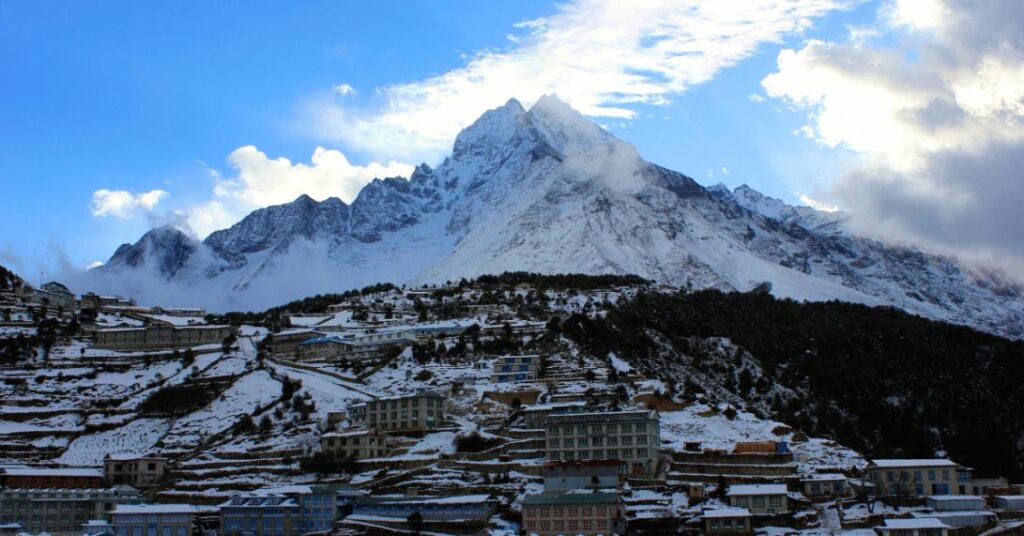
This mountain town offers various services like lodges, gear shops, and Wi-Fi cafes. It gives a taste of civilization in the rough terrain, allowing for comfortable rest and re-energizing.
Moreover, Namche provides breathtaking views of mountains, including Mount Everest. It is a moment of stooping into an inspirational environment for trekkers.
With its services catering to trekkers’ needs, Namche is a vital hub on the Everest Base Camp trek route.
Tengboche is a special place in Nepal, along the Everest Base Camp trek. It’s known for the Tengbouche Monastery, which is big and important in the region.
This monastery lets trekkers learn about Tibetan Buddhism and Sherpa culture, adding cultural value to the journey.
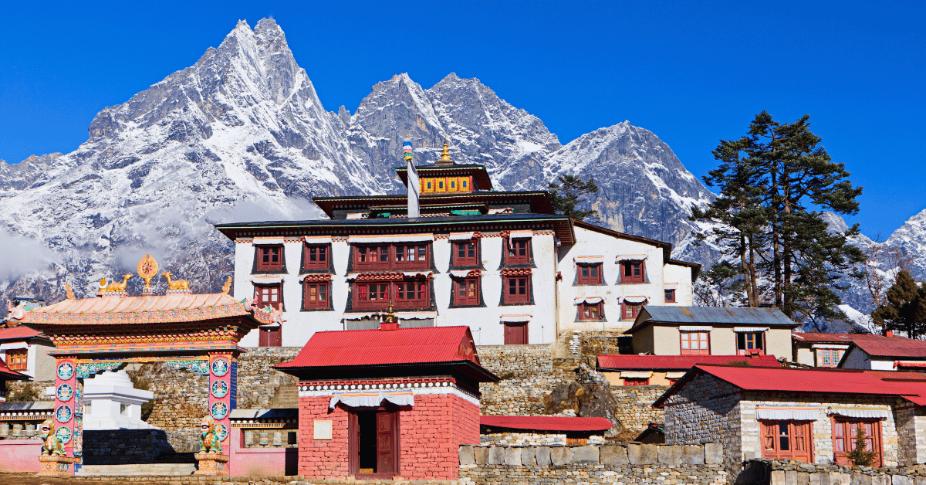
Tengbouche also gives amazing views of Mount Everest and other mountains, making the trek more exciting. Trekkers can relax there, adjust to the high altitude, and then move on to Everest Base Camp.
In Tengboche, you can find places to stay, rent gear, and hire local Sherpa guides, which are all helpful for the journey.
Dingboche is also an important stop on the Everest Base Camp trek. It is located at around 4,410 meters above sea level.
This stop helps trekkers acclimatize to the high altitude before moving forward. Taking an extra day in Dingboche allows hikers to rest and get used to the thin air. This reduces the risk of altitude sickness as they continue towards Everest Base Camp.

In addition to acclimatization, Dingboche offers beautiful views of the mountains, such as Lhotse and Ama Dablam. Trekkers can also explore the Dingboche Monastery to experience the local Sherpa culture.
Lobuche is yet another important stop on the Everest Base Camp trek. It offers stunning views of mountains like Mount Everest.
The journey from Pheriche to Lobuche is known for its higher altitude, tough terrain, and the need to acclimatize properly. Trekkers will enjoy beautiful mountain views when trekking to Lobuche, passing villages like Dingboche and Tukla.
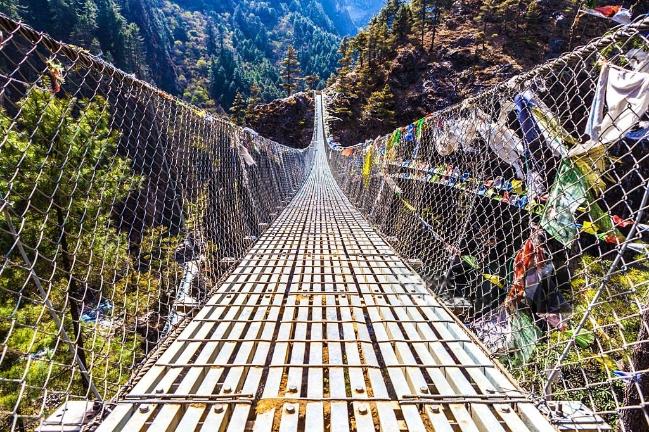
During the trek, a day of rest in Lobuche is included for acclimatization. Travelers should be prepared with the right gear and have accommodations booked in advance, as Lobuche is a popular resting place for those heading to Everest’s summit.
Daily Everest Base Camp Trek Distance Covered
Kathmandu to lukla airport.
Day 1 of the Everest Base Camp trek starts in Kathmandu. This is the starting point of the Everest Base Camp trek. Trekkers fly to Lukla Airport , which takes about 30 to 40 minutes. This flight shows them the beautiful mountain views for the first time.
Upon landing in Lukla, at an altitude of around 9,383 feet, trekkers begin their journey to the famous Everest Base Camp. The trek from Lukla to Namche Bazaar involves a moderate hike. This allows trekkers to adjust to the increasing altitude.
Along the way, trekkers pass through villages like Monjo and Tengboche. They get to experience the Sherpa culture and enjoy the scenic Himalayan surroundings.
Day 1 sets the tone for the trek ahead. It marks the start of an adventure filled with challenges, stunning views, and the thrill of reaching Everest Base Camp.
Lukla to Pheriche
Day 2 of the Everest Base Camp Trek distance covers about 12 miles from Lukla to Pheriche.
Key stops along this route include Namche Bazaar, Monjo, Tengboche, Dingboche, and Lobuche.
The elevation changes significantly, from around 9,300 feet in Lukla to nearly 14,000 feet in Pheriche .
Hence, proper acclimatization is very important to avoid altitude sickness during this ascent. Rest, hydration, and following the guidance of experienced guides are important for a safe trek.
Consider the average hiking pace at higher altitudes and accommodation options in each village to plan effectively when calculating the Everest Base Camp Trek distance.
The stunning views of Mount Everest and the surrounding mountains serve as motivation for this challenging trek.
Pheriche to Lobuche
Thereafter, during the Everest Base Camp trek, trekkers will go from Pheriche to Lobuche. Some key stops along the way are Dingboche, Duglha, and Thukla. The distance from Pheriche to Lobuche is about 7 kilometers. It usually takes 3–4 hours to hike this section, depending on the trekker’s pace and acclimatization to the altitude.
This part of the trek offers amazing mountain views, including Mount Everest. Trekkers get to see the Sherpa culture with visits to monasteries. It is very important to acclimatize carefully and follow the Sherpa guides so trekkers can make it through this challenging route and get ready for the Everest Base Camp.
Lobuche to Everest Base Camp
The trek from Lobuche to Everest Base Camp has some very important stops. One of these is Gorak Shep, where trekkers take a break before reaching the base camp.
It usually takes 4-6 hours of hiking to go from Lobuche to Everest Base Camp. The altitude increases significantly on this route, and the thin air can be challenging for trekkers as they move towards the famous mountain.
Acclimatization in Namche Bazaar , Dingboche, and other stops is essential. This helps trekkers adjust to the high elevation. Trekkers must have the right gear, like sturdy hiking boots, warm clothes, and oxygen supplies readily with them.
It is to be noted that Sherpa guides are very helpful during the journey. They assist trekkers throughout the trip. During the whole journey, during the time of emergency, guides play a very important role. It might be tempting to try heading to the EBC solo but it is our appeal to always take a guide while heading to remote himalayas of Nepal. It’s the matter of lives we are talking about and is definitely not worth not taking safety measures.
Also, the Nepal Tourism Board has implemented a ban in solo trekking to enhance safety and prevent incidents. The decision was influenced by the increasing number of missing solo trekkers and,, therefore, the need to regulate trekking activities to ensure the well-being of trekkers coming from all corners of the world and reduce the strain on rescue operations.

Time Estimates for the Trek
The Everest Base Camp trek distance covering usually takes 12–14 days.
- It covers a distance of about 130 kilometers round trip.
- Factors to consider for estimating the time include altitude gain, acclimatization, hiking route, rest days, and physical fitness level.
- Trekkers start in Kathmandu, fly to Lukla, and then head towards several locations like Namche Bazaar, Monjo, Tengboche, and more.
- Along the way, they enjoy views of Everest, visit Sherpa villages and monasteries, and stay in lodges.
- The trek is challenging due to altitude and terrain, and it requires proper gear, oxygen, and guidance from Sherpa guides.
- It’s advisable to book through a tour operator for a well-planned itinerary and porter support.
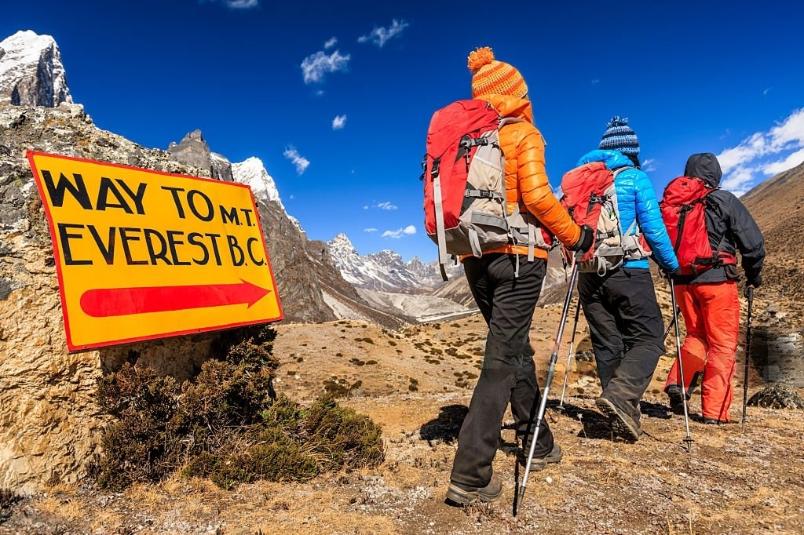
Reaching High Points on the Trek
Physically preparing for reaching high points and also covering the total Everest Base Camp Trek distance involves regular exercise. Focus on cardiovascular endurance, strength training, and stamina building.
Proper acclimatization is important for successfully reaching high points on the trek. The rapid altitude gain requires recommended stopovers in Namche Bazaar, Dingboche, and Lobuche to help with acclimatization.
Common challenges when reaching high points on the trek include altitude sickness, fatigue, and extreme weather conditions. These challenges can be managed by gradual ascent, staying hydrated, using proper gear, and listening to local guides. Overcoming these challenges ensures a safe ascent to high points like Kala Patthar , which offers stunning views of Mount Everest and the surrounding mountains.
Prioritizing acclimatization and understanding the route, elevation gain, and distance to be covered are important for a successful Everest Base Camp trek. It offers a rewarding experience amidst Nepal’s breathtaking mountain scenery.
Logistics of the Trek
Traveling to Everest Base Camp involves flying from Kathmandu to Lukla and then trekking to Namche Bazaar. Lodging and meals are available in lodges or tea houses along the way in places like Monjo, Dingboche, and Gorak Shep.
Safety on the trek is ensured by knowledgeable guides, first aid supplies, and oxygen in case of altitude sickness. Emergency communication and medical support are also accessible if needed.
The round trip covers about 130 kilometers, with an elevation gain of over 3,000 meters. Trekkers get stunning views of Mount Everest and nearby peaks, with the challenge of reaching Kala Patthar for a panoramic view of the Everest summit.
Opting for the Everest Base Camp Trek and covering the Everest Base Camp Trek distance is a real test of endurance and, yes, a chance to experience the actual raw beauty of nature. The trek covers about 38 miles from Lukla to the base camp, offering stunning views of Mount Everest and the surrounding peaks. It’s also an opportunity to understand the Sherpa culture, visit ancient monasteries, and push your limits.
Knowing the distance is important for planning rest and acclimatization stops. Trekkers should mandatorily listen to their bodies, respect the challenges of altitude and terrain, prepare well, and also without fail follow Sherpa guides’ advice.
Ultimately, the trek is not just about reaching the base camp but about enjoying the actual journey, facing challenges, and creating lasting memories in the Himalayas.
So, get ready, to cover the entire Everest Base Camp Trek distance, and breathe in the mountain air, and begin this unforgettable adventure!
The Everest Base Camp Trek is a 130 km round trip beginning from Lukla, with 65 kilometers each way.
The Everest Base Camp Trek typically takes around 12-14 days, including acclimatization days. However, the duration can vary depending on the individual’s pace, fitness level, and itinerary.
Factors that can affect the distance covered during the Everest Base Camp Trek include physical fitness level, pace of hiking, acclimatization to high altitude, weather conditions, and trail conditions such as steep terrain and snow accumulation.
Yes, there are different routes and variations of the Everest Base Camp Trek that may vary in distance. For example, the traditional route from Lukla to Everest Base Camp is about 130 km round trip, while taking alternative paths can increase or decrease the total distance.
Yes, it is very important to have a good understanding of the distance and terrain of the Everest Base Camp Trek before attempting it. Knowing the route and challenges can help you prepare physically and mentally, reducing the risk of altitude sickness and ensuring a safe and enjoyable trek.
You may also like:
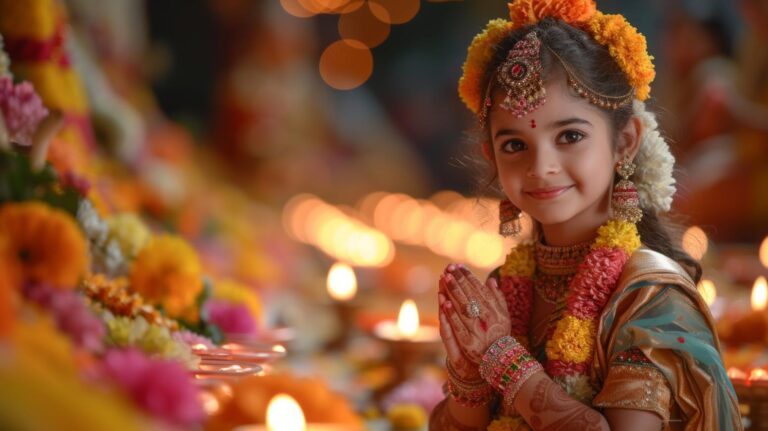
Exploring the Festivals of Nepal: A Cultural Experience
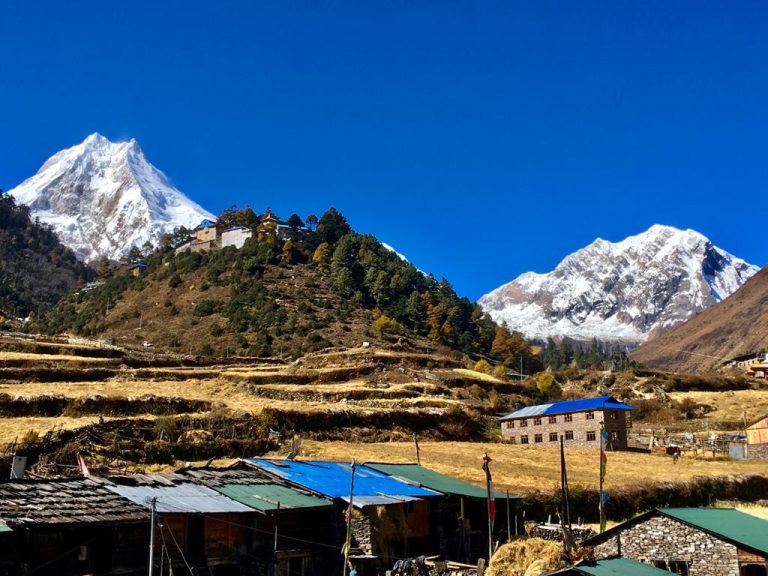
Top 5 Trekking Routes in Nepal for 2024
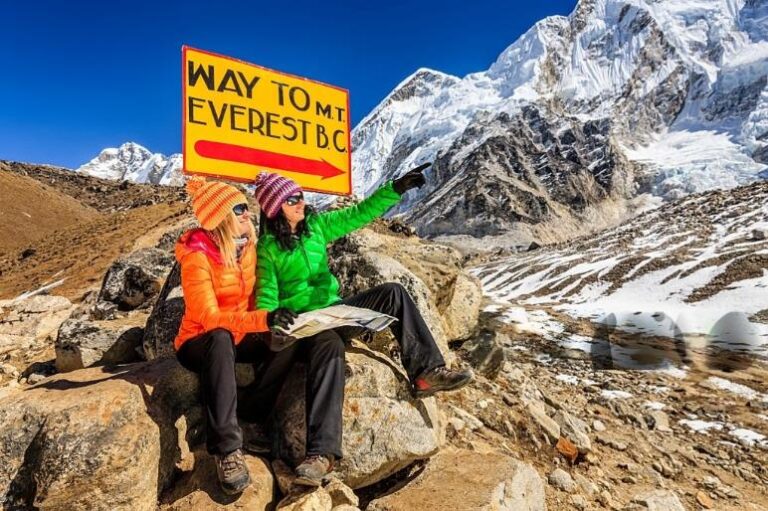
Himalaya Trekking Everest Base Camp
Send an enquiry.
© 2024 - Himalayan Trekking and Tours (P) Ltd. All Rights Reserved.

Everest Base Camp Trek: The Ultimate Guide
Jackson Groves
Posted on Last updated: August 10, 2023
Categories NEPAL , HIKING
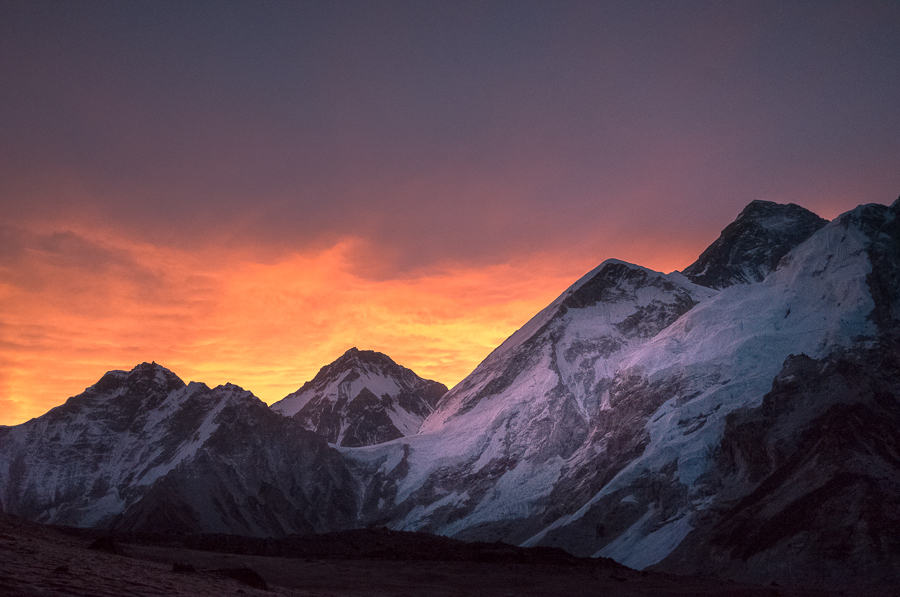
Mt. Everest is the highest mountain in the world and trekking to the base camp is no easy feat either. It’s a journey through some of the most spectacular mountain views but also through a number of beautiful villages along the way. The Everest Base Camp Trek takes anywhere from 9 to 15 days depending on your route and itinerary but also how well you acclimatize.
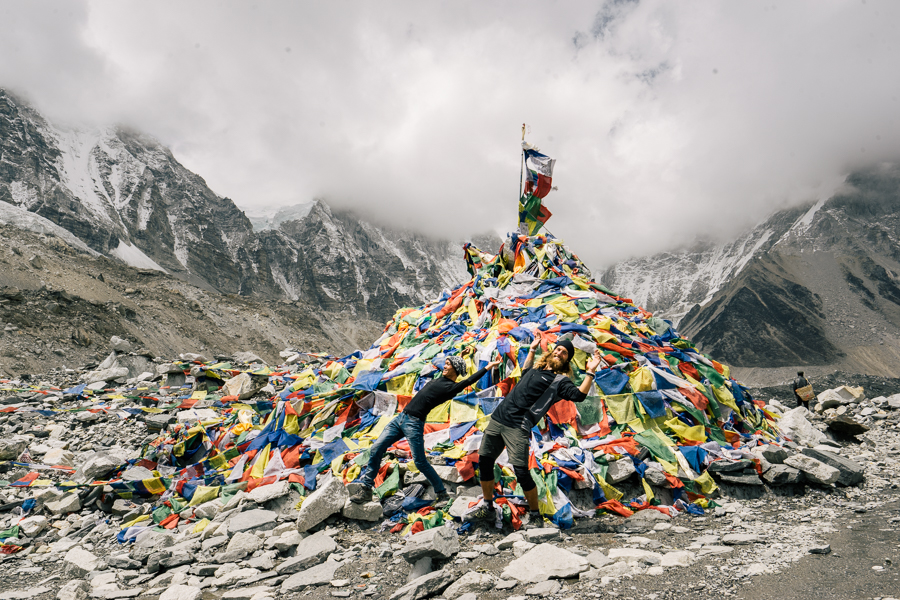
In this article, I will cover everything you need to know about the logistics of the Everest Base Camp (EBC) trek but I will also share with you my experience on each day of the trek. A short journal entry with a vlog from my experiences from each day will give you an idea of what to expect and you can see how the journey went for me. After sharing my experience, I will then include all of the information you need to know in this complete guide about trekking to Everest Base Camp.
BEST TREKKING COMPANY IN NEPAL
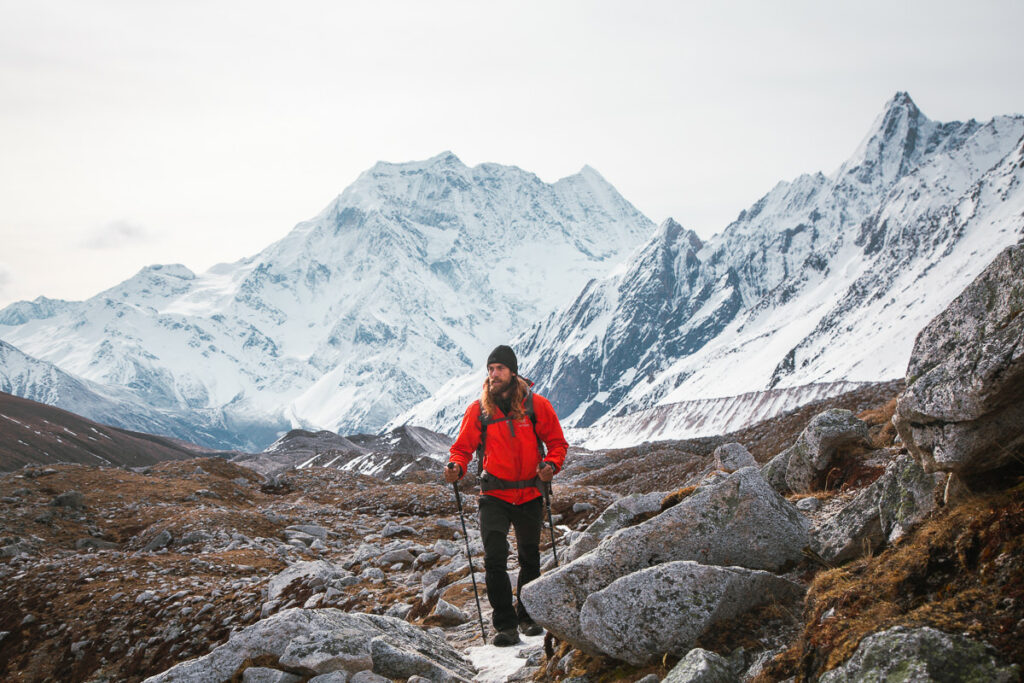
Interested in trekking in Nepal or doing the Everest Base Camp Trek? I recommend booking your trek with Himalayan Masters , which is the company I use for all of my treks in Nepal. Use my code JACKSON5 when you book to receive a 5% DISCOUNT .
Table of Contents
EVEREST BASE CAMP TREK DETAILS
- Distance : 120 km round-trip from Lukla to Base Camp and back to Lukla (You will fly to Lukla from Kathmandu)
- Days required : 12 -14 days
- Total Incline : (Undulation) – 6015 m
- Total Decline :(Undulation) – 5821 m
- The highest point on the trek : 5640 m/18 500 ft, this is actually at Kala Patthar, which you will hike to in the morning after reaching Everest Base Camp. This is where you get the best views of Mount Everest.
- Difficulty : It’s hard for an average hiker but the altitude is definitely more difficult to manage than the distance with several rest days and acclimatization days.
- Permits : Your tour operator will take care of these but in case you do the trek independently it’s good to know that you will pay a Local Government fee and Sagarmatha National Park permit, which totaled together cost about $40-$50
- Cost per day : This will depend on your tour price and whether you do the trek with a group, a porter, a guide, or independently. Somewhere between USD $40 (without flights) $60 per person per day with all meals, transport, and guides included.
- Guide : It isn’t required but highly recommended. You can do the Everest Base Camp Trek in a few different ways such as by yourself with no guide, with an experienced guide or in a group with a guide.
- Accommodation : Guest Houses, also known as Tea Houses along the way where you will sleep in a comfortable bed and have access to showers (extra charge) and restaurant facilities. Very comfortable accommodation and great after a long day of hiking.
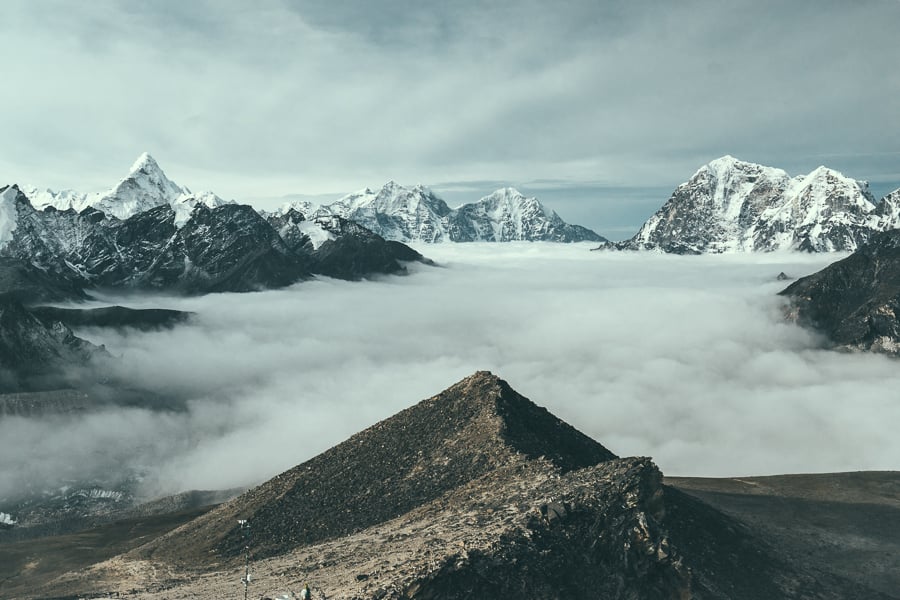
TRY THE 3 BEST TREKS IN NEPAL

Manaslu Circuit : My personal favorite 2-week trek through Tibetan villages and stunning scenery. Less crowded and more authentic.
Annapurna Circuit : The most beautiful & scenic 2-week trek in Nepal although can be crowded at times.
Everest Base Camp Trek : The most iconic 2-week route reaching the famous (EBC) Everest Base Camp at 5,300m.
BOOKING A GUIDE FOR THE EVEREST BASE CAMP TREK
The Everest Base Camp Trek doesn’t require a guide but it’s great to have a guide managing the logistics such as directions, tea-houses, distances, medical issues, and the overall organization. I’d say 90% of trekkers go with a guide. I highly recommend booking with Himalayan Masters which is one of the top trekking companies when it comes to the Everest Base Camp Trek. I’ve trekked many different routes in Nepal with them and I’m a big fan of their attention to detail.
The trek costs around $1500 USD with Himalayan Masters as of 2022 and includes all transfers, accommodation, meals, drinks, permits, and even the hotel stay before and after the trek at a high-quality hotel. I honestly had a great time on this trek and I can wholeheartedly recommend Himalayan Masters.
You can use my discount code ‘ JACKSON5 ‘ for 5% off the total price of your trek with Himalayan Masters which is a pretty handy saving.
Email: [email protected]
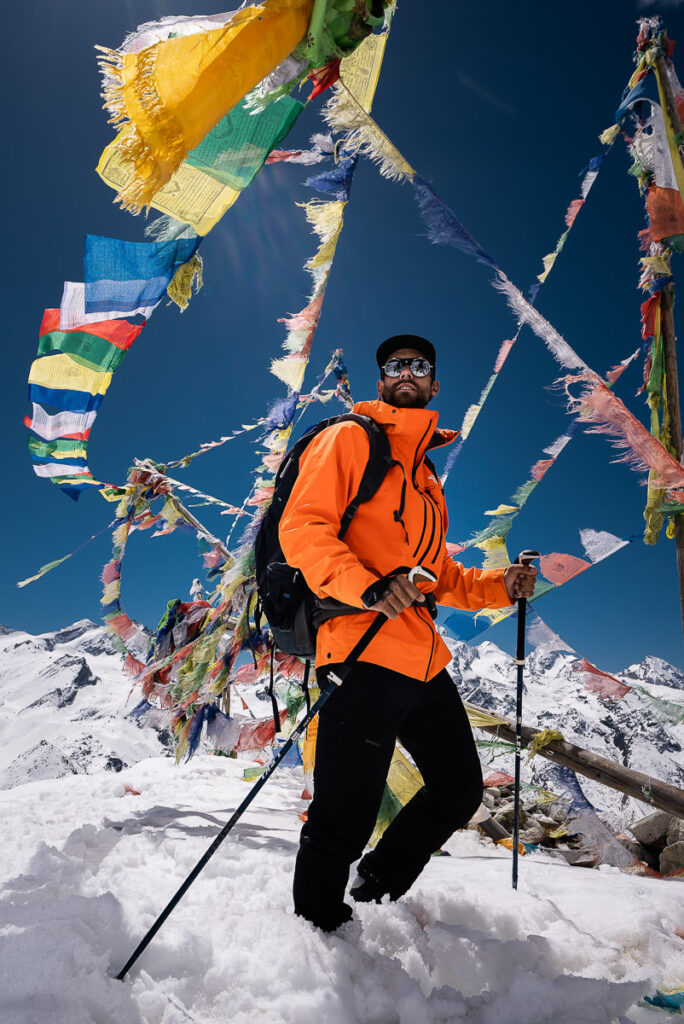
TOP 3 PLACES TO STAY IN KATHMANDU

- Ultimate Luxury: The Dwarika’s Hotel – Luxury, Spa-service, Pool
- Best Value : Aloft Kathmandu Thamel – Swimming Pool, Gym & Great Restuarant
- Budget Choice: Hotel Jampa is easily the top cheap hotel in Kathmandu
MY EXPERIENCE ON THE EVEREST BASE CAMP TREK
I’d like to share with you my experience and photos from my two weeks of trekking to Everest Base Camp. I hope you enjoy recounting the journey as much as I did.
Day One, Two & Three: Kathmandu to Lukla to Phak Ding to Namche
Day one began with an incredible flight from Kathmandu to Lukla. Unfortunately for me, I had come down with food poisoning the night before the trek so it was a rough start for me but I decided to battle on. The flight gives you incredible views of the Himalayas before you touch down at Lukla Airport, one of the most famous and scariest airports in the world. The landing strip is on a downwards slope and gives passengers a heart-in-mouth moment on take-off and landing.
After landing, we had a quick coffee and look around Lukla before making the short and relatively flat trek through the villages and forest to reach Phak Ding. Day one is a short trek but you have made your way up pretty high even just by landing at Lukla Airport so it is not a bad idea to take the first day easy, given that your biggest battle on this trek will be the altitude, not the distance or speed.
Day Two for me was actually a day of recovery in Phak Ding where I spent the entire day sick in the guesthouse. There is usually one day scheduled on your itinerary for sickness or rest day so I had used mine early!
Day three was a tough day as I was still recovering but we made the climb up to Namche, which is a winding climb through the forest and out above the tree line. Namche Bazaar is located at an altitude of 3450m inside the Sagarmatha national park, a UNESCO world heritage site and it is actually known as the last frontier for trekkers and climbers before the trek to Everest Base Camp starts to get serious.
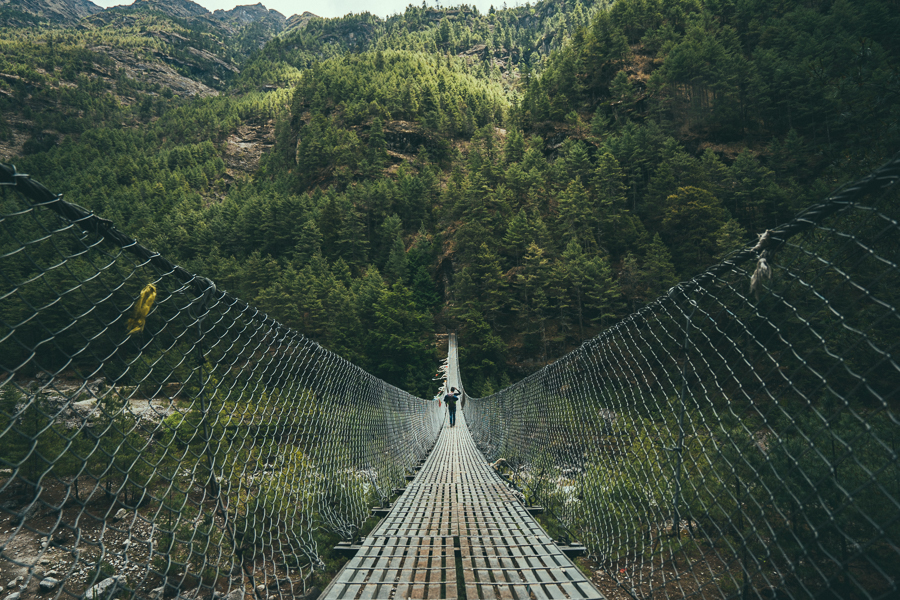
Day Four & Five: Namche to Tengboche to Dingboche
Day four is a big day of climbing. Namche Bazaar is 3,440 meters and Tengboche is 3,860 meters but the constant undulation on the trail means you will climb almost 900 meters of incline throughout the day.
The day begins by following the valley wall as you get some great views of the Everest mountain range out in front. The path then heads down into the valley floor as you lose a lot of elevation. However, you will then cross over the river and gain all the elevation back as you approach Tengboche where you will stay for the night.
Expect to have views of the mighty mountain Ama Dablam as well as Lhotse, Nupste, and even the peak of Mount Everest. Interestingly this will be one of the best views you have of Mount Everest until you reach Kala Patthar in a few days’ time.
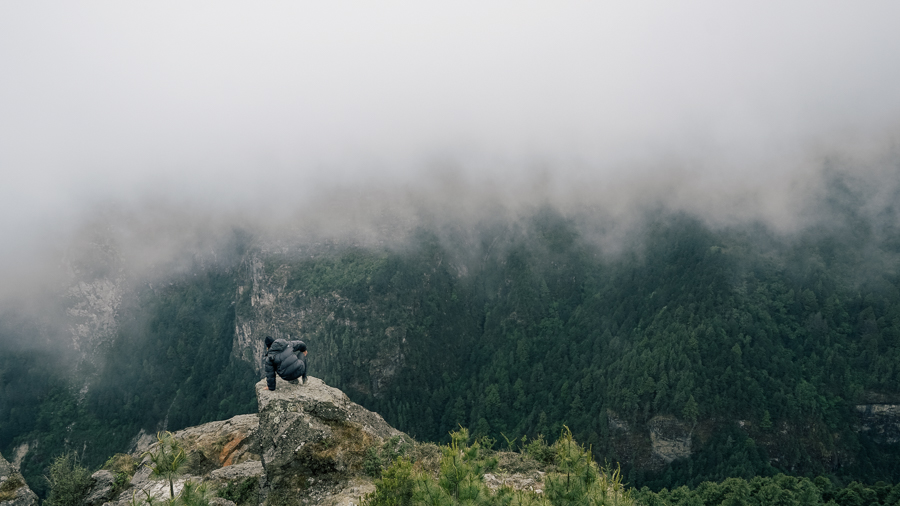
On day five of the Everest Base Camp trek, you say goodbye to the village of Tengboche and head towards Dingboche. It is a stunninng day as you voyage through the valley as the glacier river flows down below while snow-capped peaks loom in the distance. Along the trek, you will stop for tea in the village of Pangboche with lots of views of Ama Dablam mountain .
The elevation gain on day five is 700 meters and the entire journey will take about 5-6 hours at a moderate pace. Dingboche is 4,400 meters above sea level so it’s common to start to have a couple of symptoms of altitude sickness at this stage of the trek.
When you leave Tengboche, you begin a descent into the beautiful forest and can enjoy the shade as you pass through the village of Deboche. After you pass through Deboche, the trail gains some elevation and you will cross a suspension bridge, which guides you to the left side of the valley. Ama Dablam is still in view as you navigate the steep sections of the incline.
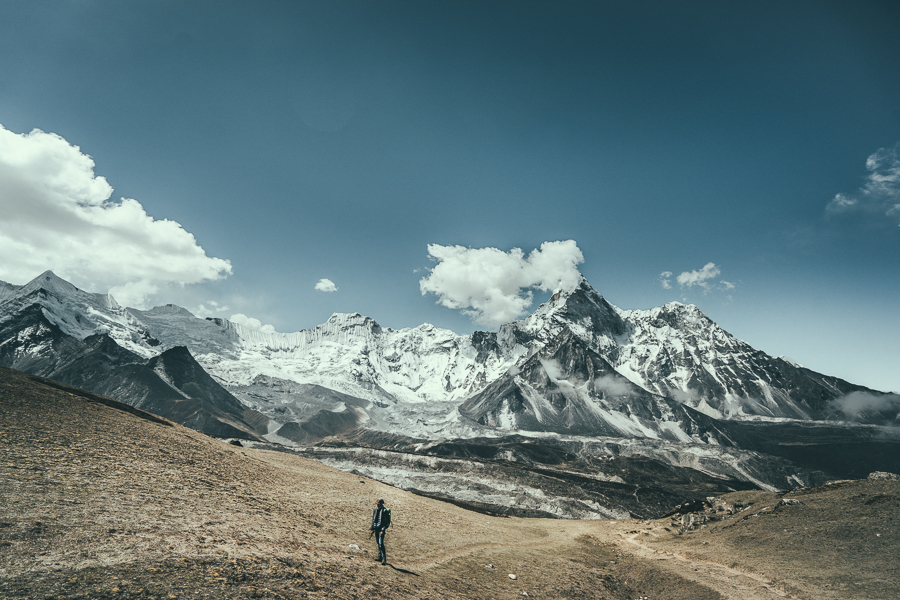
Day Six & Seven: Chuukhung Ri Acclimitization and Dingboche to Lobuche
Day six was an acclimatization day up to Chukhung Ri viewpoint, which was actually one of my favorite days. Because we would stay a second night in Dingboche, we left our bags in the tea house and did the climb up and down Chukhung Ri to help our bodies adjust to the altitude. The idea is to hike high and sleep low, which helps the body adapt.
Chukhung Ri is actually at 5500 meters, which is more than 1000 meters above Dingboche. This is a steep climb and you don’t need to go all the way to the summit. However, with spectacular views, isolation from other hikers, and a good chance to help your body adapt to the altitude, it’s a great day excursion with incredible scenery.
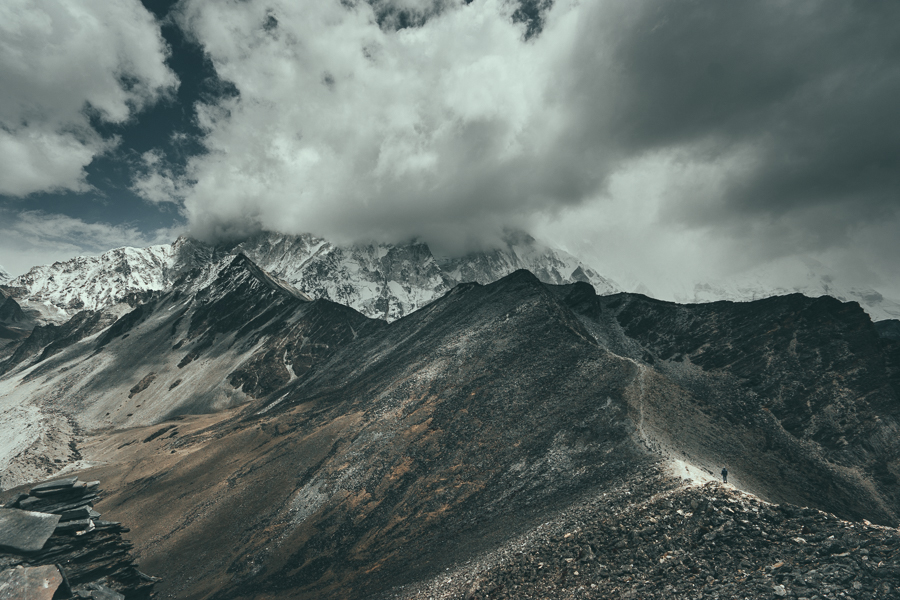
On day seven of the Everest Base Camp trek, we hiked from Dingboche to Lobuche, which is actually the second-highest village on the entire trail. Today is also the first time we will see the Khumba Glacier, which is one of the highlights of the trip.
The total elevation change for day seven is 500 meters in altitude but you will climb 600m in total for the day taking into account a few downhill sections on the trail. It’s a shorter day taking just four hours to reach Lobuche from Dingboche.
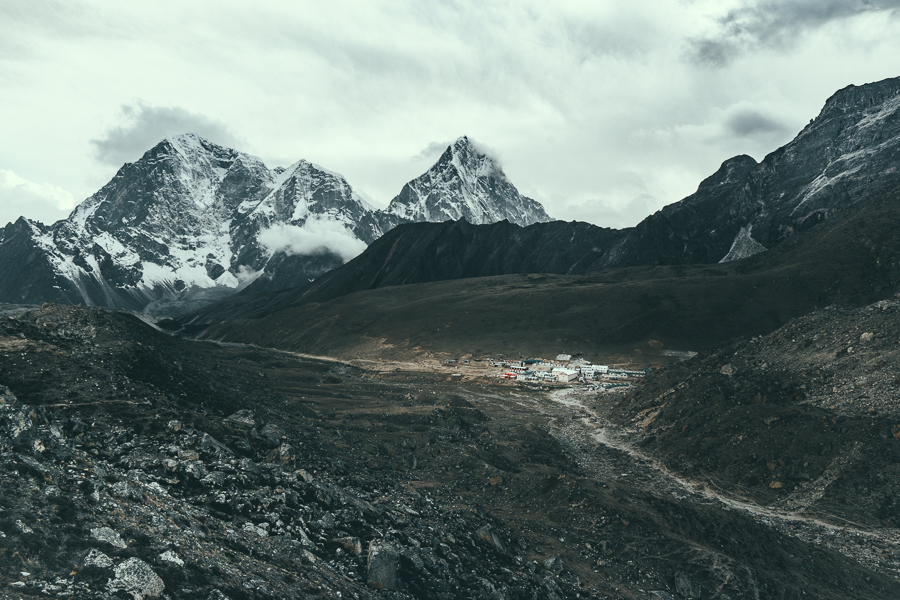
Day Eight: Lobuche to Gorak Shep to Everest Base Camp
On day eight of the Everest Base Camp trek, it is finally time to reach Everest Base Camp. From Lobuche your first trek to Gorak Shep, which is the highest village you sleep at throughout the trek.
Gorak Shep is a small village, and it’s the closest to Everest Base Camp is also the closest village to Everest Base Camp. Basically, you will trek to Gorak Shep, have an early lunch, and drop off your bag before doing the round-trip trek to explore Everest Base Camp. Then you will return to Gorak Shep where you will stay the night before heading to the nearby Kala Patthar in the morning.
The journey from Lobuche to Gorak Shep is along a rocky path, which slowly gains elevation as you walk next to the Khumbu Glacier. From Gorak Shep to Base camp, you will reach an altitude of 5,364m, which won’t be the highest on the trek as you will go higher the next morning at Kala Patthar.
When you leave Gorak Shep you walk next to the Khumbu Glacier with the Everest Mountain Range looming behind. The glacier is covered in dust and rocks due to the sediments, which have been falling from the surrounding peaks over the last years.
The trail continues alongside the glacier until you reach Everest Base Camp. It’s interesting because you actually can’t see Mount Everest from the base camp, which surprised me but the surrounding peaks are still very impressive and dramatic. Depending on if you come during the climbing season or off-season will alter how the base camp looks. I visited in the low season so there were no tents set up and it was pretty barren.
The trail continues past some Sherpa prayer flags as the rocky terrain leads you towards the famous Everest Base Camp rock, which is covered in hundreds of prayer flags. We’ve made it!
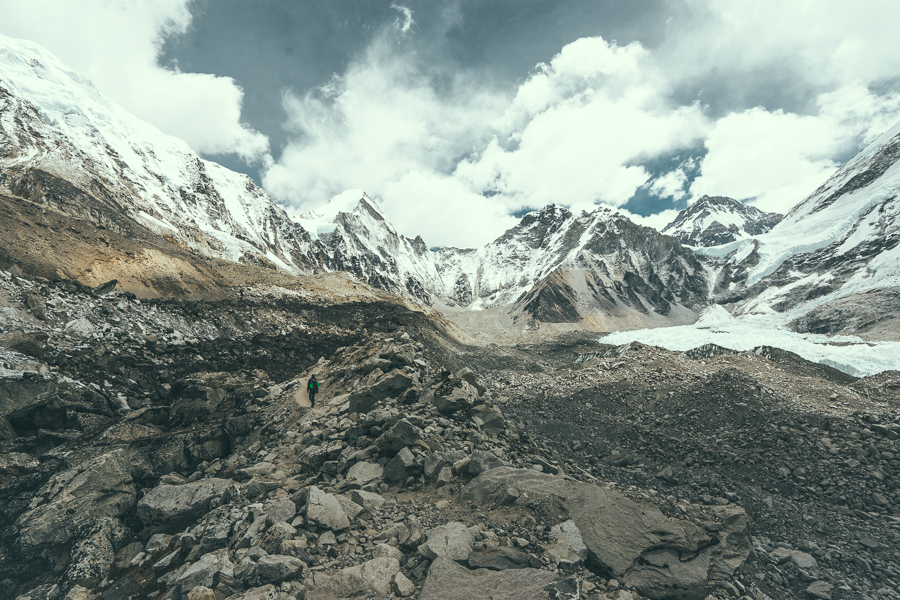
Day Nine: Kala Patthar
The highlight of the Everest Base Camp trek was the climb up to Kalapathar (also spelled out as Kala Patthar). It’s a 5,540-meter peak, which looms over the small village of Gorak Shep where you have just spent the night. It’s worth the freezing wake-up call in the morning as it is one of the best spots in Sagarmatha National Park to take in the views of Mount Everest.
It’s only a 3-kilometer round-trip trek from Gorak Shep with 300 meters of incline but at such high altitude, it can be quite difficult. I suggest starting 1.5-2 hours before sunrise so you are at the summit when the morning glow begins. After enjoying the sunrise with epic views of the cloud-filled valley and Mount Everest, we began the trek back down to Lukla.
It would take us another two days to reach Lukla, which is less than normal but going down is much easier.

Day Ten & Eleven: Heading back down
Heading back down is now at the pace of your choosing. We were keen to get back to Kathmandu so we took just two days to head back down the mountain. With altitude sickness no longer an issue, you can really make some good time.
If you are ahead of schedule you can keep going to the next village as there are no pre-made bookings. Heading down is a great feeling as you have accomplished reaching the base camp and you can now just breathe in the mountain air and enjoy the descent.
EVEREST BASE CAMP TREK: THE ULTIMATE GUIDE
In this section of the blog post, I will share with you the logistics and everything you need to know about trekking to Everest Base Camp.
HOW TO TREK TO EVEREST BASE CAMP
You have a few different options depending on your experience and requirements:
- Book a package through an agency to join a tour group
- Do the trek independently (not with an agency) but still hire a guide and/or porter
- Do the Everest Base Camp Trek entirely independently
If you are alone and don’t want to do the trek independently then it is a great idea to join a group. There are lots of free time and chill moments at the teahouses to play cards and chat with your group.
Doing it entirely independently means you are in charge of all the logistics and it can be quite stressful if you aren’t experienced at managing all flights, maps, costs, negotiations, food, language barriers, first-aid and more.
BOOKING AN EVEREST BASE CAMP TREK IN ADVANCE
These are the most popular routes and are organized by the top tour companies who have a global reputation.
The Everest Base Camp Trek doesn’t require a guide but it’s great to have a guide managing the logistics such as directions, tea-houses, distances, medical issues, and the overall organization. I’d say 90% of trekkers go with a guide.
I highly recommend booking with Himalayan Masters which is one of the top trekking companies when it comes to the Everest Base Camp Trek. I’ve trekked many different routes in Nepal with them and I’m a big fan of their attention to detail.
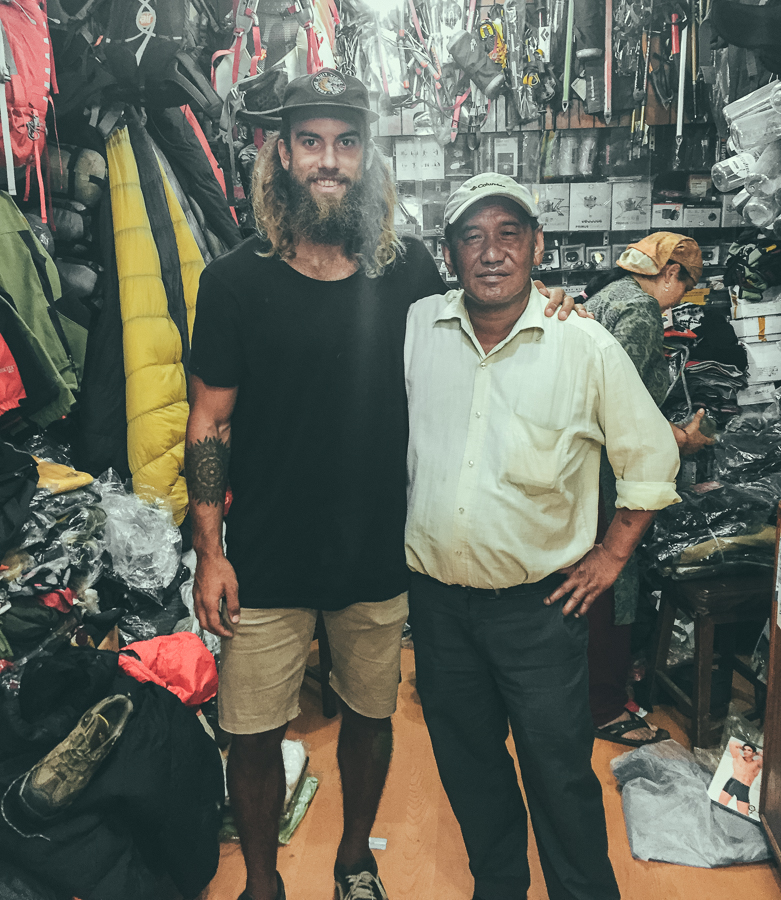
CHOOSING THE RIGHT TOUR AND A GUIDE
Trekking to Everest Base Camp can be done without a guide although I suggest hiring one. Here are 3 reasons why:
- Directions : The route isn’t incredibly hard to follow but there are many twists and turns I would have missed had I not had a guide. The route is available on many maps and map applications but it isn’t a clear trail throughout and some previous experience following a trail in a foreign country would be necessary.
- A guide is relatively cheap to hire : Included in your trekking package will be a qualified guide. However, in your package is also meals, accommodation, flights, etc. The guide him or herself will only cost $10-15 per day.
- When things go wrong : My guide helped me through food poisoning, altitude sickness and was as much a nurse as a guide. I rarely get sick at normal heights but altitude sickness is uncontrollable. I am pretty fit and it still smashed me hard. You can go it alone and be fine but it’s comforting to have a guide there when you come into trouble, especially with altitude sickness. My guide had seen it all before so his calm made me feel better about feeling sick for four days straight.
If you think you will get a guide like the majority of people on the Everest Base Camp, you have a lot of options and things to consider. Pictured below is my guide, Lapsang, who was a legend and someone who became a good friend. When I left Nepal he waited at the bus stop for two hours with me and gave me a Nepali scarf as a gift.
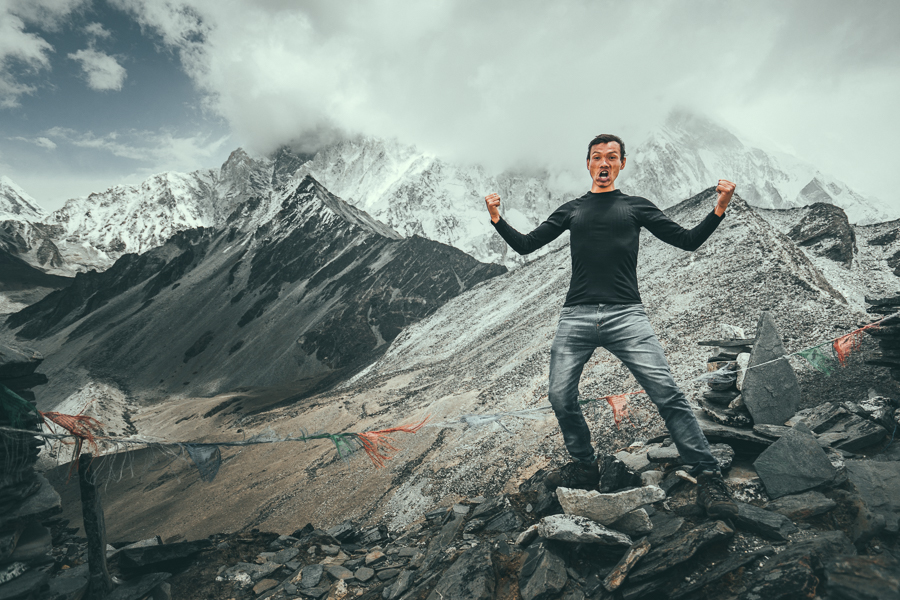
I suggest going with a small group of friends. We saw a few big groups and it looked like a Contiki tour compared to the experience I had with just myself and my guide. Only get a porter if you really need it. You should be able to carry your bag for 4-5 hours of trekking each day.
My guide, Lapsang Tamang, had done the trek multiple times as a porter and now many times a guide. He said he has lost count but somewhere over 20 times, he has been hiking the Everest Base Camp Trek. The best thing to do is to contact my guide and arrange to meet him first in Kathmandu so you can chat and decide if you want to go ahead. You will be together for 12 days after all!
You can directly contact my guide Lapsang by emailing him here: [email protected]
Lapsang is an awesome guy and I had too many chai tea hangouts with him before and after the trip. Lapsang and I became friends during the trip and afterward, we went bungee jumping, cooked Dal Bhat at his apartment, and visited Swayambunath Temple.
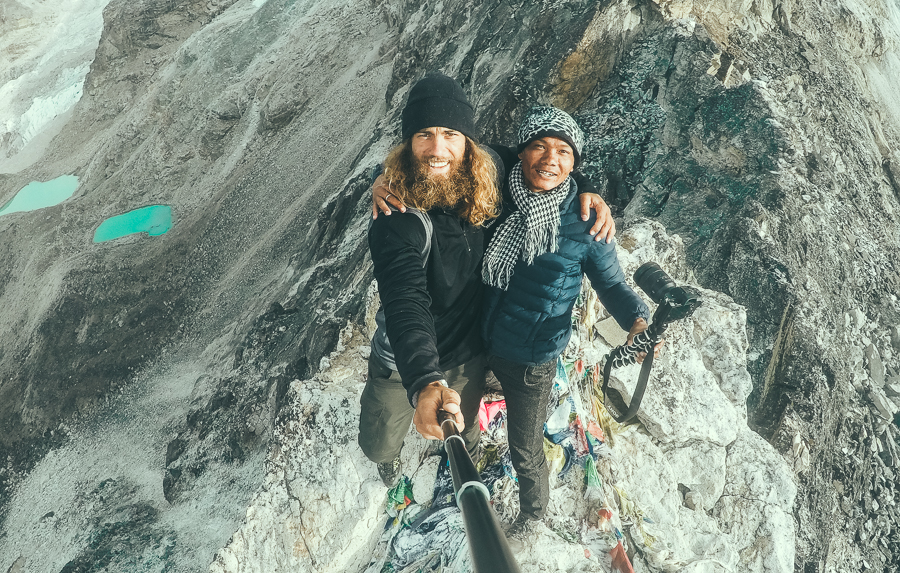
EVEREST BASE CAMP PACKING LIST
I had no winter clothes or even trekking shoes before getting to Kathmandu and bought it all for under $200 brand new (Likely fake North Face). But just as a guide you can get all the gear new for under $200. Bargaining/second hand etc. may help you get it a bit cheaper but this was one time I didn’t want to be so tight with money then freeze my ass off later on top of a mountain.
Keep in mind you won’t be doing any washing. Clothes that dry quickly and are lightweight are key. I showered once… Here is a list of what I took:
- 2 pairs of pants that rip off into shorts ($15 each in Kathmandu) (Super Safari style but actually handy in this situation.)
- 2 long sleeve quick-dry material shirts ($10 each in Kathmandu)
- 5 Pairs of Thermal North Face socks ($2-3 per pair in Kathmandu)
- 1 Fleece pants and sweater. ($25 for top and bottom in Kathmandu)
- 1 Thermal Lycra long sleeve and pants ($20 in Kathmandu)
- 5-6 pairs of quick-dry underwear
- 1 huge waterproof down jacket (Rented for $1 a day in Kathmandu)
- Beanie ($1 in Kathmandu)
- Neck Buff ($2 in Kathmandu)
- Gloves ($5 in Kathmandu)
- Water Purification pills and 1L bottle
- Camera gear and electronics (Not necessary but up to you. Obviously I carried a lot)
All of this should fit into a backpack no bigger than 50L and be less than 15kg. I used my 60L backpacking bag because I didn’t want to buy a new bag for a two-week trek. It worked out fine and weighed about 13kg including all of my lenses, chargers, and power banks.
What are my favorite pieces of trekking gear?
There are six pieces of gear that I simply never forget when I go trekking. These are five items that I using right now and this list gets updated every year! Here are my trekking essentials.
- Arcteryx BETA AR Rain Jacket : This is my go-to rain jacket. It’s super light, folds down into a tiny ball, and protects brilliantly in a storm. This one never leaves my backpack.
- Salomon X Ultra 3 Mid GTX Hiking Boots : For the best ankle support, waterproofing, and durable exterior I’m a fan of tough but light hiking boots like these Salomons for my adventures.
- Black Diamond Head Torch : I can’t tell you how many times, I’ve arrived back from a hike unexpectedly late. I always keep this lightweight but strong headtorch in my bag for the unexpected.
- Darn Tough Socks : These are the most comfortable hiking socks I’ve ever worn and last for years. They also have a lifetime warranty and you just send them in with a hole and they replace it no questions asked.
- Osprey Atmos AG 65L Backpack : I’ve never had a more comfortable 65L pack than this one. I got it in the Navy Blue and have trekked with it through many a mountain.
- Bl ack Diamond Trekking Poles : They might feel weird at first, but on a long trek with incline and decline you’ll begin to love these.
- Grayl GeoPress Water Filter Bottle : I’ve used this for three years. It filters your water with one press and you can drink directly from it. Never buy a plastic water bottle again!
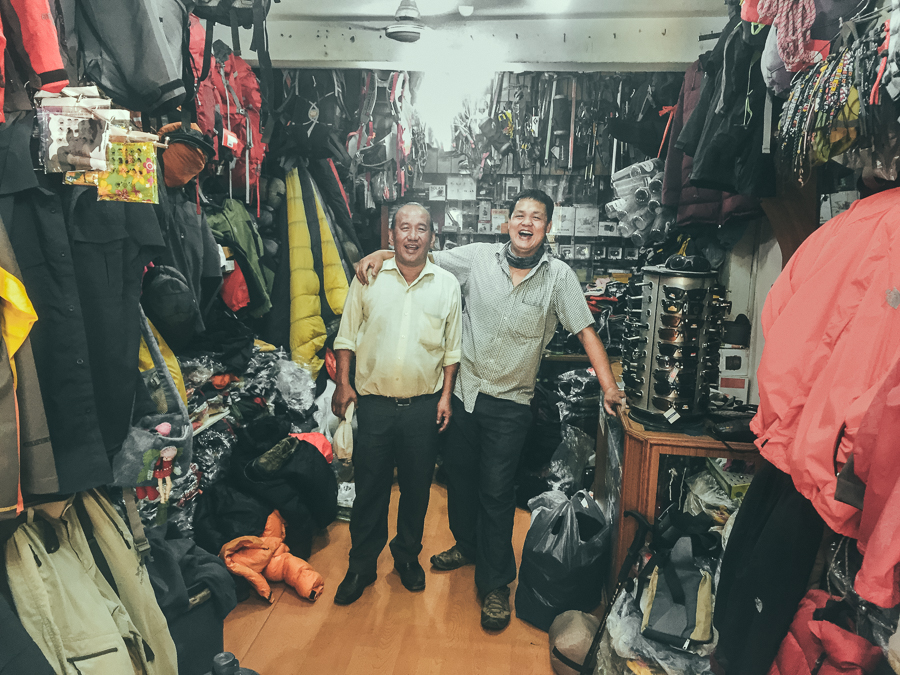
EVEREST BASE CAMP TREK COST
I paid $900 USD for my package all the way back in 2016 but you can expect to pay anywhere from $1400 to $2500 these days.
What’s included in the package for trekking to Everest Base Camp:
- Taxi from Thamel to Kathmandu Airport
- Flights from Kathmandu Airport to Lukla Airport
- Flights from Lukla Airport to Kathmandu Airport (Regular price $320 round trip)
- Breakfast, lunch, and dinner from the guesthouses you are staying at. I could pick anything on the menu, which had western options or Nepali options. You can eat pancakes, pizza, and burgers or you can go for the 24-hr Nepali Power Dal Bhat. I could also choose any hot drink with each meal.
- Your guide throughout the trip.
What’s not included:
- Water. You can buy bottled water like me if you are playing it safe. It is $1 per bottle at a lower elevation and $3 per bottle at the highest elevation. Or lots of people use purification tablets and they seemed to be fine.
- Electricity

EVEREST BASE CAMP TREK: WIFI/ELECTRICITY AVAILABILITY.
Wifi: Costs anywhere from $3 to $10 to use wifi at the guesthouses. Buy a Ncell Sim before you go. Ncell works at 50% of the guesthouses. Electricity: You will have to pay anywhere from $2 at low elevation to $8 at high elevation to charge your power banks, cameras, and phones. The key is to get a fat power bank. Pay to charge that then charge everything from your power bank. My power bank lets me charge my phone and four camera batteries before it would be done.
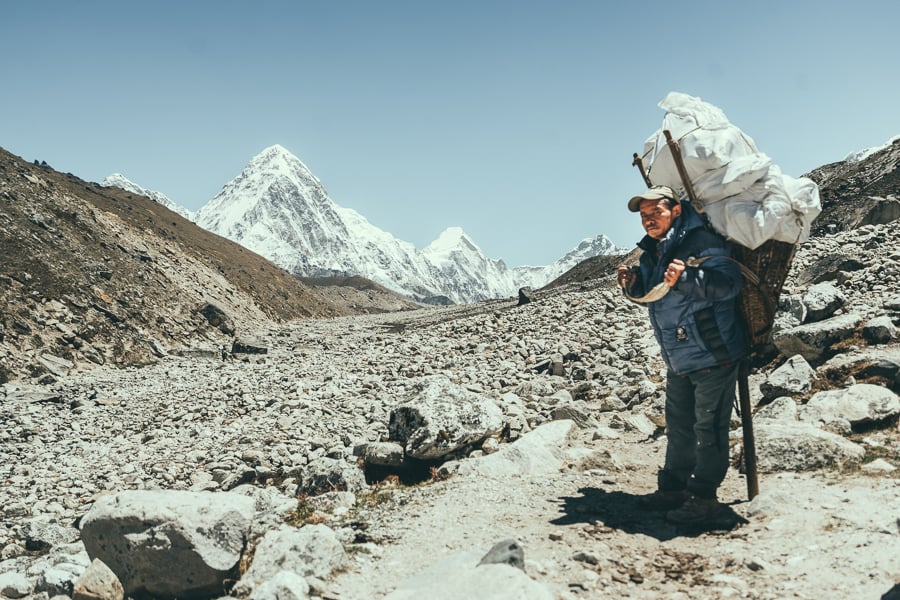
EVEREST BASE CAMP TREK: BEST TIME OF YEAR
This is an interesting question. Do you want snow, reliable weather or to get away from crazy crowds?
February to May – Peak season, clear bright days, very busy trails, lots of people attempting Everest ascent June to August – Monsoon season, no crowds and empty guesthouses September to October – Most stable and clear weather, trails are quite busy November to January – Coldest period, can reach -25, some routes closed
I trekked in the first week of June and was lucky to escape the rain. I didn’t get wet once. Normally it rained in the afternoon or at night if at all but we trekked in the morning and usually only heard the rain as we slept. The trails were open and some days we didn’t even see anyone.
My guide showed me a photo of Namche on a busy morning and I couldn’t believe it. The path looked like the start of a marathon. After seeing that I was so glad to have gone in the off-season.

EVEREST BASE CAMP TREK TEMPERATURE
During June when I trekked it was sunny in the days and I actually wore shorts every day. However as I mentioned above about when the best time to be trekking to Everest Base Camp is, it can get very cold at high elevations during November to January (-20 to-30)
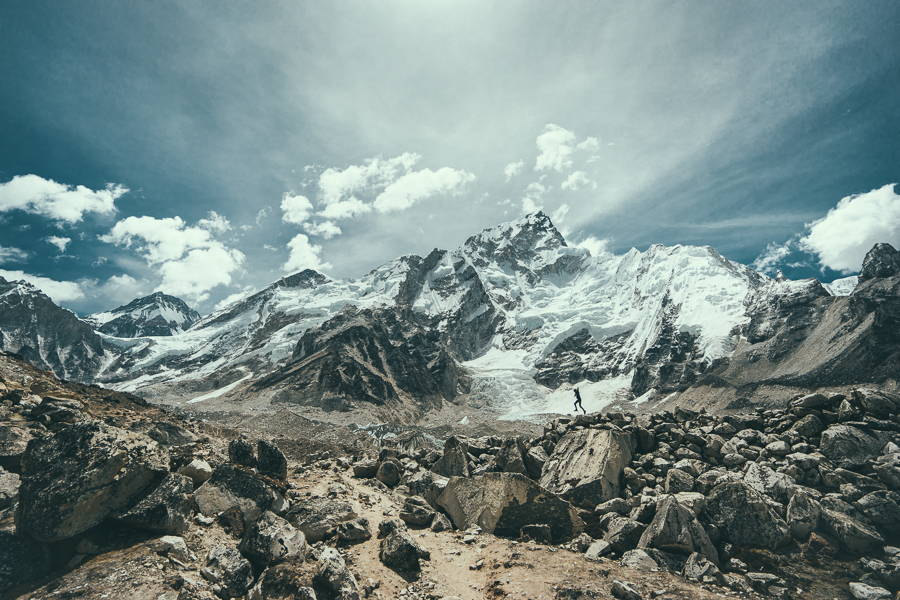
EVEREST BASE CAMP TREK DIFFICULTY
Trekking to Everest Base Camp takes some serious effort. But do you need to be in great shape to complete the journey? The simple answer is NO.
You can go at a slow pace, your own pace, and still make it to Everest Base Camp. In fact, going slow will help you to acclimatize better. I am all about speed but this is not a race. Some days we only trekked for just over three hours but we gained 500m in altitude so we rested for a day and then went again in the morning.
Having said all of that you should be able to walk 10-15 km in a day. Be able to walk up intense inclines for at least an hour. Be able to carry a bag while doing all of this unless you plan to hire a porter.
It’s hard to measure if you are ready. It isn’t like a marathon or anything else you have ever done most probably. I didn’t train at all and was fine. I’m in pretty good shape and played sport my whole life. There were people on the trail who were overweight and going incredibly slow but they were right there with us at base camp to celebrate the achievement.
EVEREST BASE CAMP ALTITUDE
The base camp is 17,600 ft or 5,380m. However, you will probably also trek to Kala Patthar, which looks over the base camp. Kala Patthara is 5,644m high.
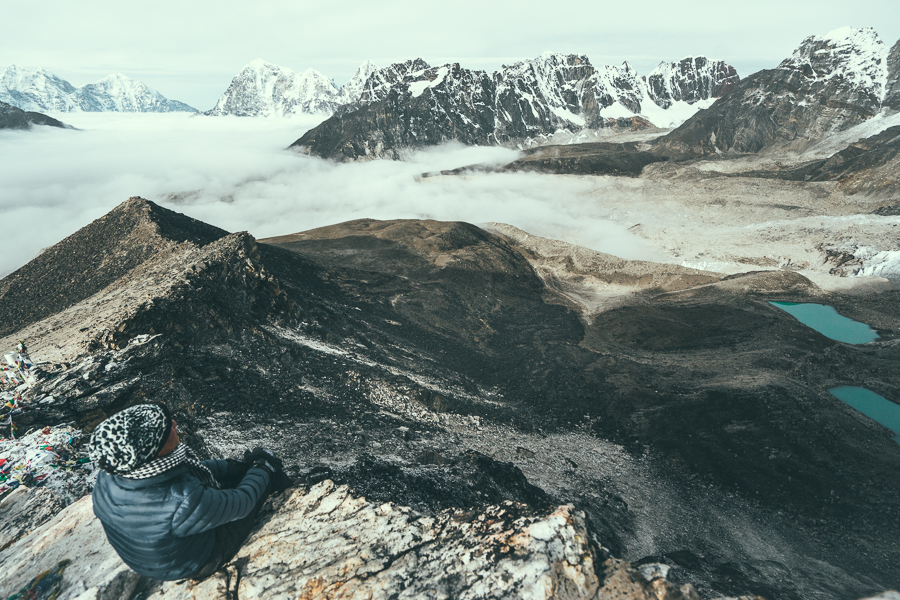
EVEREST BASE CAMP TREK DISTANCE
The distance from Lukla the first town to Everest Base Camp is 38.58 miles or 62 kilometers. Most people take 8-9 days trekking to Everest Base Camp and 3-4 days trekking back to Lukla. It took 8 days to trek to Base camp and two days to trek out.
EVEREST BASE CAMP ITINERARY
Your itinerary will vary depending on your speed and your guide. However, most people follow a somewhat similar trail and timeline. This was my timeline. Note that I spent one extra day in Phak Ding due to sickness. Most people spend that extra day in Namche.
- Day 1. Kathmandu flight to Lukla Lukla to Phak Ding (3-4 hrs)
- Day 2. Phak Ding rest day (sickness)
- Day 3. Phak Ding to Namche (5 hrs)
- Day 4. Namche to Tenboche (4 hrs)
- Day 5. Tenboche to Dinboche (3 hrs)
- Day 6. Dinboche to Chukhung Ri (2.5 hrs) Chukhung Ri back to Dinboche (1.5 hrs) (Acclimatization day)
- Day 7. Dinboche to Lobuche (3 hrs)
- Day 8. Lobuche to Gorak Shep (2 hrs) Gorak Shep to Everest Base Camp (1.5 hrs) Everest Base Camp to Gorak Shep (1.5 hrs)
- Day 9. Gorak Shep to Kala Patthara (2 hrs) Kala Patthara to Gorak Shep (1 hr) Gorak Shep to Tenboche (7hrs)
- Day 10. Tenboche to Lukla (8 hrs)
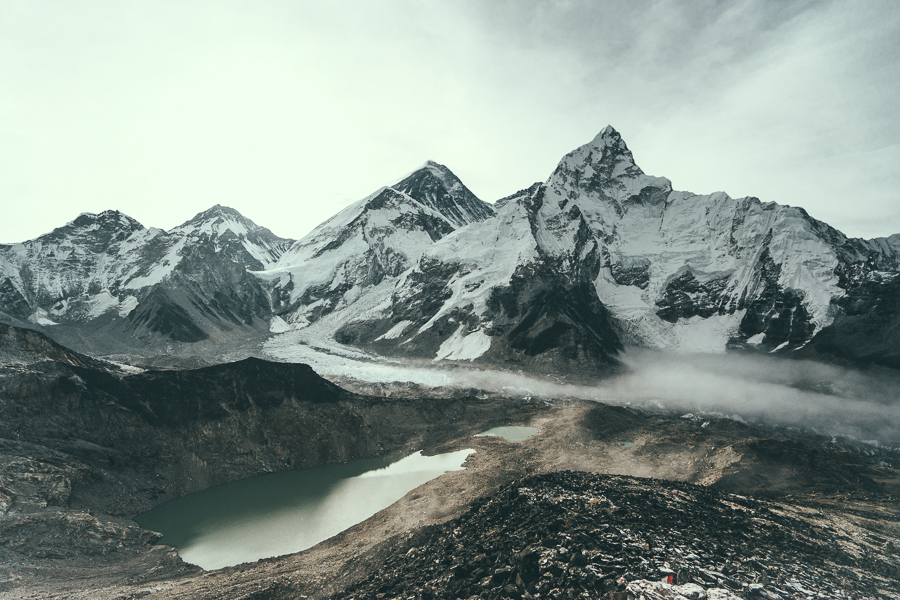
I hope you enjoyed my guide to the Everest Base Camp Trek and you have a great adventure.
HAVE YOU READ MY OTHER NEPAL BLOGS?
I’ve been lucky enough to have many awesome adventures in Nepal, which you can check out below where I’ve listed some of my favorite blog poss from Nepal.
- The Most Iconic route: Everest Base Camp Trek
- The Most Scenic Route: Annapurna Circuit Trek
- My Favorite Trek in Nepal: Manaslu Circuit Trek
- An Easy Nepal Trek: Langtang Valley Trek
- A great beginner peak: Island Peak Climb (6,165m)
- My Favorite Climb in Nepal: Climbing Ama Dablam (6,812m)
- My first 8000er: Climbing Manaslu (8,163m)
- My toughest climb in Nepal: Climbing Makalu (8,463m)
- Where to stay: 16 Best Places to Stay in Kathmandu

Tuesday 31st of October 2023
Sunday 17th of September 2023
So much informative articles which helps people to trek Everest Base Camp Trek
Inge Winkler
Saturday 3rd of June 2023
Hello, thank you for posting all the great infos, this will be very helpful for us. Could you please update me if the requirement of a Professional Guide is in place now or is there a way around it. Thank you so much in advance. Happy Trails, Inge
Sunday 18th of June 2023
I believe you need a guide now to trek anything above 3000m
Monday 21st of November 2022
Thanks for sharing such an adventurous trip experience with us. I read your blog. It feels like I was personally enjoying this trip.
Friday 12th of August 2022
Hi Jackson,
This was a helpful and informative guide. Kudos!
I had a small suggestion: You could have a small sections box right in the beginning and link each sub-section directly to the relevant content below, for ease of navigation!
From Lukla To Everest Base Camp: A Guide To The Best Routes And Trails

Your changes have been saved
Email Is sent
Please verify your email address.
You’ve reached your account maximum for followed topics.
10 Best Countries To Retire In Europe, According To The Global Pension Index
10 state parks in washington with scenic hikes, 10 state parks in arizona known for scenic campsites, quick links, how long is the trek from lukla to everest base camp, where can hikers stay while traveling from lukla to everest base camp, can any level hiker travel from lukla to everest base camp is it safe.
Located in the Himalayas lies the world-renowned trek from Lukla to Everest Base Camp, a journey that draws adventurers from across the globe. This 130 km (77 miles) round trip trek is a challenging but rewarding experience, showcasing the natural beauty of the region and offering a glimpse into the daily lives of the local Sherpa people.
The trek from Lukla to Everest Base Camp typically takes 13 days, starting from Kathmandu. Before embarking on this journey, hikers must train to prepare for the rigorous terrain and high altitude. This is especially important given the risks associated with being at such high altitudes for an extended period.
The trek from Lukla to Everest Base Camp is an unforgettable journey that offers a glimpse into one of the world's most breathtaking regions. With proper training and a sense of adventure, anyone can tackle this challenging but rewarding trek and come away with memories to last a lifetime.
- Lukla to Everest Base Camp is 38.5 miles.
- This entire hike should take people between 11 and 14 days in total.
- Many hikers between these two spots spend 8–9 hours walking daily.
For people wanting to take on Everest Base Camp from Lukla, this will be the journey of a lifetime. This trek between the two spots is approximately 38.5 miles, usually taking hikers 11–14 days. One thing to note, this trek is 38.5 miles either way: totaling 77 miles. According to past hikers, people will begin their eight-day hike from Lukla to the Everest Base Camp and then four days to trek back to Lukla. Some may want to hang out at Everest Base Camp for a couple of days, so that will add time to the entire voyage.
Luckily, the scenery between these notable hiking locations offers unparalleled views of the surrounding landscape, giving adventurers insight into the Sherpa people. Another detail to remember when traveling between Lukla and Everest Base Camp is that most people recommend hiking for 8–9 hours daily to keep the schedule at 11–14 days.
Some people even skydive from Mount Everest : so the adventure doesn't need to stop at the ground.
Related: 10 Stunning Himalayan Hiking Trails That Are Not Everest (Or Even Close)
The Best Trekking Route To Everest Base Camp
When it comes to the best route for those trekking to Everest Base Camp, people want to take The Classic Everest Base Camp trek. This path is the most direct route from Lukla to the 18,192-foot peak of Kalapatar. Hikers will also get the best view of Mount Everest from here, so that's perfect for those wanting to snap a few photos.
However, here are some alternative routes and timelines that one could take to get to the Classic Everest Base Camp Trek:
- Jiri to Everest Base Camp (19–21 days trekking)
- Tumlingtar to Everest Base Camp (21–23 days trekking)
- Gokyo Over Cho La Pass (17–18 days trekking)
- Lukla to Tengboche (around 7 days trekking).
The trek from Lukla to Everest Base Camp is 38.5 miles each way, totaling 77 miles for hikers. Therefore, to finish this trek in 11–14 days, hikers must spend 8–9 hours daily on the move.
- Hikers can stay between Lukla and Everest Base Camp in teahouses, lodges, and campsites.
- Phakding lies between Lukla and Namche Bazaar, making it a great stop along the way.
Trekking from Lukla to Everest Base Camp will have a few lodging opportunities between the two destinations. Generally, past hikers recommend stopping in Phakding, which takes roughly 3 to 4 hours to walk from Lukla. Along this trail, people can stay in lodges or teahouses, which will be primitive and won't be a "typical" experience. The road to Everest may be daunting, so preparing for this journey is crucial .
To explain these teahouses/lodges , they are houses with usually more than two floors but sometimes only one, with dozens of rooms. This could be a fun way to meet other adventure seekers along the way to Everest Base Camp (and back), so don't be afraid to start a conversation.
The trail between Lukla and Everest Base Camp is globally visited, so there will be people from all different cultures and countries to enjoy this with. These ten Everest Base Camp facts may be fun to know before the journey.
Related: Mt Everest: The History & Story Behind The World's Tallest Mountain
In general, if someone is healthy and regularly hikes, they should be able to handle the walk from Lukla to Everest Base Camp. One thing to keep in mind, however, is that this trek isn't easy but isn't nearly as challenging as taking on Mount Everest. The entire region is known for its high elevation and chilly weather, which may be difficult for some hikers.
There are many things to see and experience at the base of Mount Everest , so people don't need to take on the summit to have a memorable experience.
According to trek guides , the Everest Base Camp area is far easier for hikers than other areas, especially when compared to Everest: often considered one of the more dangerous journeys on Earth. It may be helpful to train before heading to Lukla and then to Everest Base Camp, taking on hikes near where someone lives. For example, if there are mountains nearby, that could be a great way to train for this Nepal adventure.
Going to the gym and using machinery at an incline may also help prepare someone for this, although nothing beats getting outdoors. If there is any hesitation with taking on a trek from Lukla to Everest Base Camp, it might be worth consulting a doctor and ensuring people's health is good enough to head to the mountains.
These are ten essential tips for anyone traveling to Everest Base Camp that are worth reading.
- Destinations

- Best Hikes In The World
- Appalachian Trail
- European Hikes
- Nepal Hikes
- Patagonia Hikes
- See All Hikes
- Mount Kenya
- Mount Kilimanjaro
- Mount Toubkal
- See All Mountains
- South Africa
- New Zealand
- Switzerland
- United Kingdom
- Packing Lists
Everest Base Camp Trek Distance
The Everest Base Camp Trek distance is a 130 km round trip beginning from Lukla.
However, the outward 65 kilometers to Everest Base Camp takes far longer as you need to factor in acclimatization. If you were to rush to base camp, you would almost certainly fall ill from altitude sickness .
This article is a guide on what to expect and how to best navigate the awe-inspiring distance of the Everest Base Camp Trek.
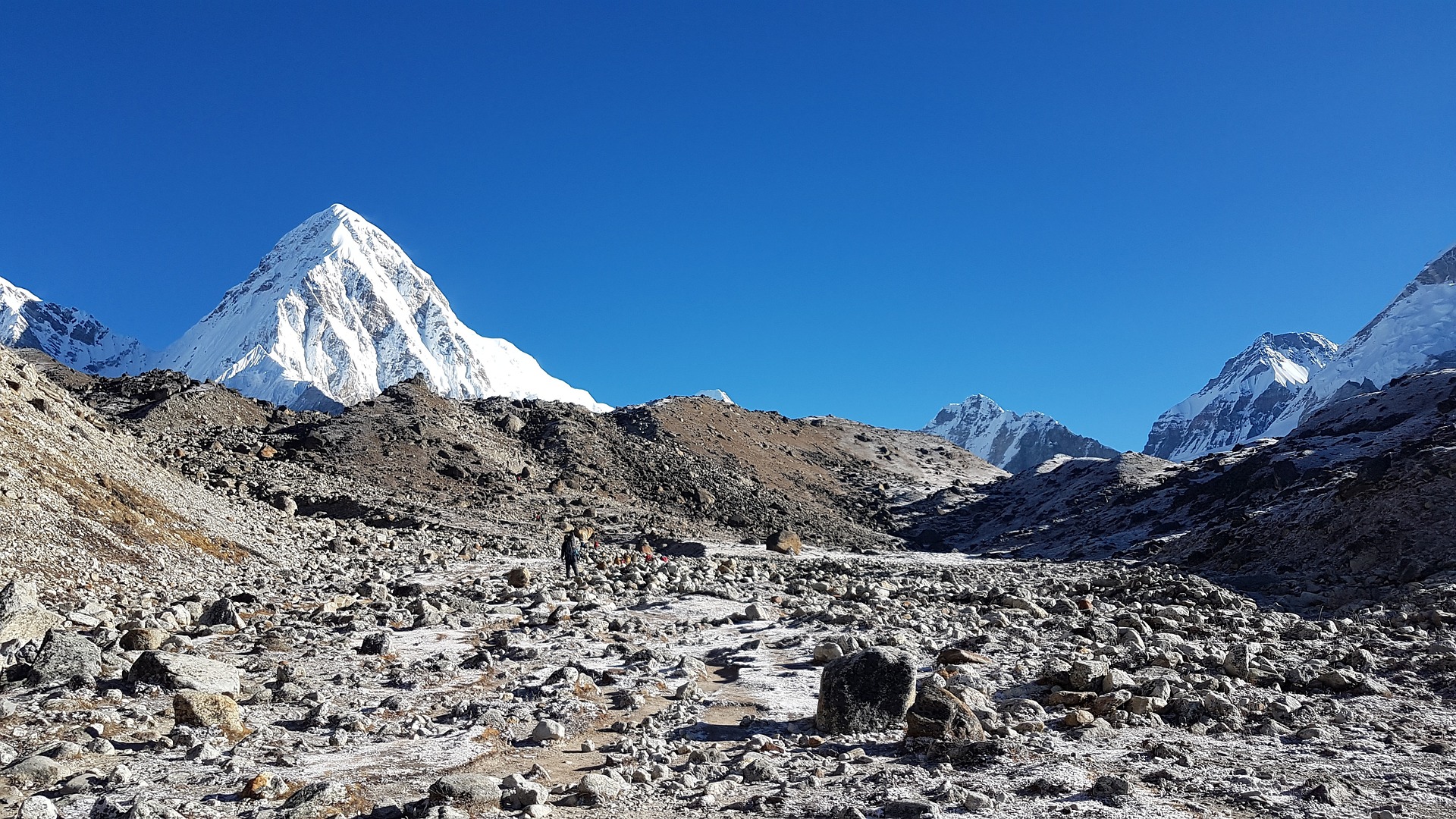
Depending on how much previous trekking experience you have, 130 km may or may not sound like a long distance. What you should bear in mind here is that the average walking speed of a human is 5 km per hour.
Therefore, 130 km is not particularly far when you think of it in those terms. The walking is also made easier by the fact that your larger bags will be carried by your porters (assuming you are not trekking solo).
See our article on the difficulty of the Everest Base Camp trek .
Trek Itinerary
On a standard 14-day return trek to EBC, you will be walking for 9 days with an average of 15 km a day.
The other days will either be spent acclimatizing or in Kathmandu . Although 15 km a day is not a long distance, the steep and rocky terrain can slow you down. This is especially true in winter when the trail will often be covered in snow and ice.
At no point is the path paved and the naturally hilly landscape means that your average walking speed will suffer a little.
Below, we have provided a day-by-day distance itinerary for the classic EBC trek.
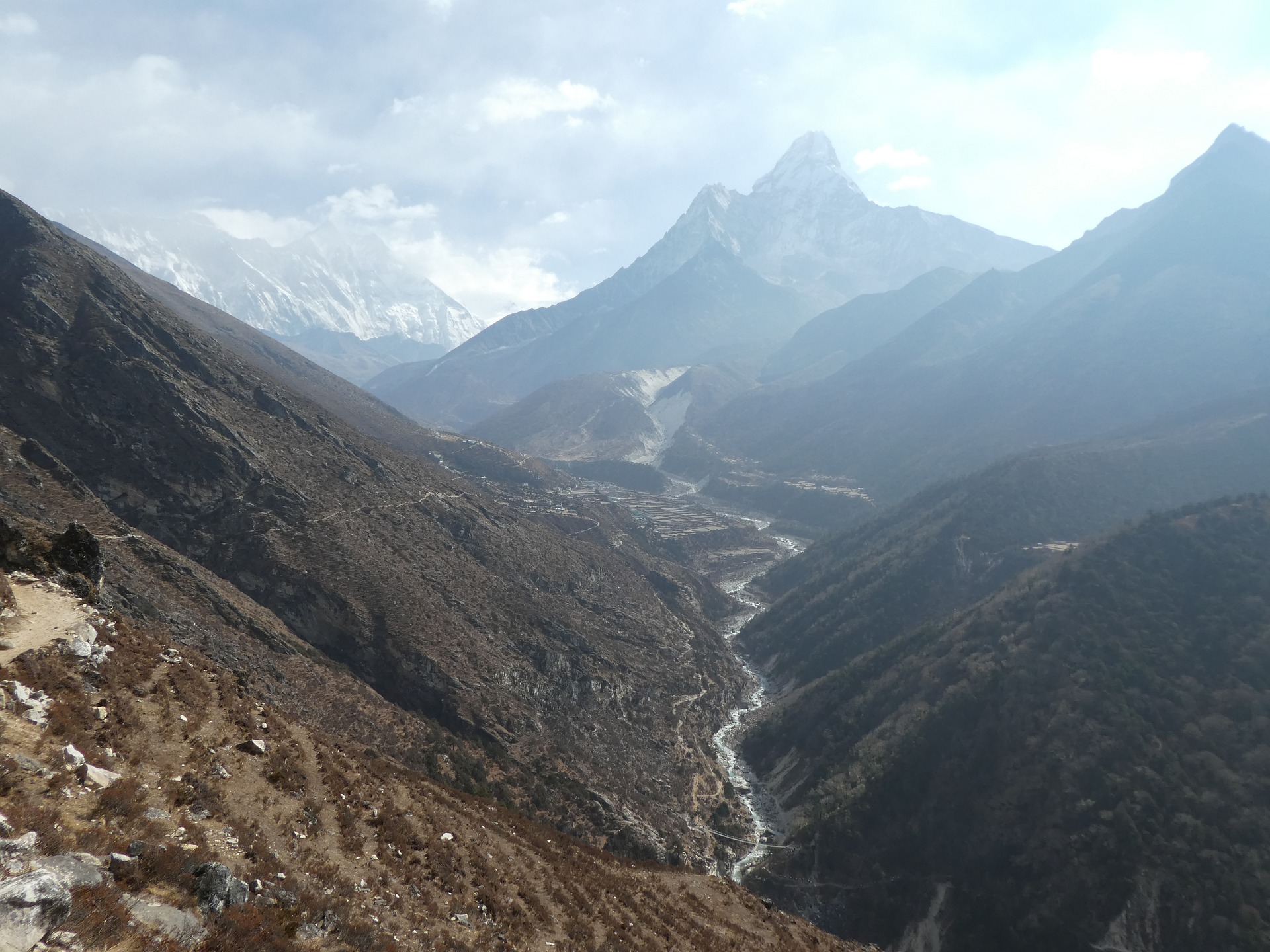
Day 1 (9 km - 4.5 hours)
On the first day, you will fly from Kathmandu to Lukla. From there, you will then walk to Phakding.
Day 2 (12 km - 6 hours)
On the second day, you will trek from Phakding to Namche Bazaar.
Day 3 (Acclimitisation)
The third day of your EBC trek is purely for acclimitisation. You won't do any walking except maybe a quick hike up to the Everest View Hotel .
Day 4 (12 km - 10 hours)
On the fourth day, you'll continue your trek from Namche Bazaar all the way to Tengboche.

Namche Bazaar, Khumbu District
Day 5 (12 km - 6 hours)
On the fifth day, you'll do a long hike from Tengboche to Dingboche.
Day 6 (Acclimitisation)
On the sixth day, you'll do some exploring of Dingboche.
Day 7 (12 km - 6 hours)
On the seventh day, you'll leave Dingboche and hike to Lobuche.
Day 8 (8km - 3-4 hours)
On the eighth day of your EBC trek, you'll hike from Lobuche to Gorakshep .
Day 9 (22 km - 7 hours)
On the ninth day, you'll cover a lot of distance by first hiking from Gorakshep to Everest Base Camp. Afterwards, you'll start trekking back to Dingboche.
Day 10 (24 km - 8-10 hours)
On the tenth day of hiking, you'll trek from Dingboche back to Namchee Bazaar.
Day 11 (21 km - 7-9 hours)
On the eleventh day, you'll hike from Namchee Bazaar all the way back to the airstrip at Lukla, offically completing your EBC trek.
Day 12 (Departure)
On the twelfth day, you'll give your legs a well-deserved break and fly back to Kathmandu.
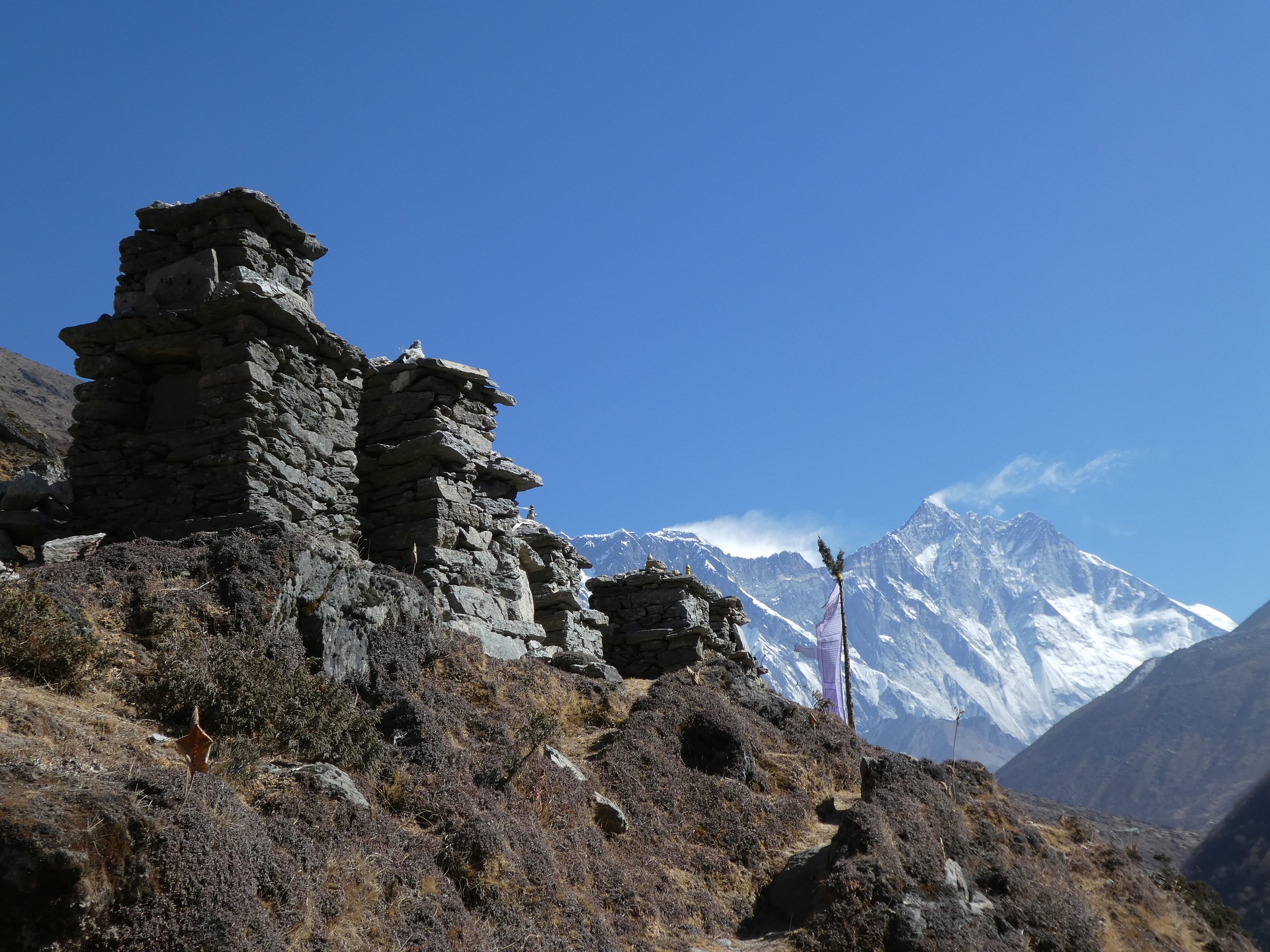
If you have any further questions about the distance of the Everest Base Camp Trek, please leave a note below and we'll get back to you within 24 hours.
Thank you and happy trekking!
Tags: Everest Base Camp trek distance, How long is the Everest Base Camp trek
Continue browsing
See more information on Nepal . Or check out these other Everest articles:
- Climbing Mount Everest Tips
- Best time to do Everest Base Camp Trek
- Guide to EBC Trek Training
- EBC Packing List
- Cost of Trekking Mount Everest
- Everest Base Camp Trekking Insurance
- Food and Drinks on Everest Base Camp Trek
About the author
Andrew Roux
Andrew is one of the senior writers at Mountain IQ. A native of South Africa, Andrew has hiked and climbed all over the world. His favourite destination is Nepal and his most memorable hike was to the summit of Mount Kilimanjaro!
Leave a Reply
Your email address will not be published. Required fields are marked
Thanks for the complete info about the distance of EBC. I would like to know about the best months for the trek and do we need a guide for it or we can do it by ourself?
Hi Nishant, the best months are March through to May and September through to October. The latter is the Everest season, so if you want to feel the energy of the climbing season then April-May are the best months. You can do the trek unsupported but I recommend taking a guide. All the best
How many feet is it from Everest base camp to the summit of Everest? Many thanks!
The summit of Mount Everest is 8,848m (29,029 ft). Everest Base Camp is at 5,364m (17,598 ft). So the altitude variation in feet is 11,431 ft.
We would prefer to carry our own bags is this ok?
Yes, many people trek independently (i.e. with no support) or with just a guide and no porters.
Please share details for EBC trek
Hi Anny, here’s a complete guide: https://www.mountainiq.com/guides/trekking-in-nepal/routes/everest-base-camp-trek/
What is the advisable/maximum speed to walk at ?
Hi Jamie, assuming you are not pre-acclimatised from an earlier hike in the Himalayas, then you should aim to take 12-13 days from Lukla return. This will give you enough time to include 1 or 2 acclimatisation days, and provide a slow and steady pace to EBC.
We work with local guides to offer great value adventures at unbeatable prices.

Everest Base Camp Trek Distance, Elevation Gain, & Time by Day
By: Author Charles
Posted on May 8, 2023
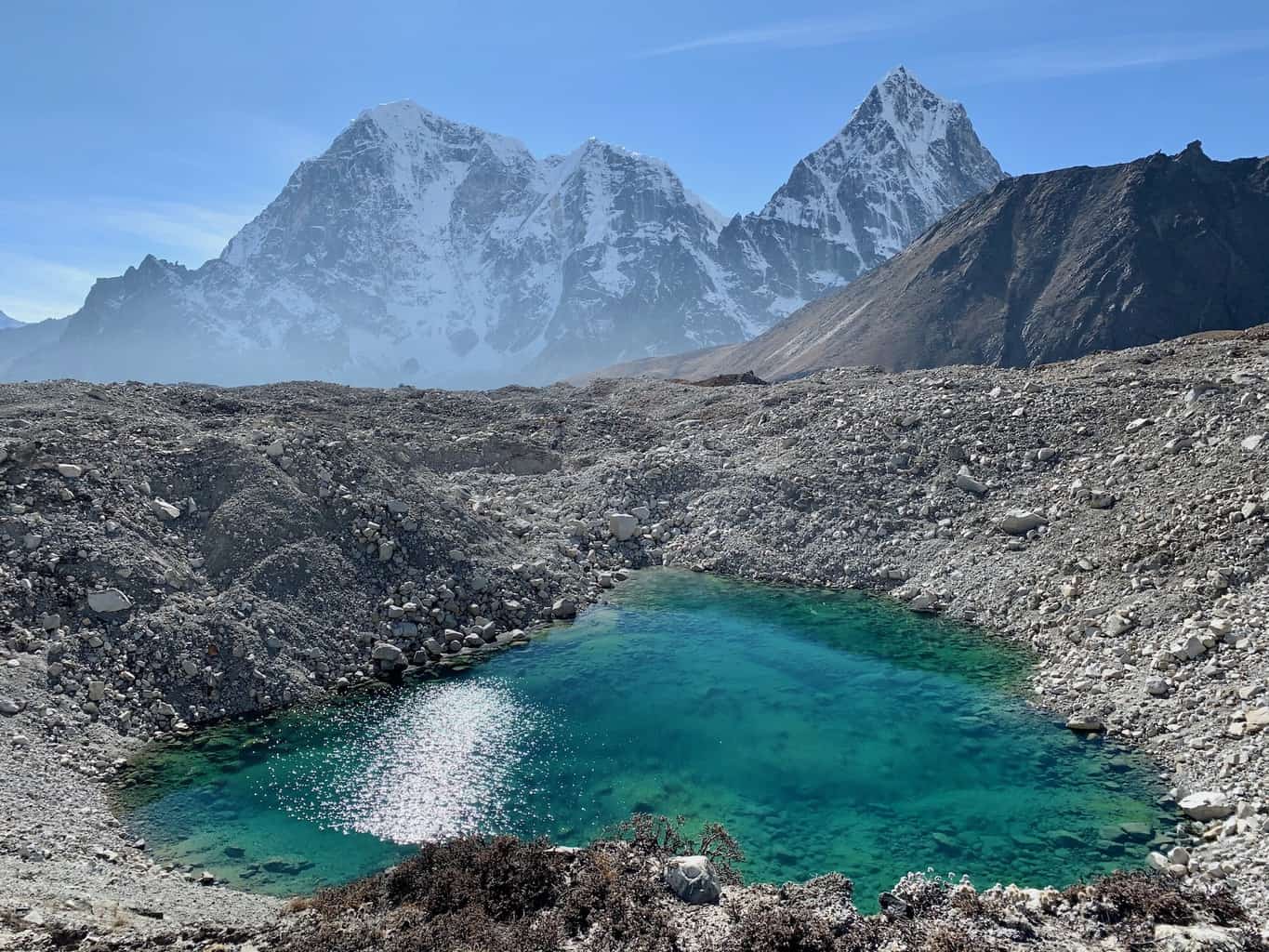
The Everest Base Camp trek in Sagarmatha National Park of Nepal is one of the most iconic multi day hiking routes in the world. Due to its length, terrain, elevation gain, and difficulty, this trek is not for everyone out there.
This guide is going to go over the day by day distances, trekking time, and elevation gains for the 11 day route and help better prepare you for your time on the trail.
* Affiliate Disclosure : This post may contain affiliate links, which means I may receive a commission if you make a purchase through the links provided, at no additional cost to you. Thanks for supporting the work I put into TripTins!
1) Everest Base Camp Trek Logistics
To be clear, this guide is to better help you understand all the details from a numbers and stats perspective behind an 11 day Everest Base Camp trek itinerary – distances, trekking times, and elevation gains day by day.
I won’t be talking much about landscapes, terrain, villages, etc. in this guide but you can check this Everest Base Camp Trekking Guide that talks more about the trail itself.
When I was researching the trail on my own, I found a lot of differing information with some of these distances, times, and elevation gains.
Now that I have spent time in the region, completed the trek on my own, and understand the landscape profile more clearly, I can better help everyone else prepare for their time on the trail.
Below is a spreadsheet that I put together that can better breakdown the distances, times, and elevation gains by day .
You can see the day by day breakout including starting and ending points for the day, distances (miles and km), average duration on the trail, beginning and ending elevation of villages (taken from the National Geographic Hiking Map), true elevation gain (feet and meters) – more on that soon, and net elevation gain (feet and meters).
The true elevation gains & distances are calculated based on my own GPS data, other hiker’s data, and cross checked with topographic map data.
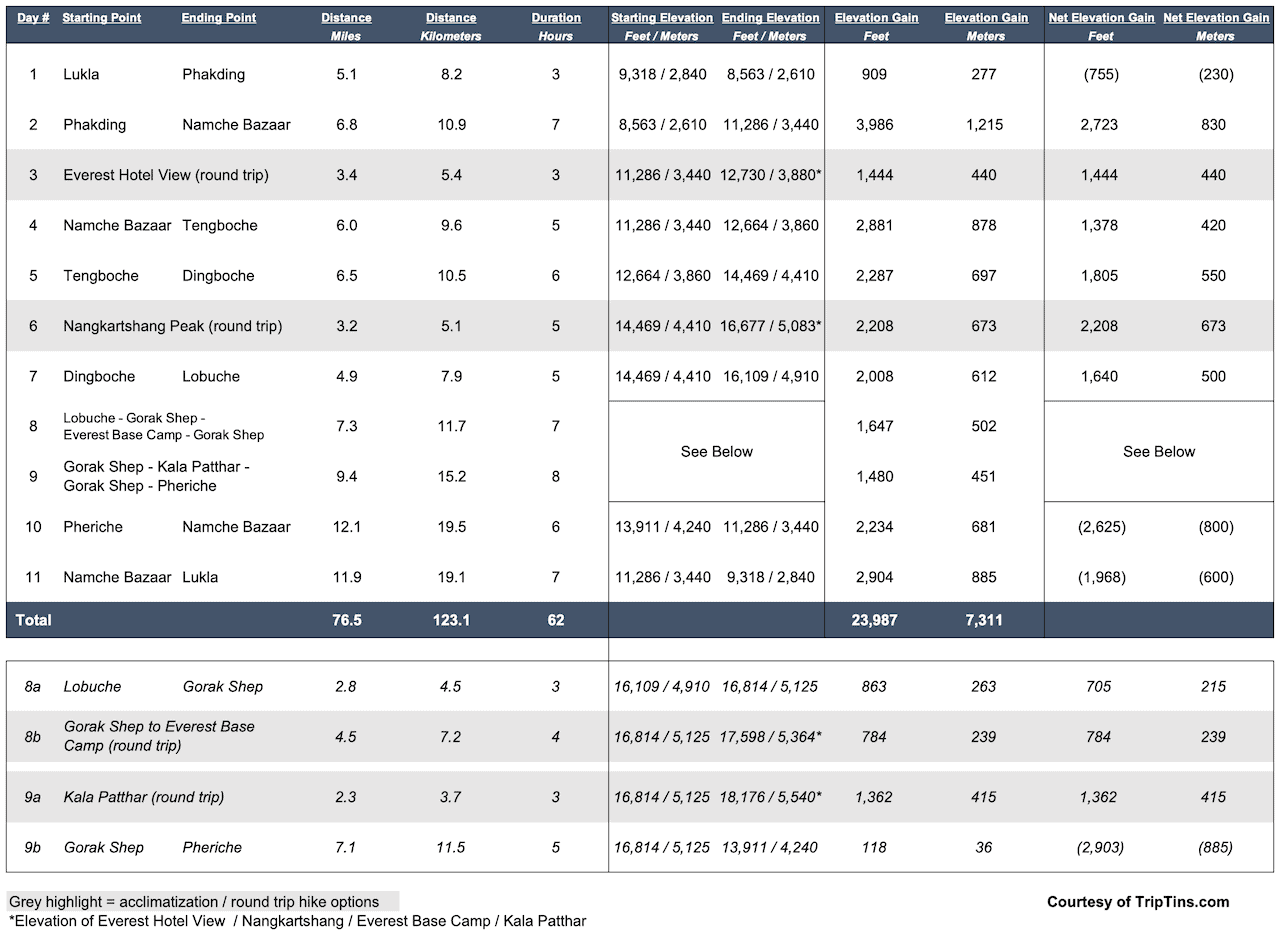
Taking into account the entirety of the trek from Lukla to Everest Base Camp and back to Lukla, including acclimatization hikes in Namche Bazaar and Dingboche, and the hike up/down Kala Patthar, you are looking at 77 Miles / 123 Kilometers of trekking.
On average that means you will be walking for 7.0 Miles / 11.2 Kilometers per day.
You may come across some different numbers throughout your research, but by using my own GPS data coupled with those of other hikers and hiking websites, I am confident these are some of the most accurate numbers when it comes to actual distance on the trail.
Hiking Times
Hiking times are the toughest numbers to estimate accurately since everyone has different paces in general.
Some people may be faster on downhills while others may be faster on uphills so there can be a wide range of hiking times.
On average though for a normal hiker, I have estimated 62 hours of trekking, which averages out to just over 5.5 hours per day. For the faster hikers out there that could be closer to 4 hours and for the slower, closer to 7 hours.
The shortest days out there on the trail will be about 3 hours, with the longest days on the trail being 8 hours. So overall, there will be a good variety of hiking times as you make your way along the trail.
Elevation Gain
One of the main issues I came across was from an elevation gain standpoint.
A lot of day by day breakouts basically said if Namche Bazaar is at 11,286 feet of elevation and Tengboche is at 12,664 feet of elevation, that means you are gaining +1,378 feet of elevation in the day. This is what is shown in the last two columns of the chart.
However, that 1,378 feet is the net elevation gain, not the total gain. The route has numerous ups and downs throughout, making the true gain 2,881 feet (shown in the previous two columns).
And elevation changes like this does happen frequently on the Everest Base Camp trail! Even on those downhills back from Base Camp to Lukla, you will have several thousand feet of elevation gain sprawled throughout.
The trail starts at Lukla at 9,318 feet / 2,840 meters and goes up to Everest Base Camp at 17,598 feet / 5,364 meters. You may assume you are gaining the difference between the two – 8,280 feet / 2,524 meters.
However, throughout the entire trail including your acclimatization hikes, you will be gaining around 24,000 feet / 7,300 meters of elevation – that is about triple the number that you may have expected!
So, I am hoping this short guide better helps you understand the landscape of the Everest Base Camp trek and cleans up any misconceptions about the route when it comes to distances, times, and elevation gains.
2) EBC Trekking Map
Below is a map of the Everest Base Camp trek that begins down in Lukla and slowly makes its way up to Everest Base Camp over the course of 8 days.
During the trek you will have two acclimatization hikes (one in Namche Bazaar on day 3 to the Hotel Everest View and one in Dingboche on day 6 to Nangkartshang Peak), as well as a hike up to Kala Patthar on day 9 before starting the trek back to Lukla.
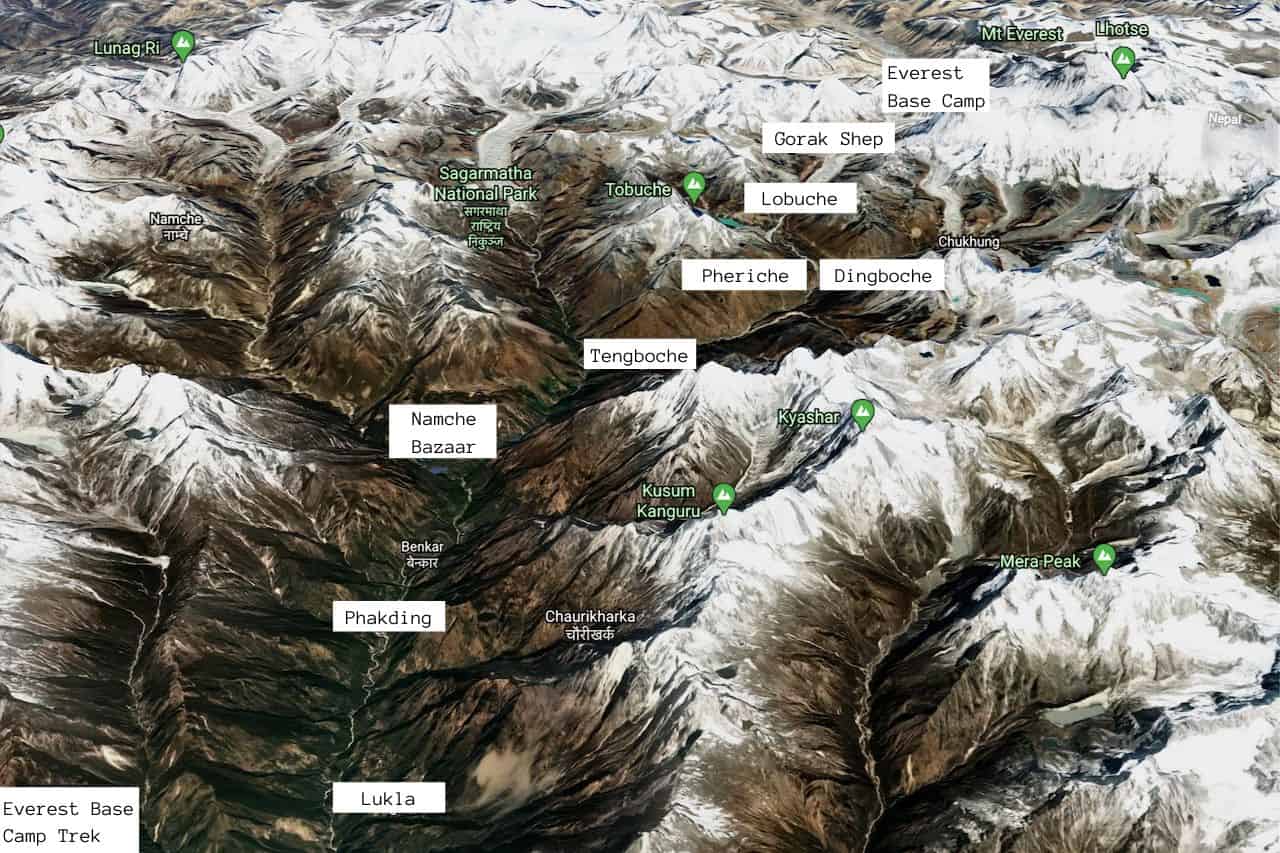
Considering travel insurance for the Everest Base Camp Trek? World Nomads offers coverage for more than 150 adventure activities as well as emergency medical, lost luggage, trip cancellation and more. For years, World Nomads has been protecting, connecting & inspiring independent travelers, offering travel insurance & safety advice to help you travel confidently. Their mission is to support and encourage travelers to explore their boundaries . World Nomads has simple and flexible travel insurance that has been designed by travelers for travelers. Even if you leave home without travel insurance or your policy runs out, you can buy or extend out on the road. Get a quote for a World Nomads travel insurance policy today!
3) Everest Base Camp Trek Elevation Profile
This is an important graph to pay attention to when preparing for the trail. You can see that this is not simply a straight up trail from Lukla to Gorak Shep.
Along the way you will have many uphills and downhills, making the elevation gain higher than what you may have anticipated.
Note that it does not include acclimatization hikes in both Namche Bazaar and Dingboche, or the hike up Kala Patthar.
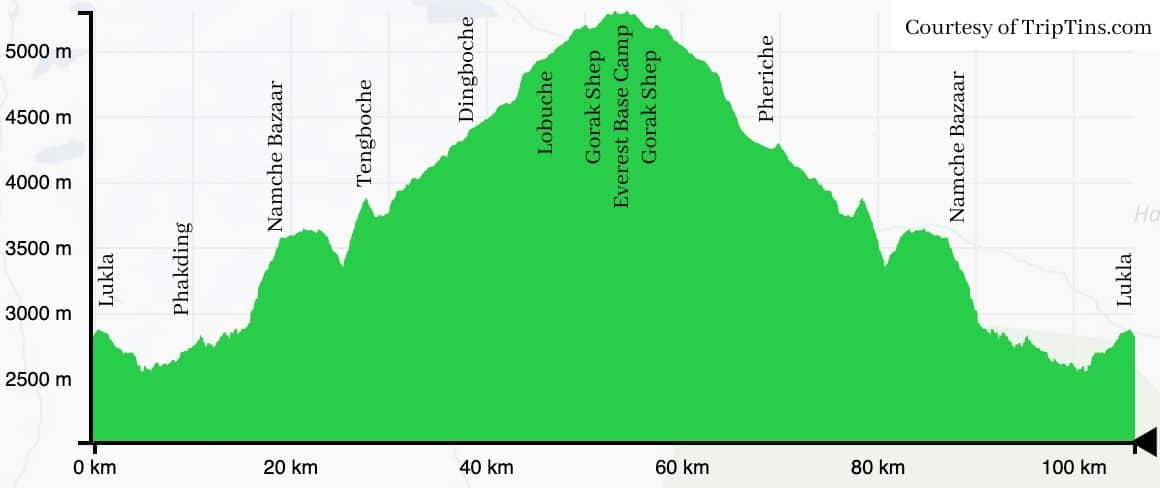
4) Day by Day Hiking Stats
Below you can find the day by day statistics for the EBC trek including the elevation of each village, the distance traveled, the elevation gained, and the estimated duration of the hike. It basically just breaks out the numbers chart I put together above.
Everest Base Camp Trek Day 1: Lukla to Phakding
- Duration : 3 Hours
- Distance : 5.1 miles / 8.2 km
- Starting Elevation : 9,318 ft / 2,840 m
- Ending Elevation : 8,563 ft / 2,610 m
- True Elevation Gain : 909 ft / 277 m
- Net Elevation Gain : -755 ft / -230 m
Everest Base Camp Trek Day 2: Phakding to Namche Bazaar
- Duration : 7 Hours
- Distance : 6.8 miles / 10.9 km
- Starting Elevation : 8,563 ft / 2,610 m
- Ending Elevation : 11,286 ft / 3,440 m
- True Elevation Gain : 3,986 ft / 1,125 m
- Net Elevation Gain : 2,723 ft / 830 m
Everest Base Camp Trek Day 3: Namche Bazaar Acclimatization Hike – Hotel Everest View
- Distance : 3.4 miles / 5.4 km
- Starting Elevation : 11,286 ft / 3,440 m
- Ending Elevation : 12,730 ft / 3,880 m
- True Elevation Gain : 1,444 f / 440 m
- Net Elevation Gain : 1,444 f / 440 m
Everest Base Camp Trek Day 4: Namche Bazaar to Tengboche
- Duration : 5 Hours
- Distance : 6.0 miles / 9.6 km
- Ending Elevation : 12,664 ft / 3,860 m
- True Elevation Gain : 2,881 ft / 878 m
- Net Elevation Gain : 1,378 ft / 420 m
Everest Base Camp Trek Day 5: Tengboche to Dingboche
- Duration : 6 Hours
- Distance : 6.5 miles / 10.5 km
- Starting Elevation : 12,664 ft / 3,860 m
- Ending Elevation : 14,469 ft / 4,410 m
- True Elevation Gain : 2,287 ft / 697 m
- Net Elevation Gain : 1,805 ft / 550 m
Everest Base Camp Trek Day 6: Dingboche Acclimatization Hike – Nangkartshang Peak
- Distance : 3.2 miles / 5.1 km
- Starting Elevation : 14,469 ft / 4,410 m
- Ending Elevation : 16,677 ft / 5,083 m
- True Elevation Gain : 2,208 ft / 673 m
- Net Elevation Gain : 2,208 ft / 673 m
Everest Base Camp Trek Day 7: Dingboche to Lobuche
- Distance : 4.9 miles / 7.9 km
- Ending Elevation : 16,109 ft / 4,910 m
- True Elevation Gain : 2,008 ft / 612 m
- Net Elevation Gain : 1,640 ft / 500 m
Everest Base Camp Trek Day 8: Lobuche to Gorak Shep + Everest Base Camp
- Distance : 7.3 miles / 11.7 km
- Starting Elevation : 16,109 ft / 4,910 m
- EBC Elevation : 17,598 ft / 5,364 m
- Ending Elevation : 16,814 ft / 5,125 m
- True Elevation Gain : 1,647 ft / 502 m
- Net Elevation Gain : 1,489 ft / 454 m (Lobuche to EBC)
Hiking Tip: If it is a clear day in the afternoon of day 8 I would recommend switching Everest Base Camp to day 9 and Kala Patthar to day 8 for sunset.
The clouds usually build up as the day goes on which can ruin sunsets over Everest, which is why most people just opt for Kala Patthar on the morning of day 9. If it does happen to be clear though in the afternoon of day 8, then I would opt for the switch.
Everest Base Camp Trek Day 9: Kala Patthar + Gorak Shep to Pheriche
- Duration : 8 Hours
- Distance : 9.4 miles / 15.2 km
- Starting Elevation : 16,814 ft / 5,125 m
- Kala Patthar Elevation : 18,176 ft / 5,540 m
- Ending Elevation : 13,911 ft / 4,240 m
- True Elevation Gain : 1,480 ft / 451 m
- Net Elevation Gain : -2,903 ft / -885 m (Gorak Shep to Pheriche)
Everest Base Camp Trek Day 10: Pheriche to Namche Bazaar
- Distance : 12.1 miles / 19.5 km
- Starting Elevation : 13,911 ft / 4,240 m
- True Elevation Gain : 2,234 ft / 681 m
- Net Elevation Gain : -2,625 ft / -800 m
Everest Base Camp Trek Day 11: Namche Bazaar to Lukla
- Distance : 11.9 miles / 19.1 km
- Ending Elevation : 9,318 ft / 2,840 m
- True Elevation Gain : 2,904 ft / 885 m
- Net Elevation Gain : -1,968 ft / -600 m
Everest Base Camp Trek Total
- Duration : 62 Hours
- Distance : 76.5 miles / 123.1 km
- True Elevation Gain : 23,987 ft / 7,311 m
5) EBC Hiking Packing List
I wanted to finish up this guide with an overview of an Everest Base Camp trek packing list. As you can imagine, due to the length of the trek and the elevation at which it is done at, what you bring along with you is essential.
Below are just some of the items to bring along, but be sure to take a look at the complete Everest Base Camp Trek Packing List for a full overview.
- Hiking Socks: Darn Tough Merino Wool Crew Mens | Darn Tough Merino Wool Crew Womens
- Hiking Pants: Eddie Bauer Men’s Guide Pro Pants | Eddie Bauer Women’s Guide Pro Pants
- Fleece: Columbia Men’s Ascender Softshell | Columbia Women’s Kruser Ridge II Softshell
- Rain Jacket: Columbia Men’s Watertight II | Columbia Women’s Arcadia II
- Hiking Shoes: KEEN Men’s Targhee III | KEEN Women’s Targhee III
- Hiking Backpack: Osprey Atmos 65 | Osprey Renn 65
- Trekking Map | NatGeo Waterproof Map
- Solar Power Bank | Anker 20,000mAh Solar Power Bank
- Deodorizing Body Wipes | Alcala Bamboo Deodorizing Body Wipes
→ If you are thinking about taking part of the trek, be sure to check out the Everest Base Camp Trek Cost breakdown to learn more
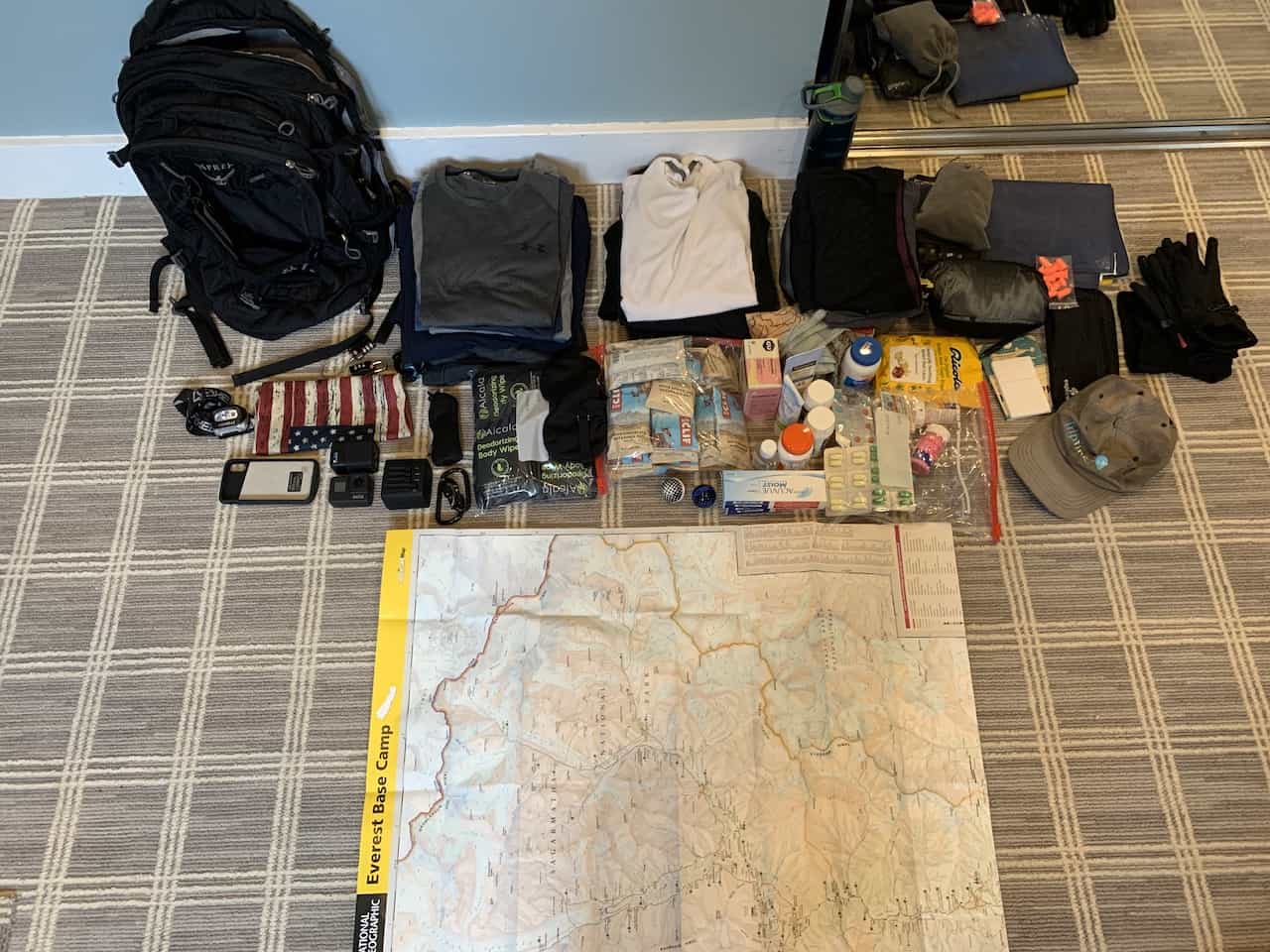
I hope you now have a better understanding of the details behind the Everest Base Camp trek and what to expect along the way. If you do have any questions or comments feel free to write them in below.
» You may also want to read the guide to why November is one of the top months to complete the Everest Base Camp trek .
Also be sure to check out the other Nepal itineraries and guides up on the site. Have fun out there and safe travels!

Related posts:
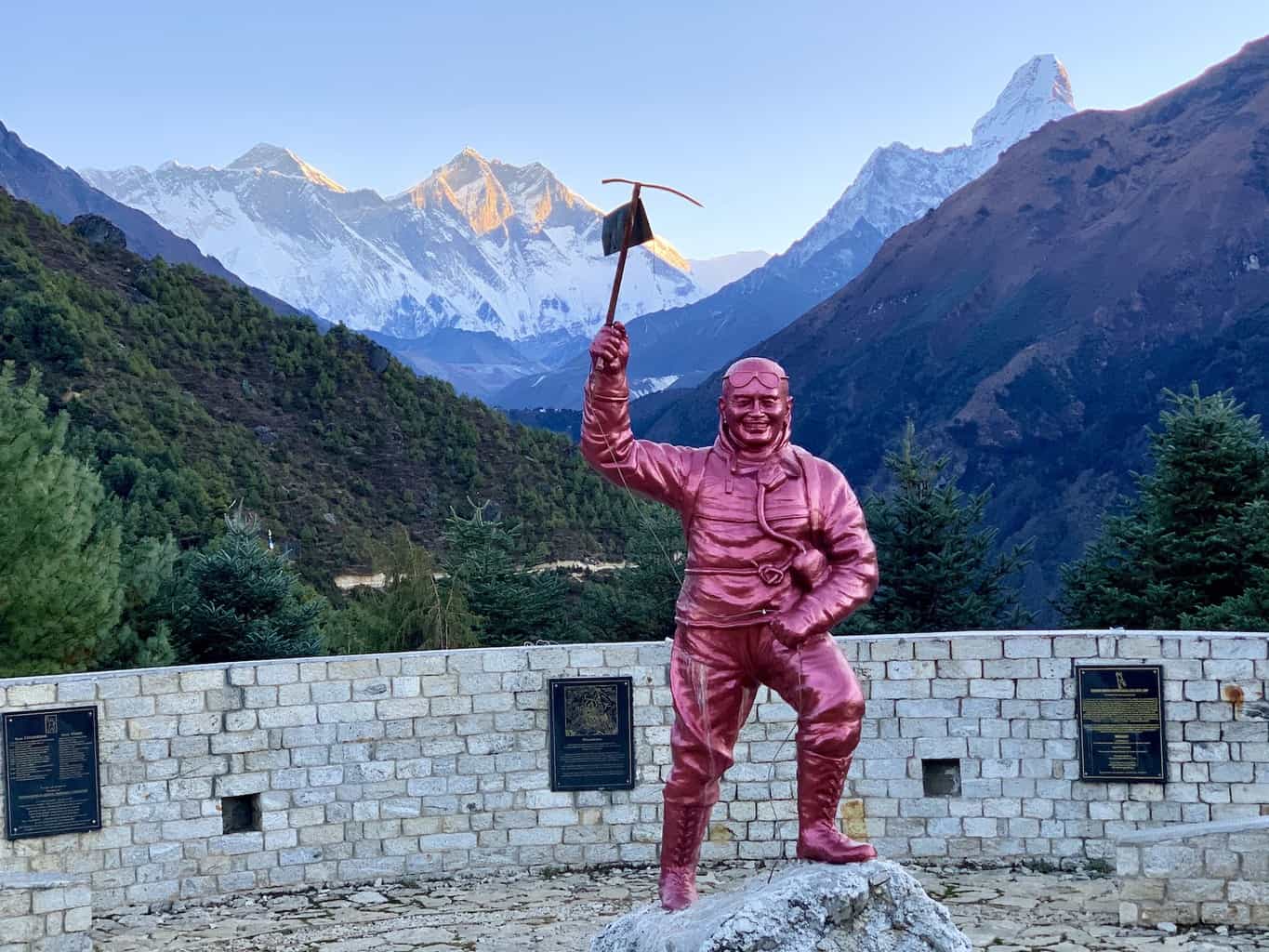
Sharing is caring!
Horizon Rai
Monday 8th of May 2023
What a detailed informations included. Thanks for this article.
Monday 5th of December 2022
Thank you so much for the detailed article.
Himalayan Exploration
Monday 14th of June 2021
It is really worth reading about the total distance of the Everest Base Camp Trek. Seeking more stories in near future too. Thank you so much for your great article.
Pristine Nepal Treks
Explore, Trek, and Experience Nepal's Best

Everest Base Camp Trek Distance: Complete Overview
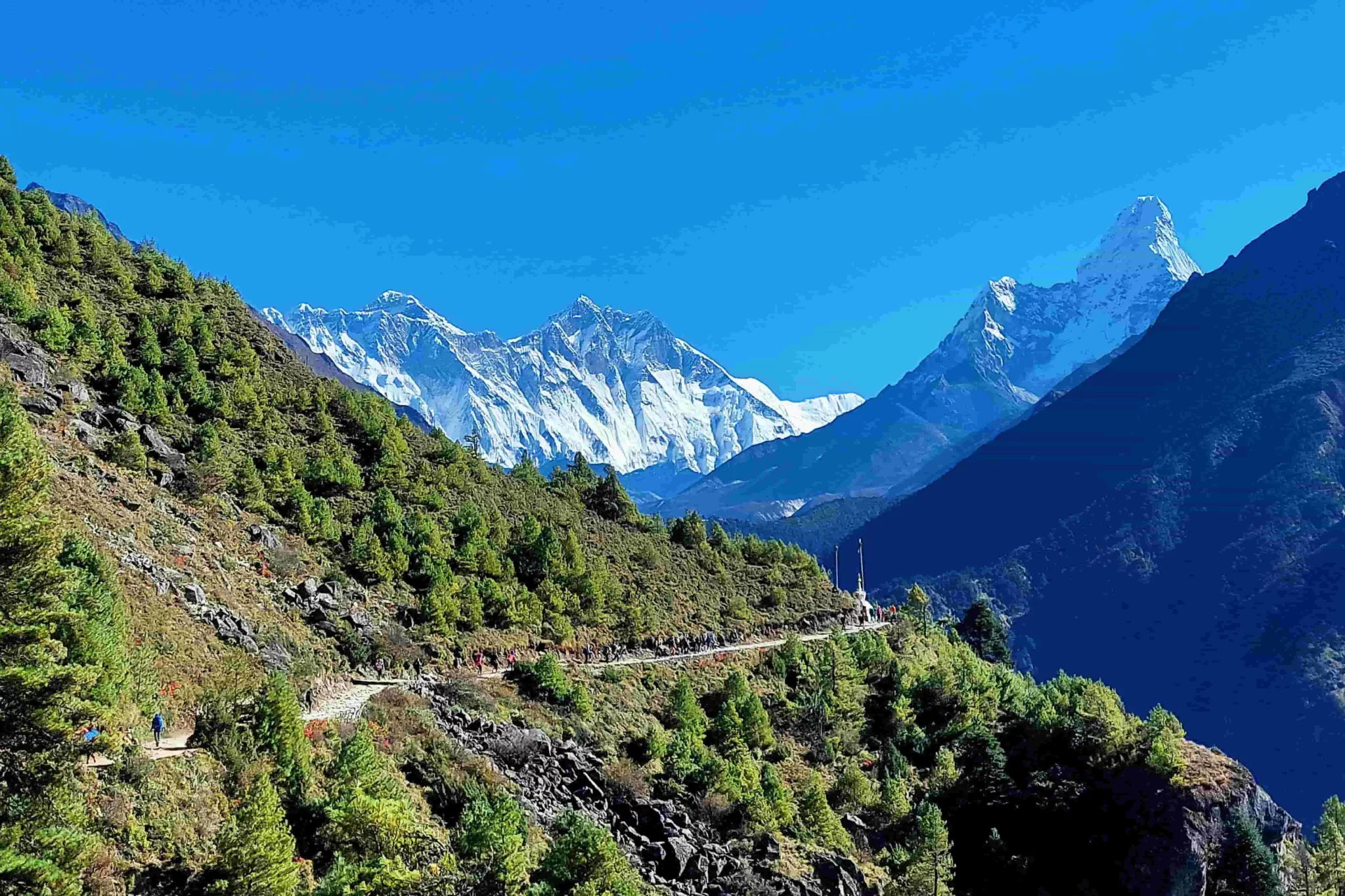
Nestled amidst the towering peaks of the Himalayas, the Everest Base Camp Trek is a mesmerizing adventure that beckons trekkers from around the globe. This iconic journey offers an unparalleled opportunity to witness the awe-inspiring grandeur of Mount Everest, the highest peak on Earth, and immerse oneself in the breathtaking beauty of the surrounding landscapes. As we embark on this exhilarating expedition, we are not only enthralled by the challenge it poses but also captivated by the profound serenity of the remote Himalayan region. The Everest Base Camp Trek Distance is a great curiosity and intriguing topic for trekkers and outdoor enthusiasts planning to take on this remarkable feat. Covering a vast expanse of rugged terrain and diverse ecosystems, this trek is an epic pilgrimage that allows us to trace the footsteps of legendary mountaineers and explorers who have dared to conquer the world’s mightiest summit.
Stretching through the heart of the Khumbu Valley in Nepal, the trek presents an unforgettable odyssey, unveiling the raw magnificence of the Himalayan realm. The trail meanders through ancient Sherpa villages, where traditions and culture have stood the test of time, offering a glimpse into the local way of life. From lush green forests to rocky moraines, cascading rivers to frozen glaciers, the landscape transforms dramatically, unfolding a symphony of natural wonders at every turn.
In this blog, we will delve into the details of the Everest Base Camp Trek Distance, shedding light on the various routes trekkers can take and the average length of the journey. We will also discuss the challenges and rewards that come hand in hand with this extraordinary expedition, as well as essential tips and preparations for a safe and fulfilling trekking experience.
Everest Base Camp Trek Distance
The total Everest Base Camp Trek Distance is 130 Kilometers approx / 81 miles approx. This is based on the standard 12-day itinerary from Lukla to Everest Base Camp to Lukla.
Everest Base Camp Trek Itinerary with Distance
Lukla to Phakding. Distance: 8 km/ 4.9 miles.
Phakding to Namche Bazaar. Distance: 11 km/ 6.8 miles.
Namche Bazaar to Tengboche. Distance: 11 km/ 6.8 miles.
Tengboche to Dingboche. Distance: 10.5 km/ 6.5 miles.
Dingboche to Lobuche. Distance: 9 km/ 5.5 miles.
Lobuche to Gorakshep to Everest Base Camp to Gorakshep. Distance: 12 km/ 7.4 miles.
Gorakshep to Kalapatthar back to Gorakshep. Then continue the trek to Pheriche. Distance: 16 km/ 9.9 miles.
Pheriche to Namche Bazaar. Distance: 19 km/ 11.8 miles.
Namche Bazaar to Lukla. Distance: 19 km/ 11.8 miles.
Note: During this whole trip, you have to walk 4-7 hours every day on average.
Everest Base Camp Trek Route Overview
The Everest Base Camp Trek, a journey that epitomizes adventure and wonder, follows a well-trodden path through the heart of the Khumbu Valley in Nepal. Commencing with a scenic flight from Kathmandu to Lukla, or during peak seasons from Ramechhap’s Manthali Airport, trekkers are introduced to the breathtaking Himalayan landscapes. The first leg of the trek leads to Phakding, a charming village situated along the Dudh Koshi River.
Continuing onward, the route ventures into the renowned Sagarmatha National Park, where trekkers encounter lush forests, majestic waterfalls, and the first of many suspension bridges to be crossed. The trail then ascends steadily to reach Namche Bazaar, a bustling Sherpa town, and a crucial acclimatization point. Here, an acclimatization day allows for exploration of the nearby Syangboche and the enchanting vistas of Char Camp.
The journey continues to Deboche, passing through Tyangboche, home to the region’s oldest and most revered monastery. The spiritual ambiance of Tyangboche is truly captivating. From there, the path leads to Dingboche, offering breathtaking views of Ama Dablam, a stunning Himalayan peak.
To acclimatize further, trekkers take a day’s rest in Dingboche and can opt for a challenging hike to Nangkartshang Peak, standing at an impressive 5,121 meters. As the trek progresses, the landscape transitions into rugged, high-altitude terrain, leading to Lobuche, the last stop before reaching Everest Base Camp.
The anticipation reaches its zenith as trekkers finally set foot on Everest Base Camp via Gorakshep, an exhilarating experience that puts them in the very heart of the world’s tallest peak. A sunrise hike to Kalapathar offers an unparalleled panorama of Everest and its neighboring peaks, making the arduous ascent truly rewarding.
After soaking in the awe-inspiring views, trekkers return to Gorakshep for lunch before making their way back down to Pheriche. The return journey traces the steps back through Dingboche and Namche Bazaar, as the familiarity of the route brings a sense of accomplishment.
As the trek draws to a close, trekkers head back to Lukla, cherishing the memories of their extraordinary expedition to the Everest Base Camp. This remarkable journey has not only allowed them to conquer distances and altitudes but has also offered an opportunity to embrace the majestic beauty and cultural richness of the Khumbu region.
In conclusion, the Everest Base Camp Trek Route encompasses a series of challenging yet exhilarating stages, each unfolding a new facet of the Himalayan grandeur. As trekkers traverse these rugged terrains and immerse themselves in the soul-stirring vistas, they embark on an unforgettable quest that leaves an indelible mark on their hearts and minds.
Day-to-Day Everest Base Camp Trek Distance
In the Day-to-Day Everest Base Camp Trek Distance section, we will provide a detailed breakdown of the trekking distances covered each day, allowing trekkers to plan their journey efficiently. From the starting point in Lukla, the trail’s daily distances will be outlined, including the notable landmarks and villages along the way. By the end of the trek, we will reveal the total distance traveled, providing a comprehensive overview of the entire expedition.
Additionally, we will estimate the approximate time it takes to complete the trek, considering various factors such as altitude, acclimatization days, and individual pace. With this invaluable information, trekkers can prepare both physically and mentally, ensuring a successful and fulfilling Everest Base Camp Trek experience.

Additional Kathmandu to Lukla Flight Distance Information
KTM – LUK: 135 KM
Time: 30 mins
Note: During the peak season in the month of March, April, October, and November, Lukla flights are carried from the Ramechhap Manthali Airport.
KTM – Ramechhap Road Distance: 131 KM approx.
Time: 4/5 hours by private transportation
Ramechhap – Lukla: 74KM
Time: 20 mins
Alternative Everest Base Camp Trek Routes and Side Treks
For trekkers seeking a more diverse experience, there are alternative Everest Base Camp trek routes and side treks to explore. One option is the Gokyo Lakes Trek , which diverges from the main trail at Namche Bazaar and leads to the serene turquoise Gokyo Lakes, offering stunning views of Cho Oyu , the world’s sixth-highest peak. Another alternative is the Three Passes Trek , a challenging route that crosses three high mountain passes—Kongma La, Cho La, and Renjo La—providing an immersive journey through remote landscapes and lesser-visited regions.
Suggested Itineraries for Various Durations
Standard Itinerary (14-16 days): The standard itinerary includes ample acclimatization days at Namche Bazaar and Dingboche, allowing for a safer ascent. Trekkers visit Tengboche, Dingboche, and Lobuche before reaching Everest Base Camp and returning to Lukla.
Extended Itinerary (18-20 days): For those seeking a more relaxed pace and side treks, this itinerary includes the Gokyo Lakes Trek. Trekkers venture to Gokyo, cross Cho La Pass, and merge with the main route to reach Everest Base Camp. The return journey includes an ascent of Kala Patthar for sunrise views before heading back to Lukla.
Three Passes Trek Itinerary (19-21 days): This challenging itinerary takes trekkers on a thrilling adventure across the three high passes—Kongma La, Cho La, and Renjo La. Along the way, they visit the Gokyo Lakes and Everest Base Camp, experiencing a more off-the-beaten-path exploration of the Khumbu region.
Gokyo + Cho La Pass + Everest Base Camp Trek Distance
Everest Three High Passes Trek Distance
Everest Base Camp Trek Distance: Factors to Consider
Altitude and Terrain Impact
The altitude gain and the challenging terrain can influence the Everest Base Camp distances covered each day. As trekkers ascend to higher altitudes, the pace may naturally slow down due to reduced oxygen levels and the body adjusting to the harsher conditions. Additionally, some segments of the trek might require shorter distances to ensure a gradual ascent and proper acclimatization. The inclusion of acclimatization days provides trekkers with a chance to rest and acclimate, impacting the overall trekking distance and duration.
To mitigate the impact of altitude and terrain, trekkers are advised to maintain a steady pace, stay well-hydrated, and listen to their bodies. The trekking itinerary is thoughtfully designed to allow for proper acclimatization, reducing the risk of altitude sickness and ensuring a more enjoyable experience. Trekking in the company of experienced guides also provides valuable support and guidance, making it easier for trekkers to navigate the challenges posed by the Himalayan environment.
Acclimatization
Acclimatization days are pivotal in the Everest Base Camp Trek, profoundly impacting the overall distance covered. By allowing trekkers’ bodies to adapt gradually to the increasing altitude, these essential rest days help prevent altitude sickness and reduce health risks associated with higher elevations. The physical endurance of trekkers is enhanced as muscles recover and energy levels replenish during these much-needed breaks.
Additionally, acclimatization days offer an opportunity for exploration, allowing trekkers to venture to higher altitudes and witness breathtaking views of the Himalayan peaks. By fostering self-awareness about their bodies’ response to altitude-related challenges, trekkers can make informed decisions, ensuring a steady and safe ascent toward Everest Base Camp.
FAQs Regarding the Everest Base Camp Trek Distance
How long is the Everest Base Camp Trek?
The total distance covered during the Everest Base Camp Trek is approximately 130 kilometers (around 80 miles). This distance includes the trek from Lukla to Everest Base Camp and back to Lukla, as well as the side treks and acclimatization days at Namche Bazaar and Dingboche.
How many days does it take to complete the Everest Base Camp Trek?
The duration of the Everest Base Camp Trek varies depending on the chosen itinerary. The standard trek typically takes around 14-16 days, including acclimatization days. However, trekkers can opt for shorter itineraries of 10-12 days or longer ones spanning 18-20 days or more, incorporating side treks to Gokyo Lakes or the Three Passes.
What is the daily trekking distance during the Everest Base Camp Trek?
On average, trekkers cover around 10-15 kilometers per day during the Everest Base Camp Trek. However, the daily distance varies depending on the specific itinerary and altitude gain. Some days might involve longer distances, while others, especially during acclimatization periods, may have shorter hikes.
How difficult is the Everest Base Camp Trek route?
The Everest Base Camp Trek route is challenging due to the rugged terrain, steep ascents and descents, and high altitude. However, with proper preparation and acclimatization, it is achievable for trekkers with determination and a positive mindset.
(1) Comment
Thank you for providing such outstanding and comprehensive information.
Leave a Reply Cancel reply
You must be logged in to post a comment.
Main Navigation
Annapurna region.
- Mardi Himal Trek
- Annapurna Base Camp Trek
- Annapurna Circuit Trek
- Annapurna Panorama Trek
- Poon Hill Sunrise Trek
- Annapurna Sanctuary Trek
- Nar Phu Valley Trek
- Poon Hill Trek
- Annapurna Sunrise Trek
- Ghorepani Poon Hill Trek
- Ghorepani Ghandruk Loop Trek
- 4 Days Poon Hill Trek
- Annapurna Short Trek
- Poon Hill Annapurna Base Camp Trek
- Poon Hill Trekking package
- Short Mardi Himal Trek
- 5 days Annapurna Base Camp Trek
- 6 Days Annapurna Base Camp Trek
- 10 Days Poon Hill Annapurna Base Camp Trek
Everest Region Trek
- EBC Helicopter Tour with Landing - 1 Day
- Luxury EBC Trek with Helicopter Return - 5 Days
- EBC Trek with Helicopter Return - 10 Days
- Short Everest Base Camp Trek - 11 Days
- Short Classic Everest Base Camp Trek - 12 Days
- Classic Everest Base Camp Trek - 14 Days
- Everest Base Camp Luxury Trek - 14 Days
- Gokyo Lakes Trek -14 Days
- Short Comfort EBC Trek -13 Days
- Comfort Everest Base Camp Trek - 15 Days
- Gokyo Renjo La Pass Trek - 15 Days
- Gokyo Cho La Pass EBC Trek - 18 Days
- Everest Three High Pass Trek - 19 days
Manaslu Region Trek
- Short Manaslu Circuit Trek
- Tsum Valley Trekking
- Rupina La Manaslu Circuit Trek
- Manaslu Tsum Valley Trek
- Manaslu Trek
Langtang Region Trek
- Langtang Helambu Trek
- Tamang Heritage Trek
- Langtang Easy Trek
- Langtang Trekking
- Langtang Ganja La Pass Trek
- Langtang Gosainkunda Circuit Trek
- Gosainkunda Helambu Trek
Dolpo Region Trek
- Beni - Lower Dolpo Trek
- Upper Dolpo Trek
- Lower Dolpo Trek
Eastern Region
- Complete Everest Base Camp Trek Package
- Rolwaling Trek
- Makalu Base Camp Trekking
Newly Open Trekking
Kanchenjunga region trekking.
- Kanchenjunga Base Camp Trek
- Kanchenjunga Circuit Trek
- Everest Base Camp Helicopter Flight Tour with Landing
- Kathmandu - Pokhara Tour
- Nepal Overland Tour
- Nepal Trekking Tour
- Nepal Trekking with Jungle Safari Tour
- Nepal Cultural Tour
- Nepal Tour with Kids
- Kathmandu-Pokhara-Chitwan-Nagarkot Hiking Tour
Peak Climbing
- Island Peak Climbing
- Mera Peak Climbing
- Lobuche Peak Climbing
- Yala Peak Climbing
- Chulu West Peak Climbing
- Naya Kanga Peak Climbing
- Pisang Peak Climbing
- Shivapuri Nagarkot Trek
- Nagarkot Dhulikhel Namobuddha Trek
- Pokhara Sarangkot Trek
- Hiking and Meditation trip in Nepal
- Annapurna Skyline Trek
- Kathmandu City Sightseeing Tour
- Namo Buddha Day Hiking Tour
- Bhaktapur Half Day Tour
- Nagarkot Sunrise Day Tour
- Nagarkot Sunset Day Tour
- Nagarkot Day Hiking Tour
- Chandragiri Hill Half Day Tour .
- Boudha-Pashupati-Bhaktapur Full Day Tour
- Bhutan Spiritual Tour
- Bhutan Cultural Tour
- Bhutan Short Spiritual Tour
- Tibet Overland Tour
- Kailash Manasarovar Yatra
- Tibet Shangrila Tour
- Tibet Special Tour
- Tibet Introductory Tour
- Lhasa Everest Base Camp Tour
- Simikot Kailash Lhasa Tour
- Simikot Kailash Zhangmu Tour
- +9779851082484

How long is the trek from Lukla to Everest Base Camp?
As Everest Base Camp Trek is getting popular day by day, MMT has customized numerous EBC Packages to satisfy the appetite of the keen trekkers. The itinerary of the Everest Base Camp trek depends upon the package you prefer; so we can’t tell exactly how long is the trek from Lukla to Everest Base Camp or how many days does it take to complete the EBC Trek. Normally, EBC Trek is of 11 – 22 days trek from/to Kathmandu – Lukla – EBC – Lukla – Kathmandu .
Table of Contents
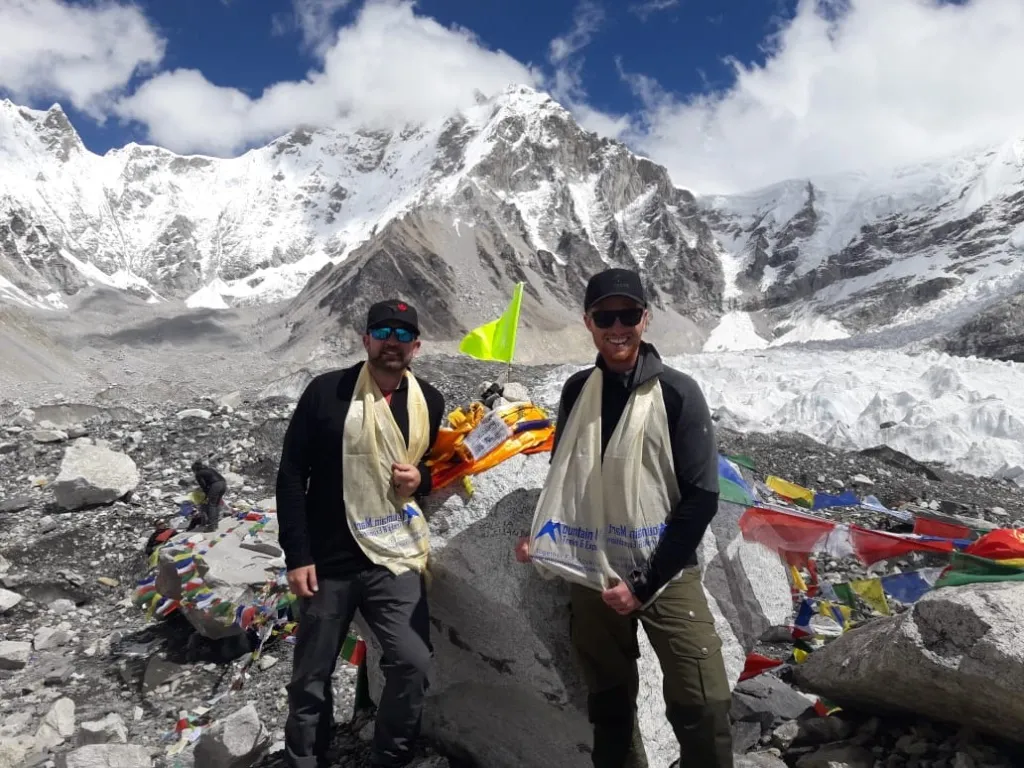
The most preferred Classic Everest Base Camp Trek is 15 days trek in which the 1 st day is arrival plus trek briefing day, and the second day is Kathmandu city excursion day. Our trek from Lukla usually commences on the 3 rd day after landing at Lukla from scenic mountain flight from Kathmandu.
The approximate one-way distance from Lukla to Everest Base Camp is 60 – 65 km. With an average walk of 8-9 hours a day, physically fit trekkers can accomplish the single way distance in 7-8 days including 2 days of acclimatization. The duration of the trek may vary from one trek to another depending upon the inclusion of acclimatization days in itinerary or not.
The Short Everest Base Camp Trek has only one day of acclimatization so we can reach at EBC in 6-7 days with an average walk of 9-10 hours a day. In total 11 days of the trek, we reach at EBC on day 7 and return back to Kathmandu on day 10.
The distance from Lukla to Everest Base Camp can be easily covered by any physically fit trekkers with proper acclimatization and healthy habits.
Classic Everest Base Camp Trek itinerary: Lukla to Everest Base Camp
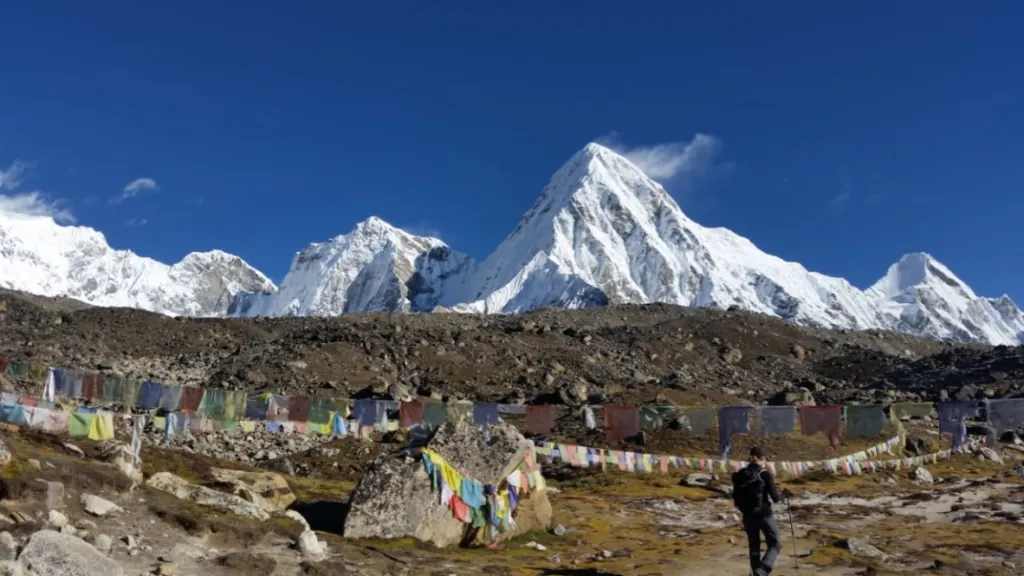
- Day 1: Arrival in Kathmandu:
- Day 2: City Excursion and Trek Preparation:
- Day 3: Kathmandu to Lukla (30-40 min) and trek to Phakding (3-4hrs):
- Day 4: Phakding to Namche: 10-12 km (6-7 hours):
- Day 5: Acclimatization and exploration day at Namche:
- Day 6: Namche to Tengboche:8-9 km (5-6 hours)
- Day 7: Tengboche to Dingboche: 10 km (6-7 hours)
- Day 8: Acclimatization day at Dingboche:
- Day 9: Dingboche to Lobuche: 7km (5-6 hours)
- Day 10: Lobuche to Gorakshep to EBC to Gorakshep: 15km (8-10 hours)
- Day 11: Gorakshep to Kala Patthar to Gorakshep to Pheriche: 15km (8-10 hours)
- Day 12: Pheriche to Namche: 14-15km (7-8 hours)
- Day 13: Namche to Lukla: 15-16km (7-8 hours)
- Day 14: Lukla to Kathmandu on flight: (30-40 minutes)
- Day 15: Departure day:
Is the trail from Lukla to EBC difficult?
There are numerous trails from Lukla to Everest Base Camp; so the difficulty level of the trail depends upon which trail we prefer. From Lukla to Everest Base Camp, the trails are uphill-downhill and straight; we also need to cross the suspension bridges, icy glaciers; walk through the ridges, narrow cliffs, and moraine boulder to reach at EBC.
The Everest Base Camp Trek is moderate to strenuous in which trekkers have to walk for 8-9 hours per day on an average. To adjust the thin air and to make the trek even easier, agencies add few days of acclimatization in their itinerary. With proper precautions and guides’ guidance, the trails can be easily traced by the trekkers with average physical fitness. Especially, we suggest the trekkers follow the main trekking trail as marked in the map or preferred by the guides.
Is there any alternative route to EBC than Lukla?
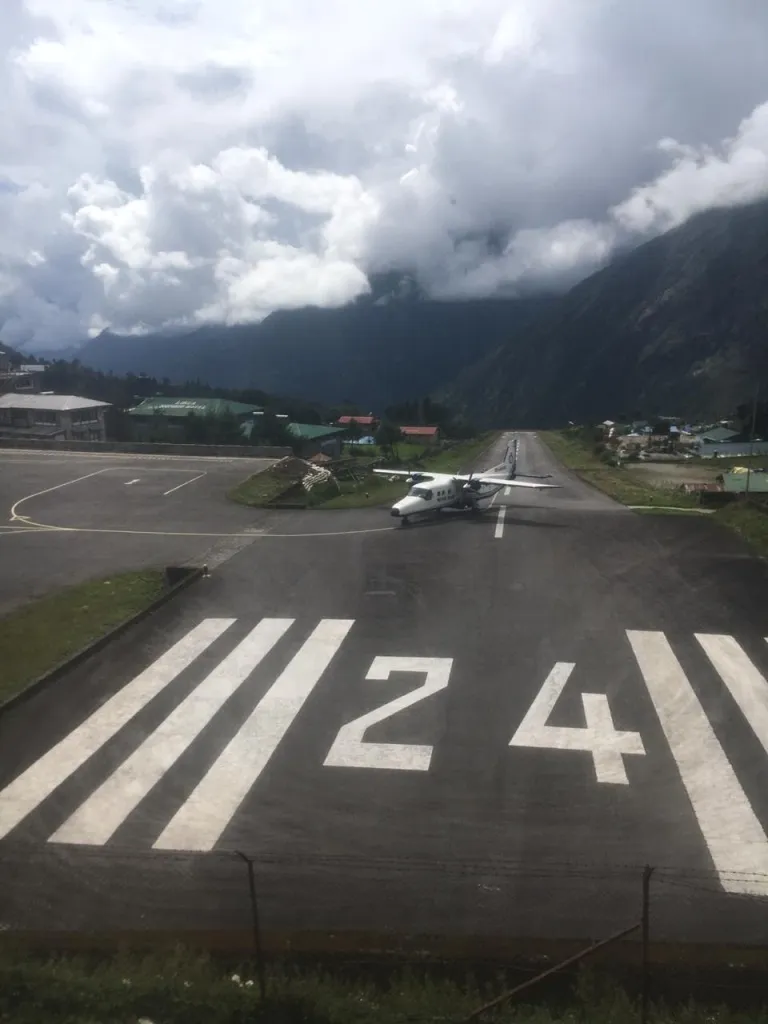
One of the easiest, fastest and widely used routes is flying to lukla from Kathmandu and then trek to EBC. The Kathmandu to Lukla flight expensive as well as thrilling; therefore few trekkers prefer the alternative route to reach at EBC.
Jiri – Everest Base Camp Trek is the only alternative route to avoid expensive and turbulent mountain flights. In this trek, we drive for 6-7 hours from Kathmandu to Jiri/Phaplu from where the normal trek begins. In this trek also, we have to walk through Lukla to trek in Khumjung Valley.
Lukla is the gateway to Everest. Almost every trekking trail of Everest Base Camp including Gokyo Lake Trek traces through Lukla; therefore Lukla is the transit point from where every EBC Trek.
How easy or difficult is EBC Trek?
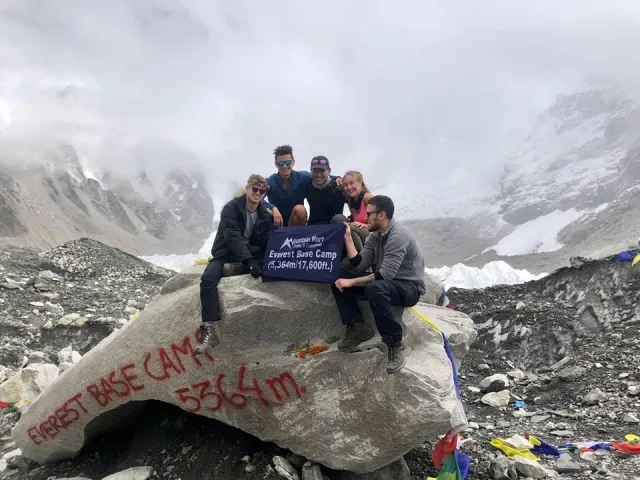
Everest Base Camp Trek is well managed and well inspected by TAAN and NTB. Trekking in the Everest Region is always awe-inspiring, easy and safe; but due to negligence of the trekkers, AMS can be the major threat in EBC Trek.
In Everest Three Pass Trek , the trekkers need to cross the three highest passes of the Everest region which can make the trek risky and tough. The trekkers need to be more careful while ascending or descending through the rocky path, icy glacier, cliff, and ridges.
The weather in the higher elevation is unpredictable; even the best trekking seasons like autumn and spring couldn’t be reliable. In the off seasons like summer and winter, the continuous heavy rainfall and snowfall make the trail slippery which makes the trek difficult.
The misty weather condition can sometimes delay or cancel the flight; if trekkers have a tight schedule then there will be a problem to accomplish the trek and to return back home on departure date.
.webp)
Almost every EBC Trek commences from Lukla after short and scenic mountain flight from Kathmandu. The distance of 120-130 km from Lukla – EBC – Lukla can easily be trekked by the trekkers of average physical stamina. While trekking in the higher altitude, trekkers must walk in pace and stay in lower region to avoid any risk of AMS.
The trail from Lukla to EBC is also moderate to strenuous. Except for some trek, most of the treks have moderate trails which can be traced without any use of gears. In Gokyo – Cho La – Everest Base Camp Trek trekkers need to cross high pass as well as icy boulder trail; therefore some alertness is required throughout the trek.
The Everest Region Trek is an amalgamation of pain and pleasure which remains in the memory of every trekker. Trail from Lukla to EBC is short, easy and comfy yet some preventive measures must be taken on time; otherwise, the awful experience always haunts you in life.
Please, feel free and contact us for any queries and confusions regarding trekking and touring in Nepal, Tibet, and Bhutan . MMT is always at your service. We wish you have a happy life!
Other Categories
- Travel Information
Recent Posts
- Manaslu Circuit vs Annapurna Circuit Trek - Which is Best?
- Tips For Annapurna Trekking Packages
- Everest Base Camp Trek vs. Annapurna Base Camp Trek: A Comprehensive Comparison
- Luxury Lodge vs Normal Lodge Trek
- Langtang Valley Trekking
- How Much Does the Langtang Valley Trek Cost?
- Know Before Hiking Poon Hill: The Ultimate Poon Hill Trek Guide
- Everest Trekking Package for 2024/2025
- Top 7 Reasons: Why Everest Base Camp Trek is Popular Today?
- Where is Nepal located on the World Map? - Nepal Facts
- Where is Mount Everest Located?
- Where is Location of Mount Everest in the World Map?
- What is the death rate on Everest? [2023/24 Updated]
- What is Everest Base Camp Trek? - Our Top Tips for your EBC Trek 2022/23/24
- Trekking in Nepal in September - Is September a Good time to visit Nepal 2022/23/24?
Recommended - Boutique Hotel in Thamel, Kathmandu
Charming Newari Heritage Hotel in central Kathmandu, with a rooftop restaurant for stunning valley views.

We are associated with
Acceptable payments.
Find & Follow Us on
© 2011 - 2024 All rights reserved. Mountain Mart Treks & Expedition. Developed By: Xenatech Nepal .
Notice. This site uses cookies to optimize your user experience. By using this site, you are consenting to our use of these cookies. Check out our Privacy Policy and our Cookies Policy.
- [email protected]
- +977 9841161593
- +977 9851149890

- You are here:
- Trekking and Hiking
Everest Base Camp Trek Distance Length and Elevation Guide
a journey to the highest base camp on earth......
- Updated on Jun 12, 2024
There is no doubt about the popularity of Everest Base Camp Trek ( 15-Day ) which has always been rated among the top ten destinations for trekkers around the globe. Now, the question is why travelers prefer to hike to Everest despite its difficulty. A very simple answer will be due to its diversity of nature and culture and the pristine environment makes Everest Trek, once in a lifetime experience.
Table of Contents
The entire region of Everest also known as the Khumbu Region is one of the UNESCO heritage situated at the highest altitude. This region also is the highest settlement area of the world mainly inhabited by the Sherpas people, who are the born mountaineers.
Without entering further into the unrelated topic which I have included in my other blogs. Let’s talk about the distance for the Everest Base Camp Trek ( 9-Day )

Trekking to Everest Base Camp ( 16-Day ) is a strenuous climb uphill but is accessible and doable to accomplish the target if some minor requirements are fulfilled (this is mainly recommended for those trekkers who are first at such an altitude and are layman-related to Himalayan treks). Below are multiple options for Everest Trek.
Now dragging myself towards my intention of this blog. To speak there are two different trails to follow to Everest Base Camp. Among them, one is the oldest route which was followed by the first expedition team of Sir Edmund Hillary in 1953, and is also the longest route to EVEREST BASE CAMP .
Let’s talk about both the Everest Base Camp Trekking ( 13-Day ) trekking route separately and how it goes, along with all the detailed information:
- Trek to Everest Base Camp via Lukla
- Trek to Everest Base Camp via Jiri
Now let’s deal separately with the distance, altitude, and route of both trails taking us to the same point of Everest Base Camp.
Trek to Everest Base Camp Via Lukla
Trekking to Everest Base Camp through Lukla is the shortest way to the highest base camp on earth. Here you can enjoy a short scenic flight from Kathmandu airport to Lukla airport which is just around a 30-minute flight and can hike to Phakding on the very same day.
This will reduce your 7 days via Jiri which is just a one-way hike uphill. On the other hand, you can spend two extra nights for acclimatization while ascending the Everest Base Camp. This makes the trek shorter, easier, less time-consuming, and also budget and affordable.
Further, descending downhill you can take a short flight back to Kathmandu Airport through Lukla Airport . This two-way hike to EBC is just 130 km (80 miles), which is to be completed in 9 days with 2 additional days for acclimatizations. Thus, making the entire trip an 11-day hike from Lukla to Lukla.
But an extra day is required to take a flight back to Kathmandu airport early in the morning. Let’s see how the Itinerary for the Everest Trek Via Lukla goes:
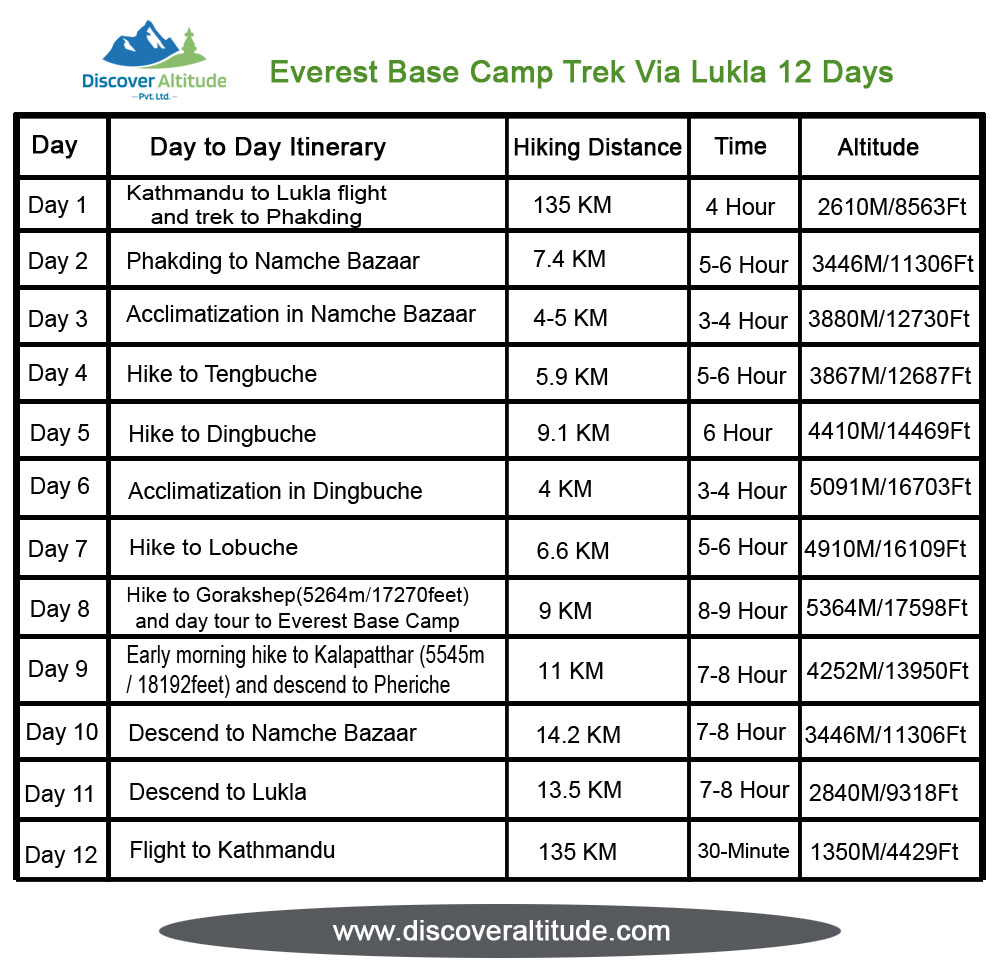
- The above-mentioned flight distance is the aerial distance between the overnight camp but the overall distance for the Everest Base Camp trek including the short hike during the acclimatization day will be 130 km which is the distance to be trekked during the trip ascending uphill and descending all the way downhill, keeping the measuring point as Lukla airport.
Trek to Everest Base Camp Via Jiri
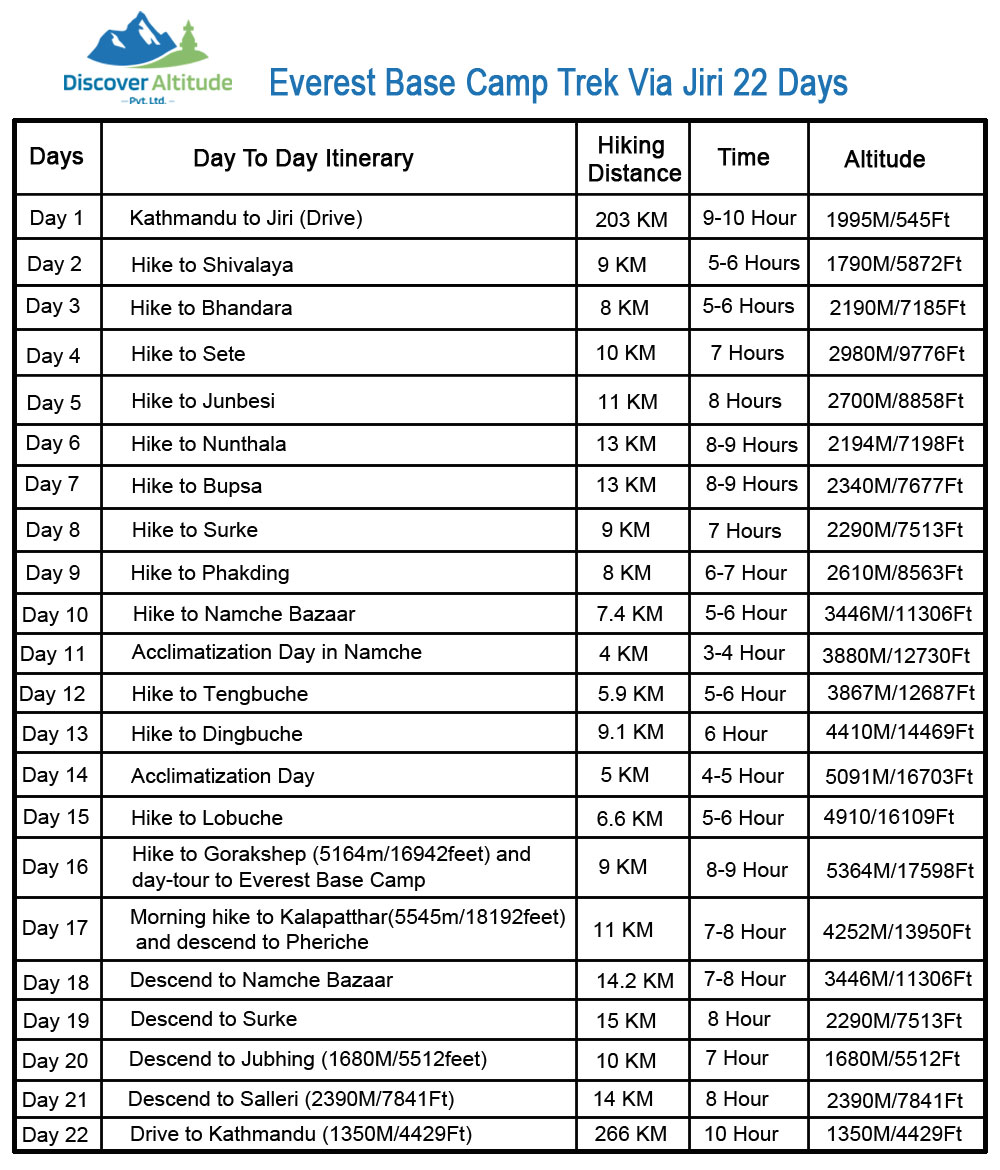
This trail to Everest Base Camp is one of the first but longest trails to Everest. The popularity of the Jiri trail was highlighted in 1953 when Sir Edmund Hillary and Tenzing Norgay Sherpa first summited to the top.
This dual accomplishment led the world to recognize Mt. Everest as the highest mountain and can be submitted, also brought a glimpse of the possibility for others to keep a record.
As I have already mentioned Everest Base Camp trek from Jiri is the longest route but is shorter than the first climbers used to hike all to the summit point. This is so because now trekkers can drive to Jiri from Kathmandu which was not possible some decades ago.
Although it is shorter than used to be, still it is a longer trail than the other short trail to Everest. If you are planning to trek from Jiri to Everest Base Camp and descend to Kathmandu without a flight option, then the entire trip from Jiri to Kathmandu will be of 22-25 days depending upon the route you follow.
For many trekkers, it might be difficult to arrange a long holiday for the Everest Trek ( 10-Day ) but few do to date follow the Hillary trail to Everest. Now, let’s see how the Itinerary for the Everest Trek Via Jiri goes:
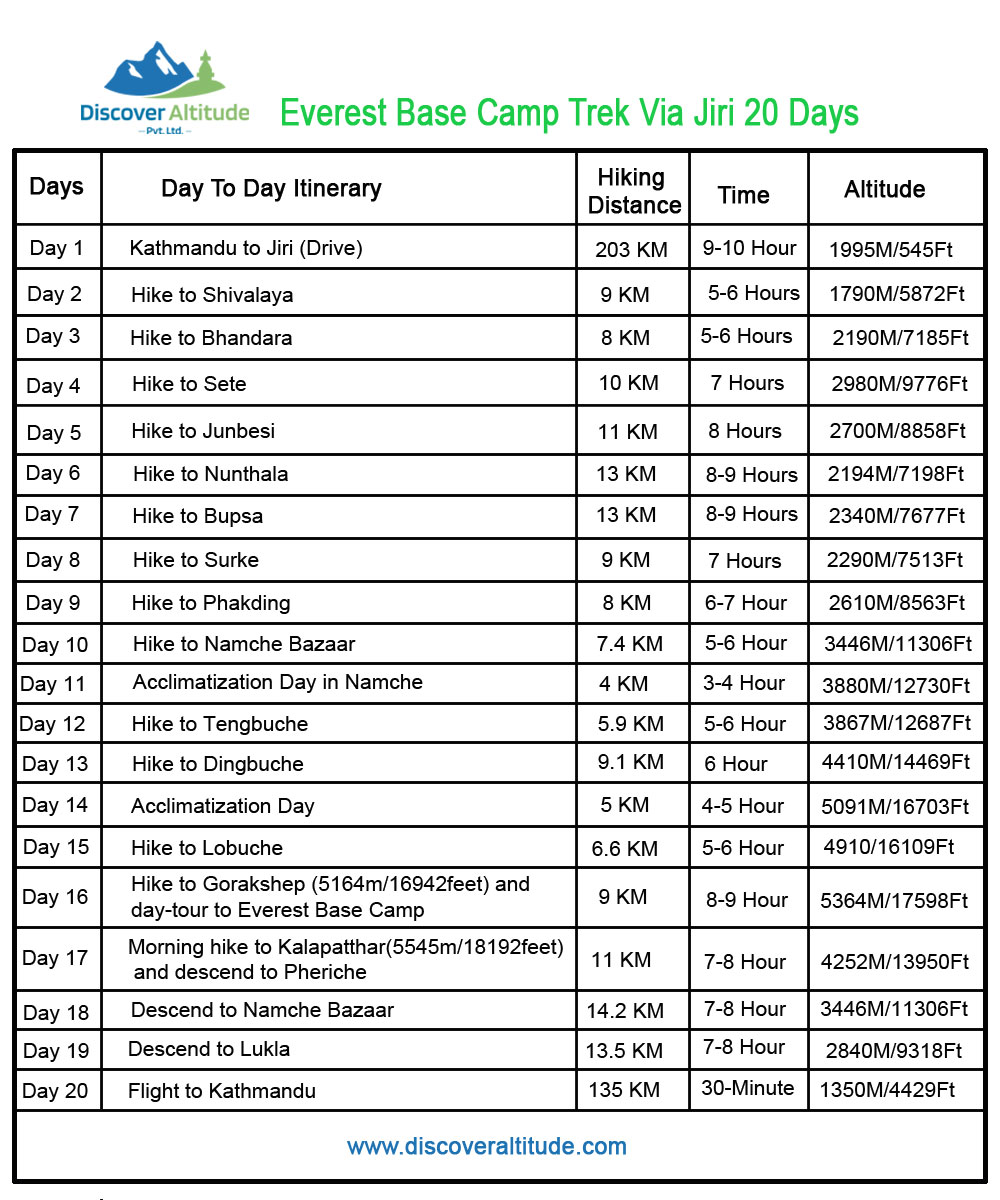
Still, you are desperate to trek Everest Base Camp Via Jiri which is the oldest route as well but worried about arranging a long vacation. Relax I will help you with how to make this route shorter. This Everest Base Camp Trek Via Jiri can be customized into a 20-day trek from Kathmandu to Kathmandu. For this, we need to thank Lukla Airport. Let’s see how this Itinerary goes:
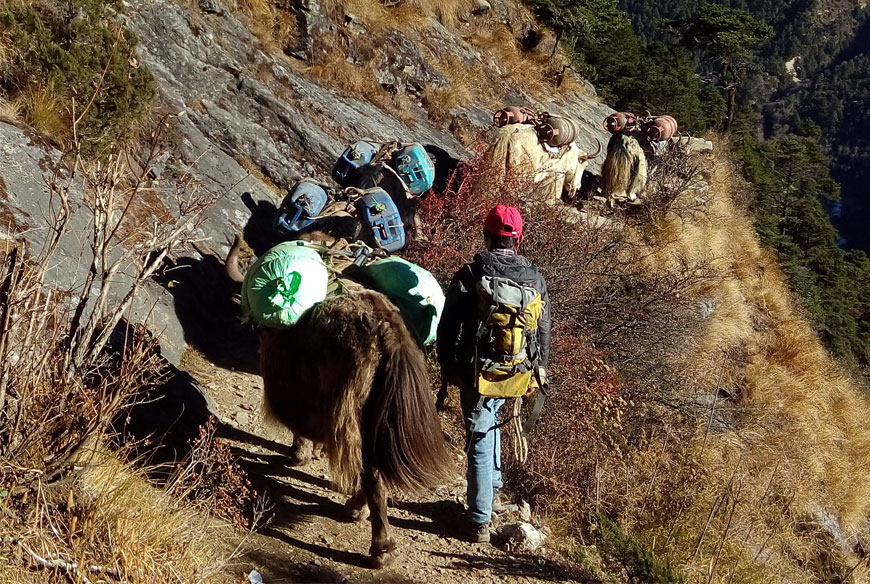
Which is the best and easy way to hike Everest Base Camp Trek
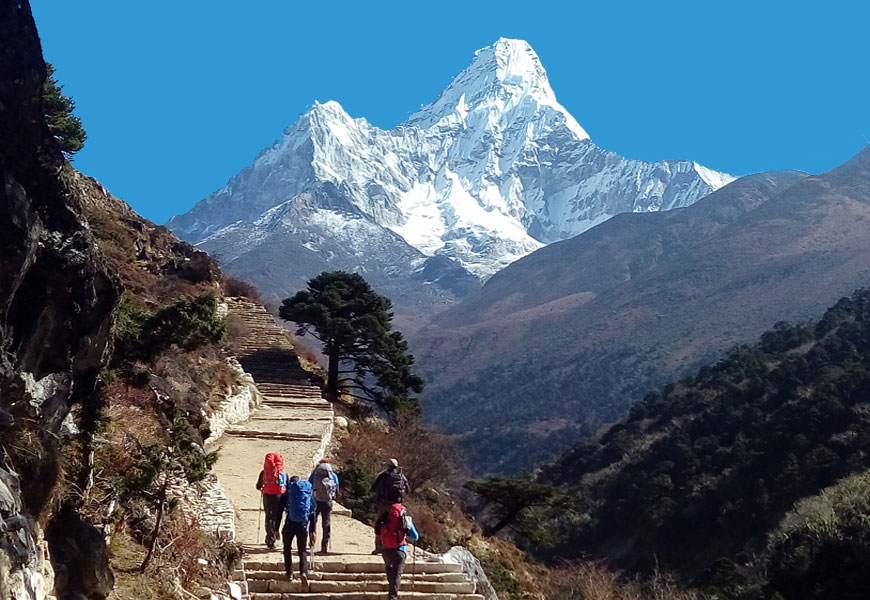
Although there are two different ways to hike all the way to Everest Base Camp (through Jiri and Lukla) the most popular date trail is no doubt the Lukla trail. Hiking all the way to Everest Base Camp is a challenging task due to its altitude and time consuming but the beauty of the trial is mesmerizing.
Despite its difficulty, the Everest Base Camp trail is gaining popularity all around the world. This is also because now you can customize the trail to just a 12-day hike from Kathmandu to Everest Base Camp and all the way back to Kathmandu.
Everest Base Camp trek can be shortened when you take a domestic flight to Lukla Airport from Kathmandu. This minimizes the 135km distance in just 30-minute and when we do the same while descending it minimizes our 135km more in just the same 30 minutes, which means in just an hour we will be able to cover 270km.
Upon landing at the Lukla airport, our real adventure to Everest begins all the way through the low alpine into the high Himalayas taking us to the highest altitude of 5545 meters at Kalapatthar and 5364 meters at the base camp of Mt. Everest.
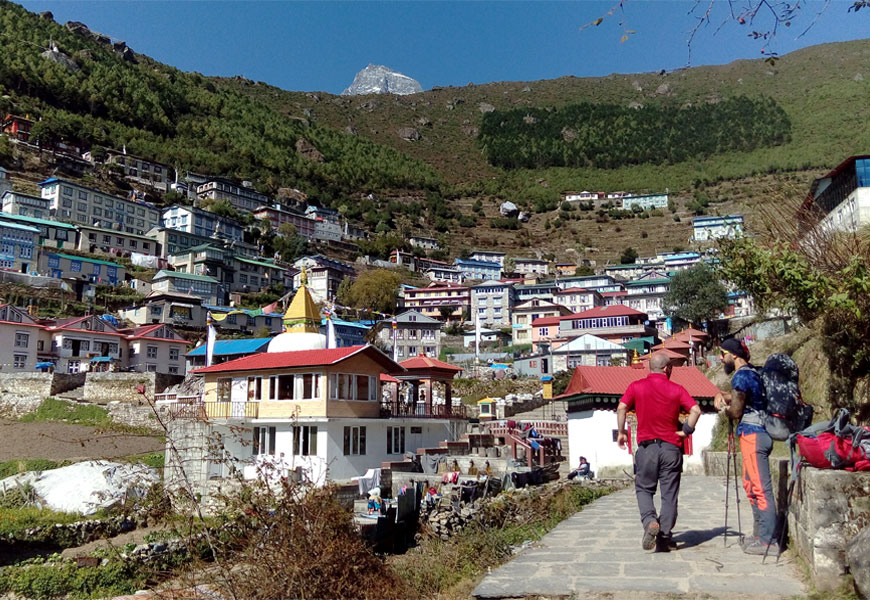
Hiking through Lukla will reduce your required number of days for the trek along with the cost. This route is popular and also affordable for any trekkers, making one accomplish their dream of being at the base of the highest mountain on earth.
On the other hand, if you follow the old route to Everest Base Camp which is through Jiri or Salleri. This will take not less than 22-25 days to complete the trial, avoiding the flight (both ways). As the number of days increases the cost of the trip also does and driving all the way to Jiri or Salleri is also not an easy drive, it takes around 10-11 hours to reach the starting point of the trek off-road.
Now, to share my experience without any doubt I will recommend Everest Base Camp Trek Via Lukla which is affordable, and less time-consuming with scenic flights of the Himalayas.
For more information WhatsApp: +977-9841161593 or Email: [email protected]

Kumar Lamsal
Kumar is one of the Co-founders and Managing directors of Discover Altitude holding 18 years of experience in the tourism sector of Nepal. He has trekked to almost all the popular regions of Nepal and is an authorized trekking and tour guide.
Started his career as a porter to support his study, now holds MPhil and LLB degree, and is doing his Ph.D. in religious studies. He loves traveling to the Himalayas and has deep knowledge about religion, culture, and history.
Kumar is also involved in the teaching sector as a part-timer to deliver his research related to the cultural and religious diversity of Nepal and is the one who mostly answers your queries giving them his personal touch through his decade-long experience.
Send us your feedback
Recent posts.
- Annapurna Circuit Trek Distance and Altitude Profile with Day to Day Itinerary
- Everest Base Camp Trek for Indian Citizens Cost and Itinerary
- Ghorepani Poonhill Trek Distance, Elevation and Weather
- Everest Base Camp Trek in February 2024-2025
- Everest Base Camp Trek Altitude With Oxygen Level | Know your minimum Oxygen Level during EBC Trek
- Hire a Trekking Guide and Porter in Nepal | Guide and Porter Cost 2024-2025
Related Posts
- Nepal Trekking Company and Tour Operator
- A Complete Visa Guide to Nepal and Fees
- Muktinath Darshan Tour Package for Indian Citizens
- Lukla Airport: A gate-way to Everest region in a fastest way
- When and where will Mount Everest Base Camp be shifted | Nepal to Relocate Everest Base Camp
- Best 10 Luxury Tours and Holiday Package in Nepal
- Festivals in Nepal
- News and Events
- Places to See
We use cookies to ensure that we give you the best experience on our website.
Regd. No: 175840/074/075, Tourism License No: 2432

Run and Managed by:
Local tourism experts & sherpas of nepal.

- Everest Base Camp Trip
Everest Base Camp Trek without flight to Lukla (By Road)
- Trip Overview
Everest Base Camp Trek by drive, without a flight to Lukla, is the most reliable route to visit Everest Base Camp (EBC). In Nepal, there are a couple of routes to visit the base camp of Mount Everest. Many people start Everest trekking from Lukla after flying from Kathmandu to Lukla. But, the Lukla route often gets disturbed by the irregularities of flight due to the weather. In any bad weather condition, the Lukla flight has a high degree of cancellation possibilities and it causes a great headache to every trekker. To be safe from this problem, Excellent Himalaya Trek and Expedition has introduced a new program of Everest Base Camp Trek by the drive.
Everest Base Camp Trek by the drive is safe and more scenic than the traditional route that starts from Lukla. There are some advantages also following the driving route. In this route, you start trekking from the lowland ‘Salleri’ and then pass through villages of various tribes like Sherpa, Brahmins, Chhetris, and Rai to enter the alpine zone. Thus you will have plenty of time to be acclimatized to the mountain environment. Consequently, you will not get much more suffer from altitude sickness. The people who start the EBC trek from Lukla are often suffering from altitude sickness.
Further, some people feel fear of flying to Lukla as it is considered one of the most dangerous airports in the world. If you follow the route of Everest Base Camp Trek by drive you will avoid your mental problem of the Lukla flight.
Moreover, the trail of the EBC trek by the drive is more diversified. In the conventional Lukla to EBC trek, you have nothing but dramatic alpine scenery and a constant backdrop of snowy mountains. By contrast, the Salleri/Phaplu to Everest Base Camp trek provides livelier villages of different ethnic groups, green Hillary scenery, and warmer weather along with mountain views. This makes your travel unforgettable and a lifetime.
Everest Base Camp Trek without a flight to Lukla starts from Salleri. From Kathmandu, after 8 hours of drive-by Jeep or Bus, you arrive in Salleri. Salleri is the administrative headquarters of Everest Region. From Salleri by walking on the quiet and pleasant trail you will join another EBC trail starting from Jiri at Ringmo. Then you pass the places called Tak Shindo, Kharikhola, Paiya, and Surke before reaching Phakding.
Once you reach Phakding the usual route of Everest Base Camp Trek takes place. Further, your Journey follows the route of Namche Bazaar. You will have one more day in Namche Bazaar for the Acclimatization break before heading towards Tengboche. After Tengboche, you walk through the places called Dingboche, Lobuche, and Gorakshep to reach Everest Base Camp. After the exploration of Everest Base Camp, our guide also takes you to hike Kalapathar (5545 m), the best viewpoint for a close-up view of Mount Everest, Lhotse, Nuptse, Amadablam, and many other Himalayan peaks.
After that, you descend following the same route using Pheriche rest point instead of Dingboche to arrive at Salleri. You will end this mesmerizing and adventurous trekking in Salleri. From Salleri you drive back to Kathmandu.
Best Time for Everest Base Camp Trek
Everest Base Camp Trek is possible to do any time of the year. However, the best time for EBC Trekking is during the months of September, October, November, March, April, and May. During these months the weather becomes enjoyable with a clear Sky and temperatures at higher places are more bearable.
In winter the most serious obstacle to trekking is cold and snowfall in the alpine area. In winter, days can be perfectly comfortable but at night and morning goes minus degrees. In monsoon time (June, July, and August), the rainfall may disturb while walking.
Itinerary of Everest Base Camp Trek without Flight to Lukla (By Road)
Everest base camp trek cost without flight to lukla (by road), the services inclusive in the above packages:, the services exclusive in both packages:.
1. Nepal visa fee (USD 30 for 15 days/ USD 50 for 30 days period). You can get a Nepal visa on your arrival time at Tribhuvan International Airport in Kathmandu. 2. Airfare for your international flight. 3. Your travel insurance which includes evacuation. 4. Alcoholic beverages, hot and cold drinks, bottled water, boiled water, and dessert. 5. All kinds of personal expenses like phone calls, internet use, laundry, hot shower during trekking, battery charge, excess baggage charge in flight, etc. 6. Lunch and dinner in Kathmandu “except farewell dinner in Kathmandu”. 7. In case of emergency, the cost of helicopter rescue/ evacuation. 8. Tips for Trekking Staff. 9. Any expenses arising due to unforeseen situations like personal sickness, natural calamities, political strikes, flight cancellation, etc. 10. Cost of any extra services you use which are not mentioned in the package price.
I. Porter will be provided only in Gold Price. As usual, a porter is provided based on 1 porter for 2 trekkers. 1 porter carries the baggage of two trekkers with a maximum total weight limit of 25 kg. II. The above Everest Base Camp Trek cost is on a per-person basis for a minimum group size of two persons. III. If you are single and want to do Solo Trek. We also organize the Everest Base Camp Trek for solo trekkers. For the solo trekker, we have a separate Everest Base Camp Trek Package price. Please contact us for the Everest Base Camp Trek cost for Solo Trekking. IV. If you are planning for Everest Base Camp Trek from mid-June to the end of Sep, the below long itinerary is advised. From mid-June to the end of Sep , Monsoon becomes active in Nepal. Thus, due to rainfall, the dirt road from Salleri to Thamdanda may be damaged and muddy. Consequently, the drive becomes uncomfortable from Salleri to Thamdanda and from Thamdanda to Salleri during the monsoon period.
Please contact us by email at [email protected] or WhatsApp at +977 9851203181 for any further information about Everest Base Camp Trek, or if any questions. Once we receive your message, we get back to you within 24 hours.
Why Excellent Himalaya Company for Everest Base Camp Trek?
Many companies promote the Everest Base Camp Trek package. Excellent Himalaya Trek and Expedition Pvt Ltd are different from others in the sense that it is based only in Nepal and managed by Nepalese tourism experts and local guides. Our team is engaged in the Nepalese tourism industry since 2002. We are the direct operator of Everest Base Camp Trek, not the agent and middle people . We are a trekking company authorized by the Nepal Government Tourism Ministry. Our company’s government registration number is 175840/074/075 and our license number to operate trekking, tour, and mountain expeditions in Nepal is 2432. We are associated with different tourism organizations like TAAN (Trekking Agencies Association of Nepal), NMA (Nepal Mountaineering Association), etc.
Our further features are as below by which people around the world trust us as the authentic organizer of Everest Base Camp Trek:
Team of Local Experts and Guides: As this company is managed and run by well-trained, experienced & competent local experts, and guides, we know well about the mountain trail, ecology, culture, etc. of the trekking routes. We know the best way of trekking and also we get you the same way.
Trustworthy: Trust is something that comes from commitment. Hence, being a legally registered company, we commit to providing the best, most satisfactory trekking, tours, and expeditions. We are operating all trekking, and climbing tours in Nepal based on reality, integrity, and honesty.
Focus on your needs: We highly value all our clients. We always move according to your interests and requirements. Because your satisfaction is our goal. Thus, all our trekking, tour, and mountaineering packages are customizable.
Fair Price: As we are a direct operator, not an agent, our price is always competitive and does not have any middle and hidden fees. We provide the value of what you are buying from our services at least equal to your paying amount.
Safety: Your safety is our priority. Trekking to the Himalayas is both exciting and adventurous. So we provide you with all the safety materials needed, along with motivational counseling.
Friendly, and Professional Staff: We have highly friendly, helpful, and professional staff. Our staff looks after you right from the moment of your arrival to the time of your departure. They can cope with most emergencies including those requiring evacuation and hospitalization.
Real Cared Services: Our one travel consultant or our local trekking guide keeps in touch with our clients every time. We make sure their protection is guaranteed so that they will have peace of mind while trekking with us.
Packing List for the Everest Base Camp Trek
This is a basic checklist of the essential items that you should not forget to bring with you during your Everest Base Camp Trek:
• A sturdy pair of trekking boots with good ankle support • Rucksack or daypack (50 to 65 liters) with waterproof cover • Trekking pants and waterproof trousers • T-shirts or shirts • Down jacket* • Wind/ waterproof light jacket • Fleece jumper or jacket • Inner Thermal (top and trousers) • 4 to 6 pairs of Socks and underwear • Sunglasses, sun hat, woolen cap, or balaclava • Inner and outer gloves • Headlamp, power bank, and extra batteries • Sun protection cream, lip balm, wet wipes, and hand sanitizer • Towel, flip-flop or rubber sandal, toiletries • One-litre water bottle and water purification tablets • 4 Season sleeping bag (good to -20 degrees C or 28 degrees F); * • Hiking poles, if you need • Your daily medicine if any, small personal first aid kit, aspirin, plasters (band-aids), anti-diarrhea pills, anti-headache pills, cough or cold medicine, anti-altitude sickness pills (Diamox or Acetazolamide), etc. • A small daypack/backpack for carrying your valuables
*Down jacket and sleeping bag you can rent/hire from Trekking gear shops in Kathmandu
If you want the Everest Base Camp Trek with a flight to Lukla, please click this link for details: https://excellenttrek.com/everest-base-camp-trek-package/
Day 1: Arrival in Kathmandu Airport.
Our tour officer will be receiving you at Tribhuvan International airport, Kathmandu. He/She will be displaying play card with your name written in it outside the airport terminal. He will meet, greet and welcome you with auspicious garland and escort you to your respective hotel by our private tourist vehicle. At the hotel, he will assist you to check in and do a pre-trip meeting with you. You will be briefed about your overall program, introduced your guide and clear your questions/queries if any. During the meeting please clear the due balance and handover a readable copy of your travel insurance policy. Overnight at a hotel.
Day 2: Drive from Kathmandu to Salleri (Alt. 2362m/7749ft). Driving Distance 265 Km. Driving 8:30 to 9 hours.
Today in the morning you will drive from Kathmandu to Salleri by Jeep or bus. The overland journey is exciting with beautiful landscape, mountain scenery, and natural beauty. It has many ups and down through the countryside including some bumpy. While driving from the place called Pattale Village at the elevation of 2,840 meters, you can have views of Mt. Everest, Mt Makalu, and other peaks. For the lunch, you will be stopped at the highway restaurant. Then continue drive to Salleri. After 8 to 8:30 hours of drive, you will arrive at Salleri. Salleri is a mountain town and also the administrative headquarter of Everest region. Overnight at a mountain lodge.
Day 3: Trekking from Salleri to Takshindo (Alt. 3140m/10301ft). Walking 4/5 hours.
Today is your first day of trekking. After breakfast, you start trek passing Salleri Bazaar (Market) with several shops, hotels, and local houses. First of all, you get into Phaplu. In Phaplu airport you will see small planes flying from Kathmandu landing there. Then, the trail crosses the villages of Sherpas and Rai, farm terraces and forest to reach Ringmo village. From Ringmo the trail ascends for 30 minutes to an hour through the dense forest with ancient Buddist Chorten and several Mani walls before Takshindu la (3,071m). This is mountain pass offers views of different peaks of Everest region. After passing you downhill to Tak Shindo village for night halt. Overnight at a mountain lodge.
Day 4: Trekking from Takshindo to Kharikhola (Alt. 2250m/7381ft). Walking 6/6:30 hours.
In the morning, you will catch views of various peaks of the Everest region. Then after breakfast, you descend to Nunthala village. It is a nice village of mixed ethnic people (Sherpa, Rai, Magar, Tamang, and Chettries). From Nunthala the trail leads you down and continues to the Dudhkoshi River Bridge (1510m). This is the lowest place of your entire trekking. Here the trail winds through terraced fields and yards of houses. The trail continues through forests then climbs up to reach Jubing (the Rai village). Further, the trail will take you slowly around a ridge to the village of Khari Khola. Overnight at a mountain lodge.
Day 5: Trekking from Kharikhola to Paiya (Alt. 3140m/10301ft). Walking 6 hours.
From Khari Khola village, first of all, you go for crossing Khari-Khola (Stream). Then continue the steep hill climbing for few hours to reach a top ridge at Bupsa. It’s another village with lodges to stay. It also offers magnificent views of mountain landscapes. From Bupsa you again ascend to head on to Bhumsing village around the thick forest. Now you gradually get cooler air as walk leads into high terrain. You continue trekking to the north side of the valley to reach Paiya village. This village is inside a forest with a couple of lodges. Overnight at a mountain lodge.
Day 6: Trekking from from Paiya to Phakding (Alt. 2657m/8717ft). Walking 6 to 7 hours.
After night stay at the lodge of Paiya, you follow the winding trail with few small ups and downs to small Surkhe village located at the beneath of Lukla. Then you climb to the north to Chaurikharka, a large scattered village with a monastery. It is known as the breadbasket of the Khumbu area because the land is very fertile for barley, wheat, and enough green vegetables. Today you can see many trekkers from Lukla and coming back from Everest Base Camp. From here the path is quite busy with trekkers, porters, and pack animals as you are joining with the trail from Lukla. After a few hours of walk, you will reach Phakding. Overnight at a mountain lodge.
Day 7: Trekking from Phakding to Namche Bazaar (Alt. 3441m/11289ft). Walking 6 hours.
After breakfast, you continue trekking along the banks of the Dudh Koshi River. Continuing up the Dudh Koshi valley you will reach a cluster of local Bhatti (porter rest houses) and a small hydroelectric project. The trail climbs up over the ridge and pines to the small village of Toktok. You will soon get your first view of Thamserku peak (6608m). The trail again climbs steeply around the ridge and reach Benkar. Here you find waterfalls. Leaving Benkar the trail crosses east bank of Dudh Koshi River over suspension bridge and heads to Chumoa. From Chumoa it’s another steep climb to the outskirts of Monjo village. Just above the Monjo, there is a checkpoint for Sagarmatha National Park. Your trekking card is checked here. Afterward, the trail cuts across to the west bank of the Dudh Koshi River on another suspension bridge and runs to Jorsale. Above Jorsale you follow the river bank over gravel before climbing to the forest. You will see flowing together of Bhote Koshi and Dudh Koshi rivers. From here it continues ascent through dense pine forests and then eventually enters to Namche Bazaar. Overnight at a mountain lodge.
Day 8: Acclimatization day. Day trip to Shyangboche and Khumjung Village (Alt. 3780m/12402ft) and trek back to Namche Bazaar. Walking 4/5 hours.
Today you stay at Namche Bazaar to avoid symptoms of Altitude Sickness (AMS). This doesn’t mean you have to stop walking. You hike up the Shyangboche. You cross grass airstrip at Shyangboche and walk towards the Everest View Hotel, the highest hotel in the world according to the Guinness Book of Records. From here you can have a good view of Mt. Everest and the surrounding peaks. Then you continue walking to Khumjung, the largest Sherpa village in Everest region which sprawls below the peak of Khumbila (5761m). The houses here are large and ostentatious and many locals own tracts of land further north along the valley. You visit Khumjung Gompa. One of the treasures kept here is a Yeti Skull. From the flat area in front of the Gompa, there are views east to Amadablam, Thamserku, and Khumbila. After the visit to Khumjung village, you return directly to Namche Bazaar following the path behind the village school. Today you will have also option to visit Sagarmatha National Park Visitor Center where you can see some well-preserved displays on Himalayan flora and fauna and the culture of Sherpa people. Overnight at a mountain lodge.
Day 9: Trekking from Namche Bazaar to Tengboche (Alt. 3860m/12664ft). Walking 6 hours.
After breakfast, you follow the path by the giant Mani in Chhorkung and trek north around the long ridge. At the end of the bluff is a viewpoint over a panorama of Thamserku, Ama Dablam, Lhotse, and Everest. Then trail reaches Kyangjuma. After a short walk, it takes to trail junction at Sanasa. You follow the trail to Tengboche runs gently downhill towards the river traversing Lawichasa, Tashinga, and Phunki Thenga. Then it crosses the river on the bridge. From here the trail climbs past some water powered prayer wheels and begins a sustained climb through a forest of rhododendrons. On the way, there are many porter rest stops. Eventually, you will reach Kani and a pair of chortens and arrive at Tengboche. The major attraction of this place is Tengboche Gompa. Inside the monastery are incredibly elaborate wall hangings, a 20-foot sculpture of Buddha, and the musical instruments and robes of the Lamas. Overnight at a mountain lodge.
Day 10: Trekking from Tengboche to Dingboche (Alt. 4350m/14272ft). Walking 5/6 hours.
Your day starts with following the trail through conifers and rhododendrons forest. The trail sooner reaches Debuche. Then the path continues through rhododendron forests to Milinggo. From here the trail descends steeply to the suspension bridge over Imja Khola. Crossing the bridge it climbs. You find the good photo shooting place of beautiful Stupa mirroring towering Ama Dablam. Afterward, you will soon arrive at Pangboche. Leaving Pangboche the trail climbs above the tree line and enters the arid landscape of alpine meadows. It follows the path of Imja Khola (stream) and passes Shomare and Orsho. After Orsho the trail splits. You will follow the lower path along the west bank of Imja Khola that leads to Dingboche. From Dingboche, you can have good views of Island Peak, Peak 38 and Lhotse. Overnight at a mountain lodge.
Day 11: Acclimatization day. Walk around Dingboche. Walk around 3 hours.
Today you spend a day in Dingboche for the acclimatization. In the morning you have refreshing breakfast while admiring views of the looming Ama Dablam (6,856 m). Then after our guide take you a short walk to Nangkartshang Gompa. This Buddhist monastery is 400 m above Dingboche on the ridge. From there you can enjoy the view of Makalu (8463m), the fifth highest mountain in the world, Mt. Lhotse, Mt. Cho Oyu. From this vantage place, you can also see Imja valley as well as picturesque fields and pastures. Then you walk back to Dingboche and get relaxed at your lodge. Overnight at a mountain lodge.
Day 12: Trekking from Dingboche to Lobuche (Alt. 4910m/4910ft). Walking 6 hours.
From Dingboche, you follow the path climbing slowly along the ridge through the village of Dusa. On the way, you can have a spectacular view of twin peaks of Taboche and Cholatse, Ama Dablam and Kantega. Then the trail drops down to a glacial stream following rising up to Dughla. From this village, the trail goes directly up gravelly terminal moraine of the Khumbu glacier. Afterward, it moves at the top of the ridge which covered with memorials to lost climbers and Sherpas. From here you can enjoy an impressive view of Pumori (7145m), Lingtren (6697m), Khumbutse (6623m), Changtse (7550m) Nuptse and Lhotse. Then trail meets the junction. You follow the path that ascends north over the loose moraine and arrive at Lobuche. Overnight at a mountain lodge.
Day 13: Trekking from Lobuche to Everest Base Camp (Alt. 5365m/17602ft) then back to Gorak Shep. Walking 7:30 to 8 hours.
Today your trek begins following a narrow gap between the glacial moraine and the mountain wall past the Italian Pyramid. The route of the path changes regularly as the edge of the moraine tumbles into the glacier. To find the trail look for cairns of stones left as markers and hoof prints and dung left by yak trains. After rounding the trail you will have your first views of Kalapathar (5545m). As you climb to take the time to detour to the edge of the moraine to look out over the Khumbu Glacier. Then the trail passes Changri Shar Glacier and reaches Gorak Shep, flat sandy bowls at the foot of Kalapathar. You continue walking to Everest Base Camp following the path across the Khumbu Glacier. Everest Base Camp is at the bottom of the Khumbu Icefall at 5365m. Visiting Everest Base Camp you trek back to Gorakshep for night halt. Overnight at a mountain lodge.
Day 14: Early in the morning hike up to Kalapatthar (Alt. 5555m/18225ft) then trek down to Pheriche (4200m/13780ft). Walking 7 hours.
Wake up early in the morning then hike up to Kalapathar through grassy ridge above the Gorak Shep. It takes one and half hour to two hours to reach the summit which is marked by prayer flags. As you climb it the peak of Pumori looms dramatically ahead. By climbing 200 m you will find yourself in front of world’s definitive mountain views- a 360-degree panorama of Himalayan giants from Pumori and Lobuche to Nuptse, Lhotse, and Everest. From this elevation the true height of Everest becomes clear. The entire south face of Everest is visible. After taking photos this world-class scenery you back down to Gorakshep. Have lunch in Gorakshep. In the afternoon you trek to Pheriche retracing your steps along the moraine of Khumbu glacier. Overnight at a mountain lodge.
Day 15: Trekking from Pheriche to Namche Bazaar (Alt. 3441m/11289ft). Walking 7 hours.
After breakfast, you descend to the valley of Orsho then follow the west bank of Imja Khola to Shomare and on to Pangboche. From Pangboche you retrace your footsteps down to the Imja Khola and up through the forest to Debuche and Tengboche. From Tengboche, you trek down to Phunki Thenga then climb the ridge towards Namche Bazaar. Overnight at a mountain lodge.
Day 16: Trekking from Namche Bazaar to Surke (Alt. 2421m/7942ft). Walking 7 hours.
From Namche Bazaar you descend the long way before crossing the bridge and walking further to Monju. You will stop in Phakding for lunch. Then continue walking enjoying the lush green scenery around and passing through the incredible mountain scenery and local Sherpa villages until Surke. Overnight at a mountain lodge.
Day 17: Trekking from Surke to Kharikhola (Alt. 2250m/7381ft). Walking 6 hours.
From Surke you start trekking by walking from the north side of the valley. Then you ascend through the valley of oak and rhododendron trees. Further, you will walk steep downhill to Bupsa village. From Bupsa you follow the trail to Kharikhola stream then to Kharikhola village. Leaving Kharikhola, you will cross a ridge and enter Jubhing village. Overnight at a mountain lodge.
Day 18: Trekking from Kharikhola to Takshindo (Alt. 3140m/10301ft). Walking 6 hours.
Today from Jubhing you trek to Nunthala. From Nunthala you start trekking climbing up Takshindu la (3,071m). Then downhill to Ringmo village. Overnight at a mountain lodge.
Day 19: Trekking from Takshindo to Salleri (Alt. 2362m/7749ft). Walking 4 hours.
From Ringmo after a few hours of walking crossing forest, farm terraces and the villages of Sherpas and Rai, you will reach Salleri. Rest at Salleri. Overnight at a mountain lodge.
Day 20: Drive from Salleri to Kathmandu (Alt. 1400m/4593ft). Driving Distance 265 Km. Driving 8:30 to 9 hours.
After breakfast, you start the drive by jeep or bus to back Kathmandu following the same scenic road that you used before. The overland journey is 8 hours and more. After reaching Kathmandu, check in hotel and have a rest. In the evening our officer will come to meet you at the hotel to take to the typical restaurant for the farewell dinner with live local musical dances.
Day 21: End of Trip. Final Departure from Kathmandu, Nepal.
The trip concludes today. Our tour officer will drop you at Kathmandu International Airport for your flight departure from Nepal.
- Travel Tips
Nepal Visa Information
All foreign nationals except Indian Nationals are required to arrange a visa in order to enter Nepal. A Nepalese Visa can be obtained either prior to your arrival at a Nepalese embassy abroad or on arrival time in Kathmandu at the airport. But nationals from Afghanistan, Iraq, Cameroon, Ghana, Somalia, Swaziland, Palestine, Zimbabwe, Nigeria, Ethiopia, and Liberia cannot secure the Nepalese Visa upon arrival. The Visa can be also taken at entry points at Nepalese borders. For Nepalese Visa it requires your passport with at least six months of validity, a recent digital photo (size: 1.5″ x 1.5″), and the following fees either in USD dollars cash or the equivalent local currency:
Meeting and Greeting in Airport
We would offer you the meeting and greeting service in Kathmandu International Airport on your arrival time. For this, you need to pass us your International flight details at least 2 days before your arrival date in Kathmandu. After you get down from the aircraft you just pass on the Customs and come out of the Terminal building where you will see our tour officer standing with a playcard with your name written on it. He will greet and welcome you with auspicious garland and escort you to the hotel.
Accommodation in the Trip
Trekking to Everest Base Camp does not require tremendous logistics in terms of accommodation as you will find plenty of clean and friendly lodges along the trail. Lodges typically offer a room with a wooden bed with a simple mattress or foam pad, a cotton pillow, and a blanket or quilt. They have electric lights and all have a spacious dining room-lounge. We will accommodate you and your group in a local lodge available each day. We send a porter ahead of us to book the required rooms for you (here rooms cannot be booked in advance).
In the case of Kathmandu, we offer you a tourist standard hotel unless it is mentioned otherwise or clients have a special choice.
About Food and Drinks
In the trail of Everest Base Camp Trekking, it’s commonly available of Authentic Nepali meal: Dal Bhat (rice with lentils soup and seasonable vegetables), noodles, pasta, chapatis, eggs, French fries, porridge, and muesli. The restaurant of lodges also serves Tibetan foods like momo, thukpa, chowmein, along with pizza, spring rolls, pancake, and another continental as well as Indian foods.
Tea and hot lemon are traditionally the main drinks on the trail though coffee is found everywhere. Bottled soft drinks, bottled water, and even beer are common along the route but the price of each bottle rises each day when you move upward.
Trekking Guide and Team
The trekking team who will go with you is the most significant thing that makes your Everest Base Camp trekking successful, enjoyable and memorable. We would provide you with skilled, experienced, courteous, knowledgeable and helpful trekking guide and porters. The trekking guide leads you in the trail and brief you all the about this route and porters carry your luggage. Our all trekking guides are carefully selected in terms of their appropriate experience, leadership skills and their knowledge about local culture, ecosystem, geography, flora and fauna, and history. With aim of sustaining local communities, we only employ local people as trekking guide and porter. Our all trekking guides are certified by Nepal Government, Ministry of Tourism. We manage trekking team such a way that one trekking guide in each group and porters like one porter for two trekkers.
Luggage While Trekking
During the trek, your main luggage will be carried by porters or pack animals (usually yaks or crossbreeds). You simply carry a day pack with water bottle, camera, sunscreen, spare jacket, etc. – a small load that allows full enjoyment of the trek. A trek bag is ideal for your main luggage, plus a small lockable bag for travel clothes or anything that you do not need during trek which you can leave at hotel’s locker room in Kathmandu for free of charge.
Day Routine during Trekking
Every morning, first of all, packing your bags and then have a hearty breakfast at the lodge restaurant. Then set off on the day’s walk. After walking for 3-4 hours you all stop for lunch in a local restaurant. Then continue walking for your destination. After lunch, it’s the only a couple of hours walking. You usually arrive at your destination in the time of afternoon tea. Check in at the lodge. The rest of the day is at leisure. At the free time, you may explore the surrounding village, doing a bit of washing or simply relax by reading books and writing a diary. On some days you will arrive at your destination by lunchtime and the entire afternoon will be free. Most people also spend free time playing cards and other games reliving the day’s adventures. Then in the evening have dinner and you will be briefed by your trekking guide about your next day’s walking and then go to your bed for a well-earned sleep.
Health & Fitness
Everest Base Camp Trekking is moderate trek suitable for any passionate walkers who able to walk at least 5-7 hours a day with a light day pack. Walking in higher altitudes is more physically demanding than walking in lower altitudes; however, if you are in excellent health with average physical fitness and have a positive attitude, self-confidence, and strong determination, you can do this trek successfully. Exercising and jogging regularly for some weeks prior to the trip is a good idea to enhance your strength and stability. Past hiking experience would be an asset but not compulsorily required for this trip. It is vital for participants with pre-existing medical conditions such as heart, lung, and blood diseases to consult their doctor before taking the trip.
Prevention from Altitude Sickness
At high elevations, the combination of reduced oxygen and lower atmospheric pressure can produce a variety of unpredictable effects on the body, known collectively as Acute mountain sickness (AMS) is also commonly known as Altitude Sickness. Everyone who treks over 3500 m experiences some mild symptoms of AMS like slowness, dizziness, headache, nausea, loss of appetite, shortness of breath, racing pulse, disturbed sleep and swelling of the hands and feet but serious cases are very rare. The golden rule of prevention from Altitude Sickness is don’t walk too fast at altitude, drink plenty of liquids, eating well, getting plenty of sleep and avoiding alcohol. If in case you feel any mentioned symptoms the simple cure is to move down (descend) and you shouldn’t ascend further until you start feeling better. To treat AMS there is also available medication Acetazolamide (better known under the brand name Diamox). The dosage is 250 mg every twelve hours. Diamox improves respiration at altitude and can, therefore, accelerate acclimatization. Some doctors recommend a preventive dose (125 mg twice a day) for people trekking at high elevations. At the time of trekking our trekking team always guides you to prevent from Altitude Sickness and they always have Diamox along with first aid kit.
Rescue/ Evacuations
We believe casualty and a serious sickness will not happen in the trip. If it happens we will do everything to transfer you to the nearest hospital. Since all the expenses incurred in evacuation liable to you please make sure that it is covered by your insurance before assigning for it or be prepared to pay on your own after getting back to Kathmandu.
Travel Insurance
We strongly advise you to take travel insurance before joining a tour which should cover medical expenses, emergency repatriation and helicopter evacuation at high altitude places and loss of your luggage. We would request you to bring your insurance documents when you come to Nepal.
Equipments & Packing List
The following list is a guideline to help you pack for your trekking. The weight limit for your luggage is 15 kg or 33 pounds. Remember that your luggage will be carried by our porter. However, you are required to carry a small day- pack with your valuables or anything important. We advise you pack only what is necessary.
Important Items : Airline tickets; Valid passport; 2 extra passport size photos; Photocopy of your passport; Insurance paper; Dollars, Pounds or Euros in cash for purchasing Nepalese visa at Kathmandu airport, for paying at restaurants and hotels, for gratuities, snacks and to purchase your own drinks and gifts; Credit Card (Visa/ Master Card) for withdrawing cash from cash machines if needs.
For Head: Sun Hat; Bandana or head scarf; Headlamp with extra batteries; Sun Glasses with UV protection.
For Upper Body: Shirts (1 half sleeve and 2 long sleeves); Lightweight thermal tops; Fleece Jacket or Wool Sweater; Wind Cheater jacket; Down Jacket
For Lower Body: 1 pair of lightweight thermal bottoms; 1 pair of fleece or woolen trousers; 1 pair of waterproof shell pants and 1 pair of hiking trousers.
For Hands: 1 pair of lightweight wool or fleece gloves and 1 pair of lightweight poly-liner gloves.
For Feet: 2 pairs of thin inner socks; 2 pairs of poly or wool socks; 1 pair of Hiking boots (sturdy soles, water resistant, ankle support); 1 pair of running shoes and/or sandals.
Other Useful Items: 1 sleeping bag (good to -20 degrees C or 28 degrees F); Rucksack and Travel Bags; 1 large duffel bag *; A small daypack/backpack for carrying your valuables; Small padlocks for duffel- bags; 2 large waterproof rucksack covers (optional).
Medical: Your daily taking medicine if any; small personal first aid kit; Aspirin, plasters (band-aids); Sunscreen; lip balms; Anti-diarrhea pills; Anti-headache pills; Cough and/or cold medicine; Anti-altitude sickness pills: Diamox or Acetazolamide; Stomach antibiotic: Ciprofloxacin.
Digital camera; 2 water bottles (1 liter each); disposable rubbish sacks; Toiletries: 1 medium-sized quick drying towel; Toothbrush/paste; Multi-purpose soap; Deodorants; Nail clippers; Face and body moisturizer; Tissue /toilet roll; hiking poles, snack food (chocolate/ biscuits); umbrella; reading book or pack of cards (for leisure time during trekking).
Itinerary Changes
The itinerary for each trip should be taken as a guideline only. Depending on the situation, you can modify it to some extent after consulting with your guide. However, the date of the trip ending should always coincide with the original itinerary.
Kindly keep in mind that sometimes unforeseen events may contribute to the need for a change in itinerary. In such cases, we or your guide will suggest the best alternative similar to your original.
Flora and Fauna
In Everest region as you climb through the hills mixed deciduous forests and scattered rice terraces give way to pine forests, then rhododendrons, then scrub junipers, before finally, the only vegetation is low alpine shrubs and grasses. As you walk, scan the skies and the undergrowth for golden eagles and the spectacular Himalayan Monal (danphe or impeyan pheasant) with its regal, shimmering green, blue and purple plumage. In forested areas around Namche Bazaar, Thame, Phortse and Tengboche, keep your eyes peeled for Himalayan Thar and musk deer often spotted beside trails early in the morning. You may also hear the strange hoarse call o the muntjak or barking deer. Everest is also home to both leopards and snow leopards and allegedly the fearsome yeti.
Environmental Concern
Naturally Everest Region is so beautiful but equally, it is fragile as well. Increasing population density and numbers of trekkers threaten the very beauty of this area. We at Silver Himalaya Adventures are extremely conscious about protecting its beautiful natural environment and preserving the fascinating local culture. We are doing our level best to minimize our impact as much as possible. Our all trekking guides and porters are well trained and motivated to following guidelines for responsible tourism and eco-friendly tourism. In trekking, they also advise you do’s and don’ts to minimize your impact on the local environment.
Side Trips/ Trip Extensions
In addition to your Trekking trip, you can join in various side Trips in Nepal like a cultural tour of UNESCO World Heritage Sites, Jungle Safari in National Park, White Water Rafting in Himalayan Rivers, Golfing, Adventure activities like Bungee Jumping, Altra Light Flight, Paragliding, Jeep flyer etc. You also can extend your trip to neighboring Himalayan Countries: Bhutan, Tibet, Sikkim (India) which seems more appealing to you. On your request, we will give you the detail of the side trips.
- Trip Reviews
Ask our experts (Inquiry)
Select Trip From Pokhara to Annapurna Circuit Trek to Pokhara: Best Itineraary Kathmandu to Dharapani Jeep Drive Cost Kathmandu to Chame Jeep Drive: Jeep Rental Cost, Hire Price Poon Hill Mardi Himal Trek: Best Itinerary with affordable Cost Everest Base Camp Family Trek: EBC Trek for Family with Kids and Children Everest Base Camp Trek for Single Woman: Best EBC Trek for Solo Girl Kathmandu to Ramechhap Airport Sharing Transport & Car, Jeep Rental Everest Base Camp Trek from India for Indian Citizens Everest Base Camp Trek for Students, Best Package, Cost Short Tilicho Lake Annapurna Round Trek: Best Itinerary Shortest Annapurna Circuit Trek: Best Itinerary Shortest Langtang Trek: Itinerary and Cost Ama Dablam and Everest Base Camp Trek: Perfect Itinerary, Cost, Package Manaslu Annapurna Circuit Trek Cost, Best Combine Itinerary and Package Langtang Trek Cost for Nepali: Student Package of Langtang Trek Special Puja at Pashupatinath, Abhishek, Cost and Time Annapurna Base Camp Trek with visit to Hot Water Spring Rafting in Pokhara: Updated Price, Everyday Departure Bisket Jatra in Thimi Motor Bike Tour in Nepal Kathmandu to Manaslu Trek Canyoning in Pokhara Manang Tilicho Lake Trek Kathmandu to Langtang Trek Trek to Kala Patthar Nagarkot Tour from Kathmandu Thorong la Pass Trek: Affordable Cost with Best Services Lukla to Tengboche Trek: Tengboche Monastery Trek Ghandruk Poon Hill Trek Namche Bazaar Trek (Short Everest Trek) Sikles Kapuche Lake Trek Lwang Village Homestay Tour Panchase Trek 2 Days Astam Village Trek Tour Chitwan Sauraha Tour Package Mardi Himal Trek for Nepali and Indian People Australian Camp Trek Nepal Poon Hill Trek Package Besisahar to Jomsom Trek Pokhara to Jomsom Trek Khopra Danda Trek: Cheap Cost with Perfect Itinerary Mohare Danda Trek: Community Lodge Trek in Nepal Pikey Peak Trek: Affordable Cost and Package Pikey Peak Trek Nepal: Itinerary and Price 7 Days Annapurna Base Camp Trek Tamang Heritage Langtang Trek Cost: Cheap Package Price Langtang Tour Package: Hiking Trip Everest Base Camp Trek Booking 12 Days Short Everest Base Camp Trek Kushma Bungee Jump and Swing in Nepal Kathmandu to Ghandruk Tour Package Poon Hill Trek Route, Distance, Itinerary Annapurna Base Camp Trek Distance Tilicho Lake Annapurna Circuit Trek Itinerary with Length Everest Base Camp Gokyo Lake Trek Combine Tilicho Lake Annapurna Circuit Trek, Cheap Cost, Affordable Package Everest Base Camp Trek Nepal Companies Poon Hill Trek Cost Mount Everest for Beginners Annapurna Circuit Trek inclusive Tilicho Lake Everest High Passes Trek Cost Everest Base Camp Trek with Daily Hiking Distance in Km/ Miles Everest Base Camp Trek from Kathmandu, Budget Cost, Itinerary Manaslu Tea House Trek Annapurna Circuit Trek Package Manaslu Nar Phu Valley Trek Tsum Valley Manaslu Trek Three Passes Trek Distance Gokyo Lake Trek Distance Mera Peak Climbing Itinerary and Cost Guide Cost for Everest Base Camp Trek Mardi Himal Trek Distance Langtang Trek Distance in Km and Miles How Long Annapurna Circuit Trek Distance in Km and miles Difference between Annapurna Circuit and Annapurna Base Camp Trek Annapurna Base Camp Mardi Himal Trek Mardi Himal vs Annapurna Base Camp Trek Best Company for Mera Peak Climbing Upper Mustang Jeep Tour Package Upper Mustang Trek Package Best Company for Upper Mustang Trek Best Tour Company for Everest Base Camp Trek Nepal Everest Base Camp Trek How Long? Nepal Trek to Everest Base Camp 4 Nights 5 Days Hiking Around Kathmandu 3 Nights 4 Days Hiking Around Kathmandu 2 Night 3 Day Hiking Near Kathmandu 1 Night 2 Day Hiking Around Kathmandu Hiking in Kathmandu Paragliding Kathmandu from Chandragiri: Price & Booking Contact Mardi Himal Trek Nepal One Week Nepal Honeymoon Tour Package Kathmandu Pokhara Honeymoon Tour Kathmandu Honeymoon Tour Package Nepal Honeymoon Tour Packages from India Nepal Tour Package for Couple Solo Poon Hill Trek Solo Three Passes Trek with Everest Base Camp Solo Mardi Himal Trek 7 Days Mardi Himal Trek Kalinchowk Package Langtang Trek with Local Company of Nepal Langtang Trek Nepal Island Peak Climbing: Cheap Cost and Best Package Everest Base Camp Trek: Hiking to Mt. Everest Everest Base Camp Trekking in Nepal Annapurna Base Camp Trek in Nepal Solo Annapurna Base Camp Trek Nepal Mahayana Buddhist Tour in Nepal Gokyo Renjo La Pass Trek: Less Crowded Trekking Route in Everest Trekking Agency to issue Upper Mustang Permit, Guide, Porter Hire Price Shortest Mardi Himal Trek, Cheapest Cost, Quickest Itinerary from Pokhara to Pokhara Trekking Agency to issue Manaslu Trek Permit, Guide, Porter, Jeep Hire Poon Hill Trek for Malaysia, Singapore People Mardi Himal Trek with Recommended Agency of Nepal Manaslu Trek with Best Local Company of Nepal Everest Three Passes Trek with Best Recommended Company Everest Base Camp Trek with Local Company Recommended Company for Island Peak Summit Climb Annapurna Base Camp Trek with Recommended Company of Nepal Annapurna Circuit Trek with Recommended Trekking Company of Nepal Best Everest Base Camp Trek Company Mount Everest Tour by Plane Quickest Trek to Everest Base Camp Best Nepal Trek Packages for Christmas and New Year Vacation Best Nepal Tour for Christmas and New Year Vacation Everest Base Camp Trek UK for British Poon Hill Trek by Jeep Drive Tour Everest Base Camp Trek in December Gokyo Lake Renjo La Pass Trek Mardi Himal Trek: Best Cost and Perfect Itinerary Trekking Guide and Porter Hire Cost in Nepal Everest Base Camp Trek from Brazil Everest Base Camp Trek from Philippines Everest Base Camp Trek from Indonesia Greenline Bus Kathmandu Pokhara Everest Mountain Flight for Bangladeshi, Sri Lankan & Others Everest Mountain Flight for Chinese, Thai, Malaysian & Others Three Passes Trek with Everest Base Camp Everest Mountain Flight for Indian Citizen Langtang Trek for Beginners, Seniors and Family Langtang Solo Trek Package Trek to Langtang Langtang Trek Cost: Cheap Package Price with Best value Annapurna Circuit Trek for Beginners Annapurna Base Camp Trek for Beginners Everest Base Camp Trek Best for Senior Citizen: EBC Trek Cost & Itinerary for Old Age Elderly People Muktinath Tour Package Sarangkot Hiking Everest Base Camp Trek from Singapore Everest Base Camp Trek for People from Australia Everest Base Camp Trek for Beginners: Best Itinerary with Price Recommended Operator of Everest Base Camp Trek Manaslu Circuit Trek: Best Cost and Package Manaslu Trek with Cost Annapurna Base Camp Trek at Affordable Cost and Package Annapurna Circuit Trek: Affordable Cost and Package Bungee Jump in Pokhara at Affordable Price: 101 meters Height Annapurna Circuit Trek Cost for Single Trekker for 2020/ 2021 Best Price of Annapurna Circuit Trek Annapurna Circuit Trek for Malaysia and Singapore Hikers Everest Base Camp Trek Cost for Single Solo Everest Base Camp Trek in Nepal Everest Base Camp Trek at Hong Kong Dollar HKD Daily Hiking Distance of Everest Base Camp Trek in Kilometers and Miles Everest Base Camp Trek from Malaysia Annapurna Base Camp Trek from Malaysia Annapurna Base Camp Trek for Indian People Everest Base Camp Trek without flight to Lukla (By Road) 7 Days Poon Hill Trek 12 Days Annapurna Circuit Trek Shortest Annapurna Base Camp Trek: Best Itinerary & Cost Annapurna Base Camp Trek via Ghandruk Everest Base Camp Trek Cost: Affordable EBC Trek Cheap Price Short Everest Base Camp Trek Hot Air Balloon in Pokhara Everest Base Camp Trek Manaslu Expedition: 8163 m/26781 ft Everest Expedition: 8848 m/29029 ft Amadablam Expedition: 6812 m/22349 ft Helambu Trek Tamang Heritage Trek Phaplu Everest Base Camp Trek Gokyo Renjo La Pass Trek: Affordable Package with Cheap Price Everest Base Camp Gokyo Lake Trek Cost: Perfect Itinerary, Best Package Amadablam Base Camp Trek Naya Kanga Peak Climbing: 5844 m/19168 ft Hinuchuli Peak Climbing: 6441 m/21126 ft Saribung Peak Climbing: 6346 m/20815 ft Dhampus Peak Climbing: 6012 m/19724 ft Tent Peak Climbing: 5663 m/18563 ft Singu Chuli Peak Climbing: 6501 m/21323 ft Mardi Himal Peak Climbing: 5587 m/18330 ft Paldor Peak Climbing: 5896 m/19343 ft Yala Peak Climbing: 5732 m/ 18790 ft Chulu West Peak Climbing: 6419 m/ 21059 ft Chulu East Peak Climbing: 6564 m/ 21005 ft Lobuche Peak Climbing: 6119 m/ 19581 ft Makalu Base Camp Trek Dhaulagiri Base Camp Trek Khopra Danda Trek Pashupatinath Tour Pashupatinath Janakpur Tour Muktinath Overland Tour Muktinath Tour Maratika Tour: Halesi Tour Lumbini Tour Kathmandu Temple Tour 3 Days Nepal Tour: Classic Nepal 4 Days Nepal Tour: Glance of Nepal 5 Days Nepal Tour: Romantic Nepal 5 Days Nepal Travel: Kathmandu World Heritage Tour 6 Days Nepal Tour: Wonderful Nepal 6 Days Nepal Travel: Nepal Jungle Safari Tour 7 Days Nepal Tour: Incredible Nepal 1 Week of Nepal Tour 7 Days Nepal Trip: Discover Nepal Best Selling Nepal Tour: Affordable Package Price Langtang Helicopter Tour 9 Days Nepal Tour: Nepal Vacation Package 10 Days Nepal Tour: Fascinating Nepal 11 Days Nepal Tour: Exploring Nepal 12 Days Nepal Tour: Colorful Nepal Island Peak Climbing: 6189 m/ 20305 ft Mera Peak Climbing: 6461 m/ 211907 ft Pisang Peak Climbing: 6091 m/19980 ft Rara Lake Helicopter Tour Muktinath Damodar Kund Heli Tour Annapurna Base Camp Helicopter Tour Nepal Honeymoon Tour Mardi Himal Trek Druk Path Trek: 10 days Trekking in Bhutan Gangtey Trek: 9 Days Trekking in Bhutan Bhutan Travel 8 days : Paro Thimphu Trongsa Tour Bhutan Travel 7 days : Paro Thimphu Gangtey Tour Kalinchowk Tour Bhutan Travel 6 days : Paro Thimphu Punakha Tour II Bhutan Travel 5 days : Paro Thimphu Punakha Tour I Bhutan Travel 4 days : Paro Thimphu Tour Bhutan Travel 3 days : Paro Tour Everest Base Camp Tour by drive: Nepal Tibet EBC Tour Nepal Tibet Travel: Kathmandu Lhasa Overland Tour II Nepal Tibet Tour: Kathmandu Lhasa Overland Tour I Guge Kingdom Tour Kailash Heli Yatra: Kailash Helicopter Tour Kailash Yatra : Kailash Overland Tour Kailash Tour with Lhasa Everest Base Camp Mount Kailash Tour with Lhasa Tibet Tour 9 days : Lhasa Everest Base Camp Travel Tibet Tour 8 days : Lhasa Everest Base Camp Tour Tibet Tour 7 days : Lhasa Gyantse Shigatse Tour Tibet Travel 6 days : Lhasa Tsedang Tour Tibet Tour 6 days : Lhasa Namtso Lake Tour Hindu Pilgrimage Tour Nepal Buddha Temple Tour Nepal Muktinath Helicopter Tour Everest Base Camp Helicopter Tour Nepal Adventure Tour 9 days Nepal Adventure Tour 6 Days Tibet Tour 5 days : Lhasa Yamdrok Lake Tour Upper Mustang Trek Nepal Family Tour Everest Family Trek Nepal Family Trek Rara Lake Trek Kanchenjunga Base Camp Trek Upper Dolpo Trek Lower Dolpo Trek Tsum Valley Trek Langtang Gosaikunda Lake Trek: Cheap Cost with Perfect Itinerary Everest View Trek Three Passes Trek Everest Cost- 3 Passes Trek Package Gokyo Lake Trek Cost: Affordable Gokyo Lake Trek Package Classic Everest Trek The Last Resort Bungee: Bhotekoshi Bungy Jump Paragliding in Pokhara: Updated Price with Best Services Manaslu Trek Zipline in Pokhara: Classic and Superman Zipline Bhote Koshi Rafting Ultralight Flight in Pokhara: Best Price with Exciting Flight Everest Mountain Flight Everest Helicopter Tour Trishuli Rafting: Affordable Best Price Chitwan Jungle Safari Tibet Tour 4 days: Lhasa Tour Nar Phu Trek Ghandruk Trek Tilicho Lake Trek with Annapurna Circuit Poon Hill Trek Annapurna Circuit Trek Annapurna Base Camp Trek Langtang Valley Trek
Share this trip on
Have you any questions, if this trip doesn't suit you, make your trip happen, why travel with us.
- Run by local experts, guide & Sherpa.
- Focus on your needs.
- Good value for money.
- Real cared services.
- Government recognized company.
- Best reasonable rate.

Quick Navigation
Steps of contact and booking with us.

Press Herald
Account Subscription: ACTIVE
Questions about your account? Our customer service team can be reached at [email protected] during business hours at (207) 791-6000 .
Commentary: At the summit of Mount Everest, ‘no one is coming to rescue you’
Portland native Jared Harris recounts his trip to the top of the world, the summit of Mount Everest.

You are able to gift 5 more articles this month.
Anyone can access the link you share with no account required. Learn more .
With a Press Herald subscription, you can gift 5 articles each month.
It looks like you do not have any active subscriptions. To get one, go to the subscriptions page .
Loading....
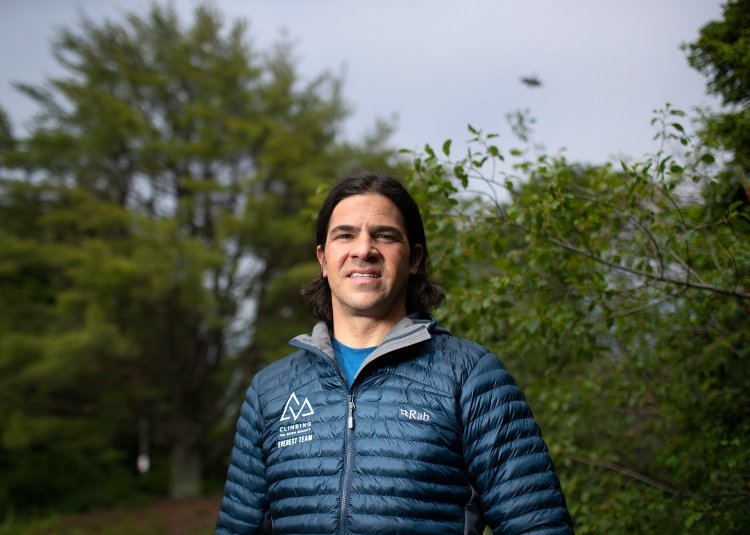
Jared Harris set a goal of reaching the highest peak on each continent. “I love climbing mountains. I love being in nature. I like pushing myself to see what’s possible,” he says. Derek Davis/Staff Photographer
An hour before he stood at the summit of Mount Everest, at the apex of the world, Jared Harris realized a goal he set more than a decade ago was actually happening.
“I could see that the sun, it was just predawn, so the twilight was just on the horizon, over the border into Tibet,” Harris said. “I could see in the distance, along the ridge, the prayer flags that mark the true summit. That’s when – I’m getting chills – that’s when I knew that this was actually happening.”
It was May 13, and it was Harris’ 43rd birthday.
Approximately 800 people attempt to summit the planet’s highest peak every year. But the thought of scaling the 29,035-foot Everest was a long ways off when Harris, a Portland native and 2000 Deering High graduate, tackled his first major climb in 2009 – Mount Kilimanjaro in Tanzania. Harris grew up hiking in New Hampshire’s White Mountains, but Kilimanjaro opened his eyes to something new.
“I thought, I love this. This is for me. I love this. What can we do next?” said Harris, who now lives in Portsmouth, New Hampshire, and works in software sales.
In 2012, Harris attempted to climb Argentina’s Mount Aconcaqua, the highest peak in South America at 22,841 feet. Storms forced Harris and his party to turn back just 200 meters from the summit. In 2013, he climbed Denali in Alaska, North America’s highest mountain (20,322 feet). That’s where Harris realized Everest was doable. Advertisement
Eighteen months ago, after a conversation with a client who had climbed Everest, Harris was reminded that the dream still simmered.
Everest is dangerous, time-consuming and not cheap to climb. Harris declined to say how much the excursion cost, but according to numbers on the website for Climbing the Seven Summits – the guide service Harris used – Everest packages start at $54,995. After arriving in Katmandu, Nepal, on March 31, Harris’ adventure lasted eight weeks.
From Katmandu, Harris and his team took a helicopter to Lukla, which is where the trek into base camp begins. Harris was at base camp for a month. Base camp sits at 17,598 feet, and the days were spent making training climbs to get the body accustomed to the altitude. Climb, sleep, climb down, recuperate. Then do it again. Then do it again.
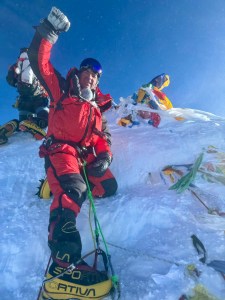
Jared Harris celebrates after reaching the summit of Mount Everest on May 13. “I like pushing myself to see what’s possible,” the Portland native said of his journey to the top of the world. Photo courtesy of Jared Harris
Climbing the Seven Summits, or any guide outfit remotely concerned with safety, won’t take money from any fool with a dream. Harris had to show he was prepared. Since he had climbed Denali with the group, led by owner Mike Hamill, he was deemed an acceptable climbing risk. Still, Harris had to train.
There were numerous training runs around the Portland area, half marathons in a 20-pound weighted vest. There were weekend trips to Mount Washington all winter, climbing in the same weighted vest and 8,000-meter boots like the ones he’d wear on Everest. Harris couldn’t mimic the thin Everest air, but Mount Washington is known for its brutal winter weather. He could mimic Everest’s cold, and work on technical skills like ice climbing.
In January, Harris traveled to Pico de Orizaba, the highest peak in Mexico, to give his mountaineering skills a test. Advertisement
Harris wrestled at Deering. When he returned from Everest, he called Eli Small, a previous assistant coach for the Rams. He thanked Small for helping instill the competitive drive he knew was instrumental as he climbed.
“Everest and things I’ve done, I wouldn’t have even attempted if not for experiencing high school wrestling,” Harris said. “It really did build a foundation mentally for so many things. I wouldn’t have attempted this, it all came from high school wrestling.”
There are four camps between base camp and the summit. Harris and his team, including Pasang Bhote, his personal Sherpa, spent one night at each. The weather report said they would have a window to summit on May 13. They arrived at camp four on May 12 at approximately 10 a.m. They spent the day resting for the summit push that would begin at 9:30 p.m. All you can do is sit in the tent and try to eat. You’ve been using an oxygen tank almost constantly since camp three because the air is so thin, it’s barely air at all.
“It is a pretty inhospitable place. You can’t be outside of the tent. You try to eat, but it’s hard to eat,” Harris said. “You try to rest, but I didn’t sleep a wink. I didn’t sleep the night before. Going for the summit, I hadn’t slept in like two days because with the altitude, it’s really difficult, even on supplemental oxygen.”
They made the climb to the summit in the dark. The only thing Harris saw was the three feet in front of him illuminated by his head lamp.
“That’s one of the most nerve-wracking times, because from that point on, you’re on your own. No one is coming to rescue you. Either you’re getting down on your own two feet or you’re not getting down,” Harris said. Advertisement
Time spent at the summit is measured in minutes. Enough time to remove the oxygen mask for a few pictures. A photo of Harris at Everest’s summit is a photo of achievement personified. His goggles are on his forehead, his oxygen mask under his chin. Harris’ right arm is raised in victory. He knows the journey isn’t close to complete. Plenty of climbers have perished coming down Everest after summiting. On one side of him was a 5,000-foot drop into Nepal. On the other, an 11,000-foot drop into Tibet. It’s like the view from an airplane, Harris said.
At that moment, Harris was calm.
“It wasn’t until we reached the summit my anxiety started to kind of dissipate. I realized, we’re going to be all right. Fears subsided, we’re going to make it down safely,” he said.
Everyone in Harris’ group of 11 climbers made it home, although not all reached the summit. Three had to take a helicopter from camp to a hospital in Katmandu because of frostbite, he said. When he summited, Hamill called Harris’ girlfriend, Megan Smyth, to let her know.
Harris’ new goal is to climb the Seven Summits, the highest point on each continent. He has Everest, Denali and Kilimanjaro checked off. He’s eager to make another attempt at Aconcaqua. There’s also Vinson in Antarctica, Elbrus in Europe, and Australia’s Mount Kosciuszko.
That’s the thing about pushing yourself. Each time you do it, the line moves.
“I love climbing mountains. I love being in nature. I like pushing myself to see what’s possible,” Harris said. “I accomplished something. That’s great, but how can we take this to the next level? If I did this, maybe I could do that. Maybe I couldn’t, but let’s give it a shot.”
Modify your screen name
Join the Conversation
Please sign into your Press Herald account to participate in conversations below. If you do not have an account, you can register or subscribe . Questions? Please see our FAQs .
Your commenting screen name has been updated.
Send questions/comments to the editors.
Varsity Maine
- Email address
- Email This field is for validation purposes and should be left unchanged.
Member Log In
Please enter your username and password below. Already a subscriber but don't have one? Click here .
Not a subscriber? Click here to see your options

IMAGES
VIDEO
COMMENTS
Everest Base Camp Trek Distance. The classic Everest Base Camp trek from Lukla to EBC and back is 130km long - 65km each way - which may sound like a lot of trekking! Fear not, because the typical round trip to Everest Base Camp takes around 12 days, the actual distance you will be covering each day will be about 15km - a much more ...
What is the Lukla to Everest Base Camp Trek distance and day to day hiking length This is the question of many hikers who are going to EBC. Day 1: from Lukla to Phakding is 8 km/ 4.9 miles. Day 2: from Phakding to Namche is 11 km/ 6.8 miles. From Louche to Everest Base Camp to Gorakshep is 12 km/ 7.4 miles.
Max Elevation : 3340m. This is the last day of long-distance walking. It is usually the hardest day of the trek as your body will tire itself from the continuous trek to Everest base camp. You will descend to Lukla from Namche Bazaar. The total distance you have to travel is about 21km and can take up to 8 hours.
Below is a tabulated outline of the distances between various locations along the Everest Base Camp trail, alongside the corresponding duration required to reach each destination: Day. Location. Distance (km) Duration (hours) 2. Lukla - Phakding. 8.2 km. 3 to 4 hrs.
Lukla to Everest Base Camp Distance. The trek from Lukla to EBC covers approximately 65 kilometres (40 miles) and is an important factor for trekkers planning their Himalayan adventure. This trek offers an immersive experience of the rugged beauty of the Khumbu region, showcasing stunning landscapes, local culture, and high-altitude challenges. ...
The trek from Lukla to Everest Base Camp takes between 11 and 14 days depending on weather conditions and rest days needed. This insider's guide to Everest Base Camp treks has everything you need to know about planning this epic adventure! ... While the distance from Lukla to base Camp at Everest is about 38.5 miles or 62 kilometers one-way, it ...
Basically, it takes 12 days of total duration trek from Lukla to Everest Base Camp including the two days of acclimatization in between. Here's the standard outline itinerary. Day ...
Short Itinerary Lukla to Everest Base Camp Trek - 8 days Itinerary. Day 1: Fly to Lukla from Kathmandu, meet with guide and porter, and then trek to Phakding walking distance of 6.2 km (2/3 hours) 2610 M / 8,664 feet) Day 2: Phakding to Namche walking distance is 7.4 km (5-6 Hours) 3,440m/11,283ft Day 3: Trek From Namche Bazaar to Pangboche walking distance- of 9.1 km (5 to 6 hours) 3930m/12890ft
The distance between Lukla and EBC is 38.58 miles (62.08 kilometers), which takes 7 to 8 days to hike and 3 to 4 days to descend. The overall distance traveled round way from Lukla to Everest base camp is 130 kilometers, although the trek takes 11 to 12 days. You hike 10 to 11 kilometers each day, which is a pleasant amount to walk between ...
Everest Base Camp Trek Distance Details Kathmandu - Lukla - Phakding. Flight duration: 35-40 minutes Lukla altitude: 2845 m Phakding altitude: 2610 m Walk duration: 3-4 hours Distance Covered: 10 Km Net Elevation Gain:-230 m The distance from the starting point of Kathmandu to Lukla is 138 km.You will cover this distance in a flight of around 45 minutes.After reaching the airport at Lukla ...
Everest Base Camp Trek Overview. Distance - 120 km/75 mi; Days required - 12 days; Total ascent - 6015 m/19 734 ft; Total descent - 5821 m/19 097 ft; Highest point - 5640 m/18 500 ft Kala Patthar; Difficulty - difficult ; Permits - Local Government fee (NPR 2000/US$17 pp.) and Sagarmatha National Park permit (NPR 3000/US$25 pp.) is required.No TIMS card is needed for the trek.
The Everest Base Camp Trek Distance. The distance from Lukla to Everest Base Camp on the Everest Base Camp trek is approximately 38 miles one way.. Daily distances covered on key stops like Namche, Tengbouche, Dingbouche, and Lobuche during the trek can vary. Typically, it ranges from 5 to 10 miles each day, depending on the itinerary and pace of the trekker.
The distance from Lukla the first town to Everest Base Camp is 38.58 miles or 62 kilometers. Most people take 8-9 days trekking to Everest Base Camp and 3-4 days trekking back to Lukla. It took 8 days to trek to Base camp and two days to trek out.
Tumlingtar to Everest Base Camp (21-23 days trekking) Gokyo Over Cho La Pass (17-18 days trekking) Lukla to Tengboche (around 7 days trekking). The trek from Lukla to Everest Base Camp is 38.5 miles each way, totaling 77 miles for hikers. Therefore, to finish this trek in 11-14 days, hikers must spend 8-9 hours daily on the move.
The Everest Base Camp Trek distance is a 130 km round trip beginning from Lukla.. However, the outward 65 kilometers to Everest Base Camp takes far longer as you need to factor in acclimatization. If you were to rush to base camp, you would almost certainly fall ill from altitude sickness.. This article is a guide on what to expect and how to best navigate the awe-inspiring distance of the ...
It basically just breaks out the numbers chart I put together above. Everest Base Camp Trek Day 1: Lukla to Phakding. Duration: 3 Hours. Distance: 5.1 miles / 8.2 km. Starting Elevation: 9,318 ft / 2,840 m. Ending Elevation: 8,563 ft / 2,610 m.
The total distance covered during the Everest Base Camp Trek is approximately 130 kilometers (around 80 miles). This distance includes the trek from Lukla to Everest Base ...
The optimal time to trek from Lukla to Everest Base Camp is spring (from the end of March to mid-May) and autumn (from October to the end of November). The average daytime temperature during these seasons ranges around 25 degrees, with a nighttime temperature of 10 degrees. The track is impossible in summer (end of June and July) due to ...
The most preferred Classic Everest Base Camp Trek is 15 days trek in which the 1 st day is arrival plus trek briefing day, and the second day is Kathmandu city excursion day. Our trek from Lukla usually commences on the 3 rd day after landing at Lukla from scenic mountain flight from Kathmandu.. The approximate one-way distance from Lukla to Everest Base Camp is 60 - 65 km.
This is also because now you can customize the trail to just a 12-day hike from Kathmandu to Everest Base Camp and all the way back to Kathmandu. Everest Base Camp trek can be shortened when you take a domestic flight to Lukla Airport from Kathmandu. This minimizes the 135km distance in just 30-minute and when we do the same while descending it ...
Everest Base Camp Trek without a flight to Lukla is an incredible hiking trip to Everest Base Camp (EBC). ... (Alt. 2362m/7749ft). Driving Distance 265 Km. Driving 9/10 hours. Overnight at Tea House. Day 3: Drive from Salleri to Thamdanda. Trek from Thamdand to Paiya (Alt. 2730m/8957ft). ... If you want the Everest Base Camp Trek with a flight ...
From Katmandu, Harris and his team took a helicopter to Lukla, which is where the trek into base camp begins. Harris was at base camp for a month. Base camp sits at 17,598 feet, and the days were ...